8th May 2024: Golden Mummies of Egypt
A few weeks ago I went to an exhibition in Manchester Museum called ‘Golden Mummies of Egypt: interpreting identities from the Graeco-Roman period’.
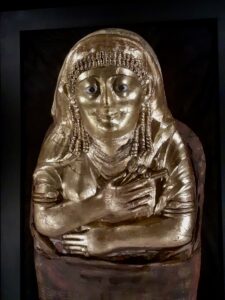 The exhibits largely came from the Museum’s own impressive collection. In the late nineteenth century, rich Mancunians financed an expedition to Egypt by the archaeologist William Matthew Flinders Petrie to find Egyptian relics for their collections. He was allowed to excavate at Hawara, around 60 km south of Cairo and an area dominated by the pyramid of Amenemhat III. Near the pyramid is a large enclosed area. Petrie’s excavations in 1888-1890 started with the aim of exploring the interior of the pyramid, but soon concentrated on the large Graeco-Roman necropolis around it as he discovered the large collection of burials in underground chambers. What attracted his attention was the golden masks on a number of the sarcophagi, the portraits attached to others and the exotic and complex practices that created them that seem so strange to us. These golden masks and the painted portraits that he found are the main subject of the exhibition.
The exhibits largely came from the Museum’s own impressive collection. In the late nineteenth century, rich Mancunians financed an expedition to Egypt by the archaeologist William Matthew Flinders Petrie to find Egyptian relics for their collections. He was allowed to excavate at Hawara, around 60 km south of Cairo and an area dominated by the pyramid of Amenemhat III. Near the pyramid is a large enclosed area. Petrie’s excavations in 1888-1890 started with the aim of exploring the interior of the pyramid, but soon concentrated on the large Graeco-Roman necropolis around it as he discovered the large collection of burials in underground chambers. What attracted his attention was the golden masks on a number of the sarcophagi, the portraits attached to others and the exotic and complex practices that created them that seem so strange to us. These golden masks and the painted portraits that he found are the main subject of the exhibition.
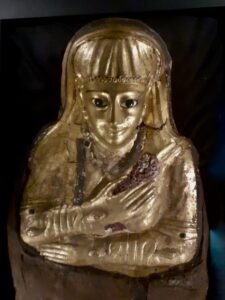 They are mostly from the first century BC to the first century AD by our calendar, and are fascinating to look at. The golden mummies must have been commissioned by fairly rich citizens, as mummification was an expensive business. They are still fascinating to look at today, especially as many of them give the occupiers name on the sarcophagus.
They are mostly from the first century BC to the first century AD by our calendar, and are fascinating to look at. The golden mummies must have been commissioned by fairly rich citizens, as mummification was an expensive business. They are still fascinating to look at today, especially as many of them give the occupiers name on the sarcophagus.
The panel portraits are in some ways even more interesting, as they are some of there earliest realistic paintings of citizens of the ancient world. They are painted using wax based pigments on thin boards, and are amazingly realistic. There is some debate about how realistic the paintings actually are, and they are probably idealised to some degree to celebrate the deceased.
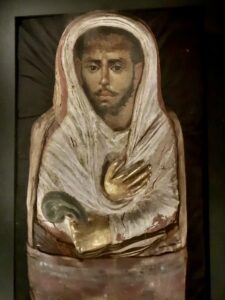 As a generalisation, the Romans seem to have been the first to have less obviously stylised, and more realistic portraits of people that have survived to the modern day. The other ancient civilisations all portrayed people, but many of the images are of gods and heroes, and are painted or sculpted in a very stylised manner that exaggerate the symbolic elements. The portraits in this exhibition seem to show people who you might have met on the street in the period. The artist has skilfully brought them to life, and they have escaped most of the damage and decay of the centuries spent underground to still appeal to a modern audience. There is something about moving from abstract knowledge of how people lived in those times, to actually seeing portraits of people and being able to put names to some of them that brings their stories alive again.
As a generalisation, the Romans seem to have been the first to have less obviously stylised, and more realistic portraits of people that have survived to the modern day. The other ancient civilisations all portrayed people, but many of the images are of gods and heroes, and are painted or sculpted in a very stylised manner that exaggerate the symbolic elements. The portraits in this exhibition seem to show people who you might have met on the street in the period. The artist has skilfully brought them to life, and they have escaped most of the damage and decay of the centuries spent underground to still appeal to a modern audience. There is something about moving from abstract knowledge of how people lived in those times, to actually seeing portraits of people and being able to put names to some of them that brings their stories alive again.
one of the women is wearing a dress that could very easily date from the medieval period, if not later. Little things like that and the light in their eyes and their expressions bring the portraits alive and make you realise these people once were alive in a way that other historical artefacts do not. 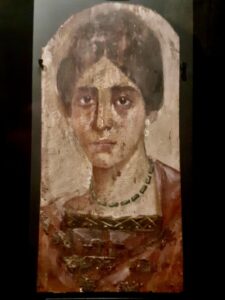
You can imagine a melancholy story behind some of the portraits, such as this rather sad coffin of a young girl with her smiling full length portrait on the cover all that is left of her.. the fascination of the exhibition is the contrast between the strange, complex and archaic funereal practices and the religion that inspired it, and these almost everyday images of people who seem not much different from people from the modern era.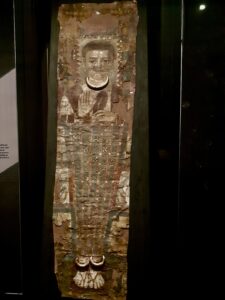
It is not just in these portraits either-there is a mosaic of a woman found in Pompeii and it seems to have caught her mid conversation. The artists skills in bringing these people to life survives even two millennium later.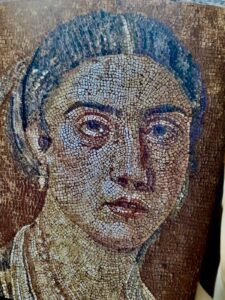
22nd April 2024: Cumbrian wildlife
I have started visiting the Nature Reserves on the south of the Furness Peninsula again, and here are some photos of the butterflies that I found there. I also saw my first adder, and even managed to photograph it, and two weeks later, saw another adder and photographed that as well. Not brilliant photos, but interesting all the same.
Adder or possibly two adders, curled up at Foulshaw Moss Nature Reserve.
Comma Butterfly at Whitbarrow Scar
Brimstone Butterfly at Whitbarrow Scar
Peacock Butterfly at Whitbarrow Scar.
Green Hairstreak butterfly at Meathop Moss Nature Reserve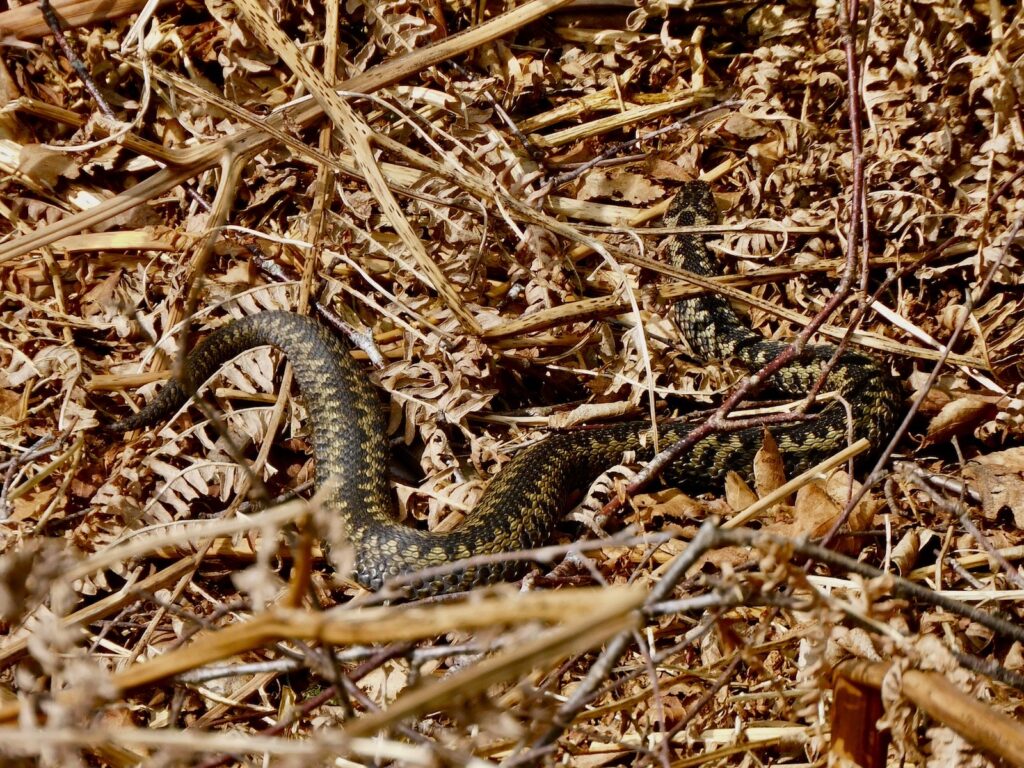 Another Adder at Foulshaw Moss, two weeks later.
Another Adder at Foulshaw Moss, two weeks later.
6th April 2024: great excitement in Grange
I know you don’t often see the words excitement and Grange in the same sentence, but something interesting happened before Easter in Grange, as reported in the social media:
22nd March 2024: Its been reported that 0518 Preston-Barrow, formed of 195104 and 195133, have derailed near to Grange Over Sands.
Northern statement on Twitter:
Northern TOC reported that Earlier this morning, a Northern train travelling towards Barrow came off the tracks near Grange over Sands station. There were four customers and four Northern colleagues on board. Everyone been safely escorted from the train. A hole has been found underneath the track where a train derailed, the rail operator said.
When Mark and I visited Grange the next day, and walked to the public footbridge at the western end of the promenade, we could see the two three coach 195 units were still there, with the front unit completely derailed.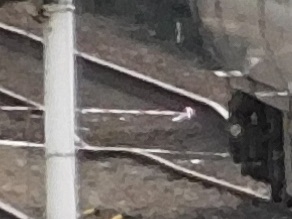
The above is not a very good photo, as it is a crop of another photo, but shows the distortion of the track.
Another photo taken by someone else shows the large hole under the track that caused the derailment. A lot of the online speculation assumed that the high spring tides, recent heavy rain and the flow of water from the landward side have caused the problem to develop. Grange Golf course, on the landward side of the railway here, has been flooded for a long while, which might have made the problem worse.
As you would expect, the line between Barrow and Carnforth was closed, and remains so today. RAIB will no doubt take their time investigating the incident, what lead up to it, and if there are any other culverts that have been damaged and undermined by recent high tides and bad weather. There are quite a number of these culverts, so it might take a while.
Thinking about it, the railway was fortunate in at least three ways. Firstly, the train was lightly loaded with only four passengers and four crew, and no-one was hurt. Secondly, the train seems to have hit the wall to the seaward side of the railway, but not broken through it, or else the carriages could have easily ended in the salt marshes, and been a lot more difficult to retrieve. Thirdly, and most importantly, the train involved was not one of the nuclear flask trains that use the line, which would have caused a much more serious and dangerous incident.
Social media reported that a Kirov crane is coming out from Scunthorpe, due some time Monday. It seems a long way to bring a crane, but the days when every large depot on the railway such as Carnforth or Crewe had a breakdown crane are long gone, I guess.
Mark and I visited Grange again to see the Kirov crane:
It is an impressive vehicle, and we could watch it as it slowly manoeuvred into position, running under the footbridge we were standing on:
crane managed to re-rail the front unit successfully, and then returned to Scunthorpe. Unfortunately, quite a lot of the activities took place when we were not there, as Mark objected to spending Easter on the footbridge!
The reports state that they have put a skate of some kind under the damaged bogie, and moved the the units to next to Grange signalbox, as seen above. Then they detached the undamaged unit and sent it away under its own power, probably to Barrow.
There has been some debate about why the units can’t be sent up to Carlisle, but the general consensus is that they would exceed the loading gauge on narrow tunnels north of Workington. The damaged unit is now reported to be in a siding at Ulverston.
Now all that there is at the accident site is three JCBs working on the sinkhole:
A recent report in the local news raises further questions about this accident:
“Tim Farron, the MP who represents Westmorland and Lonsdale, said he had seen evidence that damage had happened to the track at Grange-over-Sands around 53 hours prior to the incident on Friday, March 22
The track had become unsupported because a cavity had opened in the embankment on which the railway sits. The train was travelling at 56mph when the accident occurred and the front three carriages of the six-carriage train derailed.
But Mr Farron said it has emerged that Network Rail had been informed of damage to a water pipe on the line just two days before the derailment.
In the early hours of Wednesday, March 20, an incident was reportedly logged to Network Rail that the tamper – a machine which make the tracks and roadbed more durable – had struck a water pipe on the Furness Line next to Grange Golf Club, he said.”
If this is true, and you would think an MP would have to be sure of himself before making this public, then it could open up a whole new can of worms, so to speak.
18th March 2024: Legends of Steam
Last weekend, the East Lancashire Railway had a gala event they called “Legends of Steam”. Three large locos visited the railway and ran services on the line all weekend. The locos were Stanier ‘Jubilee’ class 4-6-0 45690 “Leander”:
‘Britannia’ class pacific No.70000 “Britannia”:
And Gresley A4 Class pacific 60007 “Sir Nigel Gresley”:
I spent a long time around Bury and Ramsbottom watching them and taking lots of photos, and it was a very enjoyable day. It is a little sad to see these express locos trundling around at around 25 MPH, half the time tender first, but they are all venerable old ladies now-the Jubilee and the A4 are around 90 years old and have spent longer in preservation than in working service, and the Britannia is not far behind.
They also had the Aspinall saddle tank operating a shuttle service between Bury and Ramsbottom, which was a bonus. This is an even older loco with nearly 130 years of existence under its smokebox, so trundling around on the ELR is probably an ideal existence for it.
They normally number this loco its BR number 51456 or L&Y number 754 which it carried in its working life, but they seem to have decided to number it as one of the locos used in Horwich works as the works shunter, and why not?
Another reason to visit Bury is the transport museum, as the National Railway Museum have loaned them their Stanier 2-6-4 tank 2500, known as a Tilbury tank, as it spent its working life on the London Tilbury and Southend line.. 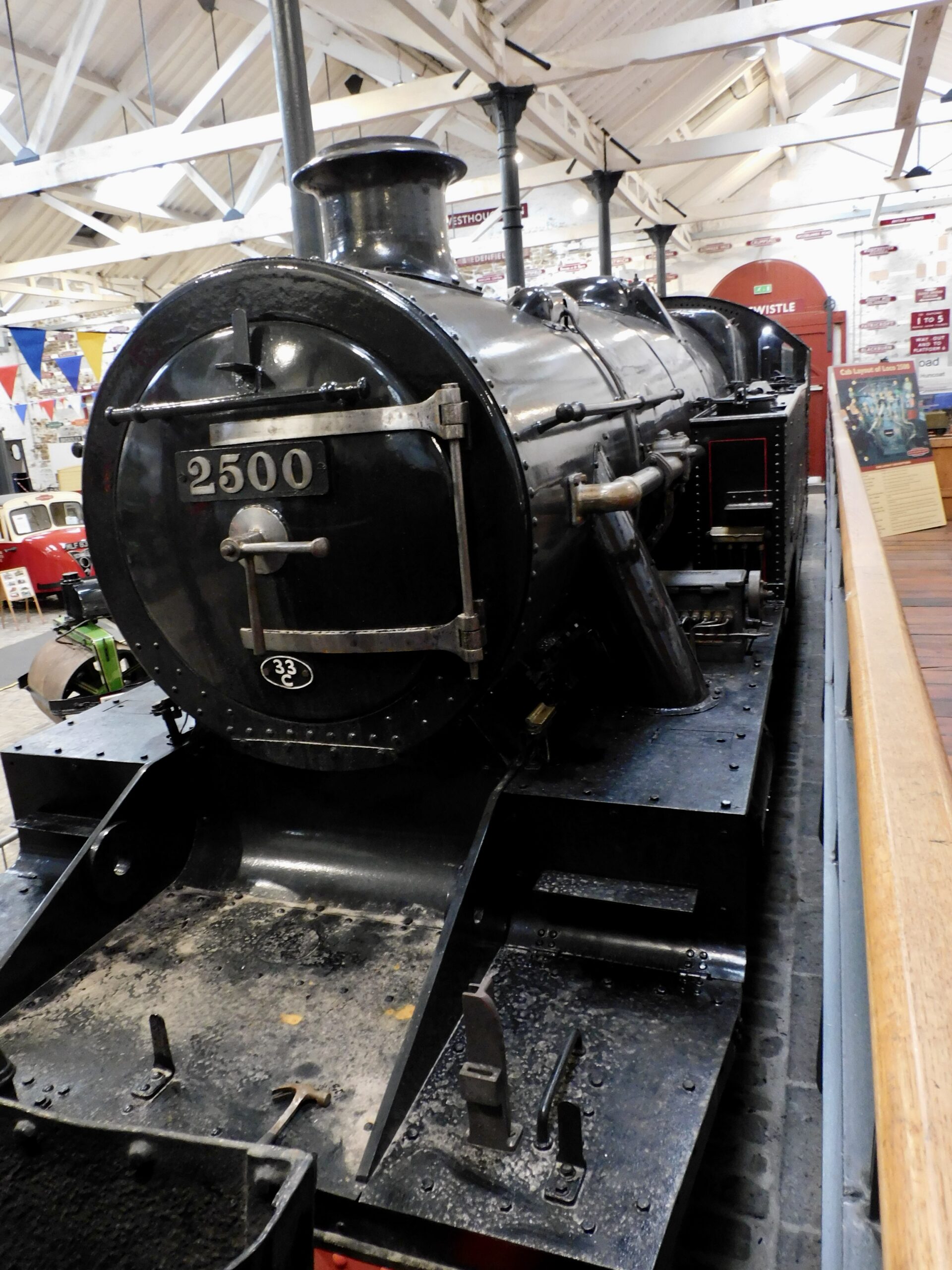
The loco is a bit large for the rather cramped museum, so taking a photo was a bit difficult! Dave built an OO gauge model of this class a long time ago, and it is still capable of running on the layout at Cark as fast as ever. The Museum also has on loan one of the narrow gauge shunting locos used in Horwich Works:
This all gave a nice Lancashire and Yorkshire Railway influence to the day, which was a good thing. The Bury Museum is supposed to be getting the loan of the Aspinall Radial Tank as well, but it has not happened yet. Maybe they need to find a bit of room for it first!
3rd February 2024: Kendal Model Railway ExhibitionMark and I visited the Kendal Model Railway Exhibition recently at Kendal Leisure Centre, and we really enjoyed it. There were a variety of different layouts for us to enjoy, such as ‘Marshside’, an O gauge layout set on a Lancashire branchline in early LMS days:
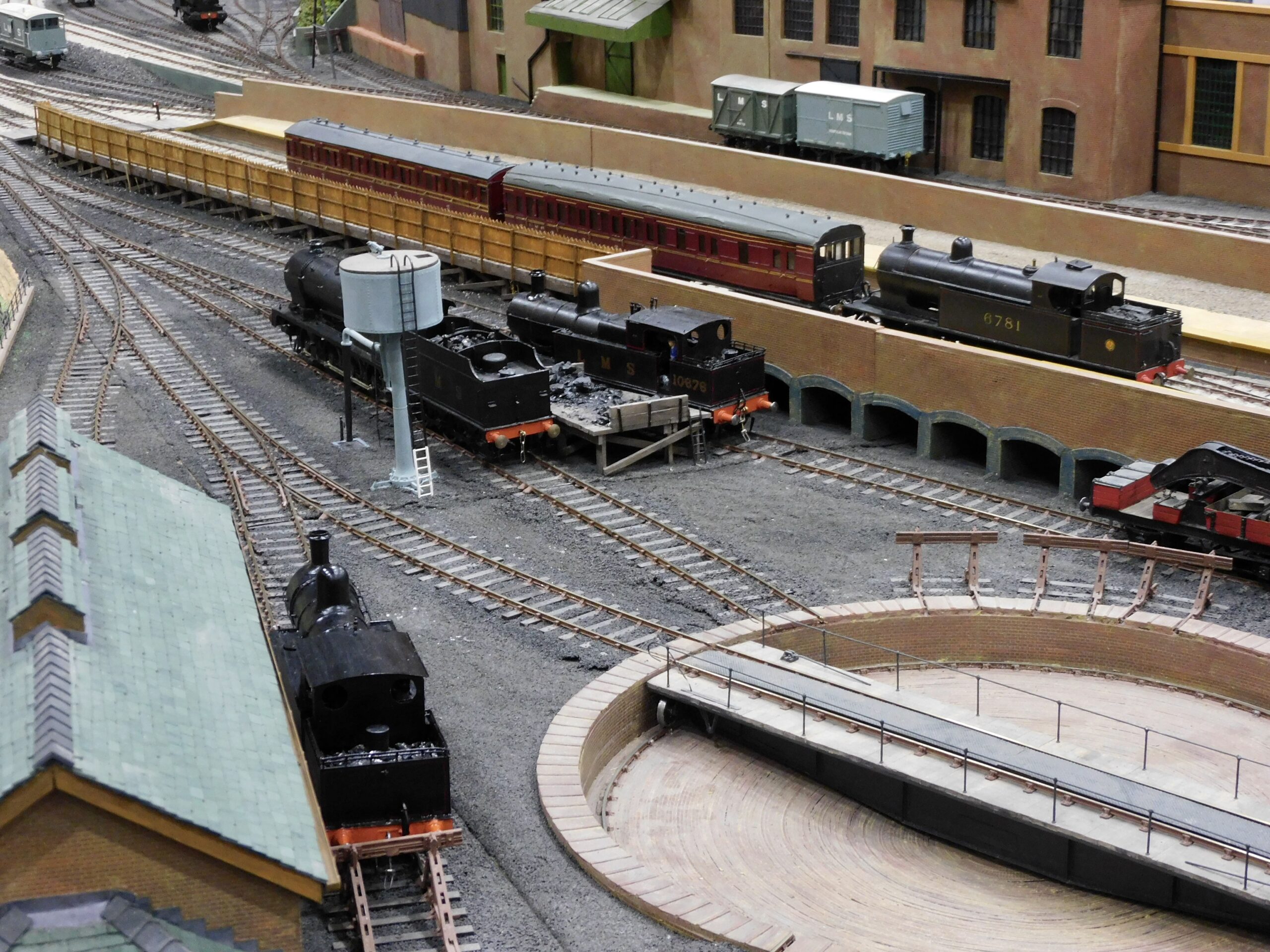 They had a number of interesting LMS model locos on this layout, like this Crab:
They had a number of interesting LMS model locos on this layout, like this Crab:
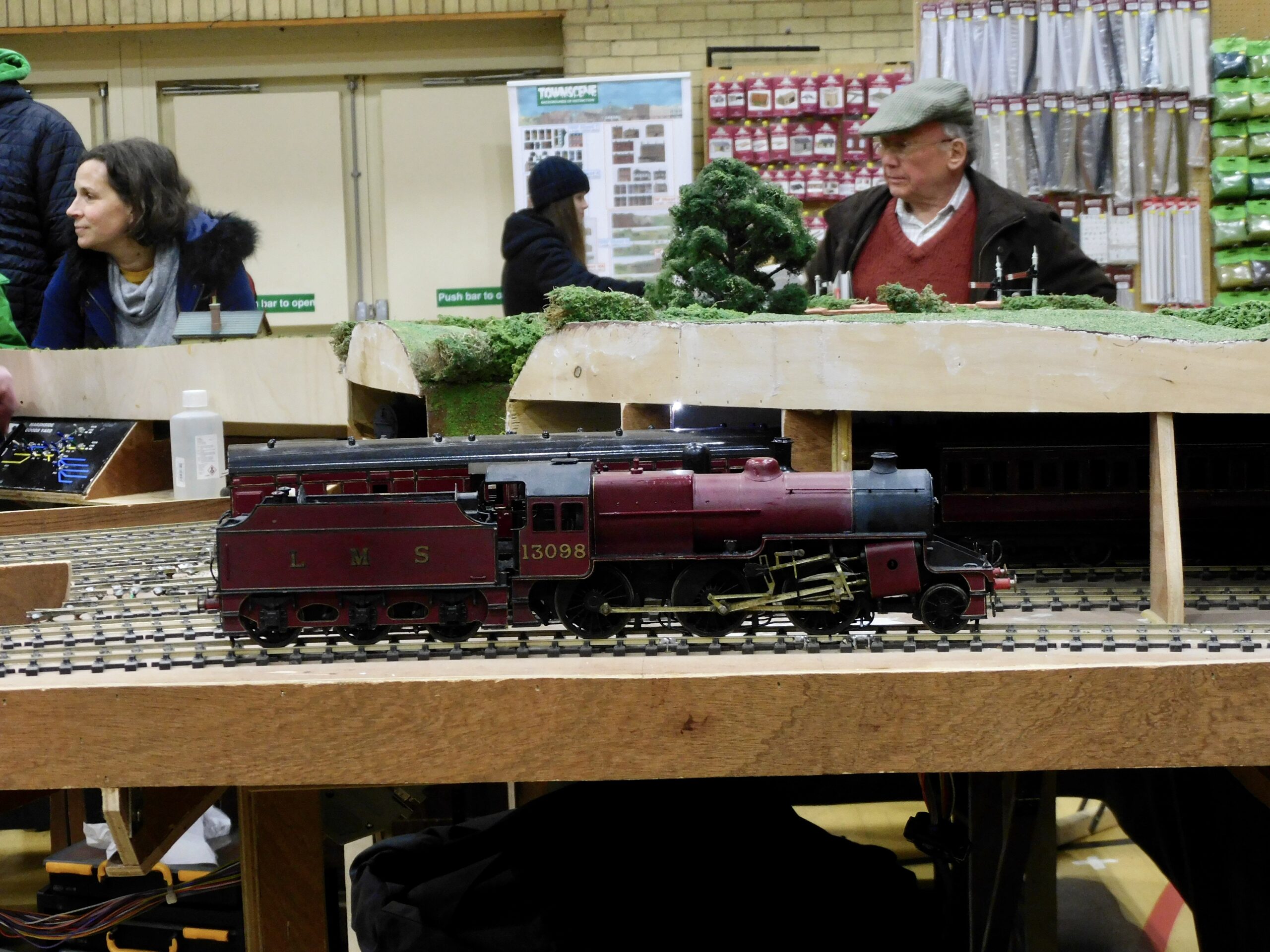 The layout that David would probably have been most interested in was ‘Norman Colliery’ an O gauge layout of a run down colliery with steam engines and diesels shunting around trucks into and out of screening buildings. It is an impressive model. I took some video of it, and I will load it here if I can work out how to do it.
The layout that David would probably have been most interested in was ‘Norman Colliery’ an O gauge layout of a run down colliery with steam engines and diesels shunting around trucks into and out of screening buildings. It is an impressive model. I took some video of it, and I will load it here if I can work out how to do it.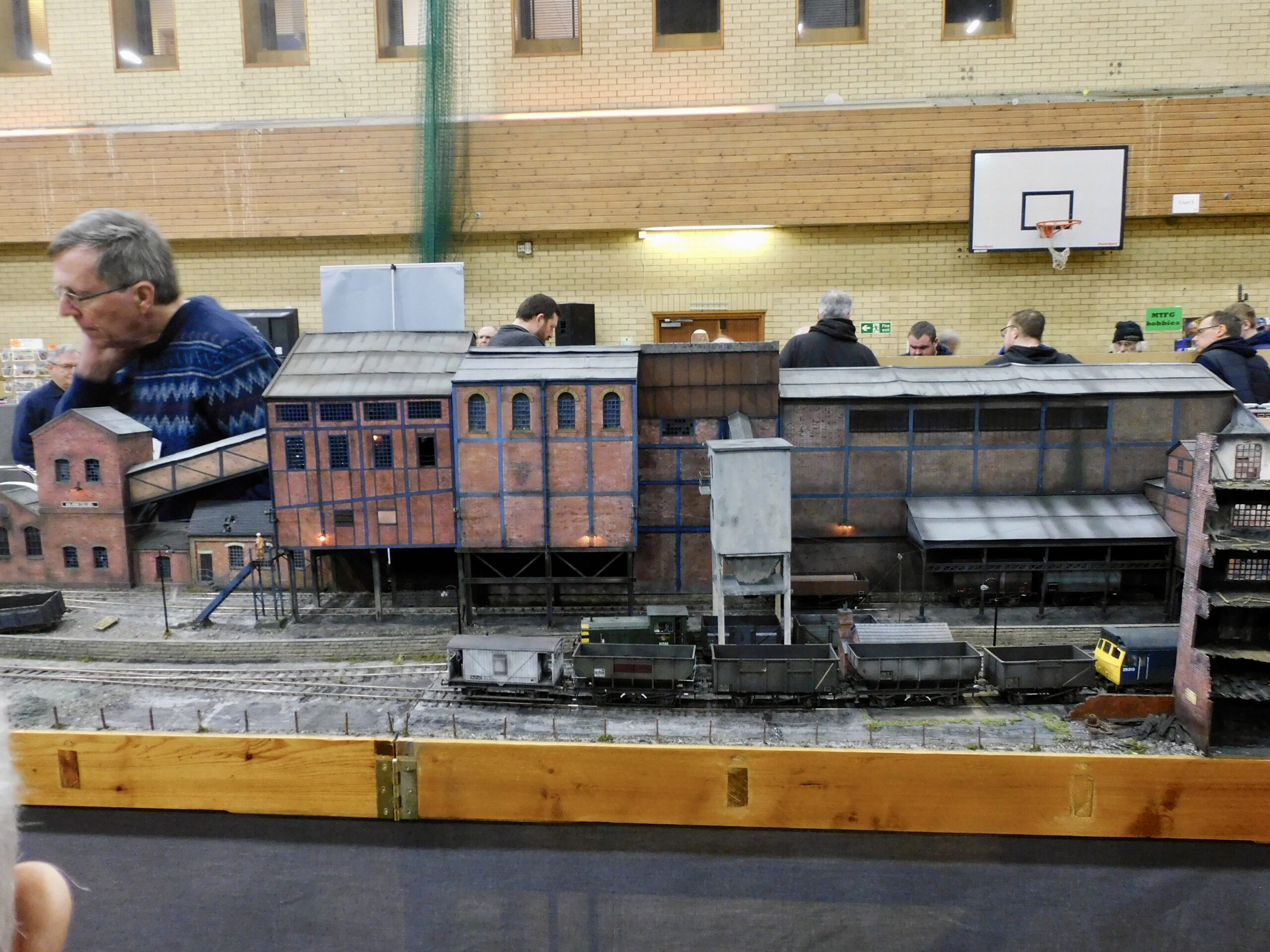
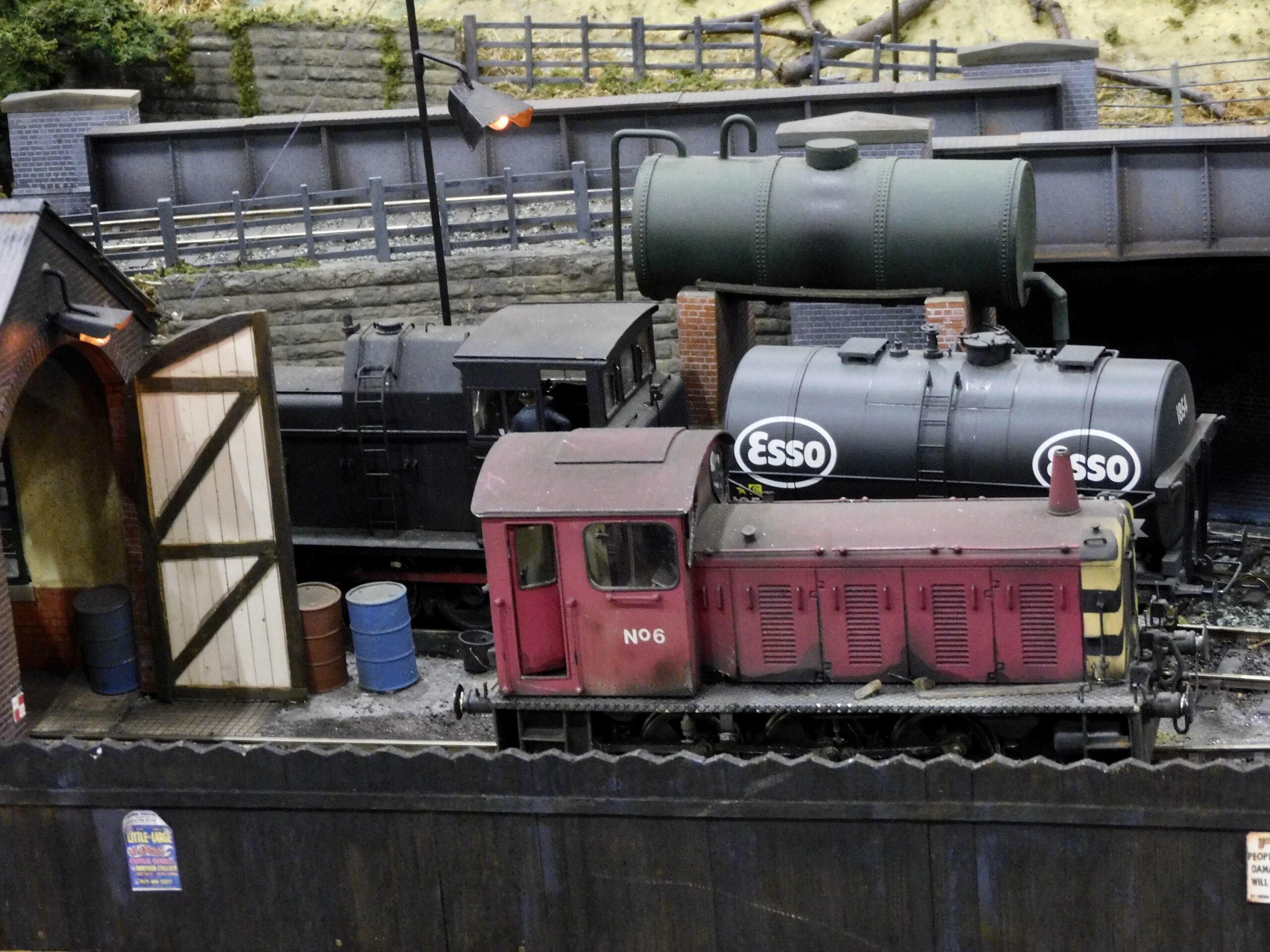 Norman Colliery involved a level of modelling that in photos almost looks real, such as the small yard in the photos above. It is impressive modelling.
Norman Colliery involved a level of modelling that in photos almost looks real, such as the small yard in the photos above. It is impressive modelling.
Not all the layouts went for hyper-realism. The Trix Twin layout just included loops of track in old third rail system with a rather rickety looking catenary system that was not working and the yard packed with elderly loco models.
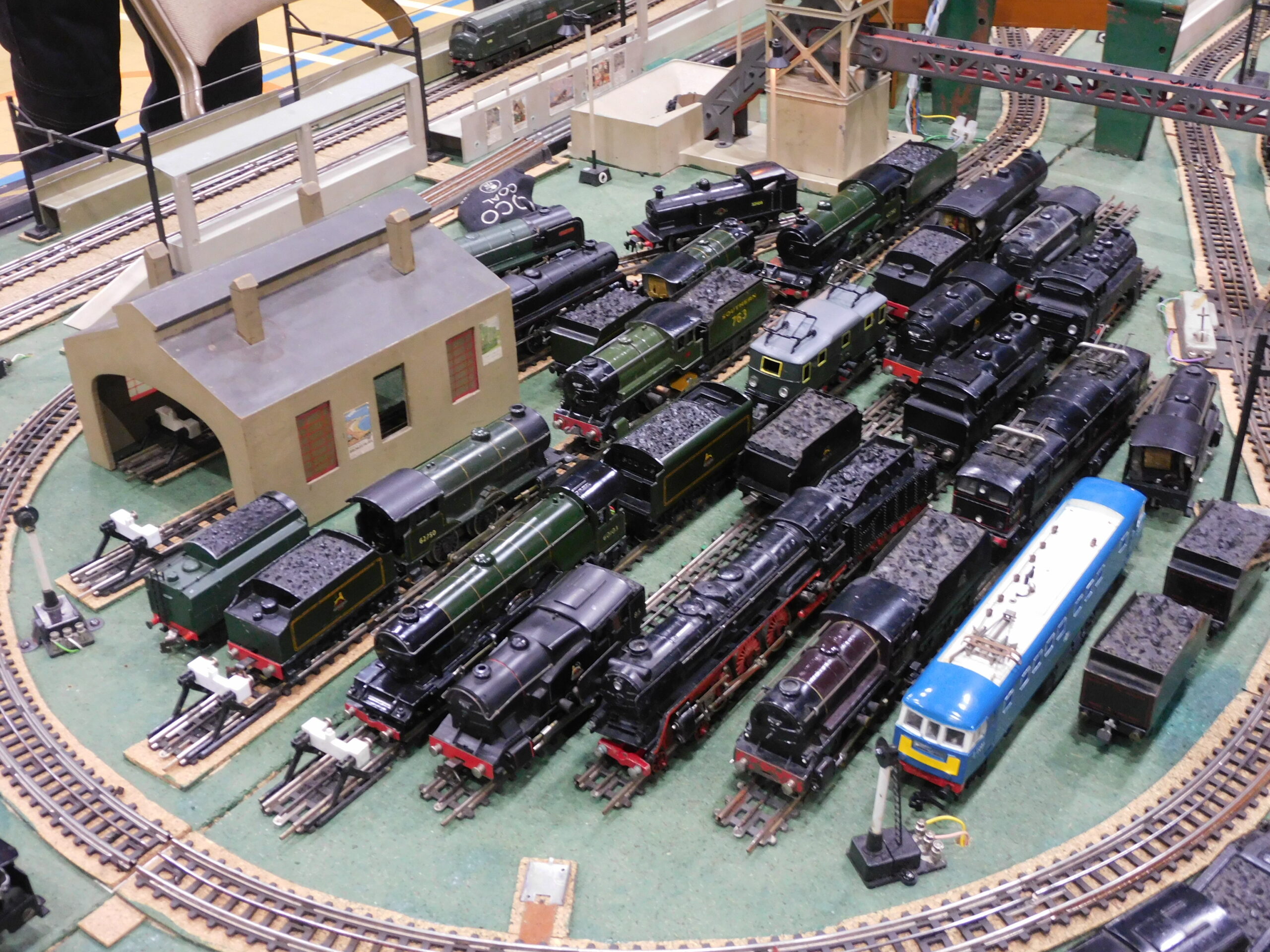 Many of the layouts in the exhibition were pretty small, and compact. One had been created by a team of a grandad and granddaughter, who were there with their layout Lily’s Lane, which can only have been about four foot long by three foot wide. Other layouts were not much larger, with details and multilevel making up for lack of space.
Many of the layouts in the exhibition were pretty small, and compact. One had been created by a team of a grandad and granddaughter, who were there with their layout Lily’s Lane, which can only have been about four foot long by three foot wide. Other layouts were not much larger, with details and multilevel making up for lack of space. 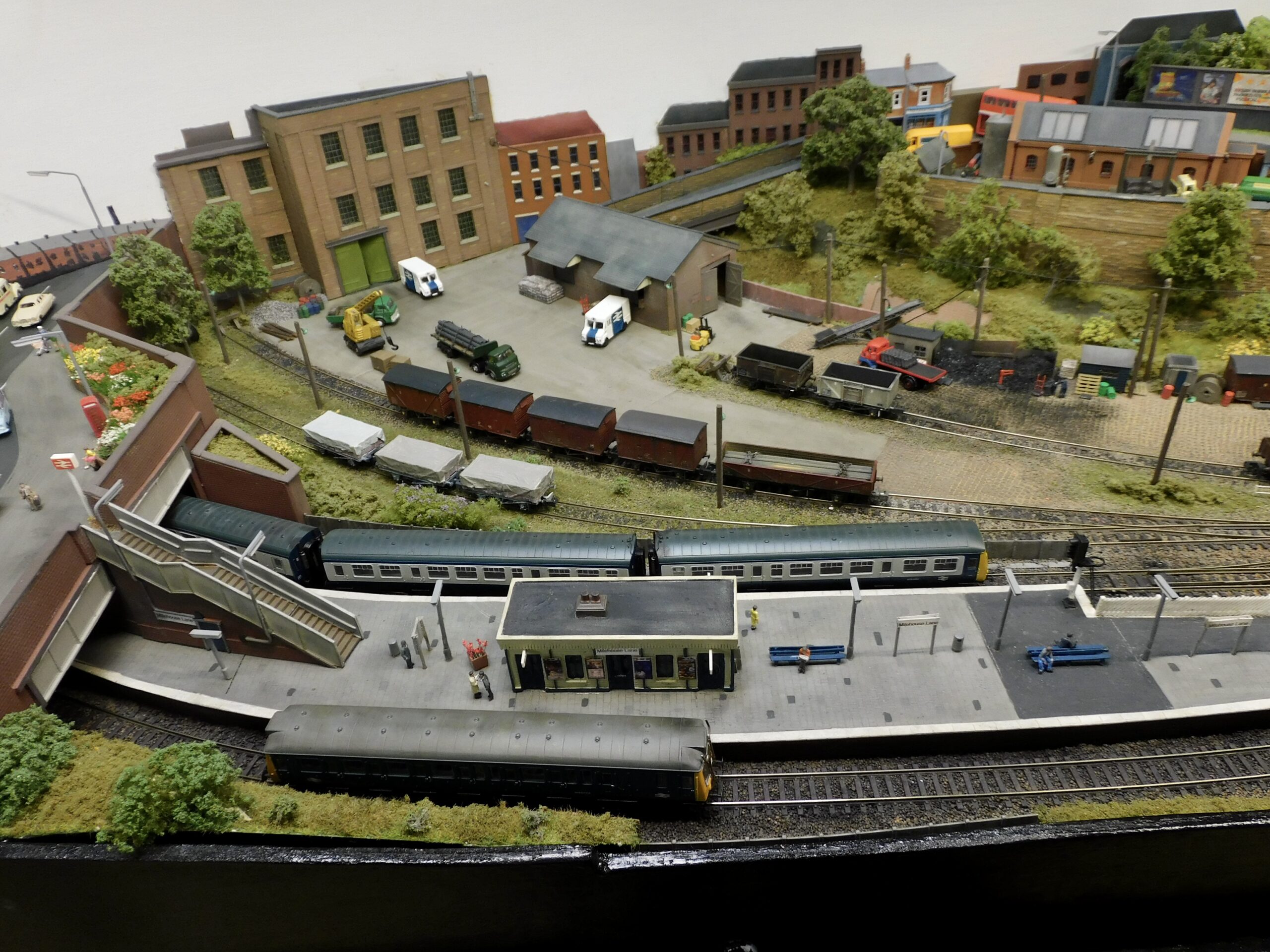
We did wonder if the lockdown and lack of space had inspired people to make more with less space, with impressive results in many cases. Smallville and Wilton was another very small layout making up with clever modelling of a narrow gauge railroad in the USA, and including a trestle bridge over a creek that was well modelled:
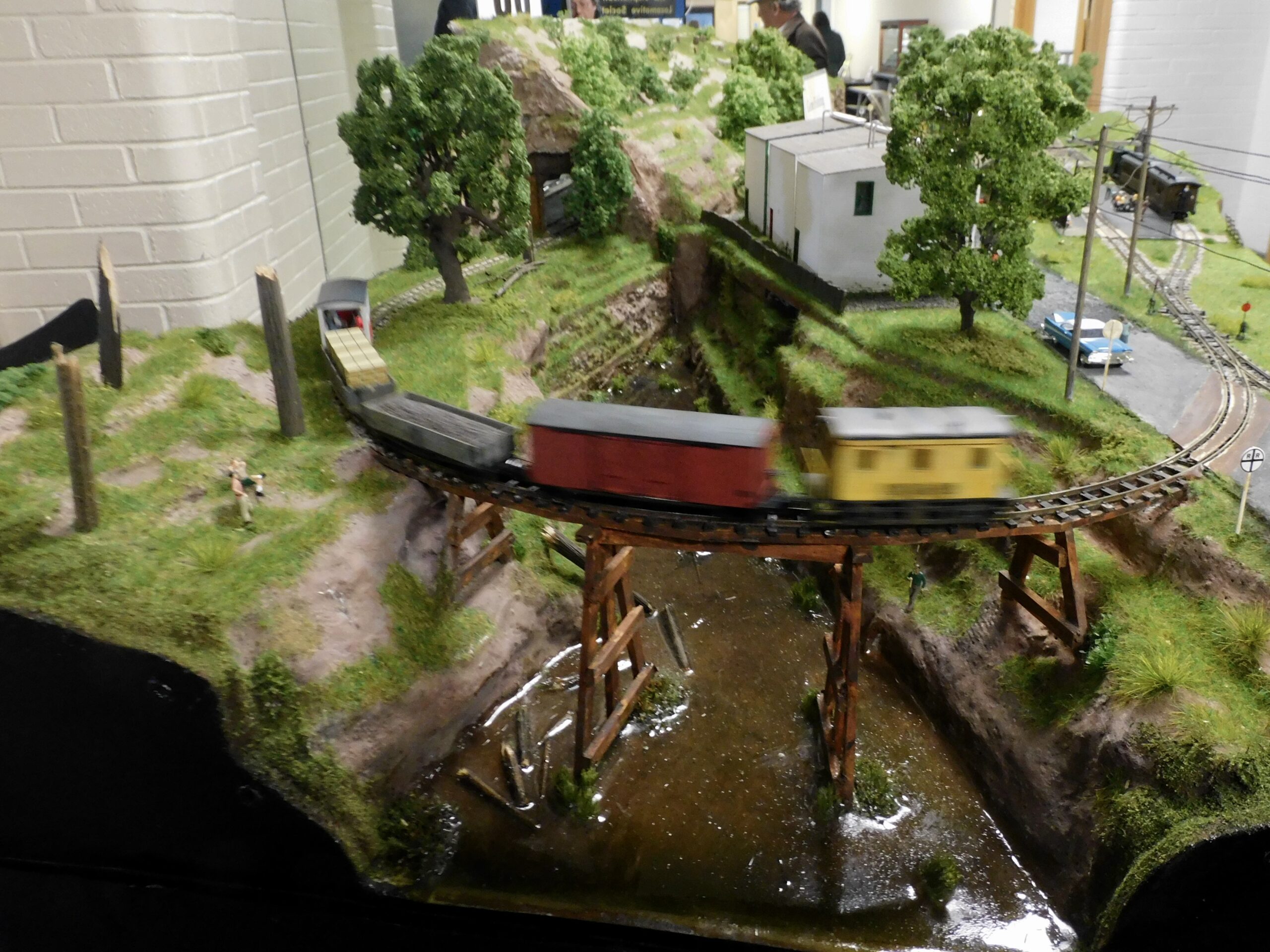 Others included busy yards and stations in limited space, like below:
Others included busy yards and stations in limited space, like below:
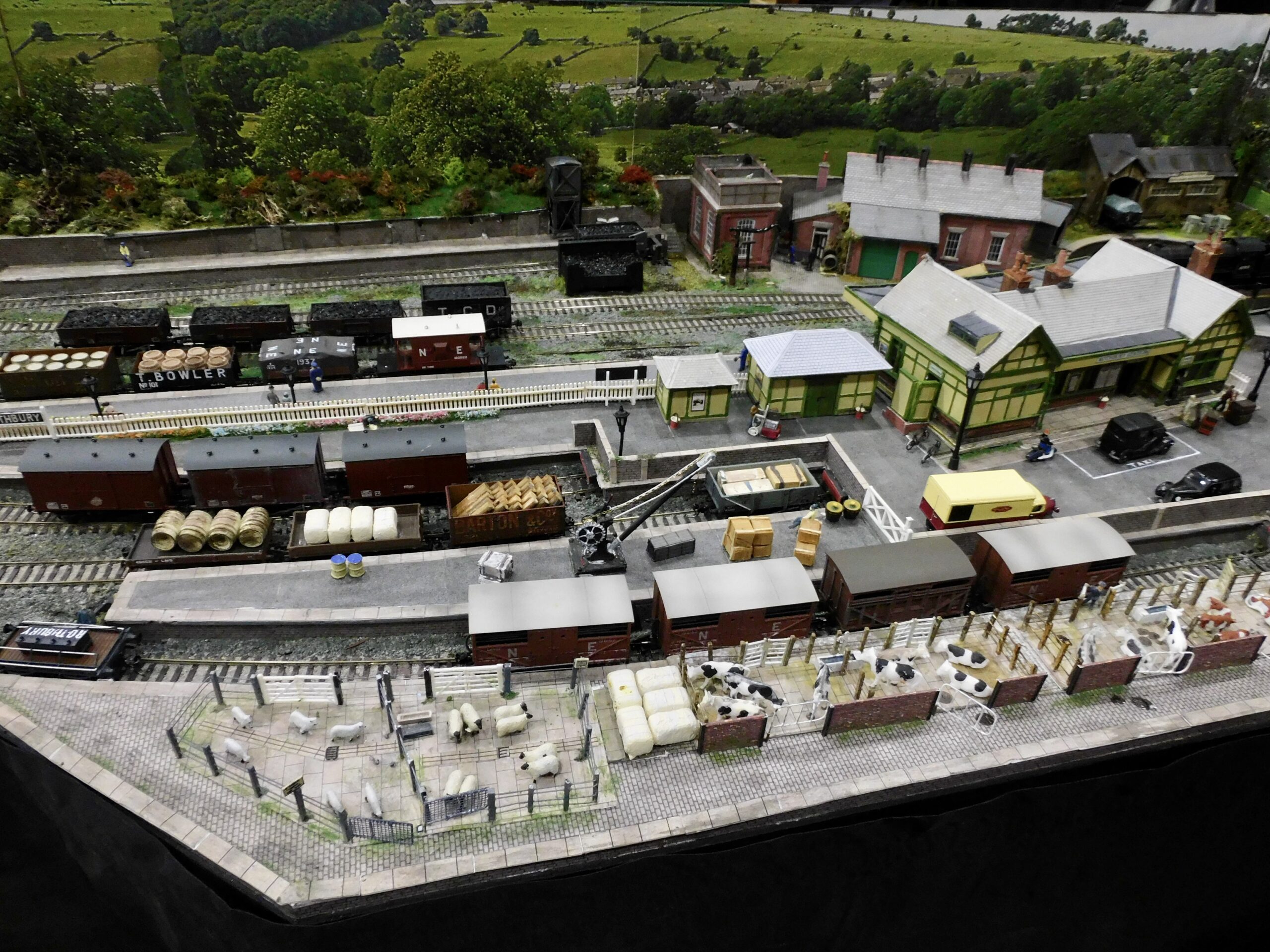 Generally, there were less long layouts with varieties of trains running past, and more smaller layouts set in yards and stations, which was an interesting change.
Generally, there were less long layouts with varieties of trains running past, and more smaller layouts set in yards and stations, which was an interesting change.
31st January 2024: Coniston Copper Mine Valley
I have walked up Copper mines valley at Coniston recently, as I read online that they had created a replica of one of the old water wheels that were used to power machinery at the mine, and I wanted to have a look at what they had done. This is a view down the valley, with the replica wheel in the foreground: This is a closer view of the wheel:
This is a closer view of the wheel:
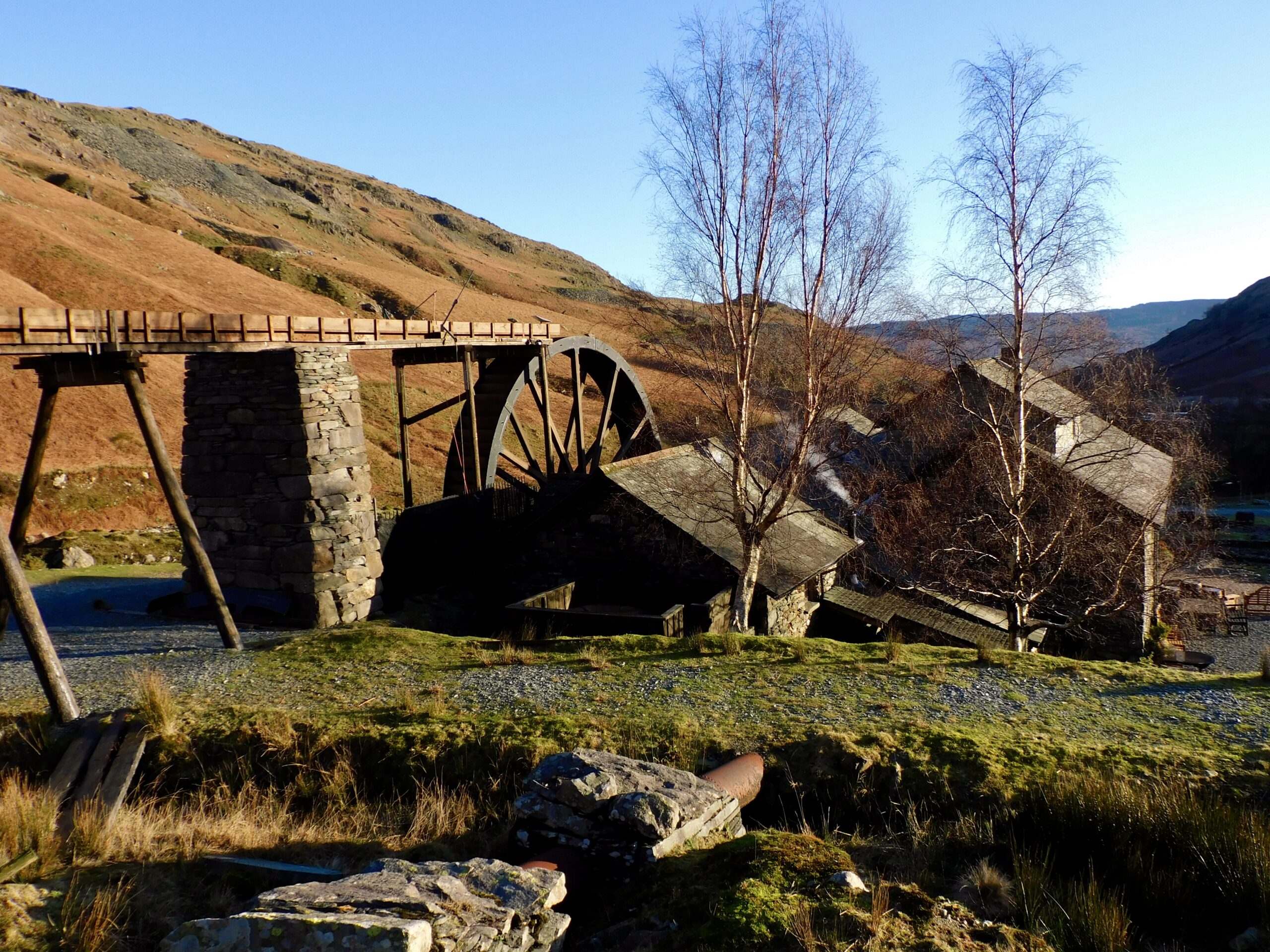 It is an impressive looking structure, though it was unclear if it is operational, and if so what they use it for. The buildings around are holiday lets, and there is a hot tub in the building underneath, so it might well be something to do with that, or it could just be a feature to attract tourists.
It is an impressive looking structure, though it was unclear if it is operational, and if so what they use it for. The buildings around are holiday lets, and there is a hot tub in the building underneath, so it might well be something to do with that, or it could just be a feature to attract tourists.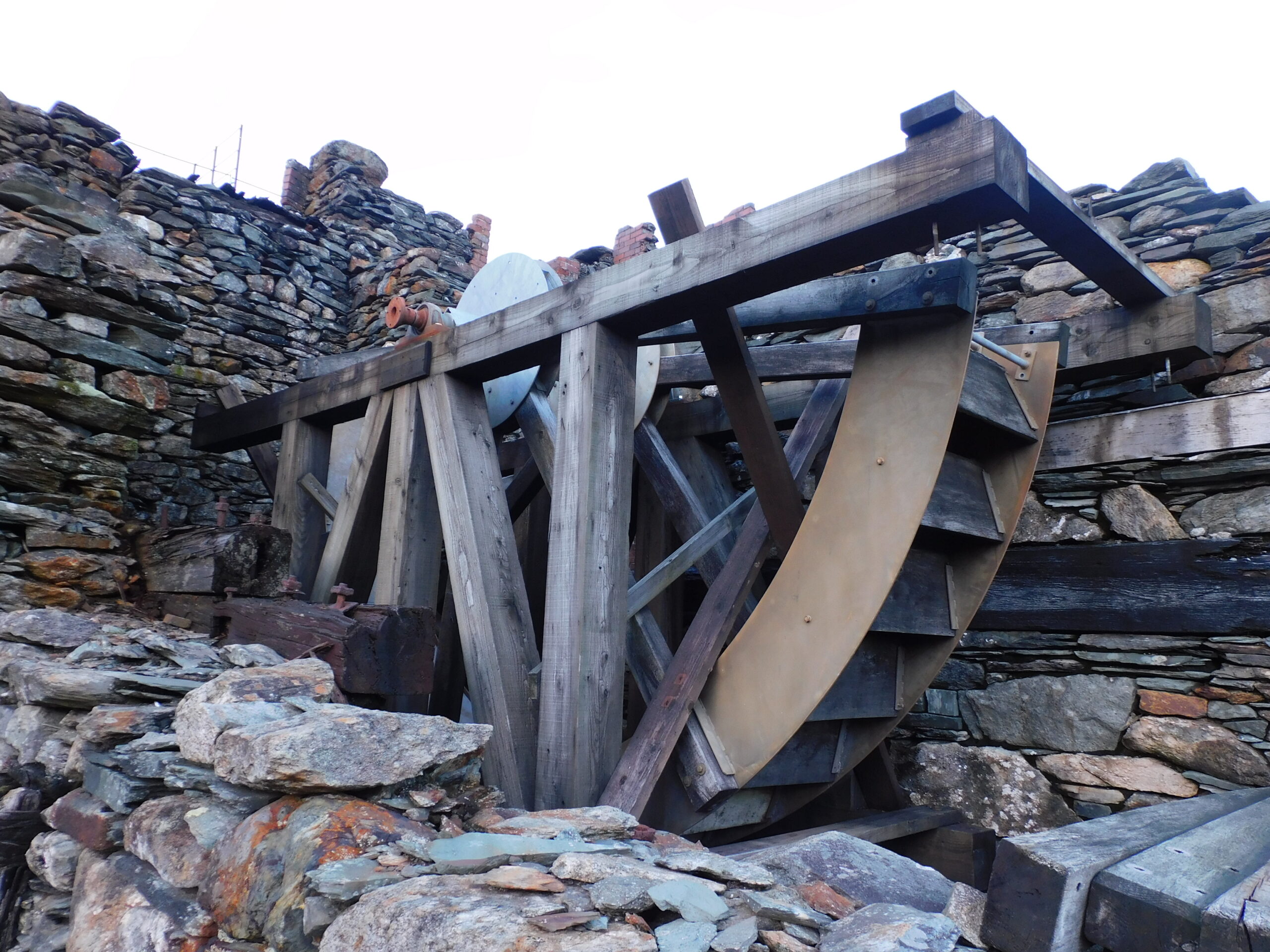
There is also what looks like another wheel being constructed in one of the old mine buildings. Otherwise, the site doesn’t seem to have had much work done. Old mine tubs on wheels, various other mining equipment and machinery lie around the site.
There is a shed full of other equipment, but it is in no obvious order and is mostly unlabelled, and just seems to have been stored there, including old bits of furniture and other objects that seem to have only a tenuous link to the mine workings. The site is in better shape than the first time I saw it, but it still needs a lot of work.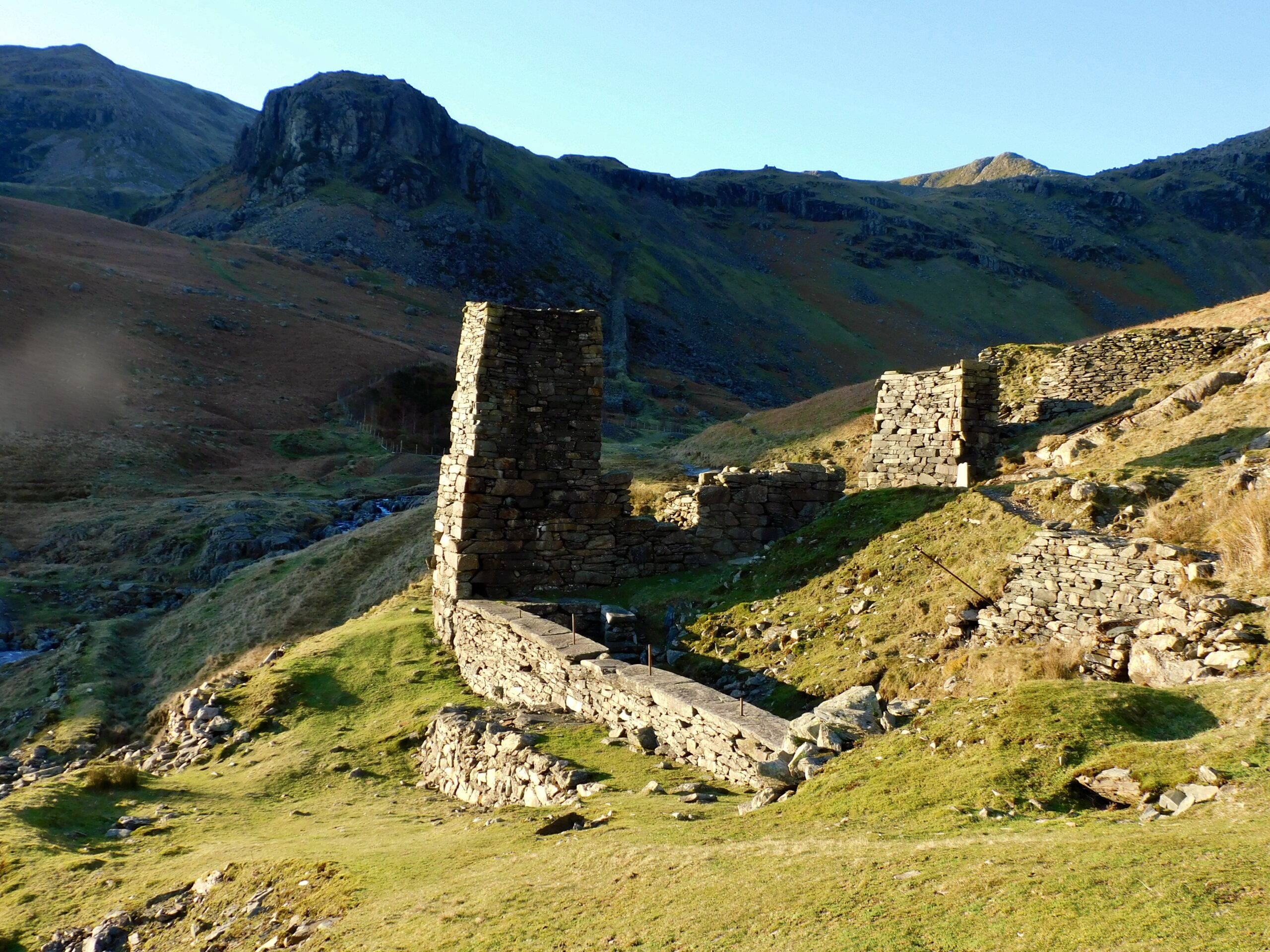
Higher up the valley are the remains of another wheel driven power house for the East Bonsor copper mine. This is still in a derelict state, though I presume they must have done some work on it to preserve it. It has an impressive wheel pit that you can see in front of the tower like structure. It was used to power pumps and haul tubs of ore from shafts quite a distance away. There are remains of a pathway used for hauling materials by rope of chains from this wheel on the other side of the valley that you can see to the right of the tower.
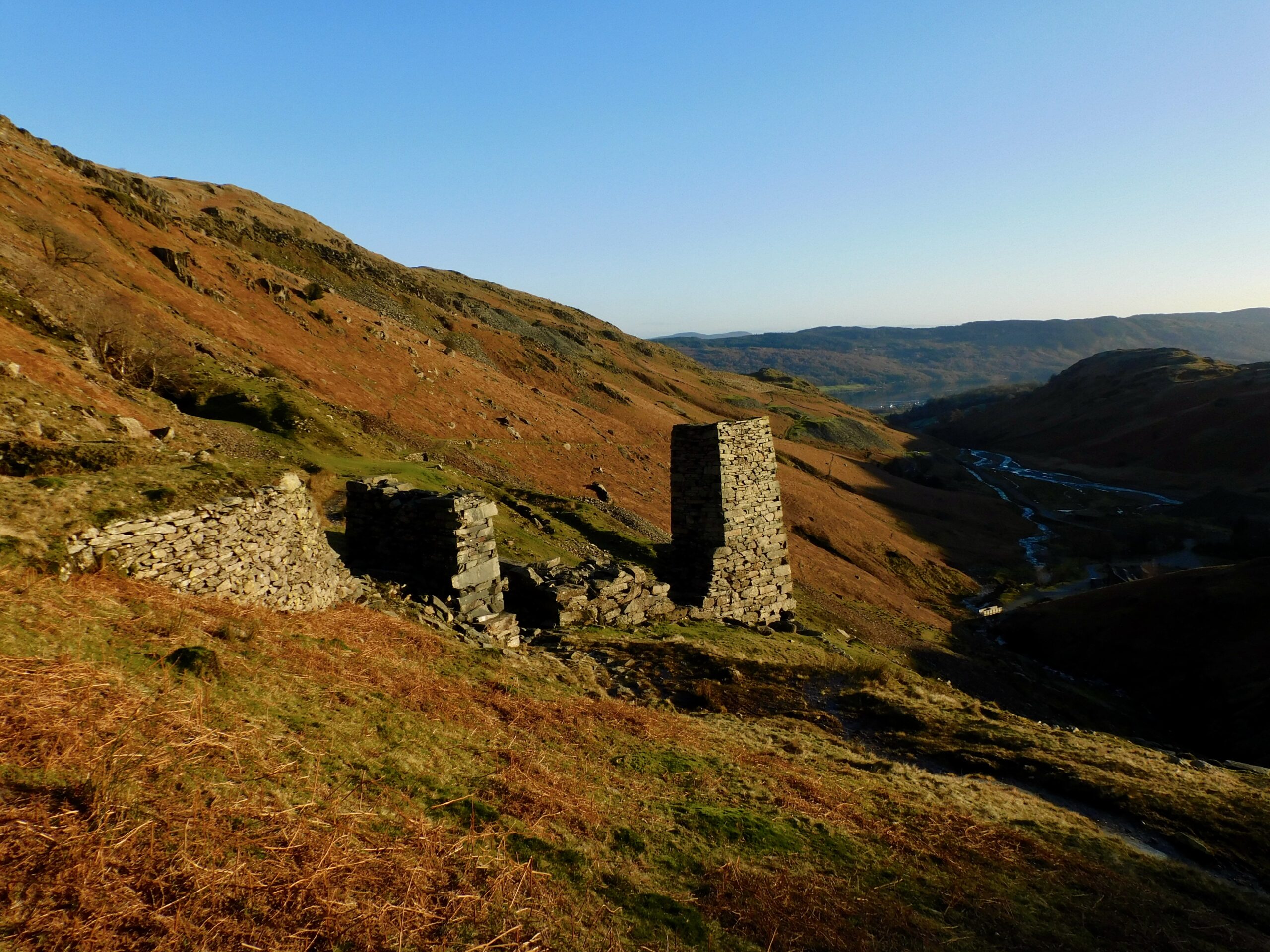 This is the view from the East Bonsor power house looking the other direction down the valley towards Coniston. The mines operated in this area from Elizabethan times to the mid 20th Century.
This is the view from the East Bonsor power house looking the other direction down the valley towards Coniston. The mines operated in this area from Elizabethan times to the mid 20th Century.
6th December 2023: Snow in Cumbria
After the sunshine in the previous blog, now I have some snow scenes to show you. Cumbria was hit by heavy snowfall last weekend, with reportedly nearly 3 foot of snow falling in some places, and people stranded in their cars on the road to Ambleside and around Kendal. Where I was near the coast was not as bad as that, but the Cartmel peninsula was hit by the snow fall enough to make me not want to go very far, as the roads were pretty bad and dangerous to drive. I managed to get to Haverthwaite, and took some photos, the best of which are shown here:
River Leven from the Haverthwaite bridge.
Walk along the bank of the River Leven at Haverthwaite.
Low wood buildings and clock tower.
Tree in a field at Haverthwaite.
Bushes next to the road weighed down by snow.
A splash of colour in a monochrome world-red berries in the snow.
Snow covered trees at Haverthwaite.
Entrance to a snow covered field at Haverthwaite.
Path through the snow covered wood at Haverthwaite.
20th November 2023: Autumn colours in Cumbria
The last couple of weekends, I have taken advantage of periods of sunny weather to go out and photograph the Autumn colours in South Cumbria. There is a fairly brief window of opportunity between the leaves turning into their Autumn hues and the first strong winds that remove all the leaves from the trees, and I was lucky to be able to exploit some sunny days to capture the colours.
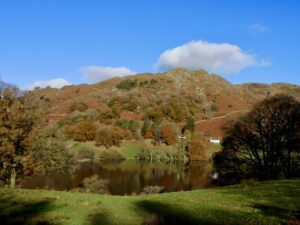 Loughrigg tarn has always been a family favourite for this time of year, and the colours are good this year.
Loughrigg tarn has always been a family favourite for this time of year, and the colours are good this year.
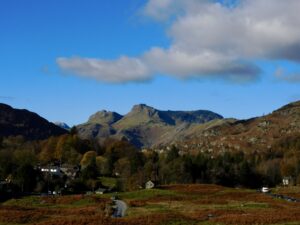 The area around Elterwater is another good place to visit in Autumn, with the Langdale Pikes as the backdrop.
The area around Elterwater is another good place to visit in Autumn, with the Langdale Pikes as the backdrop.
Yewdale Tarn also provided a fine array of colours.
and individual trees in their bright yellows and reds.
Coniston Water, looking north from Spinners Cove.
and also Grasmere with the surrounding hills.
the Old Man of Coniston from Torver is a favourite view as well.
Tarn How’s is always beautiful when the trees are showing their autumn colours as well.
Another good point about this time of year is the colourful sunsets and sunrises, such as this one over Cark.
And the sunrise with the moon above, also from Cark.
all this almost makes up for the cold and wet days!
22nd October 2023: two steamy weekends
A couple of weekends ago the East Lancashire Railway had its last steam gala for the year. It had three visiting locos, two of which I was keen to see, so I spent a morning in Bury to take some photos and enjoy the event.
One of the visiting locos was a Stanier ‘Jubilee’ class 4-6-0 45690 “Leander” here seen running into Bury Station. It looked very good, highly polished and in good condition. The only thing that I might object to is the trend to paint these locos black instead of green or red, which makes them seem less attractive, and harder to photograph successfully, especially in English Autumn conditions!
Another of the visitors was a Stanier 8F 2-8-0 no. 48305, which is seen in Bury Station. There is a diesel behind it, as this steam loco had been having some problems with its injectors, and they probably felt the need for back up. Another good LMS loco matching its surroundings!
There were also a variety of tank engines, including this Fowler designed “Jinty” 0-6-0 No. 47298 which is based on the ELR. It was operating a service to Heywood as part of top and tail motive power with:
Barton Wright 0-6-0 saddle tank no. 51456, which is always a sight to see for anyone interested in the Lancashire and Yorkshire Railway. This loco was built in 1881 as an 0-6-0 tender engine, and converted to a saddle tank in 1896 under Aspinall’s management.
There was also the Hudswell Clarke 0-6-0 no 32 “Gothenburg” running, which is an ex-industrial loco built in 1902.
The following weekend, I have had to stay in Manchester, so I took the opportunity to go and watch another steam special visiting Manchester.
This was headed by another Stanier ‘Jubilee’ class 4-6-0. This one was No. 45596 “Bahamas” and was heading the “Mancunian” special from London to Manchester and back. At Manchester Victoria I was lucky enough to catch it in a patch of sunshine, which really brings out the green livery nicely. Much better than black as a colour for locos, if not quite as nice as LMS crimson lake!
The other visitor to the ELR for the steam gala was Bulleid ‘Battle of Britain’ class pacific No. 34072 “257 Squadron”, and I caught it on the way to Bury station to double head a service with fellow streamlined Bulleid pacific ‘West Country’ class No. 34092 “City of Wells” which is based on the ELR.
One of the viewpoints that I use in Bury is a bridge over the line that looks down into the yards at Bury South, so I can see the locos moving off shed and up to the station. It is a good place to catch dramatic steam and smoke photos like this one as well as the more conventional photos. This is the 8F 48305 moving up towards Bury. It can be frustrating as well if the locos continue all the way up the line to the station hidden in a cloud of steam!
5th February 2023: Kendal Model Railway Exhibition
Mark and I went to see the Kendal Model Railway Exhibition last weekend, as we had enjoyed it last year, and the weather was not very good-cold and wet, so an indoors attraction was perfect!
The first layout we saw was an impressive 00 gauge one based on Irish Railways. It had a long running track with slow and fast platforms on a station and regular freight traffic as well, and an extensive fiddle yard with a fine array of trains. The detail of the scenery was very impressive.
The details of the scenery was excellent, though of course nothing much moved apart from the trains! Like many of the layouts, it was set in a period when the majority of trains were loco hauled by diesels and electrics. One noticeable feature these days is that there are very few steam loco models! I guess the current generation of modellers is modelling the period they remember best, and steam is too long ago, even for the mostly middle aged to elderly men who seemed to be the majority of modellers.
There were also quite a few smaller layouts, comprising of just a yard and a number of trucks for shunting locos to move about. These emphasised the detail of the scenery, like the one above, even down to the debris lying around. It is almost like the real thing, except the un-natural lighting and lack of human movement.
There was also a layout based on a fictional border station between two European countries that was interesting to watch, as trains swopped locos for a new country. As you can see from the photo above, this did have a steam engine on it! The catenaries were well modelled, but not live, and like most of these layouts, the signalling was being worked effectively and correctly, much to Mark’s satisfaction! All he needed was a timetable, and he would have been happy!
One intriguing element of a couple of layouts was that they actually had road vehicles running on the roads, at correct speeds and right side of the road. The photo above shows a yellow lorry on one of these layouts. This layout also had a canal boat moving slowly along the river, as you can see on the right of the photo. It added another point of interest to the layouts, and we thought they must be operated by magnets under the baseboards. It was clever stuff!
Another layout had the three parallel bridges on it, as in the above photo. This model was based on the UK railway from around 1980, and has a good variety of trains operating, but the centrepiece was the bridges which were impressive, as well as the canal running alongside them
with locks, and there was an impressively modelled town as well on one side towering above the station.
I think that this was my favourite layout, though Mark would probably not agree.
One of the layouts was a docklands railway, with very impressive buildings modelled on real docklands architecture from the 1970’s. They are interesting to look at and you can admire the skills of the modellers, but it doesn’t provide much as a spectator as few trains seem to run on them.The exhibition was a good one, with a good variety of well planned and operated layouts, and we both enjoyed it.
22nd October 2022: Steam Gala at East Lancashire Railway
Last weekend, the East Lancashire Railway had its last steam gala of the year. They have been celebrating the amalgamation of the Lancashire and Yorkshire Railway and the London and North Western Railway in 1922. This gala included 5 of the six remaining L&YR locomotives and one LNWR loco, and as a member of the L&Y Railway Society, I couldn’t really miss this one.
I started at my usual position at the bridge just south of Bury South Signal box, so I could see the locos come off shed and run up to the station. This photo is of Barton Wright ‘Ironclad’ no 52044 running past Bury South Yard. This loco is usually based on the Keighley and Worth Valley Railway.
I also saw the Aspinall A class no. 52322 running past the yard a little later. This loco is a regular and reliable performer on the ELR-long may it continue! All of the locos appeared to perform well, which is imprssive considering they are all over a century old!
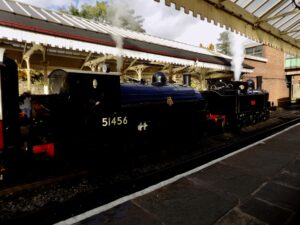 I then spent some time on Bury Station. This is the Aspinall saddle tank 51456 and the Webb coal tank 1054 ready to take a train north. The Aspinall saddle tanks were rebuilt from Barton Wright 0-6-0s like 52044, as Aspinall replaced them with his own more powerful A class locos.
I then spent some time on Bury Station. This is the Aspinall saddle tank 51456 and the Webb coal tank 1054 ready to take a train north. The Aspinall saddle tanks were rebuilt from Barton Wright 0-6-0s like 52044, as Aspinall replaced them with his own more powerful A class locos.
The solitary LNWR loco was the Webb coal tank 1054, here seen running through Bury Station. The LNWR has nor done well with preserved locos, with only four mainline locos preserved, and only the G2 0-8-0 from the larger types of locos still in existence.
The Coal Tanks first duty was to haul the Aspinall pug 51218 into the siding at Bury Station. This loco is based at the Keighley and Worth Valley Railway, and is currently not operational. It has the distinction of being the last L&Y loco to be working on British Railways, being withdrawn in 1964.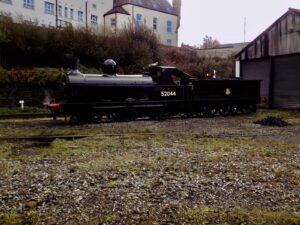
52044 spent some time in the yard of the Bury Transport Museum, before double heading a service to Rawtenstall. This loco is probably best known as one of the locos used in the original film of ‘The Railway Children.’
There was also a Southern Railway interloper in this Gala in the shape or West Country Pacific ‘City of Wells’ but I ignored it, mostly! It is about to have a major overhaul, so this was the last occasion for it to be in service for a while.
The Aspinall and Barton Wright 0-6-0s double headed a service from Bury, which was something to see! The gala was the first time these locos had been seen together for a long while, and even longer since five L&Y locos were seen together. The sixth existing L&Y loco is the Aspinall 2-4-2 tank based at York Railway Museum.
At the end of the Gala, they sent the last train to Ramsbottom for Bury with the four active L&Y locos as a quartet. This is a photo of the arriving at Ramsbottom, with 51241 in the lead.
This is another photo of the four locos at Ramsbottom, with 51241 leading, then 51456, then 52044, and 52322 at the back. It was quite a sight to see! As they say, a once in the lifetime opportunity!
14th October 2022: Furness Model Railway Society Exhibition in Barrow
The local paper that is delivered free to us in Cark had some uses, such as advertising local events and open days. The Yewbarrow House garden opening was one example, and the advertisement for the Furness Model Railway Society Exhibition is another. As the weather was not very good, and I have not been to a model railway exhibition for a while, I decided to go to this one in a school on Walney Island. It turned out to be more than just a model railway show as well. There were rooms devoted to railway simulation games, which are quite sophisticated these days. One of the ones on show had the player operating what looked like accurate controls for driving a modern DMU, down to the controls for opening and shutting the doors. There were also a room full of very impressive models of ships, and one for aircraft models like the one below:
These models were flyable, and were very interesting. There was also a display of live steam locomotives, including this Royal Scot, which I am including for David’s benefit:
The arrangement of the exhibition was a bit unusual, with two larger rooms and a number of smaller ones along corridors, rather than one large hall as is usual from previous exhibitions I have been to. There were some seriously good layouts here. One that interested me was a model of the Crown Street Yard in Liverpool, from around 1960, when it was run down and about to close. This is a general view of the yard:
It also followed the line up to where the Moorish Arch had been:
Quite a few of the layouts were yards and termini like this, full of detail and atmosphere. The layout that Mark would have liked the best was a Swiss Railway layout and was a run-by layout with a fiddle yard behind.
it is a modern era layout, with several different levels, and bridges and tunnels, and as Mark would appreciate, a fully operational signalling system.
Again, the level of details on the layout was amazing, and I spent quite a long time looking at it. There was also a British scene run by layout that was very good as well:
There was a a good variety of trains operating and signalling as well, though I don’t think it was as well thought out as the Swiss railway!
This layout even had road vehicles running along the roads near the railway, presumably operated by magnets under the baseboard! Most of the modellers had done their best to make their layouts seem as realistic as possible, with scenic backboards and scenery. It made me wonder what it is that gives the game away on photos of layouts.
This photo that I took looks pretty good, but it is very difficult to make the lighting look realistic, and the artificial light reflecting on the car doesn’t help! Also it is difficult to make plastic look like metal, as you can see in the photo below.
Putting human figures in is also a giveaway, as they never look natural.
The one above looks good until you notice the big cr ack in the backdrop where two boards meet!
ack in the backdrop where two boards meet!
It is the above photo, not taken by me, that made me start tio think of this. It was used to advertise this show, and you really have to look quite hard to see it is a model and not the real thing. The little bits of rust on the loco, the fading paintwork and general state of the railway make it look very realistic. It is only when you look closely that one of David’s tests show it is a model-the wheels are too wide! Also, if you look closely, the leads on the front of the loco are painted on. It is often the smallest details that give the game away. But it is still impressive.
Overall, the exhibition was well worth visiting and I enjoyed it very much. I will have to keep looking through the local paper for other interesting events!
10th September 2022: Yewbarrow House Gardens
A few weeks ago, I noticed in the local paper that a house in Grange called Yewbarrow House was opening its gardens for public view that weekend. It looked interesting, so I decided to pay a visit, as it was only open on four weekends a year. It turned out to be a good decision. The map of the gardens that I was given is below:
It is quite a large site, and looks out onto the estuary. This is the view from the Prospect Tower over the Kent Estuary, with Holme Island in the distance: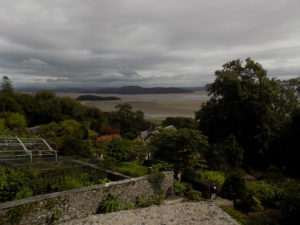
This is the Japanese Garden, with an infinity pool.
This is part of the Kitchen Garden
The greenhouse in the Kitchen Garden incorporated a couple of pre-Raphaelite stained glass windows rescued from a church.
This is the Gravels Garden
The garden was full of v very colourful flowers, and the garden was well populated with bees.
and also quite a few butterflies as well.
This is the Italian Terrace Garden, with sunflowers.
another quirky element to the garden was a number of sculptures, such as this one.
the owner has a wide range of Dahlias and other flowers, such as these:
So I was very glad to have noticed the piece in the local paper about it-it is well worth a visit!
3rd August 2022: Cumbria Steam gathering 2022
As requested, some photos of vehicles from the Cumbria Steam Gathering, taken out of the window of the house in Cark. They are not very good quality, as they were taken on a a miserable dark wet Saturday, except for the last photo which was taken on the Sunday, and so the general quality is variable. Still, I hope you enjoy them.
26th July 2022: Cumbrian insects
Inspired by the hotter weather recently, I have been stalking the nature reserves of South Cumbria for the insect life that I can find, and there is a lot to see, if you have some patience and can wait until the insects perch on something! I thought I would share some of the best photos with you.
This is a Gatekeeper Butterfly. There are reports that the butterfly numbers in the UK are declining, but I have seen quite a lot of them this summer. Unfortunately, they tend to be too busy to stay still long enough for me to photograph them! This is in the Latterbarrow reserve.
A recent visit to Foulshaw Moss allowed me to photograph a lot of darter dragonflies that were there. Luckily, they did seem more interested in posing on a twig fairly near to me, so I have got a few good shots of them.They are not always easy to identify, but this is a Male Common Darter, I think.
A recent visit to Latterbarrow reserve gave me the opportunity to photograph grasshoppers, like this one, They can certainly get some distance on their leaps.
and also this one. My not very sophisticated technique is to disturb them, and try to track where they land. Sometimes it works!
At Foulshaw Moss, there was also this Female Ruddy Darter perching on a branch. They are very colourful, but very similar in some cases, so identification is not easy.
This is a Male Common Darter, photographed at another reserve at Sandscale Haws, which is also good for butterflies and moths.
It is also good for various other insects like this Sloe Bug, in a very fetching purple colouration. They are bugs because they suck the juices out of plants, apparently.
Very similar but green is this Green Shield Bug-nothing to do with stamps, I am told! This is at Meathop Moss.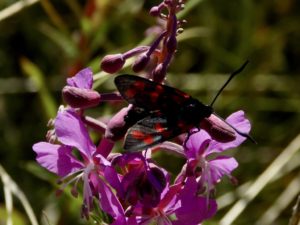
This is a Six Spot Burnet Moth at Sandscale Haws. Taking photos of these insects is a challenge, not just because they move just as you are about to take their photo, especially darker coloured ones like this!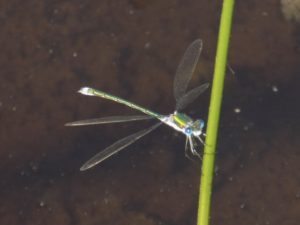
And to represent the damselflies, this is an emerald damselfly at Meathop Moss.
It is quite hit and miss about how much success I have with these photos, and it can be frustrating, but when they come out pretty well like somer of these, it is very pleasing. I will continue amusing Mark by stalking around the nature reserves, cursing when the insects fly away out of site, or perch somewhere where photos are not possible. Like many things, the few good ones make up for the many failures!
26th May 2022: Coulsheds, Bradburys and Steepers in the 1921 Census
I have started to search the 1921 census, which has been released this year. 1921 is a slightly frustrating census, because both Mum and Dad were born within a year of it being taken, Mum in August 1921 and Dad in January 1922, so neither will appear until the 1931 census is released. However, it is still interesting. To add to the frustration, I could not find our grandfather William at first, and eventually found his surname had been misspelled on the census. He was boarding with Albert Parsons and his wife in Lancaster, and attending the Teacher Training College there, and the census taker gave his surname as Coulsled-close enough, but making searching for it difficult! I wonder if William and Margaret had thick Rochdale accents at the time, and it confused the Lancaster census taker!
William Coulsled Boarder age:25 born 1896 Wigan Student (School Teaching) Lancaster Training College
Margaret Coulsled Visitor. age:25 Female born 1896 Whitworth
William F Coulsled Visitor age:<1 Male born1920 Wigan
As you can see, William’s wife Margaret and his eldest son William were staying with him at the time of the census. I did know William attended the Training College at that time, as we still have some books of his with that address on the flyleaf.
This census is the first that actually gives more details of where people worked, so I can discover that quite a few were employed by the Lancashire and Yorkshire Railway in 1921:
Edmund Coulshed age:50 born:Billinge,1870 Train Controler Lancashire & Yorkshire Rly Co
Frances Coulshed age: 23 born:Wigan,1898 Booking Clerk Lancashire & Yorkshire Rly Co
Edward Coulshed age:50 born: Orrell,1870 Station Master L & Y R Company Upholland Station
Edmund Coulshed age: 21 born:Wigan, 1900 Locomotive Stoker L & Y Railway
This is not really surprising, as the railways were one of the largest employers in England at the time. Working on the railways must not have been easy, with long hours and strict discipline, but it would have been a lot better than it was for the Coulsheds who were still working in mines or mills. Thomas, James and Henry Coulshed were coal hewers, Harry was a colliers drawer, and James a Colliery Labourer, and Mary and Sarah were weavers, all in the Wigan and St.Helens area, and at least three of them were out of work at the time of the census, so times for some of the Coulsheds must have been hard.
A few had moved into more white collar jobs, such as working as a clerk in a colliery like Joseph William, and another William was a cabinet maker, but mostly it is traditional blue collar work. Maggie and Helen were domestic servants, Maggie working at Drywood Hall, Worsley. Drywood Hall is a mock Tudor timber framed building built in 1855 that is now listed and looks rather attractive. In 1921, members of the Brook and Wallwork family, who were working for the Bridgewater Colliery Co. as a mine manager, a surveyor and an engineer, are listed as living there. It is now Bridgewater School. Alice worked in a relatives grocery shop in Orrell.
I have not searched very far for the Bradbury side of the family as yet, but I know that our Grandfather was in Liverpool by 1911, working as a teacher, living first in West Derby, and then in Wavertree by 1921:
Arthur James Bradbury Head Age:41 born 1880 Peterborough, Northamptonshire, School Master Liverpool Education Authority
Mabel Ellen Bradbury Wife age:39 born 1881 Lincoln, Lincolnshire, Home Duties
Hannah(Nancy) Bradbury Daughter age:11 born: 1909 Liverpool
Constance Marion Bradbury Daughter age:3 born 1918 Liverpool
Ernest James Bradbury Son age:1 born 1919 Liverpool
ADDRESS: 212 Thingwall Road, Wavertree, Lancashire
This is the address that Mum lived in until she moved to Score Lane after her marriage in the 1950’s and then 33 Woolton Hill Road in about 1960. Mabel Ellen may well have been pregnant with Olive when the census was taken, so in a way she was on the census! I don’t know why there is such a gap between Nancy and Con. Maybe they couldn’t afford any more children before Arthur got a permanent post as a teacher, or maybe there were miscarriages in-between. I was told that Nancy had a twin sister who died very young, so maybe it took them a while to recover from their loss, and I guess the First World War was not a good time to think of starting a larger family. I will have to search for more of the Bradbury family in the 1921 census when I can.
As far as the Steepers are concerned, Mabel Ellen’s brothers were also in the Liverpool area in 1921, two living not far from her, and one as a visitor in the Census:
ADDRESS: 4 Warnerville Rd, Broadgreen, Liverpool
Walter Hyde Steeper Head age 35 born 1885 Lincoln, Civil Service Clerk Merine Toy Board Of Mland Revenue
Winifred Lilian Steeper Wife age 32 born 1889 Manchester
Terence Sydney Steeper Son age 7 born 1914 Birkdale, Lancashire
Denis Walter Steeper Son age 4 born 1917 Maidstone, Kent,
Margaret Aileen Steeper Daughter age 1 born 1920 Liverpool
ADDRESS: 12 Thornfield Road, Walton, Liverpool
Percy Hyland Steeper Head Age:46 born 1874 Lincoln Elementary School Teacher Liverpool Education Authority
Marian Steeper Wife. age 36 born 1885 Liverpool
Sydney William Steeper Brother Age 44 born 1876 Lincoln Clerk In Government Tax Office Civil Service
These records give some indication about how tight knit the family must have been, with two teachers for Liverpool Education Authority and two civil servants in the tax office, and at least four of them living in close proximity. I guess that losing their parents as children and having to rely on each other might well have forged very strong bonds between them. This is the family Mum remembered from her childhood with great fondness.
11th April 2022: World of Stonehenge Exhibition
I have spent a few days recently staying with Mark in Oxted, and visited a few exhibitions whilst I was there. I think the best was an exhibition at the British Museum called the World of Stonehenge. As the catalogue states, Stonehenge was not created in isolation as a static, unchanging structure, but was part of the cumulative achievements of generations of people from all over the world which was part of a complex network of cultural interactions, environmental change and belief systems. The exhibition covers roughly the time period 4,000 to 1,000 BC, and has a vast array of interesting artefacts covering the gradual change from hunter gatherers to farmers, and from using stone tools to metal working. It shows a wide range of exhibits from practical objects like tools and cooking pots to cultural and religious icons. The exhibition starts with the stone tools that were being used as Stonehenge was created:
This axe head in a decorated haft were found in Cumbria, and is an example of an axe head created in Langdale, which apparently was a well known place for getting materials for axeheads. Presumably the rock there was just right for the job and were highly valued, as Langdale axeheads spread over a surprisingly wide area. This axe dates from around 3,500 BC.
There was also a great need for flint tools, and many mines were dug down to seams of flint, and the flint pieces extracted using antler picks such as these. It must have been hard, dangerous work, but profitable for someone. Apparently, the fingerprints of the ancient miners can still be made out on the chalk slurry coating the picks.These are taken from Grimes Graves in Norfolk, and date from around 2,500 BC.
Less practical, but more striking in appearance, is the Knowth decorated mace head from around 3,250 BC. This was found in Ireland in a great mound, and is presumably for ceremonial purposes. As the catalogue says, it was created from a piece of flint by a skilled artisan, with the spiral and linear design standing in relief. It was obviously a valued and significant object buried with its owner, perhaps a symbolic representation of an ancestor., as from straight on, it could be a stylised human face.
There are other strange carved objects in the exhibition, like this Towie decorated and carved stone ball from Scotland, created around 3,000 BC. The carving is skilled and intricate in black stone, one of a large number found in Scotland, the archaeologists have little idea of what they are supposed to represent. The catalogue lists a few strange theories, like they are used for moving megaliths, represent mathematical figures, or more practically, are tokens of social status. Whatever the truth, they are intriguing objects.
Even in ancient times, as in more modern ones, the artefacts that survive seem to belong to the more affluent members of society, as they could afford objects made of more long lasting materials like gold, and this exhibition had a number of them. There were several gorgets like this, that would have been worn around the neck. This one was found in Ireland and dates from around 750 BC. The skills of the workmen in creating these objects is amazing, with such fine even lines and perfectly sized and spaced decoration . It must have been spectacular to see a person wearing all their finery like this.
But some of the ceremonial dress just seems a little ridiculous! like this supposed hat, the Evanston Gold Hat from around 1300 BC. You can’t really imagine anyone wearing it and retaining any dignity, but maybe you just had to be there! Maybe it was a test of faith-if you laughed, you were next in line for sacrifice! It is beautifully created, though, with perfectly spaced loops and circles, and a sun like starburst on the tip.The catalogue suggests that their dazzling, extraordinary appearance may have been the point in ceremonies and rituals.
the comparison with the earlier ceremonial headdress is stark. This antler headdress found in Star Carr, Yorkshire, dates from around 9,000 BC and still today exudes a faint air of menace and magic. It was created from the skulls and antlers of a stag, and could have celebrated a good kill, anticipated future success in hunts, and acted as a means of bringing a community together to celebrate their survival and existence in a harsh world.
The object used to promote the exhibition is the Nebra Sky Disc. This was found in Germany and was created around 1600 BC. It is the oldest material depiction of cosmic phenomenon in the world, and makes us aware that the people of its time had greater and more accurate astronomical knowledge than previously believed. The importance of accurate mapping of the seasons to farmers and their communities meant devices like this were regarded as vital to their success in farming. It is a beautiful and also practical object, and evidence shows it was updated several times as the users knowledge increased.
The exhibition also included some interesting decorative objects, such as this horse snake hybrid found as part of the Kallerup hoard found in Denmark. Again, and symbolic meaning can only be guessed at. The gradual development in skills in working metal and replacing stone objects with forged or molded metal ones was shown, and even how more traditional users were provided with metal axe and spear heads forged to look like stone ones!
There are a large number of examples of everyday household objects in the exhibition as well, showing development of types of pottery, and cooking vessels, but what always catches the eye is the gold objects. This is the Mold Gold Cape found in Wales, and created around 1700 BC. It is another beautifully designed and created object from a burial of some local rich person.
Mark and I agreed that this is a very interesting exhibition, more focused than some of their previous ones, and less prone to building hard to believe explanations of purposes of objects on very slender evidence. Like the Ice Age Art exhibition a while ago, it shows how long ago mankind were already trying to interact with and interpret their world, even when their own existence was precarious, and how their knowledge and understanding of it and belief systems were greater and more complex than we imagine. This blog is only a brief summary of the best bits, and if anyone outside of my family reads this, it is well worth making the effort to visit this exhibition.
20th February 2022: museums in South Cumbria, or what to do when it is cold and wet.
As you might expect, it has been cold and wet in the Lakes for the last few weeks, so I have had to try and find something else to do, preferably indoors. There are a few museums in the South Lakes, several of which I have never visited, and this seemed an ideal opportunity to do so.
The first is the Dock Museum in Barrow. Mark has refused to visit Barrow, saying it is a depressing place with nothing of interest in it. I think Mum and Dad thought the same, though Dad was quite interested in the industrial history of the area. Barrow is best known for shipbuilding, and still builds submarines in what is now the BAE shipyard.
the shipyard is behind this lifeboat, which is outside the Dock Museum. It is not a very big museum. It is built over a former dry dock, and seems to be pretty popular-it was quite busy when I was there. Maybe a lot of people were looking for something to do on a wet day!
The museum has quite a few models of the ships built by the shipyards, used to advertise their wares like any other manufacturer. They are all really beautiful to look at, down to the great detail of the small items on the decks. They had a team of skilled workmen producing these models, and I vaguely remember seeing one in a window near the Vickers shipyard on one of our infrequent visits.
There is a lot of information about what life working in the dockyard was like, how there was a wide variety of skills needed in shipbuilding, and how the workmen started as apprentices and developed specific skills as they gained experience. It is an fascinating story about a way of life and work that has largely vanished. They also took part in Barrow carnivals and festivals, and had this wooden bust of Mussolini to amuse or frighten people on their stand or float.There are also films about Barrow and South Cumbria which are interesting.
The museum does not just deal with the shipbuilding, but also has displays of ancient artefacts found in South Cumbria, such as the Urswick Hoard, and prehistoric burial jars and pots, viking metal weights and a lot of other interesting things found locally.
one such object is this toy Hercules found near Furness Abbey. The museum also has sections on the German bombing of Barrow in the Second World War, and information about the railways and industry around Furness, including the industrial lines used to feed materials to the foundries and the shipyards. There is also a floor which shows paintings by local artists which is good as well. I enjoyed the visit, and it is well worth the time, even if it seems strange to not be outdoors when you visit the Lakes.
The second museum I have visited is the Kendal Museum. I have visited the Abbot Hall Gallery and the Lakeland Life Museum next to it several times, but this third museum is a bit less easy to visit, having limited opening times, and being a bit further away from the town centre. However, I am glad that I made the effort. It has a very mixed bag of exhibits, some of which are rather strange. A wealthy local man donated a number of Egyptian objects to the museum, which are on display, including some toes from a mummy. I did wonder if they were from one of the mummy unwrapping parties that were a brief fad in the 1920s, when if you were lucky you could go away with a bit for yourself! There are also a number of figures, such as the one here.
The museum also has a large collection of geological exhibits, such as the agate on the left. Again, a local man donated them to the museum.It is not something I am all that interested in, but this agate was very colourful and caught my eye.
Like the Dock Museum, there are a large number of objects found locally, such as these Langdale axe heads, which were highly prized in their time and widely distributed across the country. There is also a collection of arrowheads, remains of a prehistoric wooden boat, Roman objects, Viking objects and a lot of other interesting things. There is also a display of military items discovered at the Castle.
One floor of the museum contained a large collection of stuffed animals and birds, and pinned butterflies, such as the one on the left. The collection included a number of Australian animals, including an achidna, a kangaroo, a platypus and a wombat. There was no explanation of how they ended up in Kendal. It was probably another wealthy local who was keen on hunting.
The museum also has quite a few luxury toys such as this steam engine, and also a large model ship which must have been about five feet in length. There was also a couple of bikes, including a penny farthing. The museum was arranged a little bit chaotically, so this engine was under a display cabinet, and I was fortunate to see it.The museum suffers a bit like many local museums from being a rather haphazard collection of donations, but there are some very interesting exhibits. The only mild disappointment was the display on the Windermere branch, which was not very large. So this museum is another to think about visiting on a rainy day.
24th January 2022: Walter Sickert Exhibition in Walker Art Gallery, Liverpool
Liverpool and the Wirral have a number of interesting art galleries that I visit occasionally, including the Walker, the Tate and the Lady Lever. The Walker has a exhibition of the works of Walter Sickert on at present, and I went to visit it last weekend. The Liverpool Art Galleries bought a large number of drawings from the Sickert estate after his death in 1943 and his wife’s death in 1946, seizing the opportunity when the Family Trust was selling them. The Walker boasts that it has the largest collection of over 300 of his drawings in the UK.
Walter Sickert is an interesting character. He was born in 1860, and worked as a actor in his 20s before becoming an artist. Sickert stated he was influenced by Degas and Whistler, and you can see this in his early work in the compositions and use of colour.The self portrait to the right is titled the Juvenile Lead, even if he was in his forties when he painted it. He has a slightly odd sense of humour, and a liking for the macabre. He also loved the music halls in London, which by the time he started going to them were already in terminal decline. He was a regular visitor to them and painted both the artists and the audience, and also the faded grandeur of these old theatres, now well past their glory days
This is an example of his painting of music halls, showing the audience in the cheap seats in the gods, looking down on the stage. Some of the critics seem to think he portrayed the audience as unwashed, uneducated, little better than animals, but I think he has more sympathy for them than that. A common theme in his work seems to be the lives of quiet desperation that people lead, trying to survive and seeking entertainment and escape from their lives wherever they could.
He was also not above using controversy to try and sell his own works. He became part of the Camden group of artists in the early twentieth century and did a number of dark and bleak paintings of lower class life. What seized peoples attention was the ambiguity of them, when he never made it clear what he was portraying. They portrayed men and women, often unclothed, draped over beds and intimate spaces, in awkward and ambiguous poses. The recent murder of a shopgirl turned prostitute had caused a great furore in the papers, and people thought Sickert was referring to this, though he never made it clear. Titles like ‘What shall we do for the rent?’ seemed to make the connection with the desperation and misery of the men and women in the picture. After Sickert’s death, several people have claimed Sickert was Jack the Ripper, but as the exhibition made clear, it is very unlikely, as he was not in England when several of the murders took place.
In fact, he was in Dieppe, where he spent quite a lot of his time in the early twentieth Century. He was capable of brighter, more colourful painting as well, such as this one of Venice:
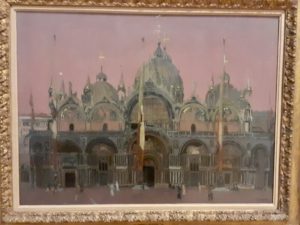 He also was commissioned to paint several works for an hotel in Dieppe, including this one of bathers:
He also was commissioned to paint several works for an hotel in Dieppe, including this one of bathers:
This to modern eyes seems like a bright colourful painting that a hotel could use for publicity, but others were less easy on the eye, with slightly odd compositions and modernist style, and the hotel in the end decided not to use his work
Sickert was also a good portrait painter in his own style, though he preferred to paint ordinary people in ordinary poses rather than rich people in their finery.
The one on the right is an unidentified young woman, and the one on the left was an Italian vegetable wholesale merchant. Sickert also returned to the run down glamour of the stage, with paintings like this:
Pierrots acting in Brighton during the First World War. I like the colour and the feelings of sadness and desperation that seem to come from it, and the sense of people trying to distract themselves from the war taking place on the other side of the Channel.
Perhaps Sickert’s best known work is Ennui, another scene of people getting by as best they can, and a couple sharing a room, but uno longer able to communicate.
Everything that they could say has already been said. Sickert painted the moderately well off as well as the poor, and seems to find similar desperation in both, even if in this painting there is some evidence of material wealth. Maybe the woman is bored with nothing to do and being by herself in the house, and the man can’t understand why she isn’t happier at being in her position. The feelings of boredom and suffocation in the painting are clear to the viewer.
The Exhibition also has a room for the drawings, and if I am honest, they were a little disappointing. Most seemed to be preparations for paintings, or sketches of details that could be used in paintings. they are interesting, but not really that vital to help understand and appreciate the artist. A few are full drawings, such as this:
But most of them were not exactly must see items. Sickert fell seriously ill in 1927, and then recovered, but his work after that is less interesting. As he was in his sixties by then, it is understandable that he ran out of inspiration and starting painting from photographs and old newspaper illustrations.He also taught and inspired a number of female artists, who have a room of paintings in the exhibition. Sickert taught a number of artists, and helped them to develop their artistic skills.
I really enjoyed the exhibition, which was a pretty comprehensive overview of his career. The Tate in London is curating a Sickert Exhibition later in the year, so it will be interesting to see what they include in it. The North is lucky in having a number of Sickert paintings in its galleries that are being exhibited in Liverpool, so I imagine the London exhibition will also be borrowing a number of them.
1st November: Flooding in South Cumbria
Cumbria has experienced heavy rainfall and flooding in the past week or so. Where we stay in South Cumbria is not as heavily hit as other areas on the west and north coasts, but you can still see the serious after effects, such as in this photo of Monk Coniston car park at the north end of Coniston, flooded and covered in debris. The lake had obviously overflowed and left a lot of debris all over the road as well.
I drove along the east side of Coniston, and the road was passable, but only just. They have built a lot of low walls at the lowest parts of the road to help prevent flooding, but a some points it still overflows if conditions are right, as shown in this next photo. There were still cyclists, making their way along the road, and in danger of puncture from the debris or getting a soaking from the passing cars.
Further along the road, in between Nibthwaite and Lowick Bridge, there were a lot of flooded fields like this one. The river Crake is usually in the narrow channel on the far left of the photo.
At Lowick Bridge, the Crake was very high, and the house next to the bridge seemed in severe danger of its lower floor being flooded, as the garden was already under water. It must be nice living there in summer, but I don’t envy the owners having to worry about flooding in the Winter!
On the other side of the bridge, the Crake has burst its banks again and flooded the fields. You have to hope the farmers have not lost too much in the way of livestock to this flooding.
Further down the Crake at Spark Bridge, the water was nearly touching the top of the arch and had flooded a little park next to the bridge. They have to build the bridges extra sturdily to put up with this treatment!
The other river that I went to see was the Leven, and it was very high as well. The bridge at Haverthwaite was also swamped, though this is not quite as high as it was a few years ago.Still, it is early days of Winter yet!
The Leven at Backbarrow was also alarmingly high, and foaming and frothing as it roared under the bridge. A lot of people were out and about looking at the floods in the brief period of better weather before the rain started again.
I also went to see the Leven at Newby Bridge where it was very high as well, and the Swan Hotel was in real danger of being flooded. This boat seems to have been torn from its moorings and ended up wedged against the bridge.
It wasn’t all rain and flooding last weekend in the Lakes. There was a four hour period on Saturday afternoon when the sun came out, and I could go out and enjoy the Autumn colours. I went to walk around Tarn Hows, and enjoy the scenery. There were yellow leaved trees like this one, shining in the sunshine:
And I climbed the hill and got a good view over the tarn, with the hills in the distance. So, despite the weather, I had a good weekend, got some good photos, and enjoyed the local produce!
18th October 2021: First visit to London for 2021
I recently went to stay with Mark in Oxted for four days. It was good to get out of Manchester and revisit London. It didn’t start well, as my train was delayed by an hour by a ‘Bovine incursion’ or cows on the line! I missed the last train to Oxted, and Mark very kindly drove to East Croydon to pick me up.
The next day, I went to see the exhibition of Frans Hals male portraits at the Wallace. His most well known work is the Laughing Cavalier:
What is amusing is the wry comment in the description nearby that the young man was neither a cavalier, or smiling! Hals was obviously highly talented, cleverly painting rich clothes and especially lace collars, and able to give vitality and life to his subjects, and was very popular in his lifetime. Perhaps if you were being harsh, you might say he didn’t give the psychological depth to his sitters that Rembrandt achieved, but then maybe it is unfair to compare him with one of the greatest painters that there has ever been! My only complaint is that there were only 15 paintings in the exhibition, so it didn’t take that long to go around them.
I went to see a large retrospective exhibition of Paula Rego at the Tate Britain as well. Paula Rego was born in Portugal, and has lived in the UK since the 1950s. She is one of my favourite contemporary artists. The truth is that the exhibition made it fairly clear that she did not really find her own way to express herself until the 1980s, when personal tragedy of her husband dying and changes to the political and social situation in Portugal seemed to spur her to paint more figuratively and express herself more freely on both personal and political issues. The painting above is typical of this period, with the artist expressing her feelings about her husband in the dancing figures. She has always been interested in female empowerment and strong independent women and how society represses them, and painted a number of strong works supporting women rights in a direct manner, but she also expresses herself indirectly using myths, fairy tales and stories she makes up herself. If I am making her sound a bit too serious, she saves herself by introducing humour and satire into her works, such as her take on the seven dwarfs story in the painting below:
I persuaded Mark to visit the British Museum with me to see two exhibitions, one on Nero and one of a collection of drawings by Hokusai that has recently been bought by the museum. The Hokusai drawings are important because they are for a never published book called the big book of everything, and the scope of the drawings matches this. I like the ones of the strange animals that Hokusai dreamed up such as:
and another example:
His work is so precise, and dynamic with no pen stroke out of place, and his imagination often running riot! We are fortunate that the drawings were never cut up by block makers, and have been preserved since. Unfortunately, as Mark complained, they are also very small, and it is not always easy to see what the subject is. This is not helped by the large numbers of people wanting to see them, and having to shuffle around the dimly lit display cabinets in a line.
We also saw the Nero exhibition, which was subtitled the man behind the myth. The aims seems to have been to show that Nero was not the selfish, cruel tyrant fiddling whilst Rome burned, and has been traduced by Historians after his death. The truth is that though the exhibition did have a lot of interesting displays in it, it did not really back up its case. A lot of them seemed to be what contemporary or near contemporary artefacts they had in the museum. They showed statues of actors playing tragic roles,![]()
and gladiators helmets, and friezes of chariot races, but their connection to Nero himself was tenuous.The truth is that Nero seems to have ruled by doing what the populace of Rome wanted him to do, and disregarded the wishes of the senate and nobility, and eventually his popularity waned, people turned against him and he was deposed. The exhibition claimed that he did not fiddle whilst Rome burned, and he was involved in rebuilding the city afterwards as well, but eventually his self indulgence in exposing himself to the crowds by acting in theatres and other similar things caught up with him.
It does seem that there was a concerted attempt to undermine his reputation by altering statues, such as the example below, and some evidence or attempts to destroy any reminders of his reign, but that is not unusual. How many rulers try to bolster their own reputations by attacking their predecessors?
The last exhibition that I went to see was a Swiss artist called Sophie Taueber Arp. I went because of a glowing review in the Guardian which made her sound very interesting and potentially a previously unknown and important artist to discover. She was a very skilled artist, able to turn her hand to carving, painting, making mannequins, house and room design, stained glass and many other applied art skills.
The divide between applied art in creating practical but aesthetically pleasing objects, and fine art, expressing emotions and opinions, has been blurred by the modern rule that everything can be art. STA was a fine applied artist, but I am not sure the attempt to make her out to be a great lost artist is very successful. Her work is interesting and clever, but doesn’t seem to express much apart from its own colours, shape and beauty. You do not get any idea of her own beliefs or passions from it, and I was a bit disappointed by it. However, it is always good to see for yourself when the chance occurs to see a new artist, and I was glad to have the chance. I had a good time in London, despite the problems with the train, and I will have to go back perhaps in the New Year to see more exhibitions.
![]()
August 16th 2021: Visit to Hadrian’s Wall
Last week, Mark and I were on holiday in the Lakes. The weather was a bit mixed, but on one of the better days, we took the chance to go and visit a couple of Roman Forts on Hadrian’s Wall east of Carlisle. The first that we visited was Birdoswald:
This is a view looking south along the west wall towards the farmhouse that was built on the site, and gives some idea of the size of the fort. We discovered that the forts were built to a standard design, so any garrison newly stationed in a fort would know where everything is without any problems of orientation.
 Parts of the wall may well have been little more than earth banks, but these forts were substantial settlements surrounded by tall stone walls and with large gatehouses, and must have been quite intimidating for the local population. It is apparent with the Romans, that you either obeyed their laws, or you were harshly treated. The benefits of collaboration were many, and the punishments for opposing them were harsh.
Parts of the wall may well have been little more than earth banks, but these forts were substantial settlements surrounded by tall stone walls and with large gatehouses, and must have been quite intimidating for the local population. It is apparent with the Romans, that you either obeyed their laws, or you were harshly treated. The benefits of collaboration were many, and the punishments for opposing them were harsh.
Birdoswald is fairly near a road, and was obviously regarded as a good site for other buildings, so it has had a Tudor Hall built over its granary site, as is marked in this photo below by the wooden logs, presumably marking where the walls of the Tudor building were. Then in the 18th Century, a farmhouse was built over part of the granary, which still exists today, as shown by the photo above.
Also, we learned that even after Rome withdrew its support, the remaining residents at the forts kept the settlement occupied for a long time afterwards. Presumably the people who stayed felt more at home here than anywhere else, and saw no reason to move.
The site has obviously been fairly extensively robbed of stones, and the other buildings show how the site has been reused over the centuries. But there is still quite a lot of the outside fort wall left, and the remains of the gatehouses, such as the east gate below, which would originally have towers each side and a double arch entrance:
The guidebooks also direct the visitor to the small carving below in the south wall of the granary, a rather nice representation of a horse.
The other fort that we visited was Housesteads, a little further east, and less easy to access. Mark was not pleased about having to climb the hill up to it!
This is much more complete than Birdoswald, probably because it is more remote, and many of the buildings still exist above ground, and the layout of the fort is much clearer. The hypocaust for the Granary building is still in place, for instance:
The site is well known for the surprisingly intact latrines, shown on the right. There is a bathhouse as well, so the soldiers did have a few creature comforts! The bath house here is not the one in the family photo of Mum and her three sons-we will have to look elsewhere for that.
And there are remains of the hypocaust and some of the stone floor of the commander’s house as well:He had more comfortable quarters, but the soldiers had barracks where each room had to fit in 8 of them. It must have seemed a very harsh, cold and dismal outlook for them up here on the northern frontier of the Roman Empire.
The archaeologists have found a number of artefacts at this site, including this carving of three hooded deities, that is in the small museum/shop on the site.
It was an enjoyable day out, even if it was a long drive to get there, and we only really scratched the surface of what we can see. I will look forward to returning, especially as Mark kindly bought us both subscriptions for English Heritage, who look after many of the sites.
August 2nd 2021: More Cumbrian Wildlife photos
Back by popular demand, and covering for a long gap between blogs, here are some more wildlife photos taken during recent weekends in Cumbria. Starting small and gradually getting larger! Firstly, here is a Gatekeeper butterfly:
Followed by a Speckled wood butterfly:
Slightly more exotic looking are the common blue butterfly:
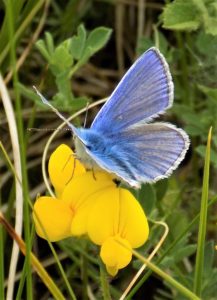 :And the Dark Green Fritillary:
:And the Dark Green Fritillary:
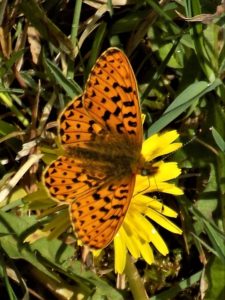 After an afternoon of chasing white butterflies around, I found out that there are three types of white butterfly in the UK:
After an afternoon of chasing white butterflies around, I found out that there are three types of white butterfly in the UK:
Firstly the green veined white, and then the small white:
And then the large white:
There have been tortoiseshell and peacock butterflies around as well, but I have included photos of them before. I have also seen dragonflies:
Black and yellow ones, and also mostly yellow ones:
Moving up the scale, I have seen a few common lizards basking on the nature reserve boardwalks and sometimes I have been able to creep up on them:
Last weekend, I went on to the south end of Newton Fell, as I thought it would have nice views, and there is a ruined tower and ornamental arch on it. There seem to be a lot of these small follies perched on hilltops around the Furness area:
On the way down, I heard heavy footsteps behind me and turned to see a pony trotting up to me.
It didn’t seem very shy about humans, and almost seemed to expect me to feed it.It had a wild, uncut tail and mane, and I realised later that it is part of the small herd of fell ponies on Newton Fell. It followed me down the fell, and seemed disappointed that I didn’t let it through the gate and out to freedom! It added a third interesting aspect to Newton Fell as well as the ruined tower and arch anyway, and made the walk worthwhile, as the path was overgrown in places with bracken and brambles which made progress difficult. Next time I go there, I will have to take a strong stick, and maybe some sugar lumps!
March 28th 2021: Mark in Cark
Mark has managed to visit Cark again recently after a long spell in self isolation in Oxted, as the lockdown is now easing. We spent a week there, enjoying the local produce, and visiting favourite places when the weather allowed us, whilst avoiding the busiest places. We visited Wastwater and Wasdale Head, and followed another family tradition by having a picnic there: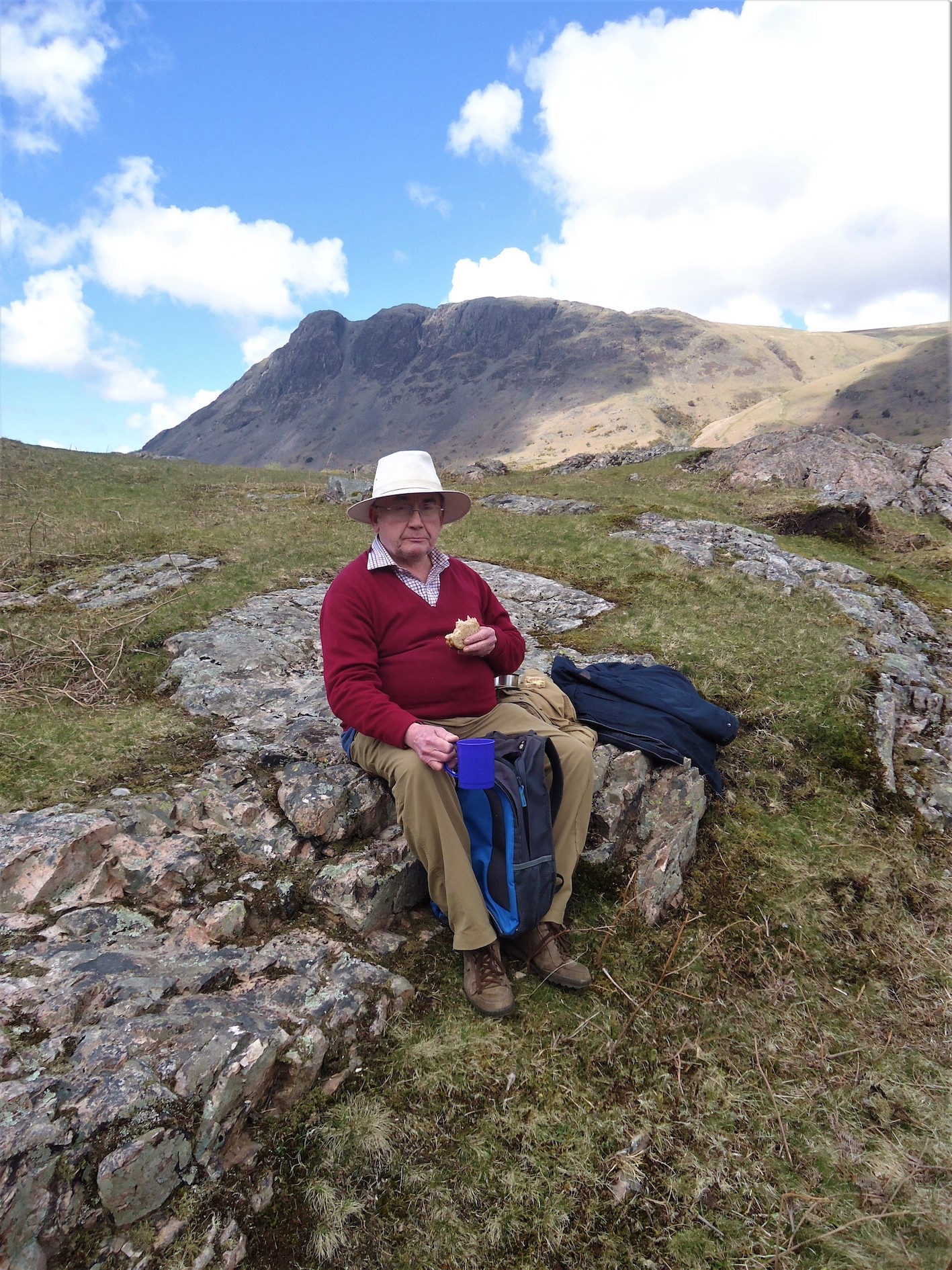
The weather was pretty sunny, but it was still a bit cold, and there was snow on the mountain tops: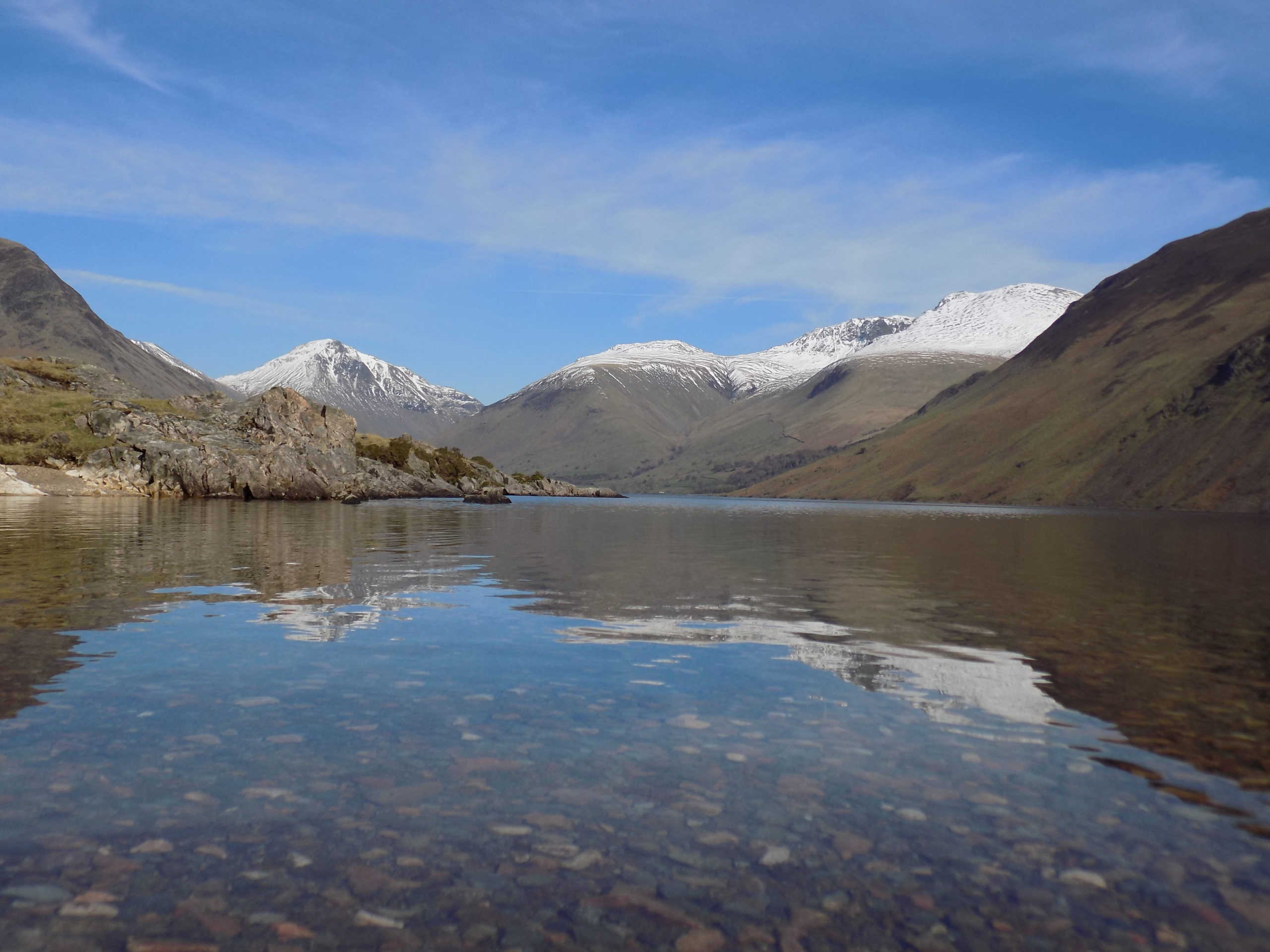
The landscape at Wasdale head was very beautiful as usual in the sunshine, with lots of lambs and sheep in the fields. The lambs seemed well behaved, and no gambling was going on that we could see:
During this visit, we noticed that are a lot of little black lambs with white ears in the area, so the black ram had obviously been busy this year:
We also visited Malham and walked to the Cove and also to Janet’s Foss, though unlike the visit with David, we didn’t climb to the limestone pavement at the top. There was one steep climb, but on the whole, it was a fairly easy and enjoyable walk. No doubt Mark will give more details in his flat walks blog.
Mark remembered a very nice cream tea in Malham that we had last time we visited, which was another reason to go there, but I think he was not sure in the end that we found the right place! We also went for a walk in Eskdale from Dalegarth, along the river to Doctor’s Bridge and back. The river was quite low, and the stepping stones at Dalegarth were visible and useable for once. We also saw a narrow gauge steam engine in Dalegarth station, so the railway is running again, with restrictions on numbers of passengers, as you would expect.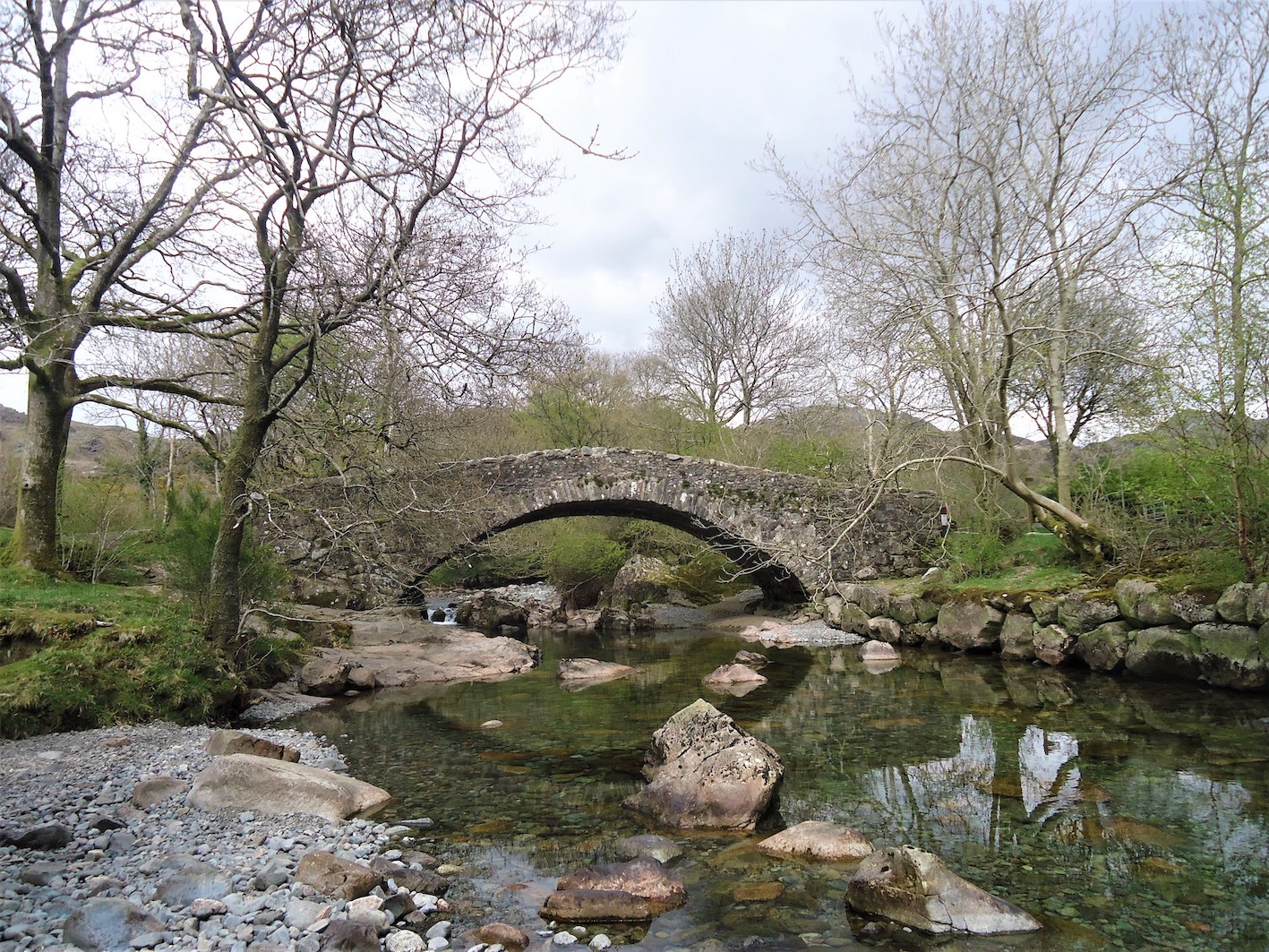
We drove to Hawkshead a couple of times for supplies, ie. Grasmoor beer and nice jams and marmalades for Mark, and on the way, we had a drink and a piece of cake at the cafe at the side of Esthwaite:
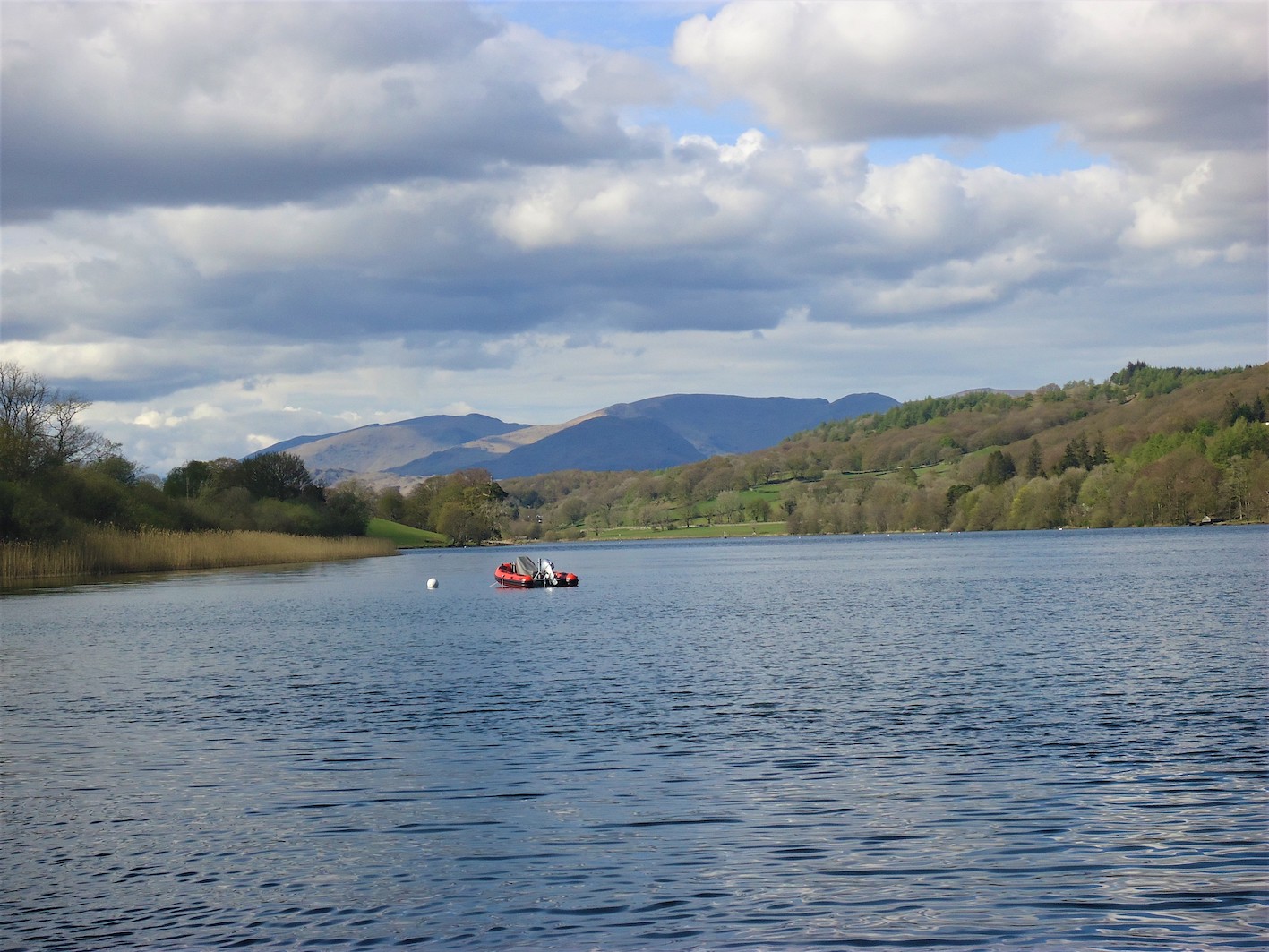 Someone is obviously putting quite a lot of money into Esthwaite to make it more attractive for tourists, as the facilities seem to improve each time we are there.
Someone is obviously putting quite a lot of money into Esthwaite to make it more attractive for tourists, as the facilities seem to improve each time we are there.
When Mark is not in the Lakes with me, I tend to do the more energetic walking that involves some climbing, such as climbing up Cautley fell to Cautley waterfall. Cautley Spout is the highest cascade waterfall above ground, with a drop of 198 metres. It is in the Howgill Fells, north east of Sedbergh.
I am trying to visit a few places that I have not been before, and this is one example. This is partly to give new subjects for the photos in the calendar, as well as being interesting! This is a steep climb, as you can imagine, and nearly finished me off as well, but I was lucky with the weather, and the view from the top is very good:
So I am enjoying being able to visit the Lakes again regularly, and Mark is hoping to visit again for the late May Bank holiday. With any luck, the weather may be a bit better as well.
March 28th 2021: Staying with Mark
I have just spent a week with Mark in Oxted, as we both felt the need for breaking our isolation in our respective homes, and so I drove down at the weekend. The weather was not particularly favourable, but I did get out a bit. One day I decided to walk to the North Downs, which are just the other side of the M25 from Oxted. It was a nice walk, though very steep when climbing up the Downs, and also wet and muddy, with soft clay underfoot. They don’t seem to believe in building pavements in this area, so a bit of dodging traffic was needed as well! I didn’t meet many people on the walk-the locals probably know better than to try until it is a bit safer underfoot! However, the view is interesting when you get there:
You could say the motorway spoils it a bit, but it is still worth seeing. The most prominent features are the new buildings being built where the gasometer was, and the tall crane next to them. I managed to slip over and get my trousers covered in clay and mud, so I had to try and sneak back to Mark’s house as unobtrusively as possible!
Mark and I also drove out to the south coast on the rare sunny day that we had. There is an ale brewed in Litlington called Old Man Ale that I like, so Mark guided me there, and generously bought me some beer. The Old Man of Wilmington is a chalk figure carved into the local hillside, dating from the Civil War period, though altered in Victorian times.
It originally had farming tools in his hands, but now they are divining rods, but to modern eyes, he seems to be getting out of a lift! Or perhaps walking with ski poles. We had a picnic in the grounds of the old priory at Wilmington:
And I had a look in the Church, which has some nice stained glass:
Then we drove on to the Berling Gap on the south coast west of Eastbourne, and I walked along the beach, doing a bit of beach combing:
Apart from this day out, Mark and I spent a lot of time on a rather difficult jigsaw of a Klimt painting called Tree of Life, that Mark finished when I had left.
We also ate a lot of good food, drank the beer, and relaxed, so a good week all round!
March 27th 2021: You can never go back
I don’t feel any great affection for Liverpool any more, and in fact I have now lived in Manchester longer than I did in Liverpool, but when I do go back, I do wonder about what has happened to the old house. Recently, it occurred to me to look around the internet for any news or information about it, and I came across the following photo of a recent refurbishment of the house:
It is quite hard to see it as the same room that we last knew when we owned to house:
This is how it was at the end of our time there; Comfortable, dark and a bit cluttered, with a thick carpet and lots of heavy furniture. This was the most modern part of the house, the result of a extension that was built in the 1980’s, and we thought it was pretty large space!. I realise now that the house needed a lot of work done on it by new owners, not least the old windows which had not been replaced since the house was built. But the new version of this room, all light and airy and minimalist, with a wooden floor, light furniture, and various walls removed, shows how much needed to be done, and also that even if I visited it, I would not recognise much of it.
January 17th 2021: Recent photos
I realise that I have not done a blog for a while, mostly because I have not been doing much during the lockdown. However, I have roused myself to at least put a few photos from the Christmas break in the Lakes on here, just to show I am still alive.
Firstly, a photo from the last visit to Silecroft to do a little beachcombing.Then a sunset taken at Ellerside:
And then a sunrise at Cark:
Followed by a photo of the Old Man from near Torver:
And Coniston Water:
A Wintery landscape near Priest Hutton:
and a similarly wintery and misty landscape near Silverdale:
A view of the snow capped hills near Tilberthwaite:
On the days we were not able to take advantage of the good weather, we did a jigsaw.
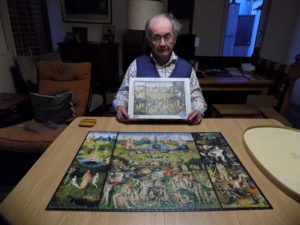
Mark made some very nice meals, and we sampled the local produce, especially the beers. So perhaps not very inspiring, but pleasant anyway.
October 27th 2020: In the footsteps of William the Conqueror
I have just returned from spending a week staying with Mark in Oxted. We both enjoyed it, as it was the first time we had met for a while, and I think Mark was feeling a little isolated, so even a visit from me was welcome! I took the opportunity to see a few exhibitions in London, but we also chose a couple of historical sites not too far away from Oxted to visit. They had to be open sites, so the risk for Mark was minimal, and so old mansions and museums were ruled out. We decided that we would visit Pevensey Castle and Battle Abbey, as I had never visited either of them, and it was so long since Mark visited them, he couldn’t remember anything about them! We first visited Pevensey Castle in East Sussex. We were blessed with a pleasant sunny day as well, so the ancient walls shone in the sunlight.
This is the gatehouse, which still looks impressive. Pevensey is where William the Conqueror landed on the coast, and he quickly built this castle on the site of an old 3rd century Roman fort, as it was then a lot nearer the coast, and guarded a harbour. The gate guards the inner bailey, which includes a massive keep:
The castle was used for a long while, and survived a number of sieges. It was pretty difficult to attack and was only defeated when the garrison was starved into surrendering. It fell into disrepair in the 16th century and became part of a landed estate and a site for local events such as fairs. In the second world war, it was used as an observation post and training area.
There are still substantial parts of the outer bailey standing, like this section at the west gate, some built on parts of the remains of Roman foundations. There are a number of towers still in existence, though none very complete, such as the one below. One disappointment is that there is not a walk along the walls, though there is a viewing platform on the north tower with good views.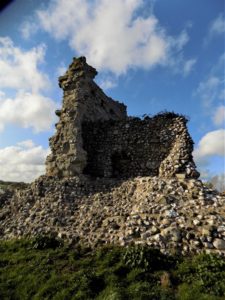
There was also a Tudor cannon, or demi culverin, to enjoy in the inner bailey:
I really enjoyed this visit, and there is a lot of the castle left to enjoy. The next trip that we took followed William away from Pevensey and up to Battle Abbey, where the fateful meeting with Harold took place. Battle Abbey was built by William to commemorate his great victory, and the first thing a visitor sees is the Great Gatehouse:
This was actually built in the 13th Century, and reflects the power and wealth of the Abbey at the time. It now houses several displays about the Abbey’s history and has a good view from the roof. The other substantial building still in use is now a school:
It was built as the Abbot’s lodging, and after the dissolution in 1538, Henry the 8th gave the estate to his friend Sir Anthony Browne, who lived in this building. He also completed the demolition of several other buildings such as the Church, Chapter House and Refectory. Like many of these estates, it gradually declined until the 19th Century, when interest in the history of the site increased again. This building became a school in 1922 and survived a serious fire in 1931.
Another large surviving building from the Abbey is the Dormitory:
this is another 13th century building. and is a pretty substantial. It had a roof until the late 18th Century, but had been neglected and was being used as a barn when the roof collapsed. Underneath it is the Monks and Novices rooms, where Mark and I had to hide from a sudden downpour. It is well preserved and very interesting:
Henry’s men did a good job of demolishing the Abbey itself, so all that is left is a bit of the Crypt at the east end, though we did speculate about what foundations might still exist under the grassy mound.
And of course William marked the place where Harold died:
We did not wander around the battlefield itself, as it was wet underfoot and threatening to rain again, and in reality it looked like any other field in England, not like the site of one of the most important battles in English history. Mark and I also found time to visit Beachy Head and admire the cliffs and lighthouse, and admire the Bomber Command memorial there:
and we also found time to complete a jigsaw:
So all in all a very enjoyable week!
September 28th 2020: Yorkshire Sculpture Park
I visited the Yorkshire Sculpture Park near Wakefield last weekend. The weather was very good, ideal for an exhibition that is mostly open air, and I had an enjoyable day out walking around the park, and visiting the gallery. The park is on the estate of Bretton Hall
The main artist being exhibited is someone that I have not encountered before. According to the YSP website, “Celebrated Portuguese artist Joana Vasconcelos creates vibrant, often monumental sculpture, using fabric, needlework and crochet alongside everyday objects from saucepans to wheel hubs. She frequently uses items associated with domestic work and craft to comment from a feminist perspective on national and collective identity, cultural tradition and women’s roles in society”.On the BBC website, Will Gompertz gives a mixed review of this exhibition. He writes that: “Vasconcelos is all about vibrant colour and baroque kitsch” and that “Vasconcelos’s Instagram-friendly art is full of good ideas but lacks any great ones”. I think that I would largely agree with this judgement.
For instance, the huge stilettos titled ‘Marilyn’ make a fairly obvious point about women’s dual role in society as domestic drudge and unrealistic goddess, though the wit of making them of saucepans and lids is mildly amusing. There are other pieces in the gallery that make the same point with a lot less wit, such as the cabinet of food and domestic appliances.
The best of them in my eyes is Valkyrie Marina Rinaldi, a biomorphic goddess covered in the materials from the fashion house Max Mara. I prefer to be able to see artworks that seem to have some craft and thought behind them, and can provoke more complex responses in a viewer.
The mask made up of mirrors is also an interesting concept, though you can imagine it a being a bit vulnerable to the Yorkshire weather!
But the giant cockerel Pop Galo with its tinny music and LED lights again seems largely kitsch and obvious. It indulges in the gigantism that seems to want to impress purely by sheer size and brightness of its colours, before you move onto the next. There are several pieces by Damien Hurst that have the same problem. Little thought beyond the idea that it would be cool to increase the size of an anatomical model or charity box figure to twenty times its normal size seem to be behind them.
This is the problem with quite a lot of the art on display in the park. It is aimed to give visitors a thrill when they first see the works, and then they can move onto the next without spending much time on any of them. Maybe this is art for the twitter generation, provoking an immediate rush of emotion without any lasting effect. This is Vasconcelos making a huge sculpture of gold hubcaps and glasses, which looks striking, but seems a bit obvious in its criticism of consumerism:
It did occur to me that they are more like pieces of engineering as much as art, in creating pieces that stand out in the landscape without being in danger of breaking or falling apart in high winds, or the colour deteriorating in the rain. There are a few smaller scale pieces like this by Leiko Ikemura that seem more thoughtful
The best artist on show here is Ai Weiwei, with his Circle of Animals/Zodiac Heads, and Iron Tree at the Chapel. You feel that he at least puts a lot of thought into his work and wittily expresses his concerns about the abandonment of tradition and the old in the headlong rush to some mirage of prosperity. This is his sculpture ‘Iron Tree’ next to the chapel:
David is always interested in what steam locos I have been seeing, so I am including a photo of ‘Scots Guardsman’ running through Cark station with the ‘Cumbrian Coast Express’ that I took last weekend.
September 15th 2020: Ancient and (a bit more) Modern in South Cumbria
This is a blog on the theme of ancient and more or less modern objects that I have visited recently in South Cumbria. Starting with the ancient, the Urswick area is dotted with ancient monuments, none of them very spectacular, but all interesting and in some cases in a beautiful setting, like Birkrigg stone circle, where excavations showed it is a ceremonial burial site. None of the stones are very big, but they are obviously laid as a circle, and have a great view of the estuary and Cumbrian hills beyond.
Another ancient burial site is the Great Urswick Long Barrow which is one of only six in Cumbria and the only known example from the Furness area. Like other long barrows in the north of England it is roughly trapezoidal and faces east, apparently. It is not that easy to find-luckily a couple of men with metal detectors were searching a nearby field and could direct me to it.
Also near Great Urswick is Skelmore Heads Iron Age hillfort which is a very distinctive place visible from all around, unlike some of the other ancient sites. The limestone pavements form a natural rampart encircling a flat almost rectangular area. Skelmore Heads is thought to date back to the Neolithic period, around 4000 BC – 2500 BC, but would have been used and updated through to the Bronze and possibly Iron Age. Large sites like this were often used for centuries, which may give an indication to their importance.
There is also a tumulus just north of the hillfort, shown in the photo below. Again, not obvious unless you are looking for it, and obscure in what it meant to the ancient Britons who set the stones up. Luckily for us, no-one has felt the need to demolish any of these sites, and Urswick remains seemingly largely untouched by modern development, though it might have seemed less so when all the mines and industrial railways were being operated in the area.
Moving into the late nineteenth century, the Pinder Ring Pit, south of Lindal, took its name from the field in which it was sunk. The pit was open from 1872 to 1890, and closed due to flooding. The pit buildings were demolished in 1905. Only a single sandstone support pillar remains as evidence of the tramway that crossed over the adjacent road to the nearby Grievson Pit. It looks rather odd, because on one side there is a minor embankment that might have supported the railway, but on the other there is no indication that there was ever a railway or even a mine here. It is hard to imagine that the peaceful and quiet landscape was ever marred by the sound of a mine and railway.
I have also recently visited Sandscale Haws and walked along the shoreline there. I discovered this time that there are a lot of dragonflies there, and took this photo of a blue and black one that posed obligingly for me.
I then walked up the shore to Askham and walked along the spoil-heap pier. It must have been pretty spectacular to see them tipping the red hot waste out of tipper trucks onto the pier, and this photo gives some idea of it, though it is taken in Turkey, at least the steam engine is British!.
On the other side of the pier there were a number of ships beached at low tide. I walked up to look at one of them, and discovered the owner was living in a boat next to it, and could tell me its history. It is the last remaining Composite Mersey Flat, Oakdale, and is also the last known surviving commercial sea-going vessel built in Runcorn. Built in 1951 by Richard Abel & Sons. He explained that it had been battered in a storm earlier this year, and he had to abandon ship and be rescued by the coastguard, who luckily are based about half a mile away on the shoreline!
I couldn’t go through a whole blog without something railway related, so I have included this photo of Ribblehead viaduct that I took last weekend. I went to see a class 40 along with a 47 working the North Pennine Staycation Express between Skipton and Appleby, and also enjoyed a walk along the Dee River in Dentdale.
There were a lot of people at Ribblehead, mostly going on walks around the area, but I have been able to avoid the crowded areas of the Lakes most of the time, and explore the more obscure attractions like the ones I have described here.
22nd July 2020: Back by popular demand: more wildlife photos
As the title says back by popular demand (Well, Mark asked anyway). More Cumbrian wildlife photos.
This first one is a Comma Butterfly, taken in Howe Ridding wood near Whitbarrow Scar. This is obviously the year for orange-brown butterflies, because I have taken photos of Fritillary butterflies as well this year, as in the previous blog.
Mark wanted a photo of a Brimstone butterfly, so here it is:
This is an elusive butterfly, rarely staying still, and even when in one place, not very co-operative, as you can see. This is as well as I could do with it. Maybe one day, I will get one with spread wings. Another more drab species is the Gatekeeper Butterfly:
I often seem to find what looks like an exotic species of creature only to find it is called the common… whatever. Here is a common Blue Butterfly:
There are also a few types of white butterfly, such as:
and the inevitable tortoiseshell butterflies posing in the sunshine:
I also got a good photo of a ladybird:
and a brown coloured grasshopper:
so the nature reserves in south Cumbria are still proving a happy hunting ground for me and my camera. Maybe to be continued…?
11th June 2020: Wildlife in the Lake District
The last few weekends, I have been taking advantage of the easing of the lockdown to go to Cark again. I am avoiding the most popular and busiest areas of Cumbria, and visiting the lesser known places, including the many nature reserves in the South Lakes area. This blog consists largely of the photos I have been taking of the wildlife.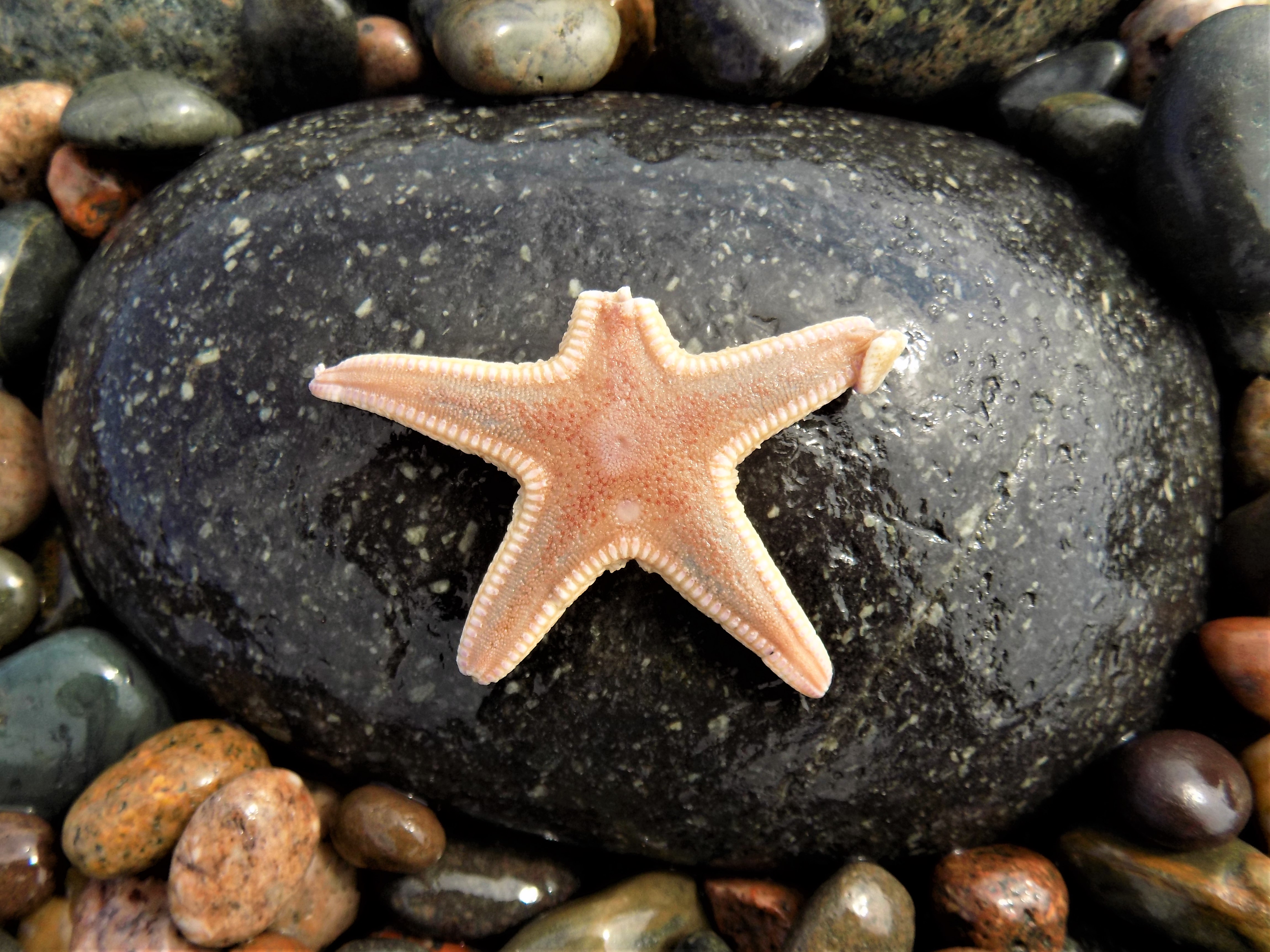
22nd July 2020
One weekend, I visited Silecroft, a beach that we visited a lot as children. I was doing some beach-combing for interesting pebbles, and came across this rather battered starfish.
There were quite a large number of small jellyfish like this washed up on the beach, as the tide was going out. I’ve no idea if they were alive of dead-how do you tell with a jellyfish? Some looked rather torn about, but this one was still in reasonable shape.
Spring and early Summer are a good time to look out for dragonflies and butterflies in the nature reserves, and the phot above is a blue damselfly at Lowick common::
The above photo is a red damselfly also taken in Lowick Common Nature Reserve. There were four spotted chaser dragonflies in the same reserve, like below:
There were other dragonflies, including a large blue one, but it never stayed still for long enough for me to get a photo! Other insects that I have seen include this grasshopper at the Brown Robin Nature Reserve near Grange:
I have also seen various moths and butterflies, including this smoky wave moth at Meathop Moss
And this high brown fritillary butterfly at Bark Booth:
There were lizards sunbathing on the boardwalk at Meathop Moss:
There were plenty of birds around, including this brambling, also at Meathop Moss:
Other insects included these St.Mark’s flies, mating on the path in the Duddon Nature Reserve, and oblivious of the occasional passer-by.
And last but not least, there are beautiful flowers such as this water lily in Lowick Common:
14th May 2020: Model railway in the loft at Prestwich
I ave used the lockdown to make some progress on my model railway in the loft in prestwich. I have got the baseboards in position and the first circuit of track is laid. It is in need of some fettling, but as you can watch on the video, it works.
The video is low quality, as I was using my iPad and there is limited space and not very good lighting up there, but it works! Now to build the other loop! The blue electric still runs well, considering it is at least as old as I am. There will be enough track to build a layout in Cark, as Mark and David seem keen on, but someone else more skilful than me at DIY will have to do the baseboards.
5th March 2020: Tutankhamun: Treasures of the Golden Pharaoh
I visited Mark in Oxted last weekend, and we visited the Saatchi Gallery near Sloane Square to see the Tutankhamun exhibition. This, according to the publicity, is our last opportunity to see 150 priceless artefacts that would never be seen outside Egypt again, and is the largest ever Tutenkhamun touring exhibition of the most famous discoveries in history. However, for once, the exhibition lived up to the hype.
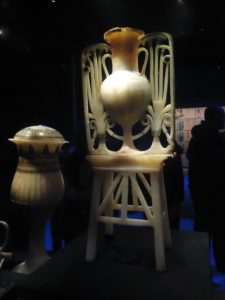 There are a lot of very beautiful artefacts from King Tut’s Tomb on display, including ornately carved vases and pots such as these. The exhibition was pretty busy, but it was arranged so that it was not too difficult to get to see everything. The amount of wealth and ostentation on display was very high, boasting of the immense wealth of the king. The exhibition also explained how many of these items were meant to help the king survive in the underworld that he had to journey through to get to their version of heaven. As Mark said, they had created a very eleborate set of Gods and beliefs based as far as we know on little more than their imaginations.
There are a lot of very beautiful artefacts from King Tut’s Tomb on display, including ornately carved vases and pots such as these. The exhibition was pretty busy, but it was arranged so that it was not too difficult to get to see everything. The amount of wealth and ostentation on display was very high, boasting of the immense wealth of the king. The exhibition also explained how many of these items were meant to help the king survive in the underworld that he had to journey through to get to their version of heaven. As Mark said, they had created a very eleborate set of Gods and beliefs based as far as we know on little more than their imaginations.
The exhibition also told the story of the discovery of the tomb, and how excited everyone was about this magnificent find. I guess it was in many ways the greatest archeological find ever, as no-one had disturbed the tomb since it had been sealed. All the artefacts even now seem to be largely untouched by the centuries that have passed since they were created:
The gold plated statues looked as good as the day they were completed, and were amazing to see.
There were also carefully carved miniature boats that somehow grew to full size in the afterlife, and helped the king float through the underworld:
And shields and weapons to help him defend himself, showing his courage and skills that he would need in the afterlife
Everything that he could possibly want was included to help his progress. It is amazing that it all has survived and we have the privilege of seeing it all now.
We were particularly taken by the statue riding on top of a black panther. Even representations of the Gods who would protect him were included:
I suppose that it is the dream of archaeologists to find something untouched by time like this. Rather than having to imagine what something was from fragments, or pieces of rotten wood, the artefacts are complete and unscarred.
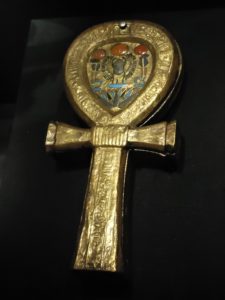 The other big exhibition that Mark and I saw last weekend was the Troy exhibition at the British Museum, that was also very interesting. But the archaeologists failed to find much in the way of treasure there, despite the claims that Schliemann made in 1870. The artefacts he found were mostly made of more common materials, and he didn’t find King Priam’s treasure, or any evidence that the Trojan War actually took place. In fact, the method of digging a large trench straight down the mound that Troy had been on may have caused more destruction of evidence than modern archaeologists would tolerate. Perhaps a nearer comparison to King Tut’s Tomb would be Pompeii, where everything stopped and was buried under the volcanic ash, to remain undisturbed for centuries, to provide archaeologists with a snapshot of Roman life that is unique and comprehensive.
The other big exhibition that Mark and I saw last weekend was the Troy exhibition at the British Museum, that was also very interesting. But the archaeologists failed to find much in the way of treasure there, despite the claims that Schliemann made in 1870. The artefacts he found were mostly made of more common materials, and he didn’t find King Priam’s treasure, or any evidence that the Trojan War actually took place. In fact, the method of digging a large trench straight down the mound that Troy had been on may have caused more destruction of evidence than modern archaeologists would tolerate. Perhaps a nearer comparison to King Tut’s Tomb would be Pompeii, where everything stopped and was buried under the volcanic ash, to remain undisturbed for centuries, to provide archaeologists with a snapshot of Roman life that is unique and comprehensive.
All in all, this was a very impressive exhibition, and we both really enjoyed it. It is bound to be one of the highlights of this years exhibitions, and I am glad we made the effort to see it.
15th January 2020: Bolton Abbey and Skipton Castle
Andrew asked me if we could visit some historic places around Manchester at the weekend, so after consulting with friends and looking online, we decided that we could visit Bolton Abbey and Skipton Castle, as they were close enough to Manchester for a day trip.We got up reasonably early as the weather forecast predicted rain in the afternoon. We arrived at Bolton Abbey at around the time it opened. It is in a rather beautiful setting, with a river winding through the landscape nearby, and is atmospheric, as these ruined abbeys tend to be:
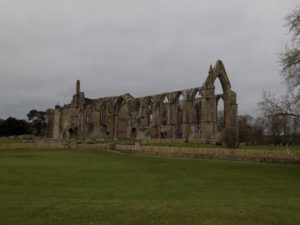 It is one of abbeys destroyed by Henry 8th in the sixteenth century. The interiors are interesting, with little pieces of decoration and ornate window frames hinting at what it must have been like:
It is one of abbeys destroyed by Henry 8th in the sixteenth century. The interiors are interesting, with little pieces of decoration and ornate window frames hinting at what it must have been like:
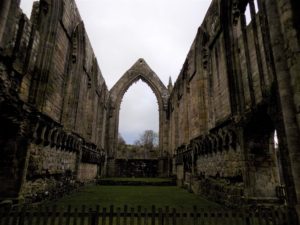 Andrew and I took a shortish walk along one side of the river and back on the other, which was pleasant. There were good views of the abbey ruins:
Andrew and I took a shortish walk along one side of the river and back on the other, which was pleasant. There were good views of the abbey ruins:
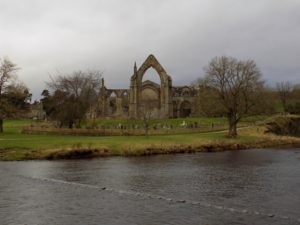 The diagonal line in the foreground is a line of stepping stones, but the river was very full, and flowing over the top of the stones. Andrew thought of crossing this way, but was put off at the thought of falling into the cold river, so we crossed by a bridge.
The diagonal line in the foreground is a line of stepping stones, but the river was very full, and flowing over the top of the stones. Andrew thought of crossing this way, but was put off at the thought of falling into the cold river, so we crossed by a bridge.
The Abbey itself is a ruin, but there is a manor house nearby, and part of the Abbey has been used as a church, after the rest was abandoned. This is the Priory Church of St.Mary and St.Cuthbert, seen below:
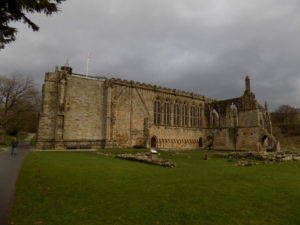 This is a rather pleasant and ornate church, and well worth a visit. It has an old stone altar, and some very old stained glass, and is well looked after. There are some rather alarming ceiling bosses though:
This is a rather pleasant and ornate church, and well worth a visit. It has an old stone altar, and some very old stained glass, and is well looked after. There are some rather alarming ceiling bosses though: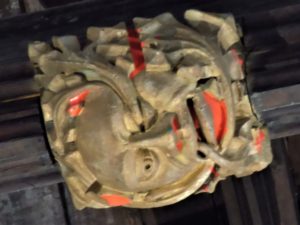 When we had finished admiring the church, we drove to Skipton and had a nice pub lunch at the Black Horse Inn near the Castle, including a welcome pint of beer. Then we ventured into the castle, through these rather foreboding gates, with the motto above meaning “Henceforth!” which Andrew pointed out seems rather meaningless as a slogan. It probably meant something to the Clifford family about looking to the future not the past.
When we had finished admiring the church, we drove to Skipton and had a nice pub lunch at the Black Horse Inn near the Castle, including a welcome pint of beer. Then we ventured into the castle, through these rather foreboding gates, with the motto above meaning “Henceforth!” which Andrew pointed out seems rather meaningless as a slogan. It probably meant something to the Clifford family about looking to the future not the past.
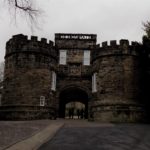 It is an interesting place. Apparently, it was the last stronghold in the North to surrender to the parliamentary forces in the civil war, and surrendered honourably after a long siege. However, it had been badly knocked about during the siege, and had to be largely rebuilt by the Clifford Family, with the authorities keen to make sure it couldn’t be used against them again. Lady Anne Clifford was the driving force behind the rebuild, as she was for a number of castles across the North that we have seen. Her presence is certainly felt here. The steps leading into the building are the Lady Anne Steps, with a sign above the door about Lady Anne:
It is an interesting place. Apparently, it was the last stronghold in the North to surrender to the parliamentary forces in the civil war, and surrendered honourably after a long siege. However, it had been badly knocked about during the siege, and had to be largely rebuilt by the Clifford Family, with the authorities keen to make sure it couldn’t be used against them again. Lady Anne Clifford was the driving force behind the rebuild, as she was for a number of castles across the North that we have seen. Her presence is certainly felt here. The steps leading into the building are the Lady Anne Steps, with a sign above the door about Lady Anne:
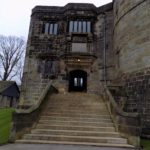 and the conduit courtyard has a tree that she planted at the centre. All the rooms and passageways that we could visit are accessed from this courtyard, and we were provided with a detailed plan of the route in and out of this central point.
and the conduit courtyard has a tree that she planted at the centre. All the rooms and passageways that we could visit are accessed from this courtyard, and we were provided with a detailed plan of the route in and out of this central point.
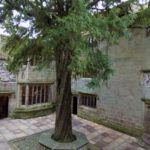 The Cliffords had to rebuild it as a residence rather than a castle, and this leaves a rather strange mix of old stone walls, and obviously modernized windows and plastered walls. In the photo below, which is the munument room, you can see how much thicker the walls near the window are below window level. They were made thinner so that the castle could no longer withstand a siege
The Cliffords had to rebuild it as a residence rather than a castle, and this leaves a rather strange mix of old stone walls, and obviously modernized windows and plastered walls. In the photo below, which is the munument room, you can see how much thicker the walls near the window are below window level. They were made thinner so that the castle could no longer withstand a siege
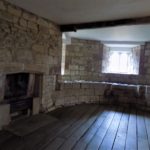 The owners of the castle still live in what they call the Tudor wing, to the right of this photo, which we couldn’t access:
The owners of the castle still live in what they call the Tudor wing, to the right of this photo, which we couldn’t access:
I think that both Andrew and myself enjoyed this day around Skipton. We timed it well, as on the way back to Manchester the heavens opened and it poured with rain. Hopefully, it will encourage Andrew to explore more of English history on this and any future visits
December 2019/January 2020: Andrew in the Lakes (not literally)
I am going to post a few photos from Andrew’s stay with us in Cark over Christmas.
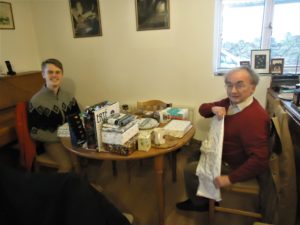 Firstly, Andrew and Mark opening Christmas presents on the kitchen table at Cark:
Firstly, Andrew and Mark opening Christmas presents on the kitchen table at Cark:
Then the three of us wearing our bobble hats Mark gave us as presents. When the weather was okay, we went out to show him the sights:
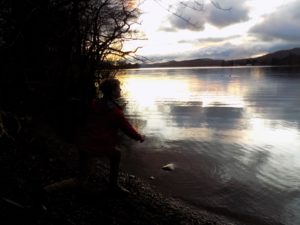 Here is Andrew skimming stones on Coniston, as we did long ago:
Here is Andrew skimming stones on Coniston, as we did long ago:
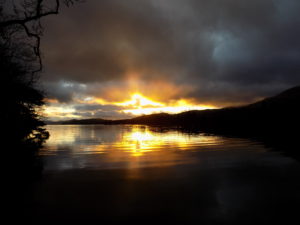 There was also a rather good sunset over Coniston.
There was also a rather good sunset over Coniston.
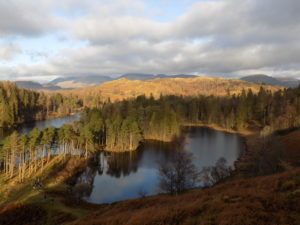 And a beautiful view of Tarn Hows. Andrew asked to see as few of the sites of interest for the family:
And a beautiful view of Tarn Hows. Andrew asked to see as few of the sites of interest for the family:
This is outside Lowick Church, and at Canal Foot. There is a sense in these photos that Andrew might have been feeling a bit cold!
Here is Andrew ‘sunbathing’ at Wastwater. He did ask if you could swim in the lakes and them put his hand in the water and decided perhaps not.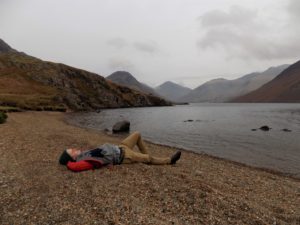 and standing outside Woodgate, now much changed from our days there:
and standing outside Woodgate, now much changed from our days there:
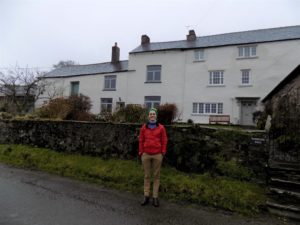 Andrew and I did a walk in Eskdale ending at the Doctor’s Bridge:
Andrew and I did a walk in Eskdale ending at the Doctor’s Bridge:
What did we do on days it was raining? Jigsaws:
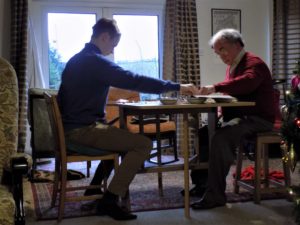 and we enjoyed Marks’ great cooking, and local produce such as beer and cheeses. We also had a very good pub lunch at the Bay Horse at Canal Foot. I hope that we gave Andrew a good sample of the delights of the Lakes, so that he will want to return.
and we enjoyed Marks’ great cooking, and local produce such as beer and cheeses. We also had a very good pub lunch at the Bay Horse at Canal Foot. I hope that we gave Andrew a good sample of the delights of the Lakes, so that he will want to return.
4th November 2019: Fireworks at Arnside
Mark and I have been to the bonfire night fireworks display at Cartmel racecourse a few times, as it is very close to our house, and is very enjoyable. This year, the display at Cartmel was not taking place last weekend, so I looked on the web for any other local fireworks displays. There has been one at Arnside for the last few years, and people seemed to have enjoyed it, so I decided to go there instead. It is only a fifteen minute train ride around the coast from Cark, and though the trains are not very frequent on this line, there were ones at convenient times.
I had rather hoped that the tide would be in, so that I might get a few good photos of the fireworks reflected in the water, but it was not to be. All there were was is the usual mud flats.
The fireworks were being set off from the little pier at Arnside, and the first part of the display lasted around half an hour. It was unclear online when it would start, but fortunately the train I caught got me there in good time to see the whole thing.
It was enjoyable, though I struggled to get my camera to focus properly on the fireworks in quite difficult conditions. I took a lot of photos, but most were not very good. These are the best of them, so please forgive the not brilliant quality. I don’t think these will be going in a future calendar!
There was a large crowd, and everyone seemed to enjoy it. There were food stalls, and other entertainments, and Arnside was packed with people. I imagine all the local shops made a good profit from the night.
I like the photo above, as it almost looks like a giant mantis like creature is about to attack the village. Some of the photos that I took created light patterns that I had not anticipated, mainly through my mishandling of the camera and the shutter speed being so slow in very dark conditions. The photo below is one example of this:
The atmospheric conditions were not perfect for the display, as a combination of the smoke from the fireworks and a fog descending on the bay ended up blanketing Arnside. The display was split in two, as a special train had come from Chester via Manchester to park on the Arnside viaduct and allow its passengers to see the second part of the display before returning south. Unfortunately, the fog made it a less impressive spectacle than it could have been. I hope the passengers were well dined on the way to make up for it! I did take a photo of the train, but it turned out to be probably the worst train photo that I have ever taken, so I am not including it here.
18th September 2019: Visit to Lincoln
Last weekend, I went on a day out to Lincoln with the Prestwich Camera Club. It involved a long day, getting up at 6 to get a coach at 8, and getting back around 12 hours later, but it was worth it. I have not visited Lincoln for a long time, and it is a very interesting city, with a long history. The first known settlement there was around 300 BC. The Romans left their mark on the place after arriving in 50 AD. The most prominent Roman remains are the Newport Arch just north of the cathedral:
There are also the foundations of various Roman gates to be found around the city. William the Conqueror had the castle built in the 11th Century, and a lot of that still exists. It has had a prison and a court building built within its grounds, so it has been in well used over the centuries. A pleasant walk is possible around the top of the walls, with good views of Lincoln. This is a part of the wall leading to the Lucy Tower, where prisoners were executed:
There is also a tall tower called the observatory tower that you can see in the background on the above photo, and below, which looms over the castle walls:
The view of the cathedral from the castle is impressive as well:
The cathedral is also old, having been consecrated in 1068. It is a major landmark from all over the countryside around it, and it is very impressive. Unfortunately, the light was a bit gloomy on the day, so it didn’t show the sandstone to its best effect, but I took this photo during a brief sunny interval:
]
Steep Hill in Lincoln is apparently the fourth steepest in England. It felt steep enough for me! It has lots of interesting little shops and tea rooms for people needing refreshment from the climb. There are at least two 12th century houses on Steep Hill, the Jews House:
There is a small figure in the plaster of the house on the left, which may have been a ward against evil spirits. There is also what they call the Norman House as well, where I had a cup of tea in the cellar:
The ornate windows on these houses were interesting. At the bottom of the hill is the Guildhall from the 16th Century:
There is enough history to keep me occupied for a long time, and one day was not really enough to see it all. There is also an interesting Museum half way up Steep Hill, with a lot of prehistoric and Roman exhibits, including a dugout canoe from the 1st century. Unfortunately, the Art Gallery is not up to much, though.
Of course, there is another reason why I find Lincoln interesting. Mum’s mother’s family, the Steepers, were from the Lincoln area, and her father was a teacher in a school on Steep Hill on Christ’s Hospital Terrace and lived on the terrace and on Steep Hill for around 40 years. I think that Mark can vaguely remember one of them, Walter, but our Grandmother died before even Mark was born.
The school is no longer there, but the buildings have changed so little in the area that I can easily imagine the Steepers seeing the same things that I saw as they trudged up and down the Steep Hill. At least it must have kept them fit!
6th September 2019: Ruskin and Turner
I have visited recently two exhibitions in the Lakes to do with John Ruskin and JMW Turner. The first was at the Abbot Hall museum in Kendal on ‘Ruskin, Turner and the Storm Cloud’ which was about the artist’s perceptions and portrayals of nature, and an exhibition titled ‘Incandescence’ of several paintings by Turner at Brantwood, Ruskin’s old house near Coniston.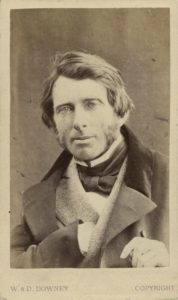
John Ruskin (1819-1900) is an interesting figure. According to Wikipedia, he “was the leading English art critic of the Victorian era, as well as an art patron, artist, a prominent social thinker and philanthropist. He wrote on subjects as varied as geology, architecture, myth, ornithology, literature, education, botany and political economy, and worked as a teacher and public lecturer. He was hugely influential in the latter half of the 19th century and up to the First World War. Today, his ideas and concerns are widely recognised as having anticipated interest in environmentalism, sustainability and craft.” Ruskin first came to prominence in the 1840s with his defence of the work of J.M.W. Turner, in which he argued that the principal role of the artist is “truth to nature.” Ruskin appreciated Turner’s desire to paint from reality, in dangerous passes in Switzerland in bad weather:
From the 1850s, he championed the Pre-Raphaelites, who were influenced by his ideas. He was a contradictory figure in many ways, as a devout man despairing of the modern world, and the destruction of the old order and artefacts, but also supporting radical art. He defended both Turner and the Pre-Raphaelites against their many critics, and catalogued Turner’s works after his death and was a major reason why Turner’s reputation remained high in the later nineteenth century.
Unfortunately, he may be better known now for various controversies in his life. His court battle with Whistler in 1879 after he accused Whistler of throwing a pot of paint in the face of the public with his nocturne painting ended in a Pyrrhic victory for Both men, and made Ruskin seem out of touch with modern taste. He had no understanding of newer art that was impressionistic and did not truly represent what it showed, such as the Whistler painting:
He has been accused by critics of destroying some of Turner’s less acceptable drawings when cataloguing Turner’s works after his death. His unconsummated and short lived marriage and his wife’s affair with a younger painter has attracted much comment, and he has been portrayed as an aesthete and effete mothers boy, afraid of women, in several programmes on TV and films that I have seen, largely as a contrast to the manly womanising of such men as Rossetti and Turner. This is rather unfair on a man who contributed so much to our understanding of painting and also the natural world. It is clear from the exhibition in Kendal that he was a talented artist in his own right, such as his drawings of Venice:
He was not an innovator like Turner, but his architectural and nature drawings are of high quality, and show an immense patience and attention to detail. He only occasionally met Turner, and they had little in common except the love of nature and art, but Ruskin was influential in teaching people to interpret and understand Turner’s works and defend them against jibes that they had been painted using a mop and a bucket of mustard coloured paint.
Ruskin lived his last 28 years in Brentwood on the eastern shore of Coniston Water. It is a beautiful old house, and the displays of his ideas and his books, and large collection of shells and other natural forms is wonderful to see. The view across the lake to Coniston village and the Old Man is magnificent, and his bedroom has a purpose built turret that he would sit in and watch the changing seasons in front of him.
It was at Brentwood that he developed his ideas about the influence of increasing industrialisation of England polluting and affecting the natural world. It is also at Brantwood that his bouts of ill health that dogged his later life got worse, and found him increasingly isolated and depressed. He was a man of great talent both as a thinker and an artist, and his reputation seems to be gradually improving as interest in his works and their parallels with modern concerns are noticed.
2nd July 2019: the Strange world of Takeshi Kitano
It would be inaccurate to say that my cultural tastes and Marks do not match, because we both like the theatre and we do share a liking for a few TV series, but when it comes to films, Mark’s taste is much more conventional than mine, and he does not like non-English language films at all – to quote the man himself, he “doesn’t go to the cinema to read”, and generally likes mainstream films with a conventional narrative arc. So when I read in his blog that he had watched and enjoyed the US remake of “Ghost in the Shell”, it was a rare convergence of our cinematic experience. I have read the manga version by Masamune Shirow, and I have seen the two anime films by Mamoru Oshii. I have also seen the US remake, and I actually enjoyed it. The Anime versions are very good, with excellent action sequences, but too prone to stop and spend long periods when the characters philosophise about the human condition. The anime has a much more ambiguous ending as well, and a less conventionally structured narrative arc, while as you would expect, everything is more or less explained and resolved in the US film. I do not have a problem with Scarlett Johansson in the role. I think she is rather good in it. She is an actress with a limited range, mostly seeming to involve playing genetically altered/android/alien characters, but she can be very effective. She can also make quite daring choices in her work, such as the deeply weird and unsettling “Under the Skin” that I saw fairly recently
 where she plays an alien who gets too involved with the humans who are her foodsource.
where she plays an alien who gets too involved with the humans who are her foodsource.
Apart from curiosity in seeing what the Americans would do with Ghost in the Shell, another attraction for me was to see Takeshi Kitano in an American Film. He has been in one before, “Brother” from 2000, but it was not successful, and this is only his second American film. Takeshi Kitano is an interesting character. As it says on his Wikki pages, https://bit.ly/2X8iUWX ‘Takeshi Kitano is a Japanese comedian, television presenter, actor, filmmaker, and author. While he is known primarily as a comedian and TV host in his native Japan, abroad he is known almost exclusively for his work as a filmmaker…. Kitano rose to prominence in the 1970s as one half of the comedy duo Two Beats, before going solo and becoming one of the three biggest comedians in the country. After several small acting roles, he made his directorial debut with 1989’s Violent Cop and garnered international acclaim for Sonatine (1993)’.
It was ‘Sonatine’ that I saw first, and then his two earlier films, ‘Boiling Point’ and ‘Violent Cop’. Many of Kitano’s early films are dramas about gangsters or the police. Many of his films express a bleak worldview, but are also filled with humor and affection for their characters. Mark Schilling cited this as the film where ‘Kitano defined his style with long takes, minimal camera movement, brief dialogue, sly humor, and sudden violence’. The Japan Times https://bit.ly/31YLoGj states that ‘Kitano was a strong on-screen presence: cool but intense, stoic but volatile. After a 1994 scooter accident that nearly killed him, his damaged face served as a mask that could frighten or intimidate, though his puckish sense of humor never left him’. Kitano acquired an enthusiastic overseas following, including director Quentin Tarantino, who would probably give almost anything to be as effortlessly charismatic and make films as cool as Kitano. He also expanded his range of subjects, including comedies and tales of characters on the edge of society trying to make their way, with typical deadpan humour, such as ‘Kikujiro’ and ‘Scene at the Sea’.
Whatever the subject, his films are always entertaining and unmistakably his. Kitano finally hit the box-office jackpot with “The Blind Swordsman: Zatoichi,” his 2003 take on the Zatoichi franchise about a wandering blind swordsman.
Unfortunately, that was the last film of his that has been released in the UK as far as I am aware, which is a pity. If another of his films becomes available, I will certainly want to see it, as I have enjoyed all the other films he has directed.
24th June 2019: the River Kent from Burneside to Staveley
I had thought of doing a blog on David’s time in the UK this year, but in the end I have decided that it has already been well covered by David himself. The only thing I would like to add is this photo of David and Mark on Ulverston station at the end of the holiday: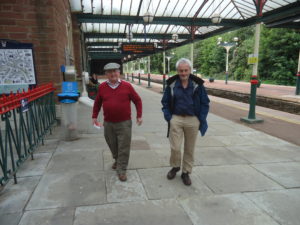
I think it is rather a good photo of both of them. It is a shame that I didn’t think of asking someone to take a photo of all three of us!
Anyway, in the weekends since, I have been exploring a bit of the Lakes that I don’t know very well, following the River Kent North West from Kendal up to Burneside and Staveley. It is in it’s own way a rather nice area, with a fair amount of historical and railway interest. The branch to Windermere follows this route, and I have bought a book about this branch recently, which partly inspired these walks. They are fairly flat walks as well, so maybe Mark will be able to add them to his list of flat walks one day! The only problem is that they are a little there and back, as the paths do not go consistently up both sides of the river.
Burneside is also interesting from a railway point of view in that there were two tramways from the branch to a mill belonging to James Cropper. The mill is still there, but the tramway, which ran on the street, has long since been abandoned. Some rails from the tramway still exist near Burneside station:
Very little else from the tramway still survives. The walk stated by going round the James Cropper paper mill and starting off alongside the river, heading North West. Further up the river, there is a bridge at Bowston,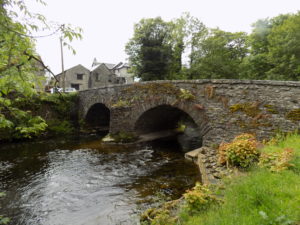
and also a weir. I saw a dipper near here, perched on a rock in the river:
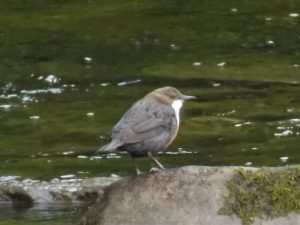 From a distance, a typical little brown job! The weather on this day was a bit changeable, in typical English summer mode, so I had to hide under a tree from a sudden rainshower after setting out without a coat.
From a distance, a typical little brown job! The weather on this day was a bit changeable, in typical English summer mode, so I had to hide under a tree from a sudden rainshower after setting out without a coat.
The second time that I visited the area, it was a much better day, weather-wise. I started off from Staveley, which is the last station before Windermere on the branch. Staveley has some buildings of historical and artistic interest, as there is a 13th Century chapel called St.Margarets Tower, which is the remains of the old church:
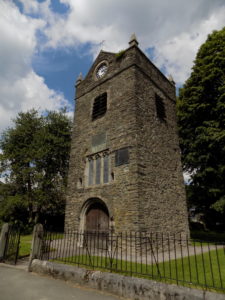 The newer 19th Century Church is also noteworthy as it has three stained glass windows designed by William Morris and Burne-Jones:
The newer 19th Century Church is also noteworthy as it has three stained glass windows designed by William Morris and Burne-Jones:
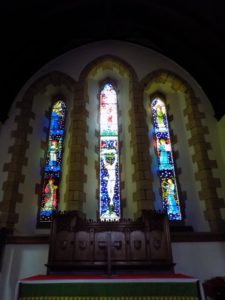 They are rather beautiful, and the church interior is also enhanced by other stained glass windows.
They are rather beautiful, and the church interior is also enhanced by other stained glass windows.
The walk along the River Kent through Staveley Park is enjoyable and peaceful, especially in the sunshine:
 And there were a few butterflies to admire and try to photograph:
And there were a few butterflies to admire and try to photograph:
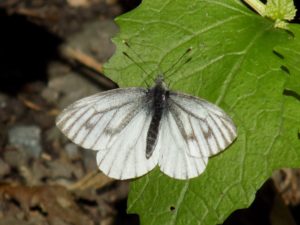 So all in all the walks were full of interest, with a variety of open meadow and wooded areas. There are one of two drawbacks, such as the changeable weather, having to walk on the road for some of the time, and also having to make your way over a golf course, but I enjoyed myself.
So all in all the walks were full of interest, with a variety of open meadow and wooded areas. There are one of two drawbacks, such as the changeable weather, having to walk on the road for some of the time, and also having to make your way over a golf course, but I enjoyed myself.
29th April 2019: insects
Mark and I spent a week in the Lakes recently, and we were lucky that it coincided with a spell of sunny weather. Mark has written a number of blogs about walks that we went on, so I thought I would do something a bit different and show the variety of insects that we saw. The warm weather had brought out the butterflies, so we saw a good variety, such as this:
This is a Peacock butterfly that we saw at Arnside. We also saw this one;
this is a Small Tortoiseshell butterfly seen near Birkby, and also
This is a Red Admiral butterfly at Wharton Crag. All of the above seemed content to be photographed basking in the sun, showing off their bright colours. Other butterflies are less co-operative, such a this Orange Tip butterfly, which was more interested in fluttering from flower to flower, and not opening its wings to be photographed properly:
A few of the butterflies were less colourful, such as this Small White butterfly:
and a few were quite well disguised, and harder to see, such as this Speckled Wood butterfly:
Taking photos of any wild creature has its problems, as most of them don’t stay still for long, and won’t allow you to get too close. Also, they move at the wrong moment, just when you have got the focus and position right, or won’t open their wings, or pose on the right side of a bird feeder, or away from vegetation. Anyone would think they didn’t like being photographed! It does take patience and perseverance, and a lot of failures, but when it goes right, it is worth it. I have also managed to take photos of other insects, such as this Ladybird in our back yard at Cark:
And also a large Stag Beetle in Roudsea Wood:
However, there is a butterfly that I have yet to be successful in capturing on film. We saw quite a few pale green butterflies that I think are Brimstone butterflies, but every time they were too far away, or refusing to settle anywhere, and often travelling in the opposite direction to us, or over fences and fields where I couldn’t follow them. It was very frustrating, but one day I will manage to take a photo of one!
18th March 2019: Heavy rainfall and interesting birds in the Lakes
It has been very wet in the Lakes in the last few weeks. Mark and I have been to the River Leven near Sizergh twice recently, once before the heavy rain, and once after, and I have taken photos from more or less identical places to show how high the river is at present. It is probably not as extreme as it might be in Oz, but it is still very noticeable.
You might be unsure that this is the same location, but the line of trees in the background are the same. The central rock formation has been submerged, and the amount of water flowing downstream is huge compared to the earlier photo.
A little further upstream, on a road bridge near Sizergh, this is another before and after the rain comparison. Again, the trees in the background show it is the same place. The water level has risen to the top of the rock strata on the left, and the trickle of water from the left has become a large stream. We also visited Cartmel this weekend, and the river was so high there that cautious residents were using walls of sandbags to reduce the risk of flooding in their houses.
I have visited the bird sanctuary at Foulshaw Moss for the first time this year, and I was pleased to see that they have improved the facilities there, including a couple of new hides for visitors to watch the ospreys, and other less exotic species. The ospreys have not returned here as yet, but I did see a couple of woodpeckers:
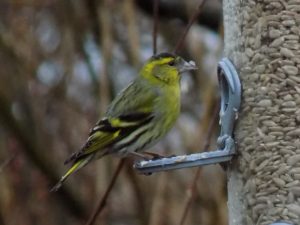 It is a very good place to watch birds, and I will definately return later. I will need to remember to take the binoculars to see the ospreys, though!
It is a very good place to watch birds, and I will definately return later. I will need to remember to take the binoculars to see the ospreys, though!
11th February 2019: a duck, several deer, five lakes, two sunsets and a steam engine
I am adding a few of my recent photos to this blog. I have been quite lucky with the weather this winter, and had several cold but bright and clear weekends, and even one week with reasonable weather at least half the time. These are some of the best results that I have managed.
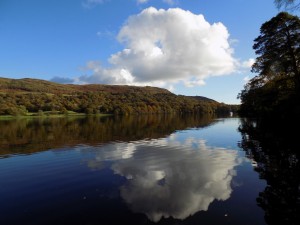 Firstly, an old favourite, Coniston Water, calm enough for a good reflection of the cloud and hills.
Firstly, an old favourite, Coniston Water, calm enough for a good reflection of the cloud and hills.
Mark and I did a walk around Rydal Water and Grasmere, as reported in his blog, so first a photo of Rydal Water:
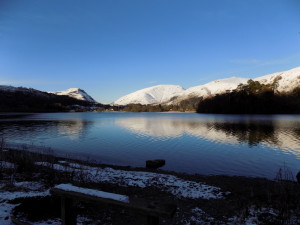 The scenery was very striking with the snow on the hills. We also walked around Elterwater, seen here looking towards the Langdale Pikes:
The scenery was very striking with the snow on the hills. We also walked around Elterwater, seen here looking towards the Langdale Pikes:
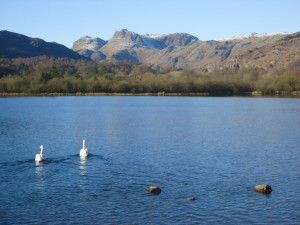 Earlier in the year, we were lucky to visit Esthwaite on a good clear and bright day with mirror like reflections:
Earlier in the year, we were lucky to visit Esthwaite on a good clear and bright day with mirror like reflections:
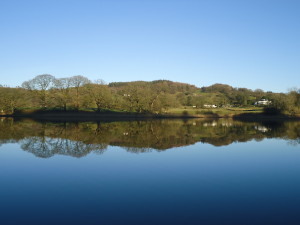 I have also managed to catch a few good sunsets, like this one at Ravenglass:
I have also managed to catch a few good sunsets, like this one at Ravenglass:
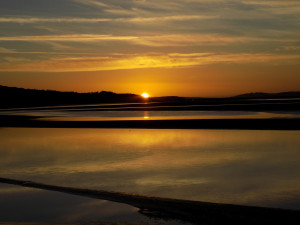 Mark and I also walked in Levens Park, and were lucky enough to see the deer herd there at fairly close range:
Mark and I also walked in Levens Park, and were lucky enough to see the deer herd there at fairly close range: 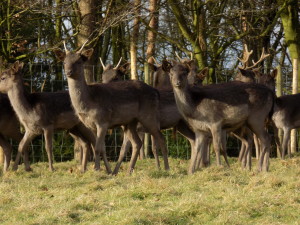 We also stopped at a mostly frozen Yew Tree Tarn, and met this rather puzzled looking duck:
We also stopped at a mostly frozen Yew Tree Tarn, and met this rather puzzled looking duck:
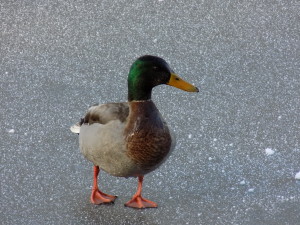 Luckily, we had come prepared, and had some bread pieces to throw to him.
Luckily, we had come prepared, and had some bread pieces to throw to him.
Last weekend, 45596 Bahamas ran up the Settle-Carlisle line for the first time since its last major service. I went to take a photo of it at Dent Station, in weather very unlike the Bahamas, but entirely usual in this area:
3rd December 2018: ‘Shoplifters’ film review
Please note: this review does reveal some major plot points.
Also, this is an art-house film from Japan with subtitles!
I always look forward to seeing a new film by Hirokazu Kore-eda, and his latest has already been highly praised by the critics, including winning the Palme d’or at Cannes film festival. For more information about the director, click on this link: https://bit.ly/2RCr7Ry. I saw the film this week, and it lives up to its plaudits. It could even be the best film he has created so far. He is often compared with other great Japanese directors such as Ozu (link: https://bit.ly/2i09njj) and Naruse (link: https://bit.ly/2BOB6xC), and his subtle and nuanced portrayal of ordinary Japanese families experiencing everyday joys and griefs make this comparison seem justified.
‘Shoplifters‘ concerns a family living in an old fashioned and rather ramshackle house in a working class area, trying to make ends meet in dead end jobs and indulging in petty theft and fraud to keep food on their table. There is a grandmother, a couple, a young woman and a boy. They operate in a society that seems to prefer to ignore them, and exploit them. There is a feeling in the film of impending doom that grows as the film progresses. But It is by no means a totally downbeat film. There are times when the characters enjoy their closeness and connections with each other. There is a tender lovemaking scene between Osamu and Nobuyo in a brief moment alone together in the house, and humour in her having to rush to get dressed when the children unexpectedly come home and interrupt them. They all seem happy enough in their chaotic lives, and eager to seize moments of happiness such as the trip to the beach, even when they are aware how fleeting the joy is, and how close they are to disaster.
The film is about parental bonds and love, and the couple Osamu and Nobuyo trying to do the best for the surrogate children, teaching them survival skills in this hostile world, showing them the love they themselves never received. They find a child locked out of an apartment on a cold night, and take her home. They discover her mother does not love her, that she is subject to physical abuse from her mother’s boyfriends, and decide to adopt her as their own, after only a brief discussion about the risks.
The film intimates that perhaps this is how they have all found each other, and ambiguities in the relationships between the characters in the house gradually are teased out. The younger woman works in a sex show, and we learn she has run away from an conventional family life. The Grandmother claims her dead husband’s pension, probably fraudulently, and uses emotional blackmail to extract money from her relatives. Adopted son Shota and Would be father figure Osamu shoplift together, but there is a growing feeling that Shota has doubts about his entertaining but feckless surrogate father, and perhaps a growing desire for a better, more normal life, or perhaps a desire to stop the little girl being sucked into their dissolute lifestyle. Nobuyo and the younger child gradually bond, and we see real love develop between them.
The world around them seems to turn a blind eye to this ‘adoption’, as it becomes clear that the real mother does not report the child’s disappearance, and other neighbours see the girl but don’t report it. A sense of distrust of authority and a solidarity between people struggling to survive is subtly expressed. There is also a sense of the hypocrisy of the polite society turning a blind eye to what goes on, and willingness to pay for hidden secrets to stay obscured. But inevitably it all comes crashing down on them, and when the authorities are forced to pay attention, they come down with a heavy hand. A synopsis of the plot doesn’t really give a proper idea of the film, and I don’t want to ruin a reader’s enjoyment by giving away too much. The film’s greatness comes from the directors ability to make you care for these people, in the gradual subtle ways he reveals their characters and relationships. This is a film that you have to listen to and watch carefully, and pay attention to the dialogue to glean little bits of information. There a no big scenes, elaborate camera movement and musical cues to tell you where the important plot developments are. A couple of times there are snatches of conversation that make you think, ‘Hey, hold on a minute, what was that they said?’ But nothing is emphasised unduly. We gradually learn about this odd family, and their history, much of it not to their credit. Like many in their situation, they try to exploit the system they see as exploiting them. Kore-eda cleverly keeps the balance between caring for these damaged people and keeping in the audiences minds that they are no angels and are capable of criminal acts. No-one is left unscathed, not even the authorities with their heavy handed, by the book judgements about the characters. The acting by all the cast is superb, and makes it easy for the audience to at least understand and sympathise with these ambiguous characters.
As always, Kore-eda’s direction of the children is first class, getting a naturalistic and not at all cute performance out of them both. But the director makes sure that we don’t forget that this family will do virtually anything to survive, as we see in their ruthless treatment of one major character. This gives the audience a check in their support for these characters, especially Nobuyo, who is clearly the driving force. This shocking action marks the beginning of the end for this family. And yet, we cannot help but feel for these rather helpless people who maybe never had much of a chance to start with. Osamu, when asked by the police how he can teach Shota to steal, tells them that is the only skill he has to teach him.
There is one scene near the end when the woman Nobuyo is being interrogated by the police. She asks about the girl, and is told that she has been returned to her mother, as it is where she should be. There is a long close up take of Nobuyo as she realises she will not see the little girl that she loves ever again, and she struggles to keep from breaking down. She seems to remember, as we do, an earlier scene when she holds the girl close and tells her love is not hitting, but being held like this, and both she and her audience struggle to hold back tears.
It is a subtle, unshowy performance, but immensely affecting, in that way that some actors can do with minimal changes of expression and their eyes. No-one is a hero or a villain, and they are all portrayed as believable, flawed individuals trying to make the best of the poor hand they have been dealt and find love to help counter the emptiness of their lonely lives. Kore-eda is careful not to provide any easy answers or solutions to the questions that he raises, and leaves his audience to make up their own minds how they react. All in all, I found it a quietly devastating film, that I will remember for a long time. As Mark Kermode writes, ” It’s an eerily moving piece, masterfully blurring the divide between the unforgivable and understandable, finding tenderness in the bleakest and most traumatic of circumstances.” review link: https://bit.ly/2G0R37R
28th November 2018: From Rocket to Pendalino
The original Rocket, designed and built by Robert Stephenson in 1829, is currently visiting the Manchester Museum of Science and Industry (MOSI). Rocket was built in Newcastle to prove Robert Stephenson’s idea that steam traction was the transport of the future, and could be used successfully on the first inter city passenger railway between Liverpool and Manchester. It built on and improved designs for earlier steam locomotives, and used a number of innovative ideas, such as having multiple tubes to increase the heating surface area in the boiler, more direct transmission of power to the wheels using simpler connecting rods, and leaf springs to improve stability and lessen impact on the track. It was successful in the Rainhill Trials of 1829, and convinced the Directors of the Liverpool and Manchester Railway that this was the future motive power for their railway.
This photo is of a replica of the Rocket as built and as competed in the Rainhill Trials in 1829. As is usual with new designs, improvements in loco design came quickly, and Rocket’s design quickly became superseded. Having the cylinders set high at an angle made the loco less stable, so a more horizontal position was adopted in later designs. Fitting a dome on the boiler helped create a ‘dryer’ steam that helped stop water being carried into the cylinders and improved efficiency. A larger smokebox, with a more efficient vacuum chamber, improved steam raising and combustion capabilities. All of these improvements were made on the Rocket, and changed her appearance greatly, so that in her final working form, she looked like this:
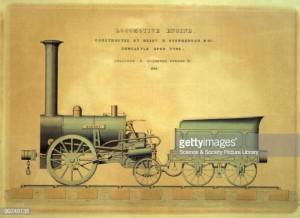
UNITED KINGDOM – JUNE 11: Coloured drawing made in 1836 showing the locomotive as rebuilt in 1831. The ‘Rocket’, designed by Robert Stephenson (1803-1859) and George Stephenson (1781-1848) became famous after winning the Rainhill Trials, a competition staged in 1829 to establish the most efficient locomotive for haulage on the Liverpool & Manchester Railway. The Rocket ran on the Liverpool and Manchester Railway from 1829 to 1836 and the Midgeholme Colliery Railway in County Durham between 1836 and 1840. (Photo by SSPL/Getty Images)
Rocket was a victim of her own success, as loco design quickly left her behind, and she was already outdated by the opening of the railway in 1830. She worked on the Liverpool to Manchester line up to 1836, and was not a very lucky loco in some ways. On the opening day, the loco ran over and mortally injured the Liverpool MP William Huskisson. Another man had a fatal accident when Rocket derailed when he was travelling on her tender. Also, Rocket derailed in Olive Mount Cutting in 1831 and fell on her side, causing serious damage. In 1836, Rocket was sold to the Earl of Carlisle to work on his Naworth Colliery railway in Cumberland. Rocket was withdrawn from service in around 1840. The owner didn’t scrap Rocket, but did remove all the valuable metal components for sale, leaving the iron hulk that we see today. Rocket was allowed to slowly deteriorate in storage, until in 1862, the Patent Office started developing a collection of machines that were important developments in the Industrial Revolution. Rocket’s owners agreed to donate it to this collection. Robert Stephenson and Co. agreed to recondition Rocket to make it suitable for display, but ended making an engine that represented neither the original or end of working life condition of the loco. This is most obvious in the smaller rear wheels, which were not at all accurate. Rocket has been exhibited in the Science museum since 1862, except for some short term loans, most interestingly to Japan in the 1990’s.
This photo was taken this week in MOSI, which is based partly in the old Liverpool Road Railway station, now the the oldest passenger railway station still in existence in the world. It was good to see the loco in, or very near, the line that started all the railway history I am so interested in. It is also a reminder of how quickly steam loco design advanced in the first 100 years of railway history.
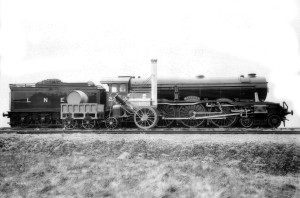 This last photo shows a Rocket replica dwarfed by the then latest steam loco technology, a Gresley Pacific, in the 1930’s. The pacific would itself be replaced by diesel and then electric traction from the 1960’s on, with the Pendalinos as the most recent examples of cutting edge passenger trains. The innovations started by the Liverpool and Manchester, including cheaper and quicker transport of people and goods between cities, is still enjoyed by us all today, and the little battered loco that is currently in MOSI played a major role in this transport revolution.
This last photo shows a Rocket replica dwarfed by the then latest steam loco technology, a Gresley Pacific, in the 1930’s. The pacific would itself be replaced by diesel and then electric traction from the 1960’s on, with the Pendalinos as the most recent examples of cutting edge passenger trains. The innovations started by the Liverpool and Manchester, including cheaper and quicker transport of people and goods between cities, is still enjoyed by us all today, and the little battered loco that is currently in MOSI played a major role in this transport revolution.
11th November 2018: 100 years since the Armistice
It is all over the news today that it is 100 years since the Armistice was signed to end the First World War. As the unofficial family historian, I thought it might be a good time to review how our family was involved in the conflicts of the first half of the Twentieth Century. The person closest to myself, David and Mark was our grandfather William Coulshed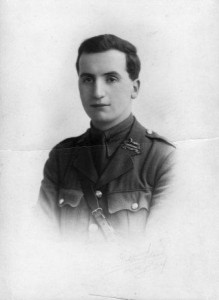 This is a photo taken around 1917 with him in the uniform of a second lieutenant of the West Yorkshire Regiment. Most of what I know about his military service is based on what Dad told me over the years. He was involved in the battle of Cambrai, where he lost a close friend. He was invalided out of the Army in 1918 when it was discovered he has a problem with his heart, which was made worse by the stress of being under bombardment at the front line. I think he was reluctant to talk about his experiences with his family, like many former soldiers. I was only three years old when he died, so I never got the chance to ask him anything, which I regret, but maybe he would not have been any more forthcoming with me than with anyone else. Interestingly, there were at least two other Coulsheds involved in the First War. A Thomas Coulshed was a Gunner in the Royal Field Artillery, and another William joined the Royal Flying Corps and then the Royal Naval Air Service as an Air Mechanic, First Class. All three men survived their experiences. As many of the Armed Forces Records were destroyed in the Second War by German bombing, finding out more about their service is not easy, but it would be an interesting line of enquiry.
This is a photo taken around 1917 with him in the uniform of a second lieutenant of the West Yorkshire Regiment. Most of what I know about his military service is based on what Dad told me over the years. He was involved in the battle of Cambrai, where he lost a close friend. He was invalided out of the Army in 1918 when it was discovered he has a problem with his heart, which was made worse by the stress of being under bombardment at the front line. I think he was reluctant to talk about his experiences with his family, like many former soldiers. I was only three years old when he died, so I never got the chance to ask him anything, which I regret, but maybe he would not have been any more forthcoming with me than with anyone else. Interestingly, there were at least two other Coulsheds involved in the First War. A Thomas Coulshed was a Gunner in the Royal Field Artillery, and another William joined the Royal Flying Corps and then the Royal Naval Air Service as an Air Mechanic, First Class. All three men survived their experiences. As many of the Armed Forces Records were destroyed in the Second War by German bombing, finding out more about their service is not easy, but it would be an interesting line of enquiry.
As far as the Bradburys are concerned, There was one family casualty in the war that I know of:
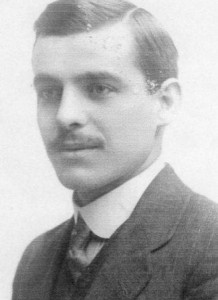 This is a photo of Ernest George Bradbury taken just before the war. He joined up in December 1914, joining the Royal Fusiliers as a Private, and fought at the battle of Loos, and after being invalided home ill, he returned to France and was killed on 12th April 1917 aged 29 at Arras. He has no known grave.
This is a photo of Ernest George Bradbury taken just before the war. He joined up in December 1914, joining the Royal Fusiliers as a Private, and fought at the battle of Loos, and after being invalided home ill, he returned to France and was killed on 12th April 1917 aged 29 at Arras. He has no known grave.
Walter Steeper was a Company Quarter Master Sergeant in the Liverpool Scottish Regiment, which he joined in April 1908 and was promoted to sergeant in 1914. His Regiment was sent to France in November 1918, and he would have been involved in the battle of Mons. He was mentioned in dispatches, received meritorious service medals and territorial force efficiency medals, and survived the war despite being wounded and gassed. I have a clipping from a newspaper with the story of one of his injuries, stating that he was charging towards a German trench when a bullet hit him that if he had not had a metal cigarette case in his breast pocket would have killed him. Instead, the bullet was deflected and only wounded him. He was a favourite Uncle of Mum’s, and lived into the 1950’s. This photo was taken in the 1930’s:
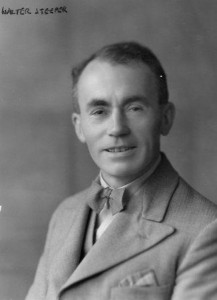 His two brothers, Percy and Sydney, also joined up. Percy was a conscientious objector and refused to be involved in killing another human being, but joined the Royal Army Medical Corps as a private. Mum claimed he was involved in the Gallipoli campaign, and was invalided out after being gassed, though I have no evidence of this. Sydney was a private in the Royal Army Service Corps as a driver, called up as part of Kitchener’s second new army. Again, I know very little about their military history. Walter had to endure the heartbreak of his son Denis being killed in the Second War flying in the RAF:
His two brothers, Percy and Sydney, also joined up. Percy was a conscientious objector and refused to be involved in killing another human being, but joined the Royal Army Medical Corps as a private. Mum claimed he was involved in the Gallipoli campaign, and was invalided out after being gassed, though I have no evidence of this. Sydney was a private in the Royal Army Service Corps as a driver, called up as part of Kitchener’s second new army. Again, I know very little about their military history. Walter had to endure the heartbreak of his son Denis being killed in the Second War flying in the RAF:
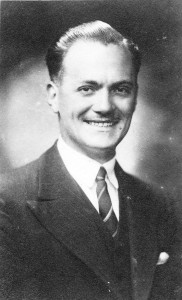 He was flying a Hawker Typhoon over France on 12th November 1943, and was shot down by anti aircraft fire. He was 26 years old. Mum told me that when Walter and his wife Lilian received the official letter telling them of his death, it included a medal. Lilian was so distraught about losing her son that she couldn’t stand having the medal and threw it in the fire.
He was flying a Hawker Typhoon over France on 12th November 1943, and was shot down by anti aircraft fire. He was 26 years old. Mum told me that when Walter and his wife Lilian received the official letter telling them of his death, it included a medal. Lilian was so distraught about losing her son that she couldn’t stand having the medal and threw it in the fire.
However much it seems that some of our leaders use Remembrance Sunday for their own political ends, and it becomes more of a patriotic festival than a sombre reflection of the loss and sacrifice of previous generations, we should remember that because of their actions, Western European democracies have now enjoyed 73 years of peace, security and prosperity. Even if we seem intent on throwing that away at present, their achievements will remain and be worth commemorating. I am proud to remember the members of my family who were involved in this, as well as all their contemporaries.
22nd October 2018: Duchess in Crimson
In my blog of July 2017, I included photos of 46233 Duchess of Sutherland passing Carnforth station in fine BR green livery. She has now been repainted in LMS crimson lake, and looks even better.
I visited the East Lancashire Railway Steam Gala last weekend to see her running on the line, and traveled the length of the line behind her. It was an enjoyable experience, even if it was a bit sad that a loco capable of 100 miles an hour was now trundling along a railway at about 20 miles an hour. It is good to see her in LMS red, though the colour needed full sunshine as in the above photo to bring out the full splendour. Otherwise, the red seemed much darker, as in the photo below:
There were also a couple of visiting GWR locos, including a 2-8-0 tank,
and also a 2-8-0 freight loco:
but they both looked dull beside the Duchess, despite the polished domes. There was also a welcome return to steam for a standard class 4 2-6-4 tank after 6 years of work:
]
It is a pity that the crimson lake liveried ‘Crab’ could not run at the same time, but unfortunately it has had problems with leaking boiler tubes, and is not serviceable at present. The ever reliable Aspinall 0-6-0 was also in steam and giving a good account of itself as well:
Mark has been complaining (so what’s new?) about my blogging yet again about an ELR gala. Maybe next year I will try to get to a gala event at one of the other preserved lines and see if they are as good as the ELR ones, which I always enjoy.
25th July 2018: three steam engines at Carnforth
Last Saturday, I decided to go and see the steam hauled Cumbrian Mountain Express leave Carnforth Station. The express is brought up to Carnforth from London by a class 86, and then steam takes over for the Carnforth to Carlisle leg, and then returns via the Settle-Carlisle route. The steam engines for this are based in Carnforth, so if you get there early enough, you can see the loco being prepared and leave the Depot, and back down onto the express, as well as seeing it start off towards Carlisle. From the station, you can see into part of the yard of West Coast Rail, formerly Steamtown, as they prepare the loco. They usually park coaches and other vehicles so that your view of the yard is limited, but if you are lucky, as I was this weekend, you can glimpse the loco, like this:
This was interesting, because the online information stated that the loco was going to be one of the Jubilees, not an 8F. It is difficult to tell, but I also had the impression that another loco was in steam as well. As the 8F was being moved into position, I caught a glimpse of another loco in the yard.
This second loco glimpsed on the right is a Jubilee, 45690 ‘Leander’, but was facing south, and so unlikely to be headed towards Carlisle with the express. The 8F ran out of the yard with a class 47, and ran onto the avoiding line at the station.
Looking into the yard, I noticed that there was another loco in steam, and this time it was a Black Five, 44871, best known for being one of the locos that hauled the last scheduled passenger train on BR in August 1968:
As far I could tell, they seemed to be moving the Black Five and Jubilee into one formation. I knew that there was another West Coast Rail service scheduled to head south to Bristol soon after the steam hauled express went North, so I had hopes that these two locos would be part of it. My hopes were answered when a class 37 took the two 4-6-0s out of the yard and then along the avoiding line. In the meantime, the 8F headed off North:
And then, after a delay, the 37, Jubilee and Black Five headed south:
So, my hopes were realised, and I had a successful morning. None of those interlopers from other railway companies that they sometimes use, but three ex LMS locos in steam. And afterwards, I visited our favourite fruit farm nearby and bought some nice raspberries and cherries. What more could you ask for?
2nd July: More favourite books, but only one doorstop novel
Mark has been putting up blogs about his favourite sci-fi novels, so for a bit of variety, I thought that I would list a few more of the novels that I have enjoyed over the years.
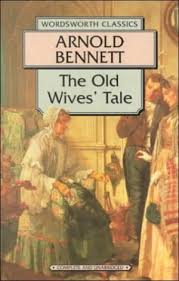 The first is Arnold Bennett’s Old Wives’ Tale. Bennett is perhaps best known for the Clayhanger trilogy, which are also very good, but I thought that I would leave the trilogies to Mark and his blogs.He does not fit in very easily with the early twentieth century modernist writers, and they saw him as old fashioned, unchallenging and traditional, and too narrow in his focus on the life of people in the five Staffordshire towns. This rather snobbish attitude has gradually been changing, as interest in simpathetic portrayals of ordinary lives becomes more popular. Old Wives’ Tale, covering the lives of two sisters over about 70 years working in the family drapers shop, is a good example of his novels. He has great insight and empathy for his characters, and brings them to life, so their ordinary lives become interesting to the readers.
The first is Arnold Bennett’s Old Wives’ Tale. Bennett is perhaps best known for the Clayhanger trilogy, which are also very good, but I thought that I would leave the trilogies to Mark and his blogs.He does not fit in very easily with the early twentieth century modernist writers, and they saw him as old fashioned, unchallenging and traditional, and too narrow in his focus on the life of people in the five Staffordshire towns. This rather snobbish attitude has gradually been changing, as interest in simpathetic portrayals of ordinary lives becomes more popular. Old Wives’ Tale, covering the lives of two sisters over about 70 years working in the family drapers shop, is a good example of his novels. He has great insight and empathy for his characters, and brings them to life, so their ordinary lives become interesting to the readers.
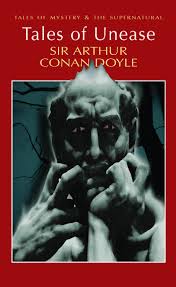 This is another choice of an author not quite seen as great literature in his own time, but whose reputation has risen as time passes. Of course, Conan Doyle is best known for the Sherlock Holmes stories, and the reputation of his longer historical novels remains poor. But this collection makes a good case for him being a master of the short story. I purchased this book in our favourite shop in Sedburgh recently, and read it very soon after. As the introduction points out, Conan Doyle was a master storyteller, with wonderful pacing, characterisation and scene setting, and often including a surprise ending.The tales are a mix of the supernatural and elaborate revenge plots, or both at once. Some border on being horror or science fiction, and must be early versions of themes and ideas explored by later authors in those genres.Several include a character taking the law into his own hands for revenge in a quite brutal way. The tales are not all equally good, and one or two do not work very well, but when they do, they really make an impact.
This is another choice of an author not quite seen as great literature in his own time, but whose reputation has risen as time passes. Of course, Conan Doyle is best known for the Sherlock Holmes stories, and the reputation of his longer historical novels remains poor. But this collection makes a good case for him being a master of the short story. I purchased this book in our favourite shop in Sedburgh recently, and read it very soon after. As the introduction points out, Conan Doyle was a master storyteller, with wonderful pacing, characterisation and scene setting, and often including a surprise ending.The tales are a mix of the supernatural and elaborate revenge plots, or both at once. Some border on being horror or science fiction, and must be early versions of themes and ideas explored by later authors in those genres.Several include a character taking the law into his own hands for revenge in a quite brutal way. The tales are not all equally good, and one or two do not work very well, but when they do, they really make an impact.
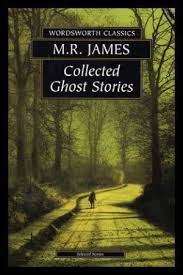 Continuing on the theme of short stories of the supernatural, this collection of ghost stories by MR James is a long term favourite of mine. MR James is a rather odd figure. He was an academic, Provost of Kings College Cambridge and then Eton, a man who was the archetype of a fusty old academic, reactionary and old fashioned and resisting change. And yet every year at Christmas, he wrote a ghost story to tell to his friends and students in the College, and these tales have become amongst the best known and loved ghost stories written by an Englishman. As the introduction states, James is a master of place, topography, scholarly detail and seemingly authentic documentation, persuading the reader to suspend disbelief by evoking a gradually increasing sinister aura in otherwise ordinary locations. His heroes, mostly fusty academics, gradually and without fully realising until too late, get drawn into strange and unsettling situations and nasty encounters. James is expert in evoking horror without detailing the horrors or revealing too much. They are tremendously effective and I have read them repeatedly with the same reaction each time.
Continuing on the theme of short stories of the supernatural, this collection of ghost stories by MR James is a long term favourite of mine. MR James is a rather odd figure. He was an academic, Provost of Kings College Cambridge and then Eton, a man who was the archetype of a fusty old academic, reactionary and old fashioned and resisting change. And yet every year at Christmas, he wrote a ghost story to tell to his friends and students in the College, and these tales have become amongst the best known and loved ghost stories written by an Englishman. As the introduction states, James is a master of place, topography, scholarly detail and seemingly authentic documentation, persuading the reader to suspend disbelief by evoking a gradually increasing sinister aura in otherwise ordinary locations. His heroes, mostly fusty academics, gradually and without fully realising until too late, get drawn into strange and unsettling situations and nasty encounters. James is expert in evoking horror without detailing the horrors or revealing too much. They are tremendously effective and I have read them repeatedly with the same reaction each time.
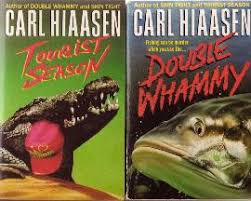 Moving to a different genre that I like, I am including favourite examples of the comic thriller. Carl Hiaasen has published a number of novels set in Florida, and these are the first two. He sets up an elaborate and often bizarre crime plot, and laces it with very black humour.and outlandish characters. Hiaasen is very involved in saving the everglades against degradation by greedy people, and several of his novels involve this theme. Mark and I agree that his novels suffer a bit from repetition and the law of diminishing returns, and the first few are the best, but he is well worth reading.
Moving to a different genre that I like, I am including favourite examples of the comic thriller. Carl Hiaasen has published a number of novels set in Florida, and these are the first two. He sets up an elaborate and often bizarre crime plot, and laces it with very black humour.and outlandish characters. Hiaasen is very involved in saving the everglades against degradation by greedy people, and several of his novels involve this theme. Mark and I agree that his novels suffer a bit from repetition and the law of diminishing returns, and the first few are the best, but he is well worth reading.
 Donald Westlake is a prolific author of thrillers in a variety of forms. I personally prefer the more comic ones to the noirish novels written as Richard Stark, but they are all worth reading. His comic books tend to involve a naive and foolish man getting involved in a series of strange events that are eventually revealed as a web of elaborate plots and counter plots. The hero stumbles through them, largely unaware of what is going on around him, protesting feebly but unable to influence them, and viewed with suspicion or as a fall guy by everyone else.The humour is less dark then Hiaasen, and more silly, but is very funny.
Donald Westlake is a prolific author of thrillers in a variety of forms. I personally prefer the more comic ones to the noirish novels written as Richard Stark, but they are all worth reading. His comic books tend to involve a naive and foolish man getting involved in a series of strange events that are eventually revealed as a web of elaborate plots and counter plots. The hero stumbles through them, largely unaware of what is going on around him, protesting feebly but unable to influence them, and viewed with suspicion or as a fall guy by everyone else.The humour is less dark then Hiaasen, and more silly, but is very funny.
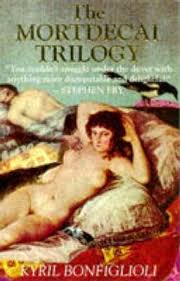 Another comic thriller that I have enjoyed is this book by Kyril Bonfiglioli. This is actually a one volume version of three novels, so I am straying onto Mark’s territory after all! The anti-hero of this book is an aging, dubious art dealer, an experienced coward, who finds himself in a series of increasingly dangerous situations involving a stolen painting, blackmail and murder, and has to use his wits and luck to escape. It is written in the first person by Mortdecai, and includes many asides exhibiting his exquisite tastes and peccadillos, and I found it very amusing and involving.
Another comic thriller that I have enjoyed is this book by Kyril Bonfiglioli. This is actually a one volume version of three novels, so I am straying onto Mark’s territory after all! The anti-hero of this book is an aging, dubious art dealer, an experienced coward, who finds himself in a series of increasingly dangerous situations involving a stolen painting, blackmail and murder, and has to use his wits and luck to escape. It is written in the first person by Mortdecai, and includes many asides exhibiting his exquisite tastes and peccadillos, and I found it very amusing and involving.
10th June 2018: bird life in Prestwich
I have been off work for the last few weeks due to a problem with my left eye. This has meant that I have had a chance to admire the bird life that visit my garden in Prestwich. Most of it is all the usual suspects that you would expect in a suburban garden, but last week two juvenile crows decided to settle on my front doorstep, to my surprise when I opened the door:
They seemed to be having difficulty flying, as they hopped away into the undergrowth when I was nearby. I had heard a lot of noise from the crows the previous day, and seen several flying around in an agitated manner, so maybe these two dropped out of a nest in the trees opposite from me before they were fully fledged, and sought shelter in my garden. They disappeared soon after I took the photo, so either they learned to fly or a local cat got them.
Another visitor that I had not seen before is this little fellow:
This is in my back garden. It is a nuthatch, which is a colourful little bird. I took these photos through my window, so they are not very good quality, but I was pleased to be able to get a photo of them that is relatively clear.
The trouble with little birds is they are very nervous, and don’t stay still in one place for long! I took a few hurried photos before it was off again. I have seen a woodpecker in my garden as well, but I have not got a photo of it as yet.
1st May 2018: favourite literature
David set Mark and myself a challenge to write a blog about what we would regard as our favourite novels.I find it very difficult to pin down what they are, as, like a list of most loved films, it is likely to change over time, as new books are discovered and read. I suppose that my all time favourite series of novels in the Discworld series written by Terry Pratchett, which until the last few, has been consistently entertaining and funny, cleverly setting up a fantasy world run by magic that nevertheless contains a wide spectrum of experiences and characters all too familiar to us from our own world. The two major scenarios, the witches and the Watch in Ank Morpork, allowed Terry Pratchett to examine and satirise the real world in his subtle and clever writing, with humour ranging from broad slapstick to very dark levels. I am not sure which I like best from the series. I am rather fond of Moving Pictures as a strange version of early Hollywood, and Wyrd Sisters as his version of Macbeth, but of his later novels, I think that I would agree with my brothers that The Truth takes some beating, though I did also enjoy Wintersmith 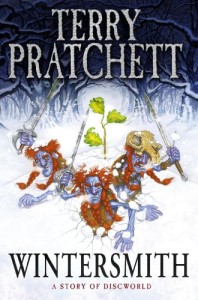 very much. This is a series I go back to quite often, and the truth is that my favourite is probably the last one that I read.
very much. This is a series I go back to quite often, and the truth is that my favourite is probably the last one that I read.
Amongst other novels, I have a soft spot for Thackeray’s Vanity Fair, with its unreliable narrator, and anti-heroine who is much more interesting than anyone else in the novel,
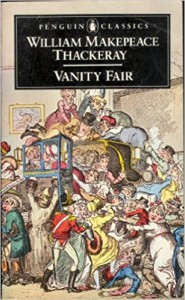 and who exploits the hypocrisies and stupidities of English society so ruthlessly to her own advantage. Going even further back, I am also very fond of Laurence Sterne’s Life and Opinions of Tristram Shandy, which shows that most of the innovations with the form of the novel were explored long before the twentieth century, and is still the most entertaining shaggy dog story in English literature.
and who exploits the hypocrisies and stupidities of English society so ruthlessly to her own advantage. Going even further back, I am also very fond of Laurence Sterne’s Life and Opinions of Tristram Shandy, which shows that most of the innovations with the form of the novel were explored long before the twentieth century, and is still the most entertaining shaggy dog story in English literature.
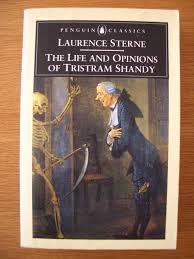 I share David’s liking for Conrad, but would probably choose Nostromo over his other novels as an epic tale of the inspiration for a popular revolution in a South American country being brought down by his own all too human frailties.
I share David’s liking for Conrad, but would probably choose Nostromo over his other novels as an epic tale of the inspiration for a popular revolution in a South American country being brought down by his own all too human frailties.
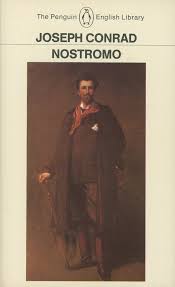 And another rather downbeat writer that I have a liking for is Dostoyevsky, whose Crime and Punishment is another favourite.
And another rather downbeat writer that I have a liking for is Dostoyevsky, whose Crime and Punishment is another favourite.
 This is another cheerful tale of existential despair and the absence of belief, leavened by the possibility of self sacrifice and love. What a lot of cheerful books I read! From the other side of the Atlantic, William Faulkner’s As I lay Dying is a bleakly comic novel of a family dealing with the death of the family patriarch in various strange and disastrous ways is another favourite.
This is another cheerful tale of existential despair and the absence of belief, leavened by the possibility of self sacrifice and love. What a lot of cheerful books I read! From the other side of the Atlantic, William Faulkner’s As I lay Dying is a bleakly comic novel of a family dealing with the death of the family patriarch in various strange and disastrous ways is another favourite.
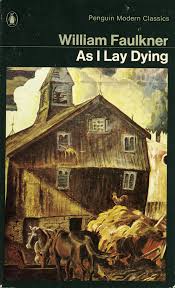 From recent novels that I have read, I think the one that has had the most impact on me is Jonathan Strange and Mr. Norrell, which seems to be a alternative history of nineteenth century England where magic has been reintroduced. Other have described it as a mix of genres of fantasy, history and alternative universe novels. It is beautifully written in a clever mock victorian style with a much more modern viewpoint, and I really enjoyed it.
From recent novels that I have read, I think the one that has had the most impact on me is Jonathan Strange and Mr. Norrell, which seems to be a alternative history of nineteenth century England where magic has been reintroduced. Other have described it as a mix of genres of fantasy, history and alternative universe novels. It is beautifully written in a clever mock victorian style with a much more modern viewpoint, and I really enjoyed it.
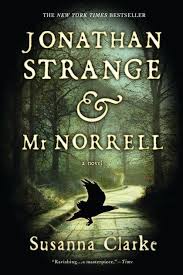 I have to say that this list is one that I have created since David set his challenge, and there is no guarantee that the same novels would still be here if he ask again in say a year’s time. Amongst the other novels that you would be unlikely to call great literature, but I have enjoyed, are the Flashman novels by George MacDonald Fraser:
I have to say that this list is one that I have created since David set his challenge, and there is no guarantee that the same novels would still be here if he ask again in say a year’s time. Amongst the other novels that you would be unlikely to call great literature, but I have enjoyed, are the Flashman novels by George MacDonald Fraser:
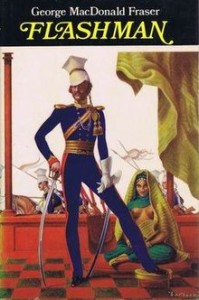 These are highly entertaining, wear their historical knowledge remarkably lightly, and make a Victorian coward and braggart live through most of the military disasters, and a few of the triumphs, of the nineteenth century, often getting involved by accident and surviving by the skin of his teeth. I have also enjoyed the Patrick O’Brien Jack Aubrey series, but i think Mark will claim them as one of his, so I will not step on his toes. In the end, it is all down to personal taste, and doesn’t really need more analysis than that.
These are highly entertaining, wear their historical knowledge remarkably lightly, and make a Victorian coward and braggart live through most of the military disasters, and a few of the triumphs, of the nineteenth century, often getting involved by accident and surviving by the skin of his teeth. I have also enjoyed the Patrick O’Brien Jack Aubrey series, but i think Mark will claim them as one of his, so I will not step on his toes. In the end, it is all down to personal taste, and doesn’t really need more analysis than that.
14th March 2018: recent photos
I thought that I would do a short blog entry on recent photos, just to share them. When Mark and I were walking to Cartmel from Cark last Sunday, we saw a buzzard and a kestral over the fields near Cark. The photo of the buzzard is not very clear, as it was a fair distance away:
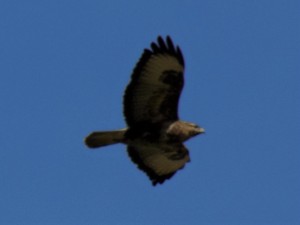 Soon after seeing that, we saw a kestral hovering over a field:
Soon after seeing that, we saw a kestral hovering over a field:
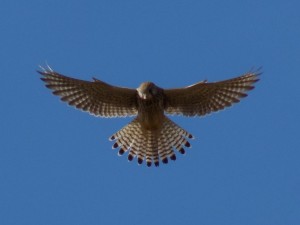 I know that these are two of the most common birds of prey in the UK, but it was great to see them and even photograph them so clearly, especially the kestral. It was an enjoyable walk in the sunshine, even if the temperature here is still below 10 – freezing by Oz standards!
I know that these are two of the most common birds of prey in the UK, but it was great to see them and even photograph them so clearly, especially the kestral. It was an enjoyable walk in the sunshine, even if the temperature here is still below 10 – freezing by Oz standards!
It was a really cold day when I went to the East Lancashire steam gala to see the locos at Ramsbottom station. Luckily there was a brazier near the water column that we could all use!
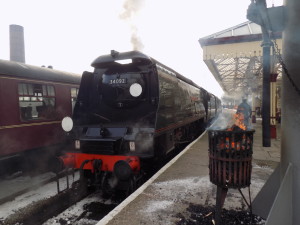 As you can see, they have a Bulleid spam can on the ELR these days, which is just wrong. Luckily, they also have a Hughes/Fowler ‘Crab’ in red livery:
As you can see, they have a Bulleid spam can on the ELR these days, which is just wrong. Luckily, they also have a Hughes/Fowler ‘Crab’ in red livery:
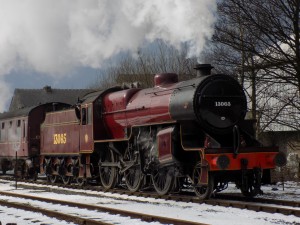 That is guaranteed to cheer me up. The winter sunshine also made taking photos of black locos easier:
That is guaranteed to cheer me up. The winter sunshine also made taking photos of black locos easier:
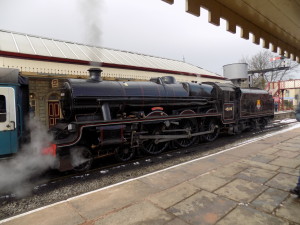 This is Jubilee class ‘Leander’ visiting the ELR from Carnforth for the gala. Next gala later this year they have promised a Duchess, so I will have to go and see that.
This is Jubilee class ‘Leander’ visiting the ELR from Carnforth for the gala. Next gala later this year they have promised a Duchess, so I will have to go and see that.
6th March 2018: Leeds City Art Gallery
I went to a library meeting in Leeds last week during the period of bad weather. Luckily, the trains were running pretty well, though my train was 20 minutes late getting to Leeds. As quite a few people at the meeting had traveled across the Pennines to get there, it was decided that the meeting would end early to give us all a chance to get home in good time. However, I had bought a ticket on a particular train, so I had to find ways of entertaining myself in Leeds for a couple of hours, preferably somewhere warm out of the snow and wind. The Leeds Art Gallery was on my way back to the station, so I stopped there, expecting nothing much more than the usual Victorian art that usually makes up these collections. However, the first thing that I saw inside the gallery was the cafe in the tiled room:
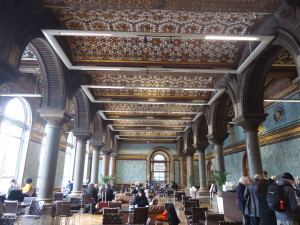 This was not what I expected at all, and raised my hopes that the rest of the building would be equally interesting. Apparently, the building has had a major refurbishment in the last decade or so, and has been restored to how it must have looked when it was built in the 1880’s.
This was not what I expected at all, and raised my hopes that the rest of the building would be equally interesting. Apparently, the building has had a major refurbishment in the last decade or so, and has been restored to how it must have looked when it was built in the 1880’s.
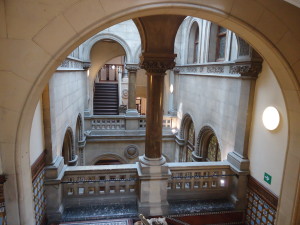 The design involved much use of glazed tiles, elaborate arched windows and doors, ornate pillars, and stained glass in beautiful designs:
The design involved much use of glazed tiles, elaborate arched windows and doors, ornate pillars, and stained glass in beautiful designs:
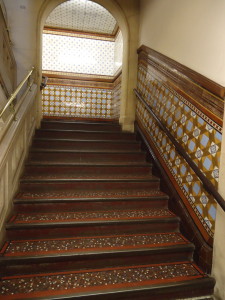 It was not easy to take good photos in the confined spaces, but I think these photos give some idea of how attractive the designs are, and they reminded me a little of the interior designs in Barcelona we had seen, though rather more restrained and formal:
It was not easy to take good photos in the confined spaces, but I think these photos give some idea of how attractive the designs are, and they reminded me a little of the interior designs in Barcelona we had seen, though rather more restrained and formal:
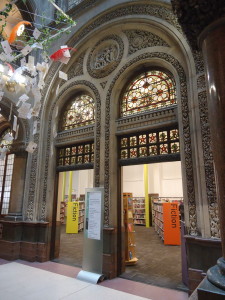 I’m not sure the library signs and shelves help aesthetically, but the combination of a complex, colourful designs and practical usage is very interesting. The people I spoke to who worked there seemed proud of it.
I’m not sure the library signs and shelves help aesthetically, but the combination of a complex, colourful designs and practical usage is very interesting. The people I spoke to who worked there seemed proud of it.
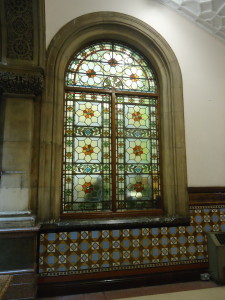 And on the top floor of the library is this wonderful room with a gallery and wood paneled ceiling:
And on the top floor of the library is this wonderful room with a gallery and wood paneled ceiling:
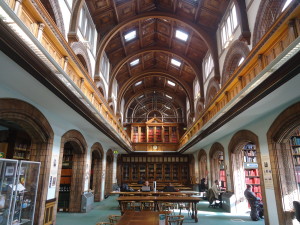 They have restored the art gallery itself, including the well illuminated white painted main room with a large raised glazed roof. This building is well worth a visit, as is the Leeds Museum nearby. So, on the whole, unexpectedly getting time to explore Leeds turned out to be a blessing in disguise. I was told that the Grand Theatre in Leeds in decorated in a similar ornate style, but it was closed that day. Maybe I will need to plan another visit sometime soon when it is open.
They have restored the art gallery itself, including the well illuminated white painted main room with a large raised glazed roof. This building is well worth a visit, as is the Leeds Museum nearby. So, on the whole, unexpectedly getting time to explore Leeds turned out to be a blessing in disguise. I was told that the Grand Theatre in Leeds in decorated in a similar ornate style, but it was closed that day. Maybe I will need to plan another visit sometime soon when it is open.
7th February 2018: Kendal Model Railway Exhibition
Mark has been unlucky recently with the weather when he visits the Lakes. It has been consistently cold and wet, which you might expect at this time of year, but it has seemed even worse than usual. Because of this, we have had to find other more indoors things to do. The last time Mark was staying up north, we discovered that there was a model railway exhibition in Kendal, and as this interested both of us, we paid it a visit. It was more interesting than I had thought it would be, with a range of model railways and other stalls selling books and bits of model railways. The model railways were a mix of gauges and involving various setups, mostly British but with a few continental and American prototypes. One American layout included a waterfall with flowing water:
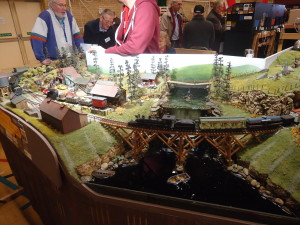 The layout that i found most interesting was an ‘O’ gauge line based on the Lancashire and Yorkshire prototype, from around 1910.They had a good array of locos:
The layout that i found most interesting was an ‘O’ gauge line based on the Lancashire and Yorkshire prototype, from around 1910.They had a good array of locos:
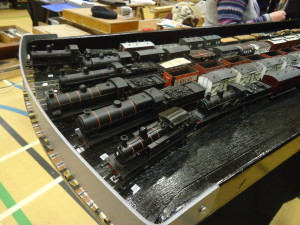 It was an end to end layout, with a fan shaped fiddle yard at each end as shown that allowed a particular train to be set up to be the next to run. There was a highly detailed small station:
It was an end to end layout, with a fan shaped fiddle yard at each end as shown that allowed a particular train to be set up to be the next to run. There was a highly detailed small station:
and another layout with a couple of industrial areas to shunt around, such as:
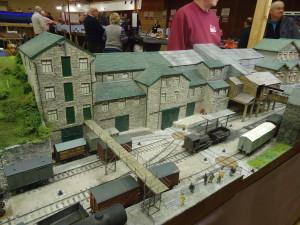 and also a mine and coal sorting shed:
and also a mine and coal sorting shed:
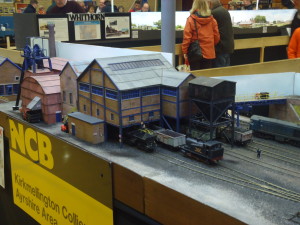 What always strikes me is the level of effort and obsessive attention to detail involved in creating these models. Mark was impressed by several of the layouts as well, but pointed out that some of them either had no signals, or had signals but were not operating them, which he found disappointing. When Hornby started selling its first model railways, no-one seemed too bothered that they were not really to scale, and had details such as handrails painted onto the tinplate bodies of the locos. Gradually, the accuracy of the models seems to have become more of a major feature, as it became less of a child’s toy and more of an adult hobby. Modellers started making sure everything is as close a representation of the prototypes as possible.The only aspect of locos that still remains inaccurate is the wheel width, which is often much too wide, probably so that the locos will stay on the track! But levels of detailing seem to vary greatly on many layouts. Often the locos and rolling stock are very realistic, and also the railway infrastructure. Many layouts run to a timetable, and try to run trains at realistic speeds, and use proper link couplings. Signalling seems a bit of a blind spot, perhaps because it is quite difficult to do. When I go to these exhibitions, one jarring element always seems to be non railway aspects of layouts. When there is a road, there are people and vehicles on it, but of course they never move. If everything else is realistic, why include them? If the buses are in a station, maybe that isn’t too bad, but if they are on a road, couldn’t some way be found to make them move with magnets under the baseboard, for instance? I expect the modellers would say that it is not very important, but it seems strange to me to spend so much time on certain things, and then undermine the realism by being less careful in others.
What always strikes me is the level of effort and obsessive attention to detail involved in creating these models. Mark was impressed by several of the layouts as well, but pointed out that some of them either had no signals, or had signals but were not operating them, which he found disappointing. When Hornby started selling its first model railways, no-one seemed too bothered that they were not really to scale, and had details such as handrails painted onto the tinplate bodies of the locos. Gradually, the accuracy of the models seems to have become more of a major feature, as it became less of a child’s toy and more of an adult hobby. Modellers started making sure everything is as close a representation of the prototypes as possible.The only aspect of locos that still remains inaccurate is the wheel width, which is often much too wide, probably so that the locos will stay on the track! But levels of detailing seem to vary greatly on many layouts. Often the locos and rolling stock are very realistic, and also the railway infrastructure. Many layouts run to a timetable, and try to run trains at realistic speeds, and use proper link couplings. Signalling seems a bit of a blind spot, perhaps because it is quite difficult to do. When I go to these exhibitions, one jarring element always seems to be non railway aspects of layouts. When there is a road, there are people and vehicles on it, but of course they never move. If everything else is realistic, why include them? If the buses are in a station, maybe that isn’t too bad, but if they are on a road, couldn’t some way be found to make them move with magnets under the baseboard, for instance? I expect the modellers would say that it is not very important, but it seems strange to me to spend so much time on certain things, and then undermine the realism by being less careful in others.
There was also a railway simulation game being shown in the exhibition, which both of us enjoyed. Basically, you could choose a train to drive, and then sit in the cab operating the loco as you ran between say Stafford and Birmingham. You can choose what loco, train and route you take, and the cab controls are operated by you as you react to signals, speed restrictions and other aspects of the job. The simulation was very good, and the world created by the computer seemed detailed and accurate. You could move out of the cab and look at your train from outside, and look at the landscape around the train as well. Mark looked into it online and was a little put off by the prices, and I do not know how often you would want to run the same route, but it was interesting. Maybe it would be something to do on the cold wet days in Cark!
30th January 2018: Swallows and Amazons for ever!
David has asked me recently to purchase for him hardback copies of two of the Arthur Ransome Swallows and Amazon books, as he only had tatty paperbacks bought for us maybe fifty years ago. When I did this, I realised that I did not have any of these books in the small collection of books from our childhood that I have up in Cark. This seemed to be to be a major gap in the collection, as both David and I really enjoyed them, and we now have a house very near the area of the Lakes where five of the books are set. Acting on this impulse, I managed to get hold of several of the books cheaply online in paperback. There is always a risk involved in re-reading books fondly remembered from childhood, but I have found that I have really enjoyed re-reading these books. Thinking about it, there are several reasons why this is the case.
Firstly, Arthur Ransome had a lifelong attachment to the south Lakes, and particularly the areas around Lake Windermere and Coniston Water. In the 1890’s his family stayed for their holidays in a farm in Nibthwaite near the south end of Coniston Water. Later on, he stayed with his friends the Collingwoods, including two daughters with independent tendencies, in a house near the north end of the same lake. During these visits, he learned to fish and sail, and picnicked on Peel Island, and experienced first hand the lives of people living and working around the lake. In the 1920s, he stayed with the Collingwoods again, and passed the sailing skills on to the next generation who were the children of one of the two daughters who had married a man named Altounyan. These five children later developed into the fictional Walker family. He wrote several of the novels whilst living around the area later in his life, and is buried at Rusland near the south end of Coniston Water.
It is not just the people and places, but also his feelings for the area that still emerge strongly from the books. For instance, He skated on the frozen lake Windermere in 1895, he sailed, camped and skated with the Altounyan children, and he learned about mining from an old friend who married the other Collingwood daughter. No doubt he met charcoal burners, farmers and miners and other sailors and saw wrestling, sheepdog trials and hound trails, and used these experiences In his books. I think that his portrayal of life in the lakes shows a strong emotional empathy for the lives of the people. The other natives apart from the parents are seen as mostly friendly, tolerant of the children’s antics and supportive when needed, such as providing milk and water to campers, and also a social web of people who all know each other’s business. Occasionally, they even manage to stop Nancy in her tracks, dismissing her attempts at manipulating their behaviour for her own ends.
Other elements of the authors own life enter the books. Ransome’s old car becomes the Rattletrap in the books, he sent signals between houses using coloured shapes hung on a wall, and his early experiences in fishing, exploring, examining the flora and fauna, and camping on the lake shore and islands provided material for him. Peel island on Coniston Water becomes the fictional Wild Cat island.
The book is full of a sense of wistful memories of these happy periods in his life, and the lost traditions and skills that were dying out even by the 1930’s. Both the characters and author make a careful mix of living in the real world and that of their imaginations, as children on holiday and as explorers and adventurers. There is a sense of a real world and people that continue outside and beyond the children’s adventures, hints of experiences happening before the current adventure, that make the characters seem much more three dimensional to a reader.
The characters in the books are a similar mix of actual people and Ransome’s imagination. The Altounyan children mentioned previously seem to be a straightforward model for the Walker children in the books. Their names were Taqui, Susan, Titty, Roger and Brigit, which is more or less identical, except for the eldest, who was changed to John. Interviews with the Altounyans later in life seemed to indicate that they felt the author had captured elements of their characters well in the books, although there is also a certain resentment at the fact that people started assuming they were exactly like the fictional characters. There is an early draft of ‘Peter Duck’ called “their own story”, where the children are all together one Christmas in a boat, discussing the publication of “Swallows and Amazons”, and criticising its author. They feel that he has distorted their characters a little, and changed events around. Nancy even thinks that the author didn’t make it exciting enough! The reactions are recognisable as being very similar to the Alounyan children’s reactions to the publication. There is humour in the children suspecting Uncle Jim- the fictional Arthur Ransome character who shares many of the author’s characteristics- to be the author, though he of course denies it.
Though the books were seen as a new direction for children’s literature at the time, with greater realism and less patronising attitude to the children characters, there are some elements of the books that may distract a modern reader. The language used by characters seems very old fashioned now. The characters live in very middle class, stable households with benign and tolerant parents. The Walker children are all a bit too good to be true. Susan is mostly a stand in mother figure, at least at first, and John is much too sensible, and conscientious. Arthur Ransome felt he had been a bit of a disappointment to his own father, and John is the dutiful son that he had hoped to be himself. The balance to all this sensibleness is the unfortunately named Titty, who is sensitive and thoughtful, often lost in her favourite books such as Robinson Crusoe, a bit of a dreamer, but a driver of the major plot developments several times in the books. The youngest, Roger, is a stereotypical mischievous small boy who Susan tries to keep under control.
The most memorable character in the books is undoubtably Nancy Blackett. She is a force of nature in herself, often initiating adventures and driving the plot, and persuading the others to follow her lead. Nancy is a tomboy, unwilling to accept any restrictions to her actions, and to conform to the stereotype of female behaviour. She is fiercely loyal to her family and friends, and also has a vivid imagination. Some critics have pointed out that if the Walkers represent respectability, order and increasing awareness of more adult responsibilities as the series progresses, Nancy represents chaos and unpredictability and keeping a more self centred, impulsive, world view. But even Nancy has the real world impinge on her world. She feels guilty that the Great Aunt uses her behaviour to be nasty to her mother, for instance, and these moments of vulnerability make her seem more sympathetic and real to a reader. Several times, the Walkers careful plans are disrupted by her impulsivity. She shocks at least John and Susan with her irreverent attitude to authority, and defiance of adult restrictions on her actions, especially when her fearsome Great Aunt is visiting. But she is also generous and caring, always willing to help when she can and let others get involved. When Dick and Dorothea appear, the Walkers seem unsure about letting them be part of their expedition, but Nancy is all in favour of them. She is probably the most interesting character to a modern audience. There does not seem to be a single source for this character. Ransome’s second wife Evgenia is a possible model, along with the Collingwood daughters and Taqui Altounyan. It has been suggested that Ransome “made Nancy up to be the perfect tomboy girl that he never met in reality, using things he liked about several girls he knew. Then he grew so fond of her that she became real-to him.”
Dick and Dorothea are interesting characters, usually seen by critics as not based on any real life models, but created from elements of Arthur Ransome’s own character. They are sympathetic characters for the reader to enjoy being introduced into the established world of the first two Lakes based books. Dorothea is the romantic and Dick the scientist, again with absent but sympathetic middle class parents, and who, unlike the Walkers and Blacketts, do not have skills in sailing and camping, and so like the readers, have to learn as the books progress. They also link the two main worlds of the books, the Lakes and the Broads.
Arthur Ransome also wrote himself into the books as Nancy’s Uncle Jim, and benevolent, well travelled man not unlike the author himself, always willing to help the children and join in their schemes. His houseboat home is a composite of two steamships Ransome saw in his youth, the Gondola on Coniston, and the Esperance on Windermere. There were also two sailing dinghies that Ransome and the Altounyan children sailed on Coniston that were the basis for the Swallow and the Amazon. Ransome sailed in a number of ships before his health failed, including the model for the Goblin in ‘Secret Water’ and ‘We didn’t mean to go to sea’ that is still sailing, named Nancy Blackett.
The final word about the characterisation should be left to the author, who, when asked if they were real children he responded that they were composites…”they’re a mixture. There were real children, but now they’ve become something quite different; they’re from my head.”
The other element that makes the books still readable now is the narrative tone, which is precise, unpretentious, humorous and introduces enough detail to create a believable world and make the scenes work in their context. It may seem rather paternalistic and old fashioned to a modern audience, but it sets the tone of the books consistently well. The wonderful drawings that Ransome created also help greatly in this. Nothing in the books seems unbelievable or too far from what children might do. Writing these books in his late forties, Arthur Ransome used his experience and expertise developed in his writing career up to that date to write the books he enjoyed, and that children came to enjoy. In his career, he had started doing largely hack work on the edges of London’s literary circles, then worked as a foreign correspondent during the Russian revolution, developing a precise and succinct prose style suitable for press reports, so this was his third career as a writer. He made the most of his varied experience and writing skills to write these books that are still popular, and have given him recognition as a leading figure in children’s literature in England.
30th December 2017: Recent photos
This is the latest in my occasional series of blogs of recent photos that I have taken. Though the weather has not been particularly kind when Mark and I have been in the Lakes recently, there has been an occasional good day, where we have seized the chance to go out and enjoy the landscape in it’s early winter starkness. We visited Loughrigg tarn on a cold clear day, and I took this photo of the tarn with the Langdale pikes as the backdrop:
I have also climbed up Latterbarrow to enjoy the view of the north end of Lake Windermere, and the hills covered in snow:
Chances to take photos are more limited at this time of year, but the dark and short grey days occasionally provide a beautiful sunrise or sunset, such as this one at Cark:
This occurs at Prestwich as well, if I am wide enough awake to see the sunrise:
And even in Oxted for this sunset over Master Park:
I suppose that the message is the obvious one- always be ready for the photographic opportunity when it occurs. I guess carrying around a small camera or phone that you can use helps as well!
20 November 2017: The Meaning of Portraits
I have been to see a number of exhibitions in London recently whilst staying with Mark, and it struck me that it is possible to see each of the artists approaching the problems of portraiture in their own different ways, and how it reflects the radical changes in art from the mid nineteenth century to today. The rise of photography made formal portrait painting largely redundant. What could artists do to make their portraits distinctive? What could they reveal that photography can’t, and what different techniques could they use?
As a generalisation, up to the mid nineteenth century, artists had been painting works approved by their patrons, so portraits followed a long established classical style, with a techniques of smooth even brush strokes and standard poses, emphasising the power and importance of their sitters, who largely controlled the process. The rise of the monied middle classes had helped loosen this stranglehold and allow the artists greater freedom. In the mid nineteenth century, the impressionists made a major break from this orthodoxy. Their paintings are now regarded as colourful and sometimes chocolate boxy, were radical in their day, painting ordinary scenes of people doing ordinary things, and seeming to paint them spontaneously with bright colours using broad rough brush strokes, often outdoors rather than in a studio. There are also areas of the canvas covered only in thin washes of paint, and others covered in thick strokes of colour.
The term impressionists was taken from Monet’s painting Impression-Sunrise, and was meant as an insult when first used, meaning their works were like a rough preliminary sketch for a painting, that according to orthodox opinion, needed working on later in the studio to reach a proper standard of finish, and were not for public viewing.
The exhibitions that I saw recently show that Cezanne and Degas, and then Soutine and Matisse were all developing their own styles and theories of art away from the art establishment, all in the aftermath of the impact of Impressionism. Degas was one of the impressionist group, and he was as radical as any of them, portraying snapshots of people in ballet classes, or watching horse races and at other everyday events. He also painted women at work, or in private moments such as bathing. His paintings seem to allow the viewer to watch people without them being aware, looking for the moments of unconscious grace and also unguarded moments of awkwardness, admiring the natural forms and poise of their bodies. This is art of the moment and of movement. In this example, people are cut off by the frame, or obscured behind a staircase. A pair of legs can be seen on the stairs but we don’t know anything more about the person. The centre of the picture is a bare wooden floor.
This would seem to be radical to critics in the late nineteenth century. The exhibition that I saw showed that he also started using different media to make art, such as pastels, and exhibiting them as the end product, not just a sketch. Degas was a great sketcher, and filled notebooks with drawings made on the spot, that he could use later in his works. The spontaneity and sheer volume of these drawings is unique in the art world of his time. He used pastels in his own way, with contrasting colours overlaid in visible patterns, not the smooth silvery pastels that were usually seen. Degas seemed to many to break the boundaries of good taste, and some thought he was misogynistic and voyeuristic, but his works also seem to have sympathy for these ordinary women in their lives.
The Cezanne portraits exhibition stated that he was not interested in portraying the psychological depths of a character, but how he could paint a person in terms of geometry, and patches or planes of colours. The portraits of his wife bear this out, as he gives her an oval shaped head in this painting.
What she thought of this is not recorded. He felt uncomfortable painting patrons and working on commissions by well wishers. There is a story in the exhibition of the subject of a portrait telling the artist that he noticed a small patch of bare canvas on his hand in the painting. Cezanne responded that he could repaint the hand, but if he did so, he might need to rethink the rest of the painting. The sitter then withdrew his comment, as he said, trembling with fear. Cezanne was notorious for losing interest in paintings he was doing, as occasionally destroying them in a temper if they were not achieving what he wanted. His works are fascinating in their experiments with form and colour, and when it works, quite breathtaking. His influence on later artists such is openly acknowledged even by as proud a man as Picasso himself.
In many ways, Picasso is the epitome of these radical artists. I have been reading a biography of him by Patrick O’Brien, and it makes clear that these artists were driven by a need to break from the orthodoxy of the art world, and forge a new art for themselves. Picasso started a revolution himself with his painting Les Demoiselles d’Avignon which sent shock waves through the art world in its mix of cubism and African art. None of these artists was willing to rest on their laurels and just repeat a successful formula. As O’Brien points out, Picasso could have just carried on churning out copies of his blue period paintings which has gained him his first recognition, but he rejected this and risked his career on a radical new direction. All these artists faced ridicule and abuse at the time, but were later recognised as visionaries. Picasso was called a charlatan, but his actions and sustained reputation as one of the greatest artists of the twentieth century prove otherwise.
The two twentieth century artists that I saw exhibitions of took different views of portraiture. In the early 1920s, Soutine became fascinated by the cooks and waiting staff of French hotels and restaurants, attired in boldly coloured uniforms.
He painted them in thick impasto colours, distorting their features to emphasise aspects of their portraits, so this pastry cook looks both very young and also quite world weary, in a uniform too big for him. It would be seen as radical and almost deliberately contrary to the art world to paint such lowly people at the time, especially As they were employed to serve the rich patrons of the clubs and hotels they worked in. But the technique works in creating sympathetic paintings of these often overlooked and overworked people, showing them as more than servants, having personalities of their own.
Matisse took a different approach. The exhibition showed items from his studio such as colourful and exotic Octagonal tables and scallop shell chairs with carved sea monsters as arms, and highly coloured rugs and wall hangings, and in his paintings, the human figures seem to be no more important as these colourful but inanimate objects. The bright light shining evenly on the colours of the decor, and the lack of perspective and variation in brightness seem to make his paintings flat and poster like, so no object throws a shadow, and the women seem to float in space. The results are beautiful and rather dreamlike.
Matisse was another radical who shocked the art establishment in his time, and maybe the defying of the rules is what makes these artists interesting still when many of their contemporaries have faded into obscurity. The battle between conventional paintings portraying reality and the radical ideas of artists like the five I have mentioned here continues to this day.
- 10 October 2017: Loving Vincent
I have been to see this last night, and I was very impressed, and judging by the audience reaction, everyone else in the cinema was as well. The producers claim that this film is the first feature length painted animation film, reimagining 94 of Vincent Van Gogh’s paintings using over 66,000 frames painted by 125 artists in his style on projections of a combination of live actors and computer generated scenes for around 850 shots.
Each shot involved one oil painting being created, a photo made of it, and then the painting altered for the next photo in the sequence at a rate of twelve photos/frames per second of film. Each artist had to co-ordinate their “Van Gogh” painting style along with the all the other artists. Unsurprisingly, this has taken them eight years to complete. There are also flashback scenes in black and white in the style of photographs from the era.
The plot involves a number of people who were subjects of Vincent’s portraits. It starts with Armand Roulin being persuaded by his father the postmaster to hand deliver a last letter from Vincent to his brother Theo, as the postal service couldn’t deliver it. Armand quickly learns that Theo is also dead, but whilst he is waiting to see Dr.Gachet and give him the letter instead, he is drawn into the mystery of Vincent’s last weeks. He gets conflicting stories from various witnesses, including the doctor’s daughter Margaret Gachet, his housekeeper Louise Chevalier, the innkeeper’s daughter Adeline Ravoux, and Vincent’s paint supplier Pere Tanguy.
Why did Vincent kill himself when he was in better health than before, and seemed to be starting to be successful at last? The producer describes the film as a ‘Vincent noir’ and it does follow Armand’s increasingly obsessive investigation of Vincent’s last days as the framework of the story. Also, in noir style, it turns out that everyone feels guilty of actions to bring Vincent down in the last weeks of his life. I am sure that experts could pick holes in the plot, but that is not the most impressive part of the film. It is clearly a labour of love in reproducing Vincent’s paintings in loving and accurate detail, and successfully creating scenes within them. This includes both his landscapes and portraits. Many scenes start with characters in the poses of their portraits, such as Dr.Gachet leaning on his hand with his elbow on a table, but this is cleverly done so it doesn’t disrupt the story.
The faces are portrayed in a simplified version of the artist’s style, but also manage to show the emotions and expressions of the characters at the same time. Some critics have criticised it as an oversimplified travesty of the artists life and style of painting, but I felt that the creators had succeeded in creating a loving homage to the artist celebrating his art and giving some depth to his story. It is ravishing to look at, and a great technical feat. In the Q and A afterwards, the producer said they plan to create a painted animation horror film next based on Goya’s paintings. I am looking forward to it already!
- 4th September 2017:Cadafalch and Montaner: emerging from Gaudi’s shadow
When you mention Barcelona to people, they are most likely to respond with the name of Gaudi or players from the football club of that city. It seems at times that much of the tourist industry in the city is based around visiting the various Gaudi sites, and if the visitor is interested in art, the museums dedicated to Picasso and Miro. But there have been other architects in the city, contemporaries of Gaudi, that are worth paying attention to. Josep Puig i Cadafalch (1867-1956) and Louis Domenech i Montaner (1850-1923) are two such men. Both were strong Catalan patriots, determined to establish the Catalan culture as separate and different from that of Castilian Madrid, and they had middle class industrialist clients in Barcelona eager to share these aims, supported by the growing industrial power and influence of the city in the late nineteenth and early twentieth centuries. Both men built a number of buildings in the city, and we discovered that the owners of some of these buildings are now starting to set them up as tourist attractions in their own right. The so called Illa de la discordia in the Passeig de Garcia puts examples of houses by Gaudi, Montaner and Cadafalch together in a clash of modernists styles. Cadafalch designed the Casa Amatller:
This is in contrast to the Gaudi designed Casa Batllo next door. Montaner designed the Casa Lleo Morera at the other end of the block:
Rather than Gaudi’s flights of fancy, these seem more prosaic, but incorporate ideas of medieval and moorish architecture and elaborations and ornaments, and subtle colours in the brick and tiles that set them apart from the normal run of buildings. The Morera house is a shop and private residence, and so is largely inaccessible. The Amatller house is more accessible, even including a nice cafe and chocolate shop, and we did a guided tour around it. the interior is well worth seeing, with lots of elaborate decorations, stone pillars, coloured tiles and glass work. We were impressed by the use of coloured glass in doors and walls:
On a practical level, you imagine that these houses must take a lot of looking after, and if you lived in them, you might be always afraid of breaking something! The other building designed by Cadafalch that we saw is the Casa Terrades, or Les Punxes, house with the spikes or spires
This building is actually three houses in one block, built for three sisters to live in. Again, it has only fairly recently been opened to the public, and we went on a tour. Some of the floors are still private, and a lot of the first floor is taken up to an audio visual retelling of the legend of St.George and the dragon, which is very important to Catalans for reasons that were not obvious. There are interesting displays about the history of the architect, and his role in Catalan politics and culture, and the history of the house. Unfortunately, a lot of the most individual architectural details of the house are on the outside of the building, and not easy to see. For instance, there are five plaques on the exterior at roof level that can only been seen from the street, such as this one of St.George:
The roof space is worth seeing as well, and you can access the interior of the spires, and get good views of the area. You can recline on an easy chair in one spire, and listen to Wagner, who was another great influence on the architect!
as you might be able to tell from the photos above and below, Cadafalch and Montaner shared an interest in using moorish style details and elaborate ironwork with Gaudi, though not to tthe same extent. They also had in common the use of elaborate brickwork and medieval style windows like this at the entrance of the Casa Terrades:
Montaner’s most elaborate and satisfying building in Barcelona is the Palau de la Musica Catalana. Mark has discussed it in one of his blogs, and also included a photo of the building. We also went to see the Hospital de Sant Pau designed by Montaner, which is now described as an Art Nouveau site, but was a hospital for 60 years. There are twelve buildings on the site, and most of them are not accessible to the public, which was a little disappointing. However, the ones that we could see were impressive, and you could imagine it being a good environment for convalescent patients, full of light and colour. The decoration in the buildings is in the modernist style, such as this:
The exterior of the buildings were interesting as well:
Both Mark and myself concluded that it is worth exploring the works of Montaner and Cadafalch, though they lack the mad obsessive genius of Gaudi himself, and have much less eye catching flamboyant architectural designs, as well as much less pronounceable names. By the way, any errors in spelling names are down to me and a battle with the spellchecker, which was not fond of Spanish names! The overall impression that we took from this is that though we enjoyed all our visits, there is room for improvement and further development on several of these sites. Maybe when we visit Barcelona again, they will have made the experience even more worth while. Also, the Gaudi designed Casa Vicens will be open again, which I really look forward to seeing.
17th August 2017: Yorkshire Sculpture Park
Last weekend, I visited the Yorkshire Sculpture Park for the first time. A number of people had been telling me it is worth a visit, and that the current exhibition by Tony Cragg is worth seeing. The park is a large open air site of around two square miles, with galleries for more delicate works. It is in the grounds of an old stately home, Bretton Hall. Despite his surname which might make you think he is from Yorkshire, Tony Cragg was born in Liverpool and is now based in Wuppertal. He creates complex works, some of which remind you of a cross between a piece of machinery and some organic shape, such as this:
It could also be something from science fiction, like an alien spaceship! One aspect of his work is that they really are three dimensional in the full sense, in that you have to go round each sculpture to appreciate its form from all sides, and see how they change as you go round them. It might sound obvious, but a lot of statues are created to only be seen in one way-straight on from the front, but these encourage you to examine them from all sides and in some cases, wonder how they were created. It is obvious looking at them that a lot of work and preparation has gone into them, and care taken in their creation. Your impression of what meaning they might have, or what feelings they provoke, change as you look more closely at them.
The works also include a number of tall thin pieces by Cragg like this:
The effect of these in the open spaces of the YSP is very impressive. Again, they invite you to study them from all sides, and let your imagination work. Quite often there seem to be faces in profile, parts of torsos, as well as the more obvious mirroring of landscapes.These are made in a variety of mediums, such as wood, metal, and smaller ones in glass and plaster. I enjoyed this exhibition very much.
There was also smaller exhibitions by the Chinese artist Ai Weiwei which were very good. He created twelve animal heads as signs of the zodiac, and arranged them in a semicircle in the park. The heads are supported on poles, and the detail on them is very impressive:
This is the rather scary bears head. They do not have an obvious political or social meaning, unlike his works in the exhibition I saw in London, but they show the same attention to detail in the sculpting of the fur and ears, for instance. There was also a dragons head that was impressive.
The park also has a number of works by Miro, such as this:
These are more works that need to be seen in the round to appreciate the humour of them, so they are ideal for this environment. One side is this distorted face, and the other gives a different impression of the work. I am looking forward to see more of Miro’s work in Barcelona.
There is also a strange art work in the park at present called Seizure. The artist made his flat watertight and then filled it with a liquid that would make blue crystals form on the walls. When the block of flats was demolished, they saved his flat and it is now in the YSP.
It is a rather strange experience to be inside the room surrounded by these bright blue crystals on the walls. You have to admire the single mindedness involved in the creation of it. I enjoyed my visit to the park and I will have to keep an eye out for any interesting exhibitions there in the future. It is definitely a visit to make in dry warm summer rather than winter in the cold and wet!
30th July 2017:steam at Carnforth
I am writing a blog now for July, as I have received comments that I have not posted for a while, but really when Mark and I go to see an event, he seems to be quicker in being inspired to write a blog. One thing I can write about that he is not very interested in is that I have been visiting Carnforth to see steam engines, even if they are ones that I have seen before. I went last weekend as there were two steam hauled trains running. The first was Jubilee class 45690 ‘Leander’:
This photo was made more atmospheric by the fact that it was pouring with rain when I took it! You can just about see the rain if you look closely. The dull black livery does not help much either-I prefer the red livery of the other Jubilee ‘Galatea’ which has been running this summer! This was not actually a special train being run, but the loco and its support coach moving to Crewe to prepare for a special train running the next day on the North Wales coast. The second train was the latest Cumbrian Mountain Express, which had gone north on the Settle to Carlisle route in the morning hauled by a Duchess Pacific, and was returning down the main line via Shap. I first saw it slowly moving through Carnforth station to run into the south sidings:
The loco is 46233 ‘Duchess of Sutherland’. Luckily, the weather has improved by then. The train then spent nearly an hour in the sidings being replenished with water, and then set off again. I had moved to the bridge south of the station to take a photo:
I was pleased with the result, as the sun showed up the loco very well. It is interesting that in the first photo here, the green livery looks dark, but in the second it looks much lighter, like an apple green. In between these two steam hauled trains, I visited our favourite fruit farm near Carnforth, and walked along the River Lune near Arkholme, which was pleasant. After repeated attempts, I even managed to photograph a butterfly on the walk:
This is a small tortoiseshell butterfly. So, despite the rain, I managed to enjoy the day.
24th June 2017: Madrid, Toledo and Segovia
Mark has covered quite a lot of our holiday in Madrid in his blog, so I will try to give a different take on it. We had to walk through the Parque de el Retiro most days to get to the museums and galleries. It is a large park, with a variety of attractions including having its own rose garden and art gallery, and it is obviously very popular with the citizens of Madrid. It also has a very pleasant Palacio de crystal and lake that we enjoyed:
We also used the main station Atocha quite a lot. It is interesting because they have built a modern station in front of the old one, and converted the older station into botanical gardens:
Also, in both the park lake and the botanical gardens, colonies of terrapins have been allowed to thrive:
I would agree with Mark in his description of the over ornate church interiors, emphasising their sheer wealth and power, like this chapel in the royal palace:
I will also remember the large plazas dotted around the city, some full of restaurants, other empty like the Plaza Mayor:
It was enjoyable to walk around the streets looking for restaurants, admiring the elaborately decorated shop fronts, and looking for interesting items in the street markets in the Cortes district:
This shop was decorated with bananas, others had giant ants, or sculptures made from gold bottle tops, or silver tubes from air conditioning units split and twisted into different shapes. We also visited lots of museums and art galleries. The most interesting perhaps was the archaeological museum, with three floors telling the prehistory as well as the history of the Iberian peninsula. I was very impressed by the collection of Roman mosaics, and also several objects of prehistoric art, such as this:
I find it fascinating that we were already producing works like this in palaeolithic times, even when life was dangerous and day to day survival was a struggle.Maybe they believed the art helped them survive in some way, but the skill needed to produce such things as this is astonishing.
I enjoyed the day trips to Toledo and Segovia that we did as well. I think that Mark described them well in his blog, but I also was struck by how much is left of both places as fortified towns. For instance, Toledo still has much of its defensive walls, and massive gates left:
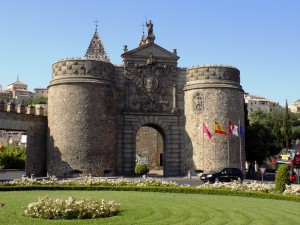 Both places are an interesting mix of the old and the new, with largely sympathetic modern buildings in largely the same materials as the older buildings and with distinctive architectural styles. But the main interest in Segovia is undoubtedly the Roman aquaduct:
Both places are an interesting mix of the old and the new, with largely sympathetic modern buildings in largely the same materials as the older buildings and with distinctive architectural styles. But the main interest in Segovia is undoubtedly the Roman aquaduct:
I know Mark included a photo of this in his blog, but I think it is worth including a closer view as well of this amazing survival from another age. As Mark stated, Spain was hot, dusty and a bit peculiar in some ways, but also very enjoyable, and we had a great holiday. Thank you again, Dave and Sue!
18th June 2017:David in the Lakes
David has been visiting Europe to attend a conference and catch up with family and friends. He spent a few days in the Lakes, staying at Cark, and being energetic as usual. He brought the sunny weather with him, and we had a very good few days. We climbed Black Combe, because he couldn’t remember doing it before. On the west side of the mountain, we came across this old farmhouse, now probably a holiday home, but still with a derelict water wheel attached.
 I love how you can come across something unusual like this in the Lakes, surviving by chance or as a feature in an old building if you explore the lesser known place like this. After this gentle introduction, Dave decided we should try to climb Wetherlam, the Old Man and Dow Crag in one day. We made a good effort, and got up the first two, but then we were footsore and weary and decided to save Dow Crag for another day. Here is a photo of Dave and myself at the summit of the Old Man:
I love how you can come across something unusual like this in the Lakes, surviving by chance or as a feature in an old building if you explore the lesser known place like this. After this gentle introduction, Dave decided we should try to climb Wetherlam, the Old Man and Dow Crag in one day. We made a good effort, and got up the first two, but then we were footsore and weary and decided to save Dow Crag for another day. Here is a photo of Dave and myself at the summit of the Old Man:
If you are wondering why I am holding my coat closed, it was windy up there! The views from the top were great as it was still bright and clear. I took this photo looking down from the summit towards goats water:
The path running up to the left in the middle difference is the path we used to start the climb up Wetherlam, and the zig-zag path on the bottom right is the path we were about to use to get down the Old Man. We had a good if exhausting day, and felt we has achieved something. We also visited Rogan’s restaurant in Cartmel for a meal that weekend, which was another highlight. Then David went to Manchester for his conference, and it rained! Mark and myself went with David to meet up with Sue in Madrid, which I will cover with another blog when I have sorted out my photos.
Mark has already written a blog on his page about our visit to Beamish Museum, so I am going to add my perspective on the visit, and some of my photos. I really enjoyed the visit, and can imagine visiting it again in the future to examine the parts that we didn’t have time to see, such as the farm and the interiors of the houses and shops in the 1900s town. This visit, I was most interested in the engineering and transport side of the museum, such as the NCB electric loco they have:
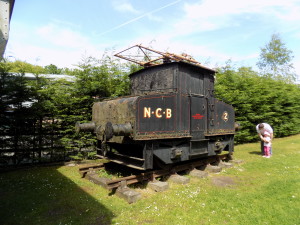 Several local collieries used electric locos to transport coal from the mines to the docks including this one at Harton Colliery. Mark and I agreed that it looked very like the Triang ‘OO’ gauge loco that we had in the loft in Liverpool, though that does have detail differences and the model may just be an imaginary loco design. They also have a large steam powered excavator:
Several local collieries used electric locos to transport coal from the mines to the docks including this one at Harton Colliery. Mark and I agreed that it looked very like the Triang ‘OO’ gauge loco that we had in the loft in Liverpool, though that does have detail differences and the model may just be an imaginary loco design. They also have a large steam powered excavator:
 The museum seems to have a policy of taking in anything donated from large to small, from this excavator to old bicycles, washing machines, bath chairs and children’s toys and dolls. It means they have an interesting but eclectic collection, something for every taste. I was interested in the railway station and the other buildings they have which are imported from the local area. They have several railway buildings including a signal box and also a short railway line, operated by an industrial tank and an old observation saloon built for one of Queen Victoria’s daughters:
The museum seems to have a policy of taking in anything donated from large to small, from this excavator to old bicycles, washing machines, bath chairs and children’s toys and dolls. It means they have an interesting but eclectic collection, something for every taste. I was interested in the railway station and the other buildings they have which are imported from the local area. They have several railway buildings including a signal box and also a short railway line, operated by an industrial tank and an old observation saloon built for one of Queen Victoria’s daughters:
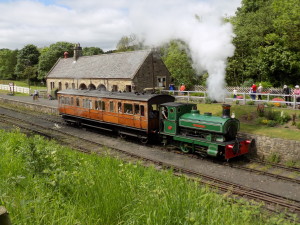 They also have a collection of three really old steam engines, both replicas and originals, at the Pockerley Waggonway. The loco in the photo below is called ‘The Elephant’, and is a replica of an original design from 1813. This replica is based largely on contemporary oil paintings of this loco. They also have a replica of ‘Puffing Billy’, and an original loco from 1850, ‘Hetton Lyon’.
They also have a collection of three really old steam engines, both replicas and originals, at the Pockerley Waggonway. The loco in the photo below is called ‘The Elephant’, and is a replica of an original design from 1813. This replica is based largely on contemporary oil paintings of this loco. They also have a replica of ‘Puffing Billy’, and an original loco from 1850, ‘Hetton Lyon’.
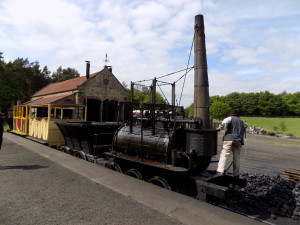 ‘The Elephant’ and ‘Puffing Billy’ replicas are operational, and ‘The Elephant’ was running up and down a short piece of track. The other two other locos and an old carriage are in a shed nearby that you can see in the photo. When moving, ‘The Elephant’ looks like a sewing machine, with rods and levers moving up and down above the boiler. it is also evidence of how quickly steam loco design developed from these fairly simple machines to the much more powerful and reliable locos of twenty of thirty years later, and also how little care was paid to the safety and comfort of the crew in the early days!.
‘The Elephant’ and ‘Puffing Billy’ replicas are operational, and ‘The Elephant’ was running up and down a short piece of track. The other two other locos and an old carriage are in a shed nearby that you can see in the photo. When moving, ‘The Elephant’ looks like a sewing machine, with rods and levers moving up and down above the boiler. it is also evidence of how quickly steam loco design developed from these fairly simple machines to the much more powerful and reliable locos of twenty of thirty years later, and also how little care was paid to the safety and comfort of the crew in the early days!.
One aspect of the museum that would interest David is they have rebuilt a small colliery on the site using machinery and buildings from local closed collieries. This could be used as models for a layout, as the scale is quite small. The photo below shows some of the buildings used for coal grading and the winding wheel building behind it.  We visited the winding house and enjoyed a talk about how the winding system worked, including a practical demonstration of the wheel mechanism and the bell signalling system, even though the wheel is not attached to any underground mines or anything else these days. All in all it was a very enjoyable visit, even if it involves a 220 mile round trip from Cark.
We visited the winding house and enjoyed a talk about how the winding system worked, including a practical demonstration of the wheel mechanism and the bell signalling system, even though the wheel is not attached to any underground mines or anything else these days. All in all it was a very enjoyable visit, even if it involves a 220 mile round trip from Cark.
3rd May 2017: lizards, butterflies and birds
I have recently discovered that there are a number of small but interesting nature reserves around the Furness area, including several alongside the A road between Grange and Levens. I have visited several of them in the last couple of weekends, and seen a variety of birds, butterflies, dragonflies and lizards. I have also visited the RSPB reserve at Leighton Moss near Silverdale, which has improved greatly since I was last there. 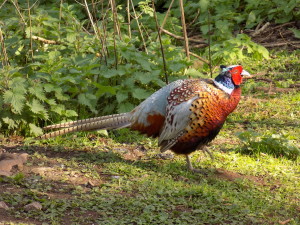 There were a lot of pheasants in the reserve, making that noise like a gate being forced open on rusty hinges, but they did look rather beautiful in their plumage. There were also a lot of smaller birds, including goldfinches:
There were a lot of pheasants in the reserve, making that noise like a gate being forced open on rusty hinges, but they did look rather beautiful in their plumage. There were also a lot of smaller birds, including goldfinches:
 It was good to see such a pretty little bird, but there are difficulties photographing small creatures even with a zoom lens, in that they don’t stay in one place for long, they move very quickly and they are easily scared off – not surprising, when many other animals and birds see you as a tasty meal!
It was good to see such a pretty little bird, but there are difficulties photographing small creatures even with a zoom lens, in that they don’t stay in one place for long, they move very quickly and they are easily scared off – not surprising, when many other animals and birds see you as a tasty meal!
When I visited Foulshaw Moss, they were advertising that ospreys are nesting there. I did see an osprey, at a great distance, through a powerful telescope, which was a thrill. There were also smaller creatures there as well, such as this small lizard:
 It is unusual for one to stop and pose for a photo like this. You usually just get a glimpse of one disappearing under the boardwalk before you can get a chance for a proper look or a photo. Maybe it was enjoying the sunshine. There are also butterflies there, and if you are patient, you can creep up on them. However, they also tend to fly away before you can get too close, or just close their wings to frustrate you. I did get a photo of this orange tip butterfly:
It is unusual for one to stop and pose for a photo like this. You usually just get a glimpse of one disappearing under the boardwalk before you can get a chance for a proper look or a photo. Maybe it was enjoying the sunshine. There are also butterflies there, and if you are patient, you can creep up on them. However, they also tend to fly away before you can get too close, or just close their wings to frustrate you. I did get a photo of this orange tip butterfly:
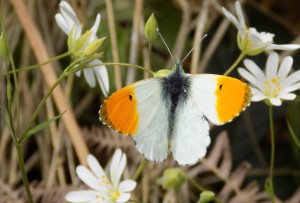 One good photo like this makes up for all the failures. There were also peacock butterflies:
One good photo like this makes up for all the failures. There were also peacock butterflies:
 There were not very many dragonflies as yet, and none of the colourful ones, but that would just be asking for too much! I will return later in the year and see if any dragonflies are willing to pose for me.
There were not very many dragonflies as yet, and none of the colourful ones, but that would just be asking for too much! I will return later in the year and see if any dragonflies are willing to pose for me.
18th April 2017: Millerbeck Light Railway
Mark and I have spent Easter up in the Lakes. The weather has been changeable, but as we kept out of the central Lakes, where the mountains seemed constantly shrouded by clouds, we had reasonable weather and were not troubled by crowds. On Easter Monday, Mark had to drive back to Oxted, so I had to entertain myself. I noticed that the Millerbeck Light Railway at Staveley near Newby Bridge was operational, and went to visit it. I have visited it before a couple of years ago, and was impressed by it: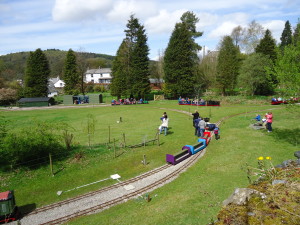
It is in the grounds of a private house, and is only open at limited times, such as bank holidays. It is 7 1/4 inch gauge, and runs in loops for around a mile within the grounds. They can run a number of trains at once, each loco hauling a couple of open carriages with a central seat the you straddle. It is all controlled by a signal box near the house. They have steam, diesel and even and electric battery loco on the lines of a Swiss loco:
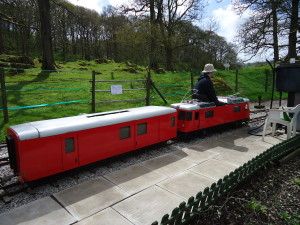 Of course, I am most interested in the steam locos, which were all coal fired, as David would appreciate.
Of course, I am most interested in the steam locos, which were all coal fired, as David would appreciate.
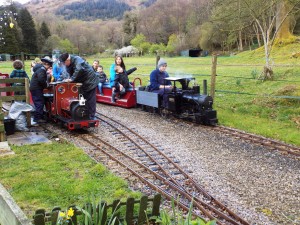 It is a big attraction for families with small children, and also includes a picnic area and shop. The line has a turntable, engine shed and yard to admire as well. It is all very well organized and carefully managed.
It is a big attraction for families with small children, and also includes a picnic area and shop. The line has a turntable, engine shed and yard to admire as well. It is all very well organized and carefully managed.
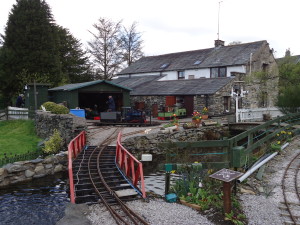 They have installed semaphore signals since I was last here, which adds to the interest as well:
They have installed semaphore signals since I was last here, which adds to the interest as well:
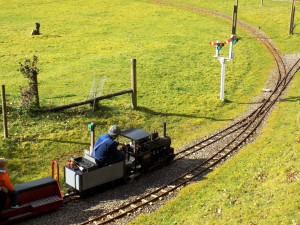 All in all, it is a very interesting little railway, and well worth a visit.
All in all, it is a very interesting little railway, and well worth a visit.
27th March 2017: sunny weekend in the Lakes
After a couple of weekends where it never seemed to stop raining, we have just had a really nice weekend in the Lakes. It was bright and sunny, and even though the temperature was by Aussie standards still pretty low (ie. below 20C) it was really pleasant. Mark and I took advantage by visiting Tarn Hows, before the Easter rush:
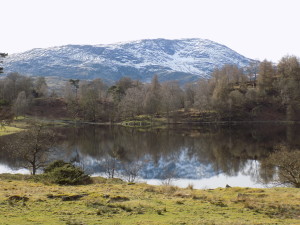 As you can see, there is still snow on the peaks of the mountains. We also visited Wastwater the next day:
As you can see, there is still snow on the peaks of the mountains. We also visited Wastwater the next day:
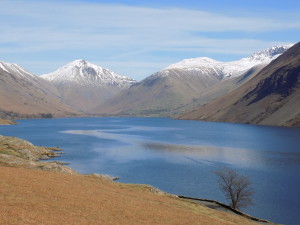 The lake is a beautiful as ever, with the snow capped mountains beyond it. We had a picnic near the lake, and I saw a dark shape under the water, with occasional flashes of white, and bubbles rising to the surface. Was this the little seen wassie, or wastwater monster? After a while, the creature rose up out of the depths:
The lake is a beautiful as ever, with the snow capped mountains beyond it. We had a picnic near the lake, and I saw a dark shape under the water, with occasional flashes of white, and bubbles rising to the surface. Was this the little seen wassie, or wastwater monster? After a while, the creature rose up out of the depths:
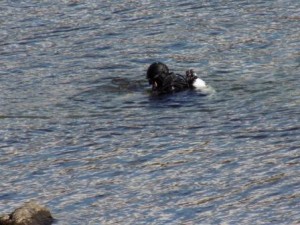 We could see its armoured head rising out of the waves…
We could see its armoured head rising out of the waves…
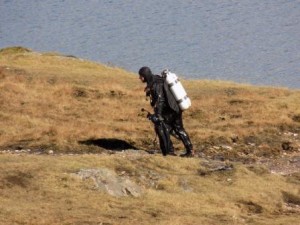 and then it turned out to be someone diving in the lake. What a let-down!
and then it turned out to be someone diving in the lake. What a let-down!
That was not the only excitement of the day. There was also an aerial invasion of Wastwater by a light aircraft:
 it came over the mountains, flew the length of the lake at around 70 feet above water level, turned and went back up the lake and then went back over the mountains. Perhaps someone wanted to take photos from the air of landmarks in the Lakes. It certainly was a good day for it-bright and clear.
it came over the mountains, flew the length of the lake at around 70 feet above water level, turned and went back up the lake and then went back over the mountains. Perhaps someone wanted to take photos from the air of landmarks in the Lakes. It certainly was a good day for it-bright and clear.
However, Mark refused to get too excited about all this, and continued to read his book.
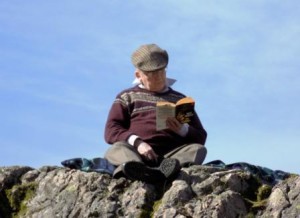 He boasts of having photos of himself reading in various beauty spots in the Lakes from his teenage years onward. However, he was kind enough to let me go and see a steam engine at the Eskmeals viaduct later in the day:
He boasts of having photos of himself reading in various beauty spots in the Lakes from his teenage years onward. However, he was kind enough to let me go and see a steam engine at the Eskmeals viaduct later in the day:
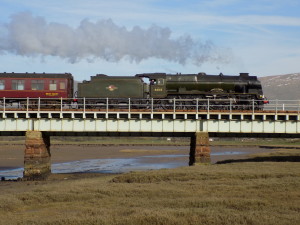 It was “Scots Guardsman” on the Cumbrian Mountain Express. There were hoards of people taking its photo, and probably more traffic on that road than it usually has in a year. We then drove back to Cark and saw it going past there as well. Mark cooked us a very nice meal, which rounded the day off nicely. All in all, a very pleasant weekend.
It was “Scots Guardsman” on the Cumbrian Mountain Express. There were hoards of people taking its photo, and probably more traffic on that road than it usually has in a year. We then drove back to Cark and saw it going past there as well. Mark cooked us a very nice meal, which rounded the day off nicely. All in all, a very pleasant weekend.
12th March 2017: East Lancashire Railway steam gala
This weekend, the East Lancashire Railway have been holding their Steam Gala. have run an all steam hauled service using their own engines, and also two visiting locos. Their own locos included two Black Fives and a Horwich Crab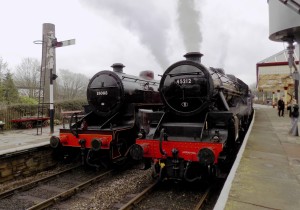
And an Aspinall A class 0-6-0:
The visiting locos were a standard class 4 2-6-0:
 And most interesting of all, an 8F. Remembering David’s modelling exploits, I took a couple of close ups of the loco, firstly of the cab:
And most interesting of all, an 8F. Remembering David’s modelling exploits, I took a couple of close ups of the loco, firstly of the cab:
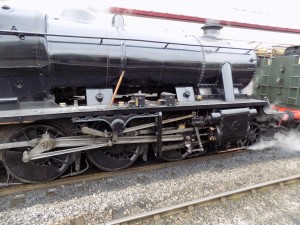 No doubt David will tell me this is the wrong type of 8F, as it was built by the Southern Railway, has a smooth tender, and does not seem to have worked in the NW. However, I imagine that the cabs were pretty standard wherever they were built. I look forward to seeing the details of the cab windows, and even the wooden frame visible in the photo! There was also a Bulleid pacific running at the gala. The tender is just visible in the above photo, but I didn’t let that intruder spoil my day. The weather was what they call typical Gala weather, ie. overcast and threatening rain, which didn’t help when taking photos of largely black locos, but I enjoyed my time at the railway.
No doubt David will tell me this is the wrong type of 8F, as it was built by the Southern Railway, has a smooth tender, and does not seem to have worked in the NW. However, I imagine that the cabs were pretty standard wherever they were built. I look forward to seeing the details of the cab windows, and even the wooden frame visible in the photo! There was also a Bulleid pacific running at the gala. The tender is just visible in the above photo, but I didn’t let that intruder spoil my day. The weather was what they call typical Gala weather, ie. overcast and threatening rain, which didn’t help when taking photos of largely black locos, but I enjoyed my time at the railway.
6th March 2017: signs of spring
I have been getting complaints that I have not updated for a while, so I thought that i would do the traditional signs of spring post. This has to include snowdrops: daffodils:
daffodils:
 and little lambs gambling in the fields, the wicked creatures:
and little lambs gambling in the fields, the wicked creatures:
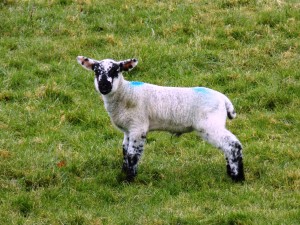 All in all, enough to satisfy Mum’s signs of spring test. In truth, it is still cold and wet, which will be a surprise to David, no doubt. However, the steam specials along the Cumbrian coast have started again:
All in all, enough to satisfy Mum’s signs of spring test. In truth, it is still cold and wet, which will be a surprise to David, no doubt. However, the steam specials along the Cumbrian coast have started again:
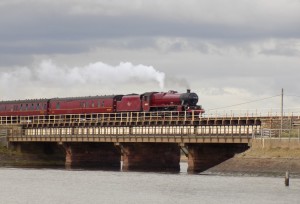 This is Jubilee class 45699 Galatea crossing the viaduct at Ravenglass. A sight to cheer up any rainy day. Also, the clouds provide some dramatic sunsets, like this one taken from Flookburgh:
This is Jubilee class 45699 Galatea crossing the viaduct at Ravenglass. A sight to cheer up any rainy day. Also, the clouds provide some dramatic sunsets, like this one taken from Flookburgh:
 The new camera is still giving me much pleasure, and the zoom allows me to take pictures on the moon in the weak spring sunshine:
The new camera is still giving me much pleasure, and the zoom allows me to take pictures on the moon in the weak spring sunshine:
 All of which provides me with enough entertainment in these cold months. Anyway, wouldn’t it be boring if the weather was always the same?
All of which provides me with enough entertainment in these cold months. Anyway, wouldn’t it be boring if the weather was always the same?
Whilst Mark is using his blog to write lengthy essays, I thought I would use mine to share some of my recent photos of the Lakes in Winter, such as this one of the Old Man of Coniston from near Cark:
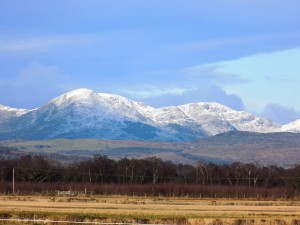 I have been quite lucky, having enjoyed a few brighter days at weekends to balance the wet and miserable ones, and I have tried to take advantage of them. Mark gave me a new camera as a Christmas present, and among other advantages, it has a good zoom, which I used on the above photo. The next picture is of the north end of Coniston from Parkamor:
I have been quite lucky, having enjoyed a few brighter days at weekends to balance the wet and miserable ones, and I have tried to take advantage of them. Mark gave me a new camera as a Christmas present, and among other advantages, it has a good zoom, which I used on the above photo. The next picture is of the north end of Coniston from Parkamor:
 The low evening light provides dramatic shadows and shows the colours up nicely, as is also shown in the next photo of Black Combe from Silecroft:
The low evening light provides dramatic shadows and shows the colours up nicely, as is also shown in the next photo of Black Combe from Silecroft:
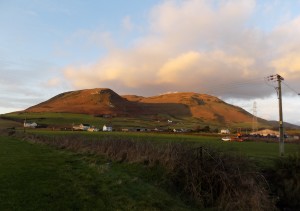 Black Combe is not a particularly dramatic mountain, but the evening light brings out its colour very well. Last weekend, I went to Wastwater, and took the next photo of snow on the mountains beyond:
Black Combe is not a particularly dramatic mountain, but the evening light brings out its colour very well. Last weekend, I went to Wastwater, and took the next photo of snow on the mountains beyond:
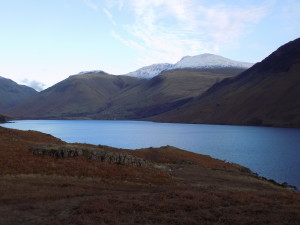 Wastwater always looks dramatic in a gloomy way. It still feels rather remote, as you drive the narrow windy roads approaching it. Mark is right about one thing at least, in that it has been very foggy at times, allowing some interesting pictures of trees in the mist:
Wastwater always looks dramatic in a gloomy way. It still feels rather remote, as you drive the narrow windy roads approaching it. Mark is right about one thing at least, in that it has been very foggy at times, allowing some interesting pictures of trees in the mist:
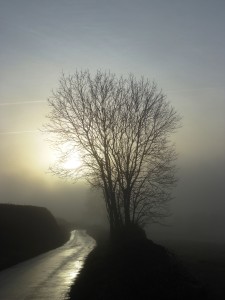 This is at Birkby, on the walk from Cartmel to Cark, just as the sun threatened to break through. It wouldn’t be a proper blog by me unless steam engines were involved. The Winter Cumbrian Mountain Express has started again, and I went to see Jubilee class 45690 “Leander” at Carnforth, ready to haul the first one northwards:
This is at Birkby, on the walk from Cartmel to Cark, just as the sun threatened to break through. It wouldn’t be a proper blog by me unless steam engines were involved. The Winter Cumbrian Mountain Express has started again, and I went to see Jubilee class 45690 “Leander” at Carnforth, ready to haul the first one northwards:
 Again, the zoom on the camera has been useful, though it does highlight slightly worrying deviations in the track as well! The last photo is taken a week later at Silecroft station, with Royal Scot 46115 “Scots Guardsman” heading south:
Again, the zoom on the camera has been useful, though it does highlight slightly worrying deviations in the track as well! The last photo is taken a week later at Silecroft station, with Royal Scot 46115 “Scots Guardsman” heading south:
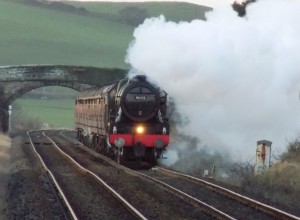 They seem to be scheduling several steam hauled regular services on the Settle to Carlisle line in February and March, so I might go and see them as well, though they seem to be using LNER locos for it rather than LMS, which is a shame. If I manage to see them, I will put photos up here on my blog, as well as any of other steam specials in the North West.
They seem to be scheduling several steam hauled regular services on the Settle to Carlisle line in February and March, so I might go and see them as well, though they seem to be using LNER locos for it rather than LMS, which is a shame. If I manage to see them, I will put photos up here on my blog, as well as any of other steam specials in the North West.
I have just driven back to Manchester from Oxted, after spending almost two weeks staying with Mark, and enjoying our usual past-times, such as this as a highlight of the festive season:
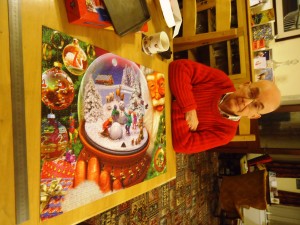 a friend of Mark’s gave him this 1,000 piece jigsaw, and we applied ourselves and finished it in three days.
a friend of Mark’s gave him this 1,000 piece jigsaw, and we applied ourselves and finished it in three days.
Actually, I also went into London a few times and saw a number of interesting exhibitions as well, such as the Picasso portraits, one on Caravaggio and artists he influenced, and the Robert Rauschenberg exhibition at the Tate Modern, which I was pleasantly surprised by. When I was at the Tate, I also visited their 10th floor viewing platform, which has been controversial in that it overlooks a nearby block of flats. But it also provides good views over central London, such as this, looking towards the Shard:
 and also this view of St.Pauls:
and also this view of St.Pauls:
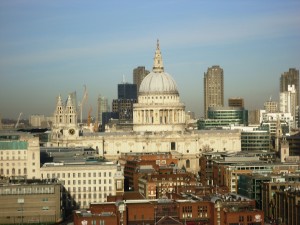 Mark kept up a good supply of food and beer, and we saw an good production of a play in Stratford as well, so all in all, and very enjoyable holiday!
Mark kept up a good supply of food and beer, and we saw an good production of a play in Stratford as well, so all in all, and very enjoyable holiday!
7th November 2016: Bonfire Night
Mark and I were up in the Lakes last weekend, and we noticed that there was a bonfire and fireworks display on Cartmel racecourse on the 5th, which was a saturday this year. Neither of us have been to a bonfire night for a long time, so we drove to Cartmel and joined a large crowd around a bonfire near the car park at the racecourse.
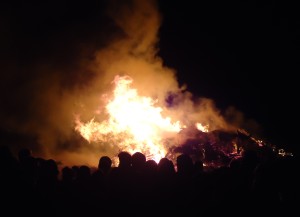 It was a cold clear night and a cold wind was blowing, but the crowd seemed entertained enough just watching the bonfire burning up for a while. It made me think that this event has been going on nationally since 1605, which must make it one of the longest surviving public events in the history of this country. There are probably local events that could match it, but not ones celebrated all over the country. The anti catholic sentiments are mostly forgotten these days, and people are probably only vaguely aware of the actual history of the gunpowder plot, but everyone still enjoys a bonfire and fireworks. The firework display last weekend was very good:
It was a cold clear night and a cold wind was blowing, but the crowd seemed entertained enough just watching the bonfire burning up for a while. It made me think that this event has been going on nationally since 1605, which must make it one of the longest surviving public events in the history of this country. There are probably local events that could match it, but not ones celebrated all over the country. The anti catholic sentiments are mostly forgotten these days, and people are probably only vaguely aware of the actual history of the gunpowder plot, but everyone still enjoys a bonfire and fireworks. The firework display last weekend was very good:
 It was not easy to take a photo of it, and as Mark pointed out, it was better to watch it than worry about photos, but the above is my best effort. We reminisced about firework displays in Grandma’s garden in Banks and in the back garden in Woolton, and the treacle toffee that Mum made the had to be broken up with a chisel into shards, which could cut the inside of your mouth if you were not careful, and also were a high risk for pulling out any fillings in your teeth. No health and safety to ruin your enjoyment in those days! We had some difficulty getting to our car and driving home, as there were hundreds of cars parked all over Cartmel, and everyone was trying to leave at once, but it was an enjoyable, if cold, night’s entertainment.
It was not easy to take a photo of it, and as Mark pointed out, it was better to watch it than worry about photos, but the above is my best effort. We reminisced about firework displays in Grandma’s garden in Banks and in the back garden in Woolton, and the treacle toffee that Mum made the had to be broken up with a chisel into shards, which could cut the inside of your mouth if you were not careful, and also were a high risk for pulling out any fillings in your teeth. No health and safety to ruin your enjoyment in those days! We had some difficulty getting to our car and driving home, as there were hundreds of cars parked all over Cartmel, and everyone was trying to leave at once, but it was an enjoyable, if cold, night’s entertainment.
18th September 2016: live steam in Urmston Abbotsfield Park
David found a video online of a 5 inch gauge model of the “William Francis” industrial Garratt running in a park in Trafford, so today after another gentle reminder, I went to find it. It is not far from Trafford Hospital, so it is quite easy to find. The Urmston & District Model Engineering Society have a 670 metre raised running loop in Abbotsfield Park, and offers rides to visitors to the park. Unfortunately, today there was no industrial garratt running, but there were four steam engines and one diesel operating. The steam engines were a Great Eastern tank engine:
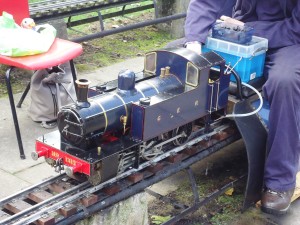 A Great Western style tank engine:
A Great Western style tank engine:
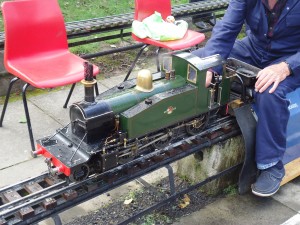 A Robinson class O4 2-8-0 in BR livery:
A Robinson class O4 2-8-0 in BR livery:
 And best of all, a Stanier Black 5 4-6-0:
And best of all, a Stanier Black 5 4-6-0:
 All of these locos were pretty powerful, and able to pull two carriages with up to six people in total on them around the loop with little difficulty. What David would have liked is seeing the drivers opening the little fire grate doors and using a little shovel to scoop small pieces of coal from the bunker or tender into the firebox. The shovel and pieces of coal were wildly out of scale, but that is the attraction of a live steam garden railway!
All of these locos were pretty powerful, and able to pull two carriages with up to six people in total on them around the loop with little difficulty. What David would have liked is seeing the drivers opening the little fire grate doors and using a little shovel to scoop small pieces of coal from the bunker or tender into the firebox. The shovel and pieces of coal were wildly out of scale, but that is the attraction of a live steam garden railway!
22nd August 2016: natural sculptures
I have been exploring recently the area around Farleton Fell, Holmepark Fell and Hutton Roof. These are part of the limestone outcrops that run roughly north-south on the eastern side of Cumbria. They are not very high, but provide good examples of limestone pavements such as below:
 They also provide sculpted craggy outcrops such as this:
They also provide sculpted craggy outcrops such as this:
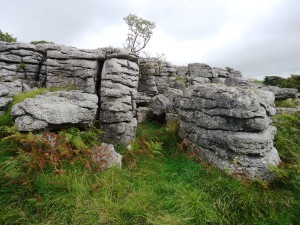 The natural carving of the rock by the water and wind makes interesting and unusual shapes-natural sculptures. Also, on Holmepark Fell there are limestone boulders perched on top of other limestone outcrops as if put there deliberately, such as this:
The natural carving of the rock by the water and wind makes interesting and unusual shapes-natural sculptures. Also, on Holmepark Fell there are limestone boulders perched on top of other limestone outcrops as if put there deliberately, such as this:
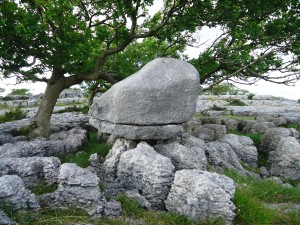 Or a harder piece of rock being gradually undermined as the softer rock underneath erodes, causing a table like effect:
Or a harder piece of rock being gradually undermined as the softer rock underneath erodes, causing a table like effect:
 It makes for an interesting and intriguing landscape well worth exploring, though it is not always easy to get to, or walk over the shale and large deep cracks in the limestone.
It makes for an interesting and intriguing landscape well worth exploring, though it is not always easy to get to, or walk over the shale and large deep cracks in the limestone.
19th July 2016: the last remaining Co-Bo
I went to the diesel gala at the East Lancashire Railway earlier this month. Apart from all the locos running on the line, they had the last remaining Metro-Vick Co-Bo on display in Bury Station, and I got to see it, and look inside the body shell, and sit in the drivers seat:
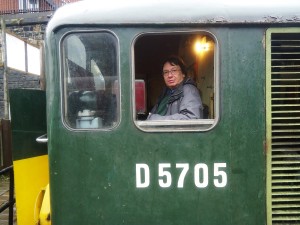 The loco is in the process of being restored, and has a long way to go before it will run again, as it lacks an engine and the body shell is unrestored. The Co-Bo has a chequered history as part of the first generation of diesels bought by BR from various manufacturers without much idea of how successful they would be in service. The Co-Bo is unusual in having a different number of wheels in its two bogies, four in one and six in the other. I have never really found a good explanation for this, but it made the class unique in British railway history.
The loco is in the process of being restored, and has a long way to go before it will run again, as it lacks an engine and the body shell is unrestored. The Co-Bo has a chequered history as part of the first generation of diesels bought by BR from various manufacturers without much idea of how successful they would be in service. The Co-Bo is unusual in having a different number of wheels in its two bogies, four in one and six in the other. I have never really found a good explanation for this, but it made the class unique in British railway history.
For a brief moment, the class seemed part of the new modernized efficient railway, and were painted by Terence Cuneo operating an express freight, replacing the dirty inefficient steam engines. Unfortunately, they proved to be unreliable, and were quickly relegated to the Cumbrian coast line, operating in pairs in case one broke down! The final irony was they were scrapped before the steam locos they were meant to replace! Luckily, one avoided being scrapped, being used as a dead load at Derby, and survived into preservation. Hopefully before too long, we will be able to see it run again.
David’s annual visit to the UK was to a conference in Manchester this year, so he divided his time between Manchester, Cark and London. We had a very nice meal at the Midland Hotel in Manchester, and travelled on a steam special from York to Scarborough. Luckily for us, it was hauled by a Stanier 8F, so Dave could take lots of detailed photos of it for his model 8F in Australia.:
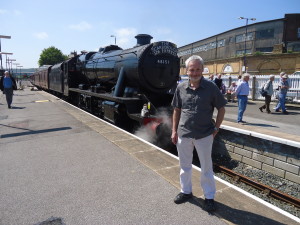 This photo was taken in Scarborough station. Scarborough was an interesting place to visit, with a busy harbour, including a rather silly miniature pirate ship giving tours around the harbour, Ann Bronte’s grave, and a fine castle to explore:
This photo was taken in Scarborough station. Scarborough was an interesting place to visit, with a busy harbour, including a rather silly miniature pirate ship giving tours around the harbour, Ann Bronte’s grave, and a fine castle to explore:
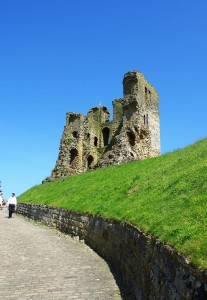 Dave and I also spent a weekend in the Lakes, and we had another very nice meal in the Rogan restaurant in Cartmel. Also, I was persuaded to climb Helvellyn with him. It was hard work, but well worth it in the end. The views from the mountain were very picturesque, such as this one of Thirlmere:
Dave and I also spent a weekend in the Lakes, and we had another very nice meal in the Rogan restaurant in Cartmel. Also, I was persuaded to climb Helvellyn with him. It was hard work, but well worth it in the end. The views from the mountain were very picturesque, such as this one of Thirlmere:
 and a view of Striding Edge and Red Tarn from the summit:
and a view of Striding Edge and Red Tarn from the summit:
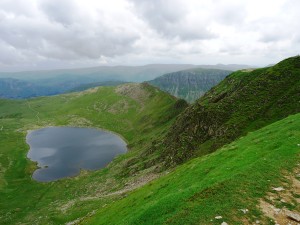 We stopped and had a rest and lunch at the summit, only mildly disturbed by a large and noisy school party that was there at the same time. It was an achievement for us both, though I think we both suffered for it later! We then spent a week in London with Mark, and visited Portsmouth Harbour museum. We visited the HMS Victory:
We stopped and had a rest and lunch at the summit, only mildly disturbed by a large and noisy school party that was there at the same time. It was an achievement for us both, though I think we both suffered for it later! We then spent a week in London with Mark, and visited Portsmouth Harbour museum. We visited the HMS Victory:
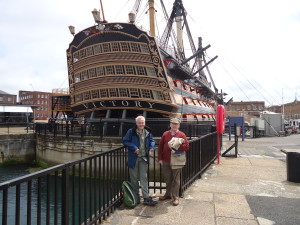 It is difficult to imagine how hard life was for the sailors on board, all crowded in cramped quarters and carrying out dangerous, back breaking work, in very different environment to what visitors see now in the clean and tidy ship in the museum. We also took a trip by boat around the harbour, which was interesting. Unfortunately, the Mary Rose Museum was temporarily closed, so all we saw were a few relics, including the ships bell:
It is difficult to imagine how hard life was for the sailors on board, all crowded in cramped quarters and carrying out dangerous, back breaking work, in very different environment to what visitors see now in the clean and tidy ship in the museum. We also took a trip by boat around the harbour, which was interesting. Unfortunately, the Mary Rose Museum was temporarily closed, so all we saw were a few relics, including the ships bell:
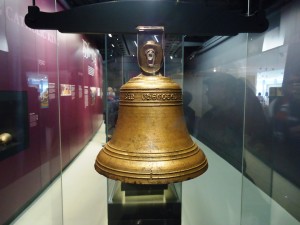 It is amazing how much of the Mary Rose still survives, and the large number of artifacts for everyday life on board have been found, such as plates and mugs, and other similar objects. Luckily, the tickets are valid for a year, so we will have to go back and visit again, as there were a lot of other things we didn’t get to see as well.
It is amazing how much of the Mary Rose still survives, and the large number of artifacts for everyday life on board have been found, such as plates and mugs, and other similar objects. Luckily, the tickets are valid for a year, so we will have to go back and visit again, as there were a lot of other things we didn’t get to see as well.
10th May 2016: visit to Shildon
Earlier this month, Mark and I drove up to Shildon near Darlington to visit the other National Railway Museum site. It is on the site of a large goods yard, and only a short distance from where Shildon Works was. This is a view of the yard outside the museum:
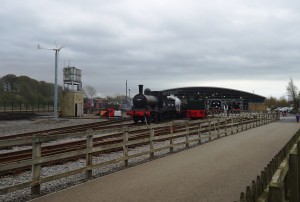 The yard also contained an unrestored J21, and a Bulleid pacific “Winston Churchill”, Gresley V2 “Green Arrow” and the LNWR G2 49395:
The yard also contained an unrestored J21, and a Bulleid pacific “Winston Churchill”, Gresley V2 “Green Arrow” and the LNWR G2 49395:
 In fact, for a museum in the heartlands of the LNER, the museum contains 3 of the 4 remaining LNWR locos, with “Hardwicke” and “Cornwall” also on display. The shed in the background of both the above photos contains a large collection of locos, including the NER steeple cab electric loco, as below:
In fact, for a museum in the heartlands of the LNER, the museum contains 3 of the 4 remaining LNWR locos, with “Hardwicke” and “Cornwall” also on display. The shed in the background of both the above photos contains a large collection of locos, including the NER steeple cab electric loco, as below:
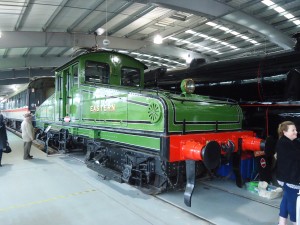 There is a wide variety of locos in the shed, including the prototype Deltic, an APT, a Black 5, and also shunting engines such as an industrial fireless loco. Outside the shed, there is a running track towards the old works, and the museum runs guards van trains up and down it to an old goods shed and past Hackworth’s beam engine house which was part of his Soho works. The engine running on this line when we were there was Furness Railway number 20:
There is a wide variety of locos in the shed, including the prototype Deltic, an APT, a Black 5, and also shunting engines such as an industrial fireless loco. Outside the shed, there is a running track towards the old works, and the museum runs guards van trains up and down it to an old goods shed and past Hackworth’s beam engine house which was part of his Soho works. The engine running on this line when we were there was Furness Railway number 20:
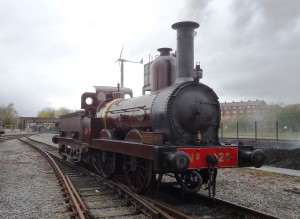 It was good to see a steam veteran like this working the line. I really enjoyed our visit, though I think that Mark was a little bit disappointed that it was mostly locos and rolling stock, and not much other railwayana of interest such as maps, timetables, and station furniture such as departure boards.
It was good to see a steam veteran like this working the line. I really enjoyed our visit, though I think that Mark was a little bit disappointed that it was mostly locos and rolling stock, and not much other railwayana of interest such as maps, timetables, and station furniture such as departure boards.
21st March 2016: snow on Cumbrian hills
There is still quite a lot of snow on the higher hills in Cumbria- not really surprising, as the weather is still distinctly wintery. I drove to see the Castlerigg stone circle near Keswick, and enjoyed the views of the ring of mountains around the circle, including this view of the Helvellyn range:
Another weekend, when it was a brighter day, with the sun breaking through the clouds every now and then, I drove over Corney fell, and took a photo looking south east towards the Duddon valley and Ulpha:
Also on Corney fell, this is looking north east towards Dunnerdale:
Views that make a trip up the narrow fell roads worthwhile.
24th January 2016: snow on the Old Man of Coniston
 The weather has been cold and wet recently, which is no surprise, so I have not had much of a chance to get out and about. However, last weekend, there was a brief period in the morning when there was a little sunshine, and so I decided to go and see an old favourite- Coniston Old Man. The snow had largely melted in the valleys, but the mountains were still snow covered. The photo above is from the east side of the lake, near a steamer jetty, and the one below is from near Brantwood, with Coniston village between the mountain and the lake:
The weather has been cold and wet recently, which is no surprise, so I have not had much of a chance to get out and about. However, last weekend, there was a brief period in the morning when there was a little sunshine, and so I decided to go and see an old favourite- Coniston Old Man. The snow had largely melted in the valleys, but the mountains were still snow covered. The photo above is from the east side of the lake, near a steamer jetty, and the one below is from near Brantwood, with Coniston village between the mountain and the lake:
This seemed well worth an expedition in the cold and wet, and is a view that I never get tired of, however many times I see it.
7th December 2015: flooding in south Cumbria
I was in Cark last weekend when the torrential rain, high winds and flooding took place. Where I was has not been as badly affected as other parts of Cumbria, but it was still unpleasant on Saturday, when the worst weather was occurring. I have included some photos here to contrast places around the Cartmel peninsula earlier this year and after the storm. Firstly, here is a view of the river Eea looking towards Cark in Summer:
 And this is the same view last weekend, with the river bursting over its banks:
And this is the same view last weekend, with the river bursting over its banks:
 Also, this is the bridge over the River Leven at Haverthwaite in Summer:
Also, this is the bridge over the River Leven at Haverthwaite in Summer:
And this is the same view this weekend:
As far as I know, no houses were flooded nearby, though the field to the north of this bridge was flooded, and the water nearly reached the cricket ground at Haverthwaite. In Cark, the cottages next to the river seemed to have escaped flooding, but it must have been a worrying time for the owners.
28th September 2015: industrial espionage in Cark
I have recently discovered that there was a cotton mill in Cark Village. It was a fairly substantial building, especially as Cark is not a big place to start with. The image that I have found of it is below:
The mill was built in 1785, and destroyed by fire in 1935. It had changed its use to being a corn mill in 1816 after being put up for sale in 1811 and bought by a local farmer. At the height of its use as a cotton mill in 1790, it had 400 employees and contained 3,400 spindles. There are a couple of points of interest that I have discovered. Firstly, it was powered by a Boulton and Watt steam engine from 1786, which makes it an early user of this power. The industrial espionage arose when the mill owning family, the Stockdales, were persuaded to purchase a rival and cheaper steam engine. At the time, Boulton and Watt had the patent on the most advanced condensing steam engines, and had a lot of problems with other manufacturers undercutting their costs with cheaper illegal versions of their engines. An apprentice of Boulton and Watt named Lawson worked as a detective gathering evidence of this patent breaking, and he visited Cark in 1796 and stayed at the Engine pub, which still exists. He managed to grease a few palms of the engine operators and saw the engine, and proved it was not a Boulton and Watt engine. A letter that Lawson wrote to Boulton survives, and describes a series of increasingly farcical scenes where the Mill owner realised what Lawson was up to, and confronted him at the Engine, trying to get him to say what he had discovered. Lawson’s job was made more difficult by the Stockdales being friends of Boulton and Watt. A lot of drinking was involved, and Lawson’s attempts to escape to Ulverston the next morning were scuppered by a high tide, so he had to test his diplomatic skills in further meetings with Mr.Stockdale. In the end, Mr.Stockdale himself confessed to his guilt at purchasing a non patent engine. Boulton and Watt were successful eventually in their legal action, but remained close to the Stockdales, even joining their families through a marriage in Cartmel parish church.
Another point of interest is that the Cark Mill produced its own silver token money overstruck on Spanish silver dollars, used to pay workers and local tradesmen. and an example is below:
It looks very nice and pleasant now, and it is hard to imagine a large mill standing next to them, as it is to imagine the works at Haverthwaite and Backbarrow a short distance north. I have also found out that there was a paper mill at Cark from 1617 to at least the 1820’s, so at one time, this area must have been a hive of industries of various kinds.
1st September 2015: centenary of the Ravenglass and Eskdale Railway
Over the August bank holiday, the Ravenglass and Eskdale Railway has been celebrating 100 years of operating as a 15 inch gauge railway. It was opened as a 3 foot gauge line in 1875, and after closure of the line was purchased in 1915 by Bassett Lowke to test run their locos and converted to 15 inch gauge. One of the first locos to operate on the line was a Bassett Lowke class 30 Atlantic named ‘Sans Pareil’. This loco was withdrawn from traffic in the 1920s, and dismantled. An almost identical class 30 loco called ‘Synolda’ was built in 1912 by Bassett Lowke and ran in various places, including Manchester Belle Vue from the 1940’s until the 1970’s. The R&ER purchased and restored the loco to running condition between 1978 and 1980. The photo below shows ‘Synolda’ on the turntable at Ravenglass station.
‘Synolda’ is usually kept in the museum, but is steamed at special occasions like this. The R&ER was reopened in stages after 1915, firstly between Ravenglass and Muncaster, and then extended towards Dalegarth. This weekend, ‘Synolda’ and another Bassett Lowke class 30 Atlantic were running a shuttle service between Ravenglass and Muncaster Mill to mark the initial opening of the line. ‘Synolda’ is not as powerful as the other steam locos on the line, and cannot manage a train of more than eight carriages all the way to Dalegarth!
The other loco is named ‘Count Louis’, after Count Louis Zborowski, a Polish racing driver and automobile engineer, and also a railway enthusiast, who bought the loco for a railway on his estate in Kent in 1924. ‘Count Louis’ is pictured above at Muncaster Mill Station. Unlike most of the steam locos on the R&ER, these two seem to me to be very close in looks to a standard gauge design, in this case the Ivatt class C1 Atlantics that were express locos on the East Coast line in the early 20th century. They are handsome locos, and it is good to see them running.
6th August 2015 8Fs under water
As David’s blog is concerned with his model 8F, I thought that I would make a variation on the theme. I found these photos online, but I had heard of this strange vision before:
 An 8F under water. The explanation is that this loco was being sent to the Egypt in 1941 to help the war effort on the cargo ship S.S. Thistlegorm, when it was bombed and sunk by a German aircraft in the Gulf of Jubal. A direct hit on the 8F wrecked the boiler and threw the rest of the loco overboard as the ammunition on the ship exploded and the ship sank, and somehow the front end of the loco landed upright on the seabed.
An 8F under water. The explanation is that this loco was being sent to the Egypt in 1941 to help the war effort on the cargo ship S.S. Thistlegorm, when it was bombed and sunk by a German aircraft in the Gulf of Jubal. A direct hit on the 8F wrecked the boiler and threw the rest of the loco overboard as the ammunition on the ship exploded and the ship sank, and somehow the front end of the loco landed upright on the seabed.
 The front of the frames, cylinder, wheel, and smokebox are still identifiable, and the Stanier tender that is still on the wreck of the ship is also easily recognisable:
The front of the frames, cylinder, wheel, and smokebox are still identifiable, and the Stanier tender that is still on the wreck of the ship is also easily recognisable:
I’m not sure they would be much help to David in his modelling though! Around two dozen 8Fs were lost at sea during the Second World War en route to North Africa. If you put ‘underwater steam train wreck’ into You Tube, there are videos of divers exploring the wreck, its military cargo such as motorbikes and trucks, and the railway materials still visible on deck and in the hold. The wreck is also a war grave, as a number of sailors were killed during the sinking.
22nd July 2015 the ingleton branch line
Mark and I have visited Sedburgh in the east of Cumbria a number of times, mainly because of the very good second hand bookshops there, and the nice walks around the countryside. On one of these walks, we passed by the old railway bridge over the River Rowthey south west of Sedburgh on the Clapham to Tebay line, closed in 1967:
I was intrigued by this, and decided to explore the line in more detail. There are four bridges still in existence on this line. I found out that there is another large bridge north of Sedburgh at Waterside:
These two bridges near Sedburgh are quite similar in construction, though the second is a larger structure, as both have cast iron central sections. The best known of the three bridges in this area is at Low Gill, which is a longer, higher bridge, near the junction at Tebay, and much photographed in the steam era:
 There are three major bridges in less than six miles of the line, and the whole line is a symbol of the bitter rivalry between the Midland and the London North Western Railway Companies. The line was part of the Midland’s attempts to build a line to the north, and the LNWR tried to block them by refusing to allow joint working on their lines. This rivalry often went to what now seems ludicrous extremes, such as both companies building a station a mile apart at Ingleton, as they couldn’t agree to joint use of one station. The Ingleton line quickly became a secondary route to the Settle and Carlisle line, only used by expresses as a relief route north when other lines were not available. It is astonishing to think of the money the railway companies wasted building these duplicate routes at great expense, with all the large bridges, embankments and other building works. The current owners of these bridges must still curse them for the continued expense of maintaining the bridges to this day, even if trains have not run over them for nearly fifty years.
There are three major bridges in less than six miles of the line, and the whole line is a symbol of the bitter rivalry between the Midland and the London North Western Railway Companies. The line was part of the Midland’s attempts to build a line to the north, and the LNWR tried to block them by refusing to allow joint working on their lines. This rivalry often went to what now seems ludicrous extremes, such as both companies building a station a mile apart at Ingleton, as they couldn’t agree to joint use of one station. The Ingleton line quickly became a secondary route to the Settle and Carlisle line, only used by expresses as a relief route north when other lines were not available. It is astonishing to think of the money the railway companies wasted building these duplicate routes at great expense, with all the large bridges, embankments and other building works. The current owners of these bridges must still curse them for the continued expense of maintaining the bridges to this day, even if trains have not run over them for nearly fifty years.
23rd June 2015: Ancient Churches in the Modern City of London
Whilst staying with Mark recently, I decided to explore the historical buildings around the city of London, including the monument to the great fire, and the churches in the area. One very interesting church is St.Magnus the Martyr
It is not a big church, and nowadays seems to be dwarfed by the other buildings around it,but there is a lot of interesting things about it. It was on the city end of the old London bridge, and there has been a church on this site since the 12th century. The current church was designed by Christopher Wren after the church was burned down in the great fire. The Monument to the fire is a short distance away from it, and you get a good view of the church and its environs from the top of the monument:
The original bridge would be on the line of the church tower. The road to the bridge passed to the right of the church in this view, and the church clock hung over the bridge road. Two stones of the old bridge sit in the church yard, and there is a plaque commemorating the bridge:
 The porch of the church was incorporated into the bridge approaches, which help indicate how narrow the bridge really was. and makes you wonder why they waited so long to replace it:
The porch of the church was incorporated into the bridge approaches, which help indicate how narrow the bridge really was. and makes you wonder why they waited so long to replace it:
 There is a model of the old bridge in the church which is very interesting:
There is a model of the old bridge in the church which is very interesting:
 and the interior of the church is interesting as well, cluttered and ornate with diagonally arranged pews:
and the interior of the church is interesting as well, cluttered and ornate with diagonally arranged pews:
The church has survived German bombing that devastated the area around it, various fires, and threatened redevelopment in the 20th century to remain a little fragment of London’s history in the middle of the city. It is part of the fascination of London that you can find the old and new next door to each other, or like St.Magnus and the Shard, just across the river from each other.
1st June 2015: Holiday in Paris
David attended a cardiology conference in Paris in May, and kindly invited his brothers to stay with him in the apartment he rented. Mark and I spent a week with him in Paris, and we really enjoyed ourselves. We visited all the usual tourist hot spots, such as Notre Dame and the Louvre, and we went for a cruise on the Seine:
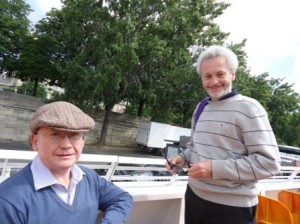 We also visited a lot of museums and galleries. In the Louvre, we tried to avoid the obvious hotspots, and enjoyed the paintings, the large collection of Greek pottery and the large Persian statuary:
We also visited a lot of museums and galleries. In the Louvre, we tried to avoid the obvious hotspots, and enjoyed the paintings, the large collection of Greek pottery and the large Persian statuary:
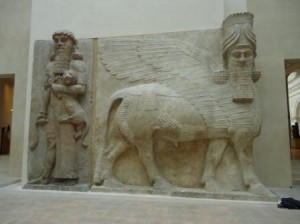 in the Musee de Carnevale we admired the collection of Parisian signs such as this one for a Black Cat night spot in the nineteenth century:
in the Musee de Carnevale we admired the collection of Parisian signs such as this one for a Black Cat night spot in the nineteenth century:
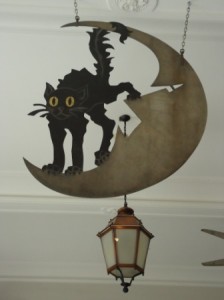 And also other strange artifacts such as this 3rd century ring gourd:
And also other strange artifacts such as this 3rd century ring gourd:
We also saw a large and structurally intact Roman bath-house in the Musee de Cluny:
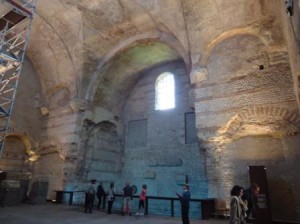 And last but not least, a large number of paintings in the Louvre, Musee d’Orsay, and Musee de l’Orangerie, which has specially built rooms to house some of my favourite paintings, Monets Waterlilies:
And last but not least, a large number of paintings in the Louvre, Musee d’Orsay, and Musee de l’Orangerie, which has specially built rooms to house some of my favourite paintings, Monets Waterlilies:
28th March 2015: Solar Eclipse over the UK
On 20th March, there was a solar eclipse over the UK, or at least the northern part of the UK. The further north that you were, the more complete the eclipse was. These are photos taken by another person working at Prestwich:
The photos were taken on a phone camera, so are not of brilliant quality, but give a good impression of the event. Luckily, the cloud cover relented long enough to see this much anyway.
The next full eclipse is not expected until 2025, so this is a fairly uncommon event and worth noting, especially as this time it was clearly visible.
13th March 2015:Changes to Liverpool Central Library
I traveled to Liverpool for the first time for a while today, and visited the Central Library for the first time since it was refurbished. It is an impressive sight. This is what you see after walking into the building:
It is quite difficult to capture the spiral pattern to the design with a camera, but it looks very impressive and modern, with lots of space and light. It is very different from the old design, which was equally impressive but in a very old fashioned and much darker design. The Picton reading room has been preserved much as it was:
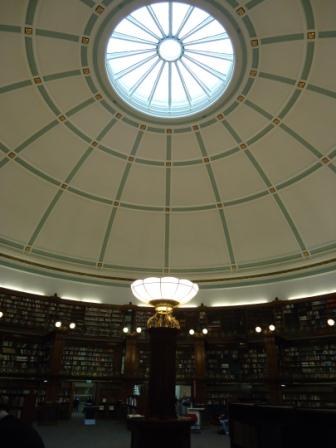 but again it seems a lot cleaner and brighter than it was before. It is still as echoey as I remember it being, though! There has been some controversy about the number of volumes of books both Manchester and Liverpool public libraries have got rid of to make space for their redesign, but there is no doubt that both now look much more up to date and ready for users of the current century rather than the early 20th century as before, with multimedia spaces and electronic resources, but also a significant number of books and other older resources.
but again it seems a lot cleaner and brighter than it was before. It is still as echoey as I remember it being, though! There has been some controversy about the number of volumes of books both Manchester and Liverpool public libraries have got rid of to make space for their redesign, but there is no doubt that both now look much more up to date and ready for users of the current century rather than the early 20th century as before, with multimedia spaces and electronic resources, but also a significant number of books and other older resources.
31st January 2015: signs of the apocalypse?
There has been quite heavy snow fall in the North West recently. One night recently, I went outside my house to take photos of it and got these quite spooky results:
out of my front door:
 _: It looks like an apocalyptic view by John Martin, or if you have seen too many horror movies, evidence that a gate to hell has been opened under my garden shed, as someone suggested to me on seeing this photo. I don’t know why the sky is blood red in the photos, as it was a dark slate grey at the time.The flash in my camera may have induced it. Anyway, it created two unexpectedly interesting photos.
_: It looks like an apocalyptic view by John Martin, or if you have seen too many horror movies, evidence that a gate to hell has been opened under my garden shed, as someone suggested to me on seeing this photo. I don’t know why the sky is blood red in the photos, as it was a dark slate grey at the time.The flash in my camera may have induced it. Anyway, it created two unexpectedly interesting photos.
Mark and I walked around Loughrigg Tarn recently, and I took this photo of the Langdale Pikes which I rather liked:
14th December 2014: A funfair in Christmas lights
I was driving in the Lakes last weekend, and noticed a lot of bright lights where there had not been any before, like a funfair had been set up not quite in the middle of nowhere, but on the outskirts of a small village. On closer inspection, it turns out that the owner of a house has set up elaborate Christmas lights on his house, other buildings and garden to resemble a funfair in full swing:
 There are no street lights or other lights nearby, though the village is not far to the right of the photo, so it seemed to be floating in the void like a hallucination. The owners must have spent a lot of time and money creating this illusion, with lights imitating moving rides.
There are no street lights or other lights nearby, though the village is not far to the right of the photo, so it seemed to be floating in the void like a hallucination. The owners must have spent a lot of time and money creating this illusion, with lights imitating moving rides.
30th November 2014: close encounters of the reptilian kind
Mark and I visited a farm shop north of Carnforth recently, as they were supposed to have a Christmas fair on that weekend. The Fair was a bit disappointing, but they also have a large number of animals, birds and other creatures that were much more interesting, including a shire horse, emus, a large white rabbit confusingly called Alice, miniature horses, a peacock, and a number of reptiles:
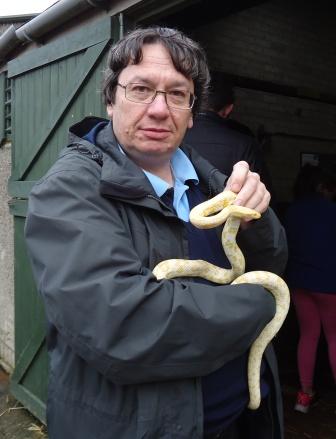 Of course, I didn’t get to cuddle the cute furry animals, like the collie puppies, but only a corn snake, that tried to hide inside my coat,
Of course, I didn’t get to cuddle the cute furry animals, like the collie puppies, but only a corn snake, that tried to hide inside my coat,
 and a large lizard that looked very long suffering, and had sharp claws. Still, it was a new experience for me, and an interesting one.
and a large lizard that looked very long suffering, and had sharp claws. Still, it was a new experience for me, and an interesting one.
26th October 2014: Steamy weekend in Ramsbottom
The East Lancashire Railway had a steam weekend recently, and I went along for a look at the refurbished ‘Crab’ resplendent in crimson lake livery:
There was also an Aspinall Lancashire & Yorkshire Railway 0-6-0 in LMS livery to admire:
 They had got two A4s visiting as well, including “Sir Nigel Gresley”:
They had got two A4s visiting as well, including “Sir Nigel Gresley”:
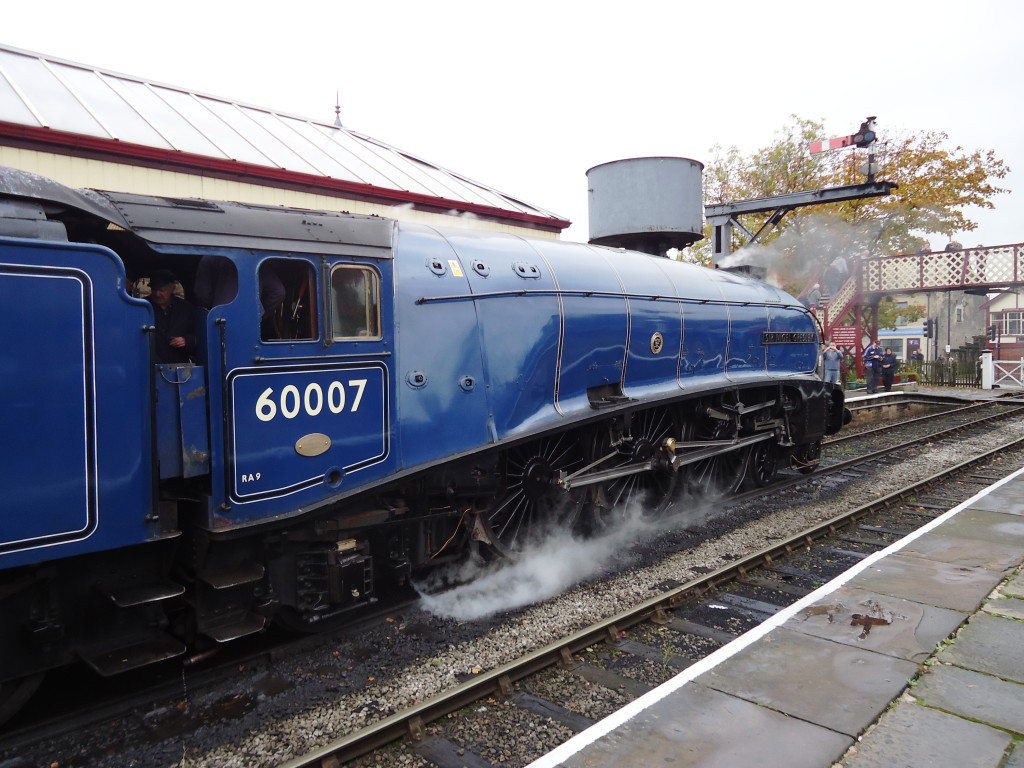 They seemed a little like caged tigers, pacing up and down in a cage, longing to run free. They even had them running tender first, a terrible indignity for an express locomotive.
They seemed a little like caged tigers, pacing up and down in a cage, longing to run free. They even had them running tender first, a terrible indignity for an express locomotive.
Mark and I were in the lakes, visiting Coniston, and we saw Gondola near Brantwood:
Also, in the prosaic surrounds of the supermarket car park in Prestwich, I managed to get this photo of a rainbow:
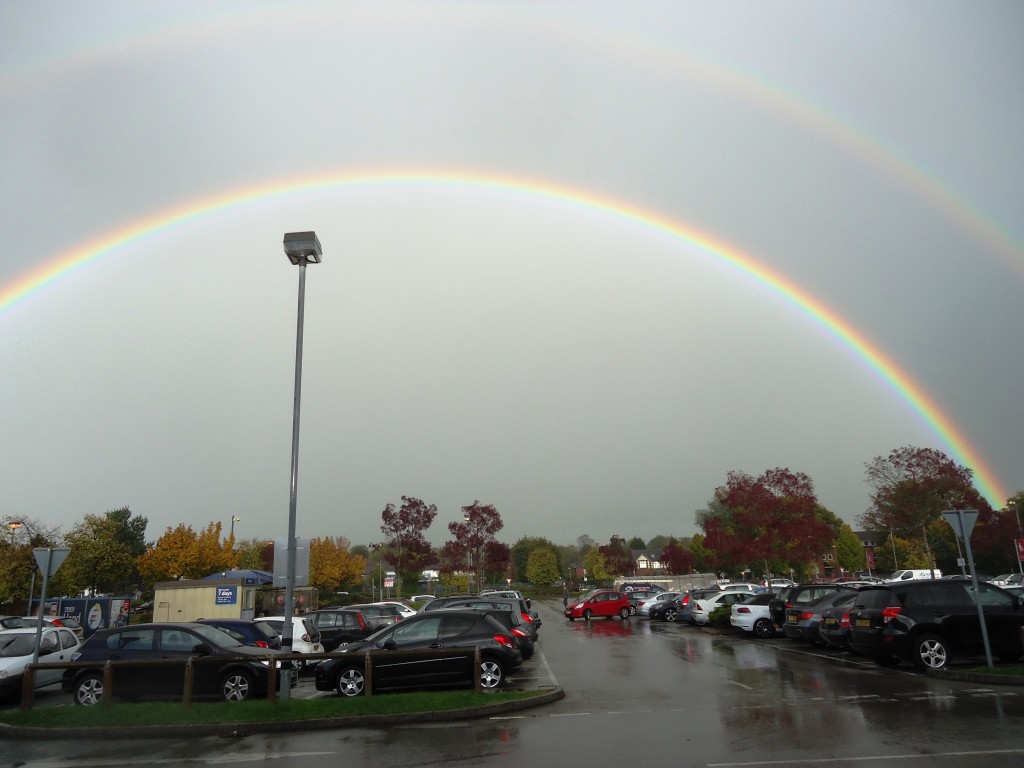 I didn’t manage to find the pot of gold at either end of it, though.
I didn’t manage to find the pot of gold at either end of it, though.
15th September 2014: Mark, David and John in Barcelona
As previously mentioned, David invited Mark and myself to go to Barcelona with him when he went to the conference. So whilst David was in the conference, Mark and I could explore Barcelona. These are some of the photos that I took during our short stay there.
The work of Antoni Gaudi is a major attraction in Barcelona, and for very good reasons. These are two of the chimneys on the roof of the Palau Guell:
There are equally strange chimneys on the apartment block that he designed, the Casa Mila, or La Pedrera. Gaudi didn’t seem to like straight lines, and preferred the the curves and shapes of the natural world.
Then there is his unfinished masterpiece, the Sagrada Familia. I have include two photos of the interior, firstly the ceiling, with the pillars reaching up like tree trunks:
 and also the stained glass windows with Gaudi designs, with light streaming in:
and also the stained glass windows with Gaudi designs, with light streaming in:
 Barcelona has a number of other beautiful buildings and decorations on houses, such as this dragon on a building at the Place de la Boqueria:
Barcelona has a number of other beautiful buildings and decorations on houses, such as this dragon on a building at the Place de la Boqueria:
 and the interior of the Palau de la Musica Catalonia:
and the interior of the Palau de la Musica Catalonia:
 The ornate and colourful style with lots of coloured glass makes it a beautiful building. I just wish we could have seen a concert there. We also explored the older parts of the city, with narrow streets and old buildings such as Carrer del Bisbe Irurita with the bridge of sighs:
The ornate and colourful style with lots of coloured glass makes it a beautiful building. I just wish we could have seen a concert there. We also explored the older parts of the city, with narrow streets and old buildings such as Carrer del Bisbe Irurita with the bridge of sighs:
 Barcelona has the remains of Roman buildings which have been adapted and built on from the medieval period onwards, such as this Chapel of Santa Agata:
Barcelona has the remains of Roman buildings which have been adapted and built on from the medieval period onwards, such as this Chapel of Santa Agata:
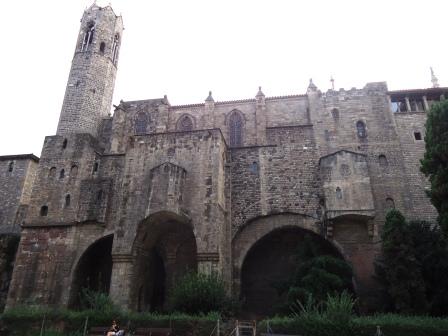 It is all very interesting, and we didn’t have time to do half of what we would have liked. We will have to plan another visit, or wait until David’s conference visits Barcelona again!
It is all very interesting, and we didn’t have time to do half of what we would have liked. We will have to plan another visit, or wait until David’s conference visits Barcelona again!
9th September 2014: David in England
David has been in England, and whilst he was here, it was important that he should remind himself of the best features of the country, such as the beer:
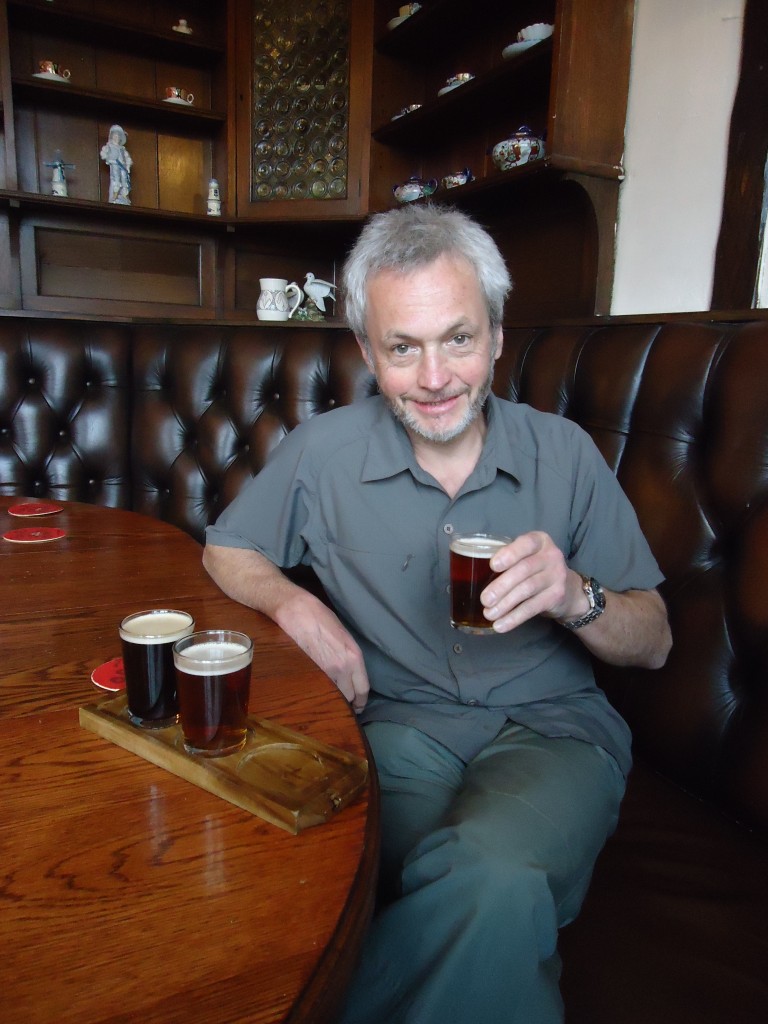 Here he is in the Lord Raglan pub, sampling three one third pints of the local ales. We also went on a trip on the Fellsman train from Lancaster down to Blackburn and then up the Settle to Carlisle line to Carlisle, and then back again on the same route behind this Stanier Black Five loco:
Here he is in the Lord Raglan pub, sampling three one third pints of the local ales. We also went on a trip on the Fellsman train from Lancaster down to Blackburn and then up the Settle to Carlisle line to Carlisle, and then back again on the same route behind this Stanier Black Five loco:
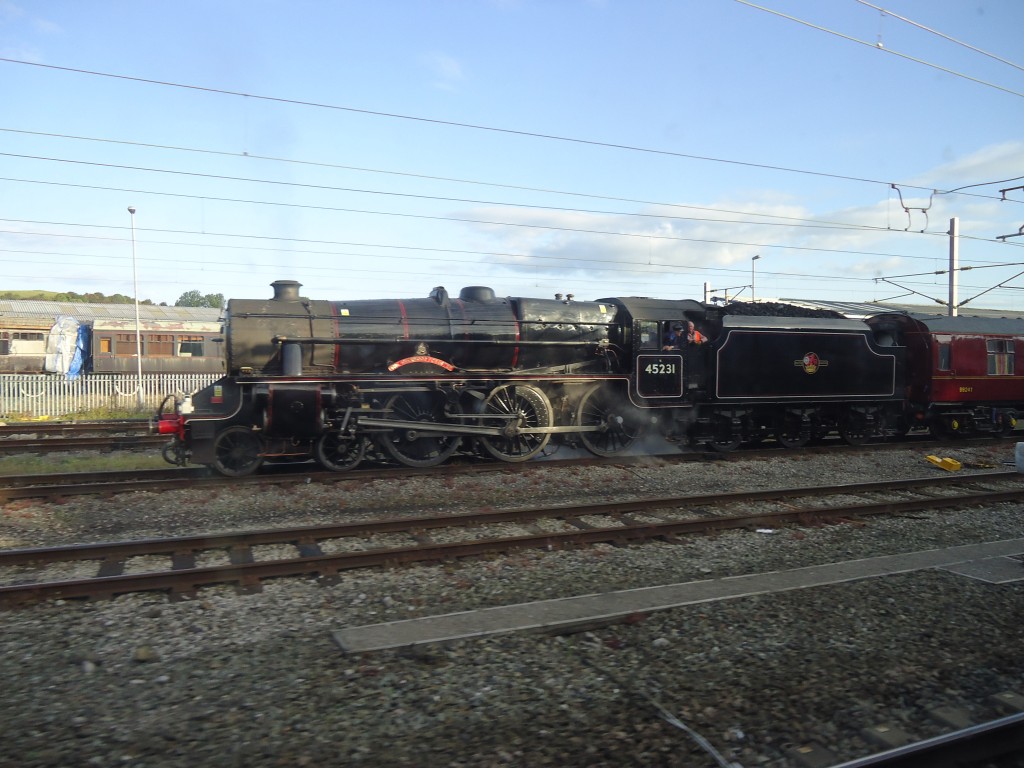 It was a good trip, with the weather sunny and clear, and the rugged landscape of the line shown at its best. There was a diesel helping the steam loco, partly because of new regulations on steam locos being used in dry weather, but the Stanier loco seemed to be working hard, making an impressive racket and scaring the sheep, and kept us to time.David also went to the cardiology conference in Barcelona, and very kindly invited Mark and I to stay with him in the apartment he rented. Mark and I had a very good if rather tiring time in Barcelona admiring the Gaudi architecture and the narrow ancient streets and ancient buildings of the old part of Barcelona. I took a lot of photos which I am still sorting out, so next post will include the best of them.
It was a good trip, with the weather sunny and clear, and the rugged landscape of the line shown at its best. There was a diesel helping the steam loco, partly because of new regulations on steam locos being used in dry weather, but the Stanier loco seemed to be working hard, making an impressive racket and scaring the sheep, and kept us to time.David also went to the cardiology conference in Barcelona, and very kindly invited Mark and I to stay with him in the apartment he rented. Mark and I had a very good if rather tiring time in Barcelona admiring the Gaudi architecture and the narrow ancient streets and ancient buildings of the old part of Barcelona. I took a lot of photos which I am still sorting out, so next post will include the best of them.
8th August 2014: Test Match at Old Trafford
Mark and I have been to watch the first two days of the test match between England and India at Old Trafford this week. The first day was overcast in the morning, with Broad and Anderson producing some fine bowling to reduce India to 8 for 4 at one point, before Ashwin and Dhoni managed to rebuild the innings to some extent.As the day went on it became fine and sunny, with Old Trafford looking good in the sunshine:
 Old Trafford was fairly full, and India fought back in the afternoon to remove Robson and Cook to indifferent shots, though their bowling in general was variable in quality. Ian BelI was playing some lovely shots, including a straight six, and I was enjoying the experience of being at Old Trafford again:
Old Trafford was fairly full, and India fought back in the afternoon to remove Robson and Cook to indifferent shots, though their bowling in general was variable in quality. Ian BelI was playing some lovely shots, including a straight six, and I was enjoying the experience of being at Old Trafford again:
The second day started with some absorbing cricket in the first session, with the balance of play gradually moving in England’s direction. Bell and Moeen Ali were out to two good balls, but Root and Buttler were making steady progress, and England’s lead was extending. Then half an hour into the afternoon session, the heavens opened and it poured down for an hour or so, with people huddling under umbrellas of in covered stands:
 It was a torrential downpour at times, with the other side of the ground obscured by the rain.Hurricane Bertha has been blowing into the UK, and this was her making her mark in the North West.:
It was a torrential downpour at times, with the other side of the ground obscured by the rain.Hurricane Bertha has been blowing into the UK, and this was her making her mark in the North West.:
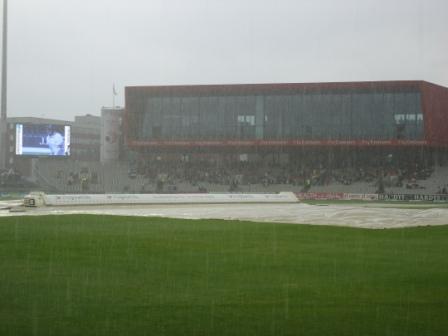 I know this is Manchester, but this was a ridiculous amount of rain. After the rain eventually stopped, the outfield was covered in pools of water, especially near where we were sitting:
I know this is Manchester, but this was a ridiculous amount of rain. After the rain eventually stopped, the outfield was covered in pools of water, especially near where we were sitting:
 The weather then turned sunny for a few hours, and the ground staff worked hard with their machines and brushes to clear the water from the outfield. Unfortunately they were unsuccessful, and play was abandoned for the day at around 5-40. The crowd, who has waited for three hours for play to resume were not happy, but the umpires didn’t have much choice, as parts of the field were muddy and wet. There was some talk of recent building work damaging the drains near where we were, which had caused similar problems in previous matches. Hopefully, they will be able to resume tomorrow, though the weather forecast for the weekend is not brilliant either.
The weather then turned sunny for a few hours, and the ground staff worked hard with their machines and brushes to clear the water from the outfield. Unfortunately they were unsuccessful, and play was abandoned for the day at around 5-40. The crowd, who has waited for three hours for play to resume were not happy, but the umpires didn’t have much choice, as parts of the field were muddy and wet. There was some talk of recent building work damaging the drains near where we were, which had caused similar problems in previous matches. Hopefully, they will be able to resume tomorrow, though the weather forecast for the weekend is not brilliant either.
6th August 2014: Cumbria Steam Gathering, Cark Airfield
I went to the Cumbria steam gathering at Cark Airfield again this year. There was the familiar sight of a parade of the steam powered traction engines, as below:
and also an engine very suitably parked outside ‘The Engine’ pub in Cark- well, it’s thirsty work, keeping the steam up!
There was the usual large number of cars, lorries and any other kind of road vehicle you could think of as well, including a large number of tractors. The cars ranged from an old Model T Ford:
To a few e-type jaguars;
and also a few cars that I had never seen before, such as the Citroen below:
Unfortunately, the weather turned a little wet, so I had to miss the pleasures of the tractor parade. However, the day before was sunny, and I did see this butterfly in the church yard at Muncaster:
15th July 2014: It’s so hot even the blackbirds are sunbathing!
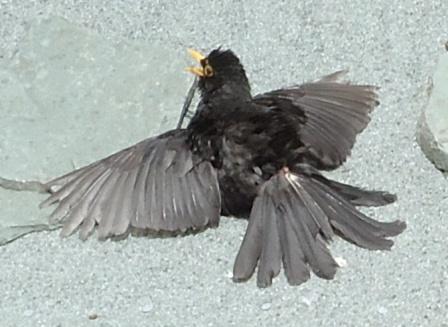
 It was so hot last Sunday that I discovered this blackbird sunning itself on the roof of my garden shed, and took the above photos of it. It must have been nearly 20 degrees Centigrade, boiling hot for England, and the bird looked a little ragged, no doubt from feeding its latest family, so it deserved a little rest.
It was so hot last Sunday that I discovered this blackbird sunning itself on the roof of my garden shed, and took the above photos of it. It must have been nearly 20 degrees Centigrade, boiling hot for England, and the bird looked a little ragged, no doubt from feeding its latest family, so it deserved a little rest.
1st July 2014: cricket and dragonfly in Cumbria
Mark spent a weekend in Cark in June, and we watched some local cricket at Cartmel with the priory as the backdrop, below,
and also watched a match at Coniston, with the Old Man as the backdrop: 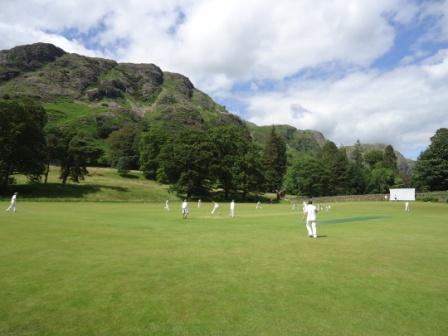
Also, whilst walking to Cartmel, we saw a lovely blue dragonfly in a meadow near Cartmel racecourse: It was a lovely weekend, and we also enjoyed the local beer and cheese!
It was a lovely weekend, and we also enjoyed the local beer and cheese!
25th April 2014: photos at Cark
 ‘Royal Scot’ class 4-6-0 46115 “Scots Guardsman” running through Cark Station towards Grange with the ‘Cumbrian Coast Express’ on 19th April 2014. The first steam engine on this line for a while, for at least as long as we have owned the house in Cark.
‘Royal Scot’ class 4-6-0 46115 “Scots Guardsman” running through Cark Station towards Grange with the ‘Cumbrian Coast Express’ on 19th April 2014. The first steam engine on this line for a while, for at least as long as we have owned the house in Cark.
 Sunrise at Cark earlier this year.
Sunrise at Cark earlier this year.
7th April 2014: Ancient Cumbrian Relics
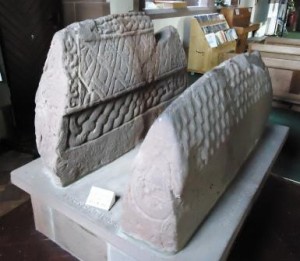 I have been exploring more of the ancient sites of Cumbria, especially on the west coast. The photo above is a couple of Viking grave covers, or hog backs, as they are known, in Gosforth Church. They were found in the church foundations whilst the church was being rebuilt in the nineteenth century. There is also a Viking Cross at Gosforth, pictured below:
I have been exploring more of the ancient sites of Cumbria, especially on the west coast. The photo above is a couple of Viking grave covers, or hog backs, as they are known, in Gosforth Church. They were found in the church foundations whilst the church was being rebuilt in the nineteenth century. There is also a Viking Cross at Gosforth, pictured below:
 The cross has a mix of Norse and Christian imagery carved into it, and was created in around the 9th century . At Irton Church, there is the Saxon Cross pictured below, and as at Gosforth it has been adopted from an older religion to become part of a christian church:
The cross has a mix of Norse and Christian imagery carved into it, and was created in around the 9th century . At Irton Church, there is the Saxon Cross pictured below, and as at Gosforth it has been adopted from an older religion to become part of a christian church:
 Irton Church is fairly large and seems to serve only a small population of farmers. Even now it is pretty remote, with only a rough narrow road leading to it. The remoteness, lack of much in the way of new roads, railways and newer settlements and also the small population of this area must be a large part of the reason why these old crosses have survived so long undisturbed. Less well preserved is the remains of a cross at Waberthwaite, further down the coast, and pictured below:
Irton Church is fairly large and seems to serve only a small population of farmers. Even now it is pretty remote, with only a rough narrow road leading to it. The remoteness, lack of much in the way of new roads, railways and newer settlements and also the small population of this area must be a large part of the reason why these old crosses have survived so long undisturbed. Less well preserved is the remains of a cross at Waberthwaite, further down the coast, and pictured below:
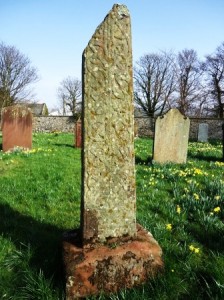 This cross has a more patchy history, with it being used as part of the walls of the church, and another part of the cross as a door lintel. It was discovered again in the nineteenth century, and reinstated in its mount, which had survived. The cross pictured below in Urswick Church had a similar history:
This cross has a more patchy history, with it being used as part of the walls of the church, and another part of the cross as a door lintel. It was discovered again in the nineteenth century, and reinstated in its mount, which had survived. The cross pictured below in Urswick Church had a similar history:
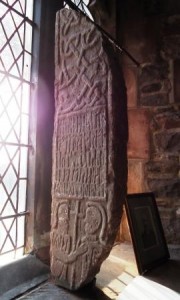 It had been used as part of the church walls, until being rediscovered. However they survived, it is fascinating that these crosses and grave covers have been in or around these churches for over a thousand years, even if it was used as parts of walls,
It had been used as part of the church walls, until being rediscovered. However they survived, it is fascinating that these crosses and grave covers have been in or around these churches for over a thousand years, even if it was used as parts of walls, 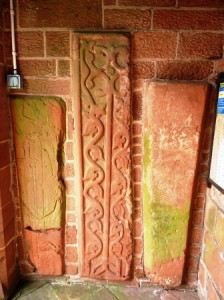 such as these grave covers in the porch of Gosforth Church. I have recently discovered that there are crosses and grave covers like these in a church in Penrith, so I will have to plan a visit there as well.
such as these grave covers in the porch of Gosforth Church. I have recently discovered that there are crosses and grave covers like these in a church in Penrith, so I will have to plan a visit there as well.
3rd March 2014: Cumbrian Mountain Express
I have been enjoying watching the steam hauled special train called the Cumbrian Mountain Express as it passes through Carnforth and near Hincaster the last few weekends, hauled by ex-LMS 4-6-0s. Firstly it was 45699 “Galatea”, seen below near Hincaster,
 The other loco is 46115 “Scots Guardsman”, seen below starting the journey up to Carlisle as it passes through Carnforth station.
The other loco is 46115 “Scots Guardsman”, seen below starting the journey up to Carlisle as it passes through Carnforth station.
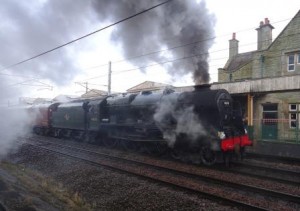 The journey involves steam haulage from Carnforth to Carlisle on the main line, and then down the Settle and Carlisle line. Apparently according to the railway media, the two 4-6-0s have found it hard work to keep to time, battling the heavy trains and generally bad weather conditions. “Galatea” is an example of the seemingly miraculous restoration of an engine that had stood in Barry scrapyard for around 15 years before being rescued. When I saw it in Carnforth Steamtown in 1981, it was a real wreck, with the smokebox a shell, the chimney and smokebox door missing, and a large part of one of the driving wheels cut off.
The journey involves steam haulage from Carnforth to Carlisle on the main line, and then down the Settle and Carlisle line. Apparently according to the railway media, the two 4-6-0s have found it hard work to keep to time, battling the heavy trains and generally bad weather conditions. “Galatea” is an example of the seemingly miraculous restoration of an engine that had stood in Barry scrapyard for around 15 years before being rescued. When I saw it in Carnforth Steamtown in 1981, it was a real wreck, with the smokebox a shell, the chimney and smokebox door missing, and a large part of one of the driving wheels cut off.
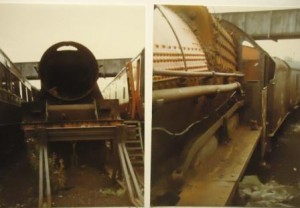 The photos above give some idea of the condition “Galatea” was in at that time.The official story then was that they would restore the boiler for use on one of the already preserved Jubilees. However, now it has become the fourth preserved Jubilee, and it looks very fine. I suppose that you could claim the loco is well named, as in mythology Galatea is the name of Pygmalion’s statue that came to life, as this loco has been transformed from the inanimate wreck of 1981 to the beautiful living loco of today.
The photos above give some idea of the condition “Galatea” was in at that time.The official story then was that they would restore the boiler for use on one of the already preserved Jubilees. However, now it has become the fourth preserved Jubilee, and it looks very fine. I suppose that you could claim the loco is well named, as in mythology Galatea is the name of Pygmalion’s statue that came to life, as this loco has been transformed from the inanimate wreck of 1981 to the beautiful living loco of today.
31st January 2014: Australia Holiday
Mark and I spent a week at the end of the holiday in Australia with David, Sue, Nicholas and Andrew. It was good to see them all, especially as we had not seen Sue and the two boys, or rather young men, for a long time. If only the cricket hadn’t been on at the same time as we were there… Anyway, they made sure that we were well entertained during our visit. David took us to the railway museum at Thirlmere in NSW, and we also visited the Railway Museum at Canberra. This loco was built in Manchester,
and we also visited the Railway Museum at Canberra. This loco was built in Manchester,
 England, in the 1870’s by Beyer Peacock and exported to Australia. We visited the War memorial at Canberra, and also the Art Gallery, both of which were very
England, in the 1870’s by Beyer Peacock and exported to Australia. We visited the War memorial at Canberra, and also the Art Gallery, both of which were very
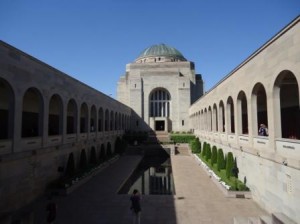 impressive. We saw the daily ceremony of remembrance, and the hall in the tower section at the far end of this photo, which is a beautiful building. Sue took us to the Featherdale Wildlife Park near Sydney, where we saw a lot of birds and beasts, including a large number of colourful birds, such as this golden pheasant, which I think was chinese,
impressive. We saw the daily ceremony of remembrance, and the hall in the tower section at the far end of this photo, which is a beautiful building. Sue took us to the Featherdale Wildlife Park near Sydney, where we saw a lot of birds and beasts, including a large number of colourful birds, such as this golden pheasant, which I think was chinese, 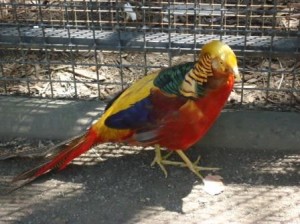 South American macaws, which were wonderful to look at but apparently very destructive,
South American macaws, which were wonderful to look at but apparently very destructive,
 and a wide variety of other parrots, including this one:
and a wide variety of other parrots, including this one:
 All in all we have had a very good holiday. David has included my photos of the family, and Andrew playing the trumpet in his blog, so I will not duplicate his work. No more holidays until after the end of March, when the new financial year starts, but it was worth it!
All in all we have had a very good holiday. David has included my photos of the family, and Andrew playing the trumpet in his blog, so I will not duplicate his work. No more holidays until after the end of March, when the new financial year starts, but it was worth it!
12th December 2013: New Zealand Holiday
Mark and I have just returned from a months holiday in New Zealand and Australia. Mark planned an itinerary that involved driving in a rented car around the north island, stopping at a number of places to explore the area. We saw a wide variety of sights, such as Mount Ruapehu- 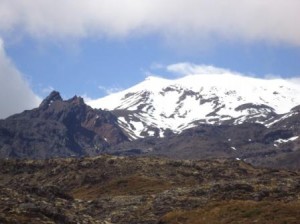 unfortunately, like several other mountains we looked at, it was partly covered with clouds but still very impressive. We also saw beautiful waterfalls, such as this one at Whangerai,
unfortunately, like several other mountains we looked at, it was partly covered with clouds but still very impressive. We also saw beautiful waterfalls, such as this one at Whangerai, 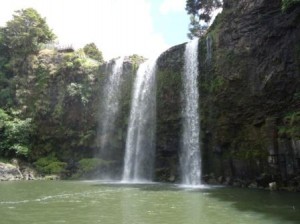 the all wooden church of old St. Pauls in Wellington, built in 1866, a number of art deco
the all wooden church of old St. Pauls in Wellington, built in 1866, a number of art deco 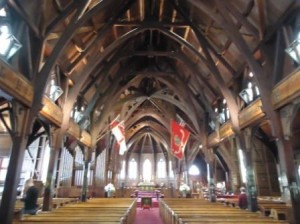 buildings in Napier, built in the 1920’s after a devastating earthquake. Napier is a pretty place, and one of a number where we felt we didn’t have enough time to properly explore.
buildings in Napier, built in the 1920’s after a devastating earthquake. Napier is a pretty place, and one of a number where we felt we didn’t have enough time to properly explore.
 We explored the volcanic area around Rotorua, including the Lady Knox Geyser,
We explored the volcanic area around Rotorua, including the Lady Knox Geyser,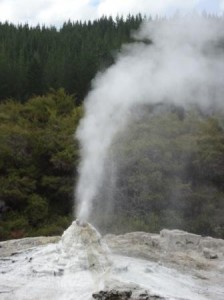
which was induced to erupt whilst we were there, and also Waimangu volcanic park,
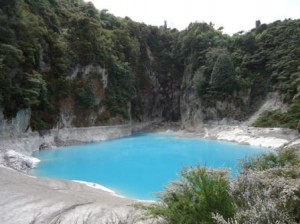 which included this bright blue lake, mud pools, and vivid colours of volcanic deposits, as well as at times very strong and unpleasant smells!. Our route included roads through a number of river gorges, such as this one, the Karangahake Gorge on the Coromandel Peninsula, which also had old mine workings and mineral railway to inspect, and other
which included this bright blue lake, mud pools, and vivid colours of volcanic deposits, as well as at times very strong and unpleasant smells!. Our route included roads through a number of river gorges, such as this one, the Karangahake Gorge on the Coromandel Peninsula, which also had old mine workings and mineral railway to inspect, and other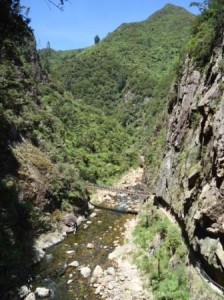
natural wonders such as Cathedral cove with arches and stacks to admire.
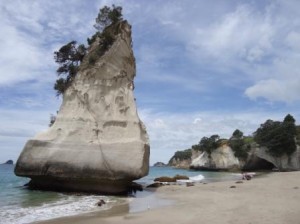 A highlight of the trip was a boat trip out into the bay of islands to admire the islands,
A highlight of the trip was a boat trip out into the bay of islands to admire the islands,
 look for dolphins, and take a short trip through this island to the pacific ocean through the hole in the rock seen above. We did see a number of dolphins, which came and played in the wake of the boat, but were too difficult to photograph. We also saw Kiwis in a nature reserve, including an albino kiwi. It was a very enjoyable holiday, and now we will have to save up and plan a holiday on the south island.
look for dolphins, and take a short trip through this island to the pacific ocean through the hole in the rock seen above. We did see a number of dolphins, which came and played in the wake of the boat, but were too difficult to photograph. We also saw Kiwis in a nature reserve, including an albino kiwi. It was a very enjoyable holiday, and now we will have to save up and plan a holiday on the south island.
6th September 2013: Holiday at Cark and Amsterdam
We have been having what seems to have become a regular gathering of the three brothers in August each year when David visits the UK. We have eaten at the “best restaurant in the UK” L’enclume in Cartmel, which David has commented on in his blog, and I have nothing to add to his praise for the meal. We also visited the Ulverston brewery,and this photo is of David during the visit:
 I must say he doesn’t look very grumpy, but then he is drinking the local alcoholic beverage. The hat marks the fact that the brewery has linked itself to Ulverston’s most famous son, Stan Laurel, and names it’s very good quality beers after Laurel and Hardy films.
I must say he doesn’t look very grumpy, but then he is drinking the local alcoholic beverage. The hat marks the fact that the brewery has linked itself to Ulverston’s most famous son, Stan Laurel, and names it’s very good quality beers after Laurel and Hardy films.
We also visited Amsterdam as David was at a conference there. We had a very good time exploring the museums and galleries, and going on a canal trip:
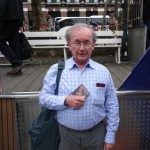 Amsterdam is built on reclaimed land, and the older houses are built on wooden piles that in some cases are gradually subsiding. Some of the houses lean at alarming angles, and these houses near the harbour seem to be melting into each other:
Amsterdam is built on reclaimed land, and the older houses are built on wooden piles that in some cases are gradually subsiding. Some of the houses lean at alarming angles, and these houses near the harbour seem to be melting into each other:
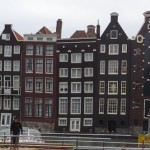 We also visited a village north of Amsterdam called Zaanse Schans, where they have created a village of old wooden houses and windmills near the river Zaan. It was very interesting and picturesque, and several of the windmills are still working grinding paint, cutting wood, and grinding flour.
We also visited a village north of Amsterdam called Zaanse Schans, where they have created a village of old wooden houses and windmills near the river Zaan. It was very interesting and picturesque, and several of the windmills are still working grinding paint, cutting wood, and grinding flour.
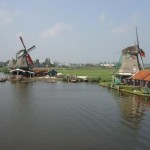 After all, we couldn’t visit the Netherlands and not see any canals, dykes, and windmills and admire the flat countryside!
After all, we couldn’t visit the Netherlands and not see any canals, dykes, and windmills and admire the flat countryside!
30th July 2013: Cark Steam Gathering 2013
The annual steam gathering at Cark airfield took place last weekend. There was a torrential downpour on saturday night, but it didn’t seem to dampen the spirits of the people attending. There were a large number of steam powered traction engines there, which paraded around the small arena on site. They were all in fine condition, and a lovely sight to see, such as the one here on the left. There were also parades of motor bikes, pedal cycles, tractors and classic cars. There were also some other interesting vehicles, like the Stanley Steam Car on the right.
There was also a large number of other petrol and diesel powered vehicles, tractors, buses, fire engines, lorries, vans and cars, from Ford model Ts to Ford RS2000s, from the sublime like this Jaguar e-type to the ridiculous, the Austin A40s. It seems there is no vehicle so humble or old fashioned that there is not someone out there who will lovingly preserve them….
15th July 2013: Lake District Insects
These are two large insects that I have encountered in the Lake District recently. The left hand photo is a drinker moth caterpillar that I found trying to cross the road near Torver, and it was very reluctant to be rescued and put back on the grass verge. After I left I expect that it continued its valiant attempt to cross the road, no doubt to see it’s flat mate. The second photo is of a giant yellow and black dragonfly that I found near Black Coombe. It seemed quite happy to be photographed, and it stayed in position as it took me several attempts to get it in focus. I was a little disappointed in its accurate but rather prosaic name. I was hoping it might be something a little more exotic sounding.
5th June 2013: Mark’s 60th Birthday party
For all our friends and relatives who could not attend on May 18th, I have put up a few photos of Mark’s party.
Mark had a marquee put up in his back garden that you could enter through his patio window. The caterers served their food in the marquee, and dispensed the drinks, both of which were plentyful and tasty. A good mix of relatives and friends attended. It was all very enjoyable, and I think that Mark and all his guests had a good time.
3rd May 2013: more photos of Haverthwaite industries
Gunpowder wagons like these two which are preserved at Haverthwaite were drawn by horses from Low Wood Gunpowder works to Haverthwaite station on a narrow gauge tramway across the Leven river. They have special couplings and wooden brake blocks to lessen the chance of accidents.
This boiler is very similar to a railway locomotive boiler. The engine house has been reroofed to protect it, but it is strange it has been left here all this time since the works shut in the 1930’s.
Remains of the furnace and chimney, now truncated and in a very poor state of repair. Much of this site at Backbarrow has been redeveloped. The lintel to this furnace is dated 1711.
Remains of a steam engine in very poor repair. This engine house has not had its roof repaired. A system of pipes like those above the engine led the steam to various parts of the site.
23rd April 2013: Haverthwaite industries
You wouldn’t know it nowadays, but Haverthwaite and Backbarrow were hives of industry in earlier times. The gunpowder works at Low Wood and the ironworks at Backbarrow were both set up in the eighteenth century, and both used the River Leven for power for their turbines. Both were attached to the Lakeside branch railway, and must have been major employees in the area. The gunpowder works closed in the 1930’s and the ironworks in the 1960’s, and both are now heritage sites, though not in very good condition. Both have old stationery boilers and water turbines still in situ, and are interesting to explore, though rather overgrown.
Also, both have new hydro electric power stations using their original water courses for their turbines, so they are not without their uses even now. They are not the most picturesque parts of the Lakes, but interesting if you like industrial history. There is also a third industrial site near Haverthwaite at Bouth. There was another gunpowder works there, though very little of it seems to remain.
Monday 25th March 2013 Recent Lake District photos
Sunday 10th March 2013 Coniston Copper Mine Valley
This photo was taken in copper mines valley at Coniston, looking down towards the lake. The buildings in the foreground are the remains of a winding house for one of the mines. It is an interesting place, if you are interested in the history of industry in the Lakes. Someone has preserved a number of pieces of old industrial machinery, some old rails and ore wagons from the mines. They are stored near the building in the right background of the photo. It is set on the lower slopes of the Old Man, which provides a picturesque backdrop. There are quite a few buildings remaining, especially as the mines closed in the early twentieth century. It looks pleasant and quiet now, but I would not like to have been working in such a exposed spot during a lakeland winter. Below is a photo of the Old Man of Coniston from Copper Mine Valley, with spoil heaps from the mines in the foreground.
Thursday 14th February 2013 Carnforth again
Two steam hauled specials were running through Carnforth last weekend, so I went to see them.
86259 hauled the Winter Cumbrian Mountain Express from Euston to Carnforth. This loco has been preserved and repainted in electric blue, and looks great.
 Gresley A4 pacific 60009 ‘Union of South Africa’ took the ‘Winter Cumbrian Mountain Express’ north from Carnforth.
Gresley A4 pacific 60009 ‘Union of South Africa’ took the ‘Winter Cumbrian Mountain Express’ north from Carnforth.
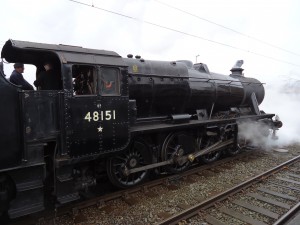 Then Stanier 8F 48151 hauling the ‘Lancastrian’, stopped at a signal in Carnforth Station.
Then Stanier 8F 48151 hauling the ‘Lancastrian’, stopped at a signal in Carnforth Station.
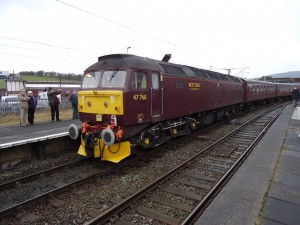 At the other end of the ‘Lancastrian’ was 47760, presumably acting as backup loco in case the 8F failed. You know you are getting old when you go specially to see preserved locos such as 47s and 86s that you saw in great numbers when you were younger.
At the other end of the ‘Lancastrian’ was 47760, presumably acting as backup loco in case the 8F failed. You know you are getting old when you go specially to see preserved locos such as 47s and 86s that you saw in great numbers when you were younger.
Sunday January 13th 2013
Furness Abbey
I visited Furness Abbey for the first time for a long time last weekend. It is a gloomy, melancholy place, especially in dull weather, as it was when I started my visit. Like a lot of these old ruined buildings, you have to use a lot of imagination to visualise how it must have been before Henry the Eighth had it closed down and part demolished in the 1530’s. The walls that are left are dark and slowly crumbling, held together in some places by scaffolding. But for around half an hour, a weak winter sun shone, and the dull sandstone was suddenly quite lovely. A large building made of this stone must have been very impressive to look at. but not much remains, and very little detail of the stonework. The photo is of one of the remaining arches with decoration intact, at least in part.
|
|
|
|
|
|
|
|
|
|
|
|
||||||||||||||||||||||||||||||||
| – Family Coulshed. 3:49:28 PM
|
| – Family Coulshed. 10:20:36 PM
|
| – Family Coulshed. 3:32:49 PM
|
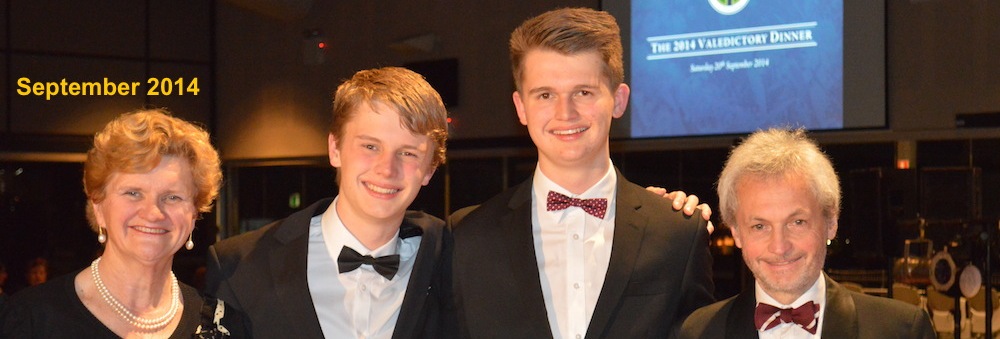
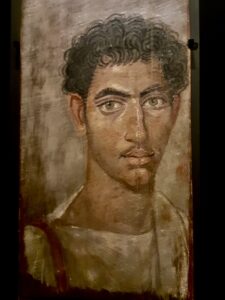
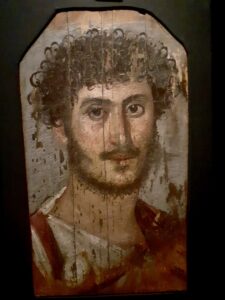
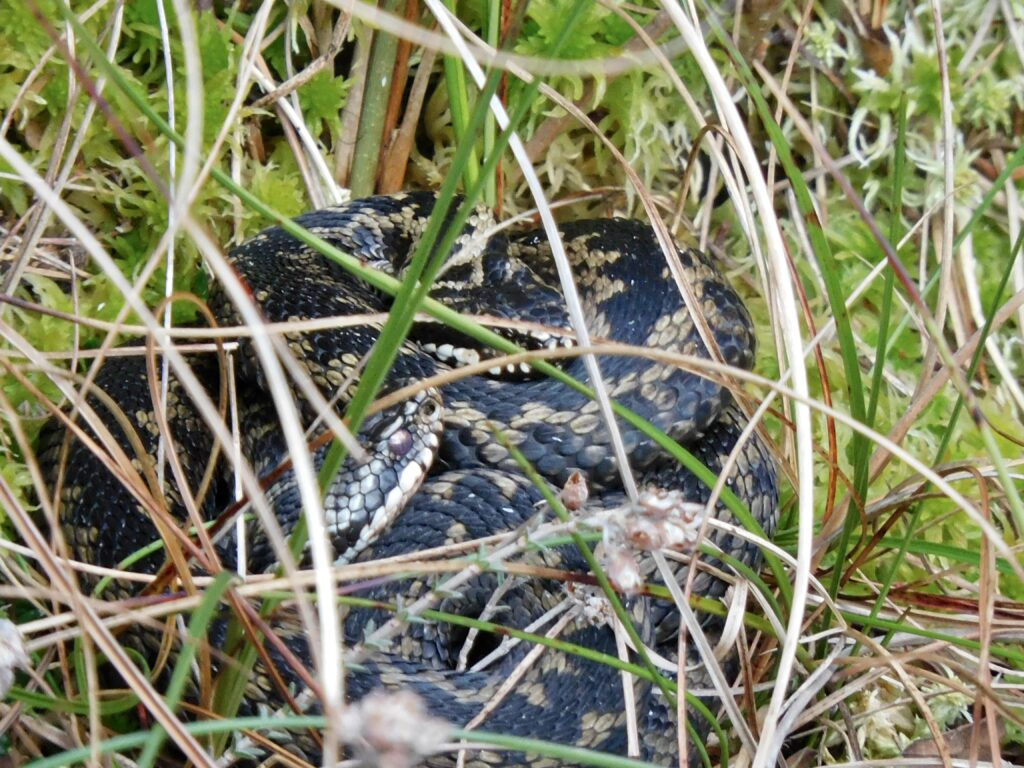
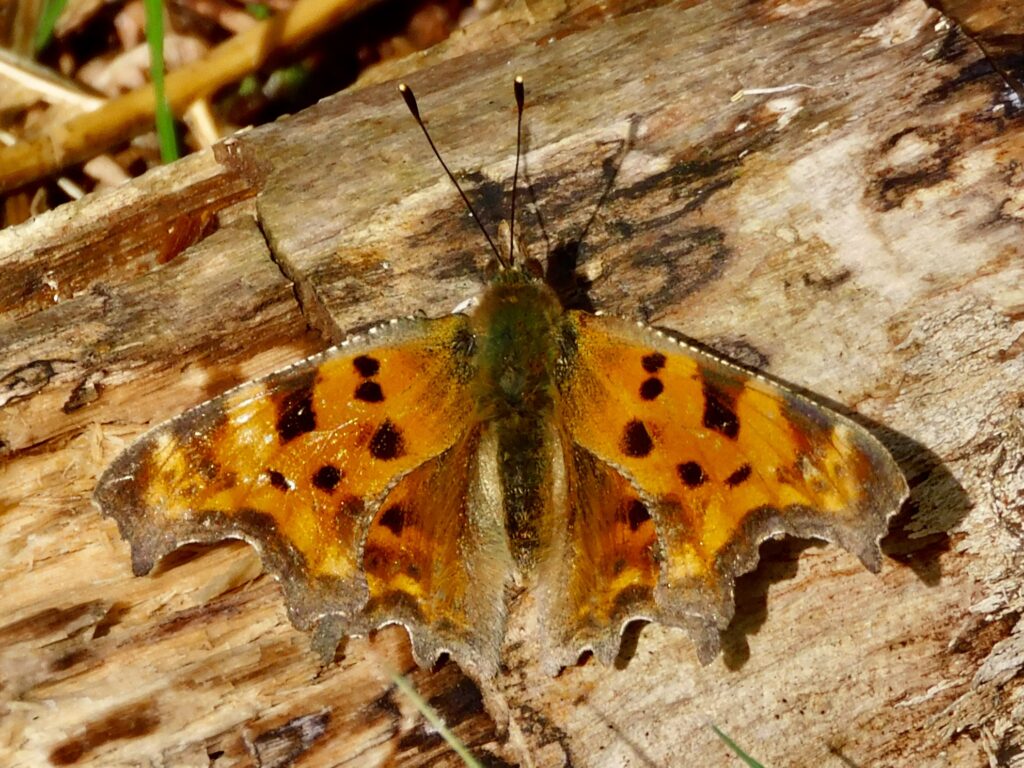
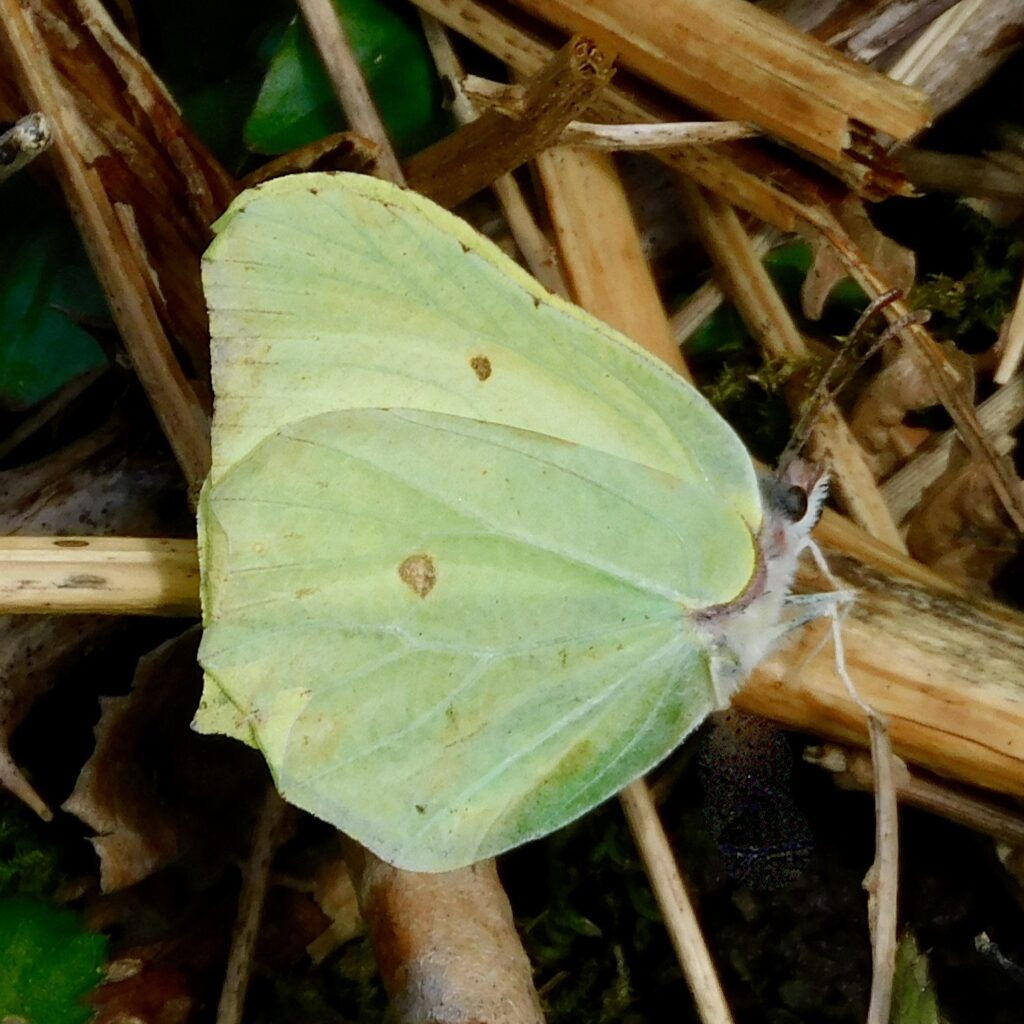

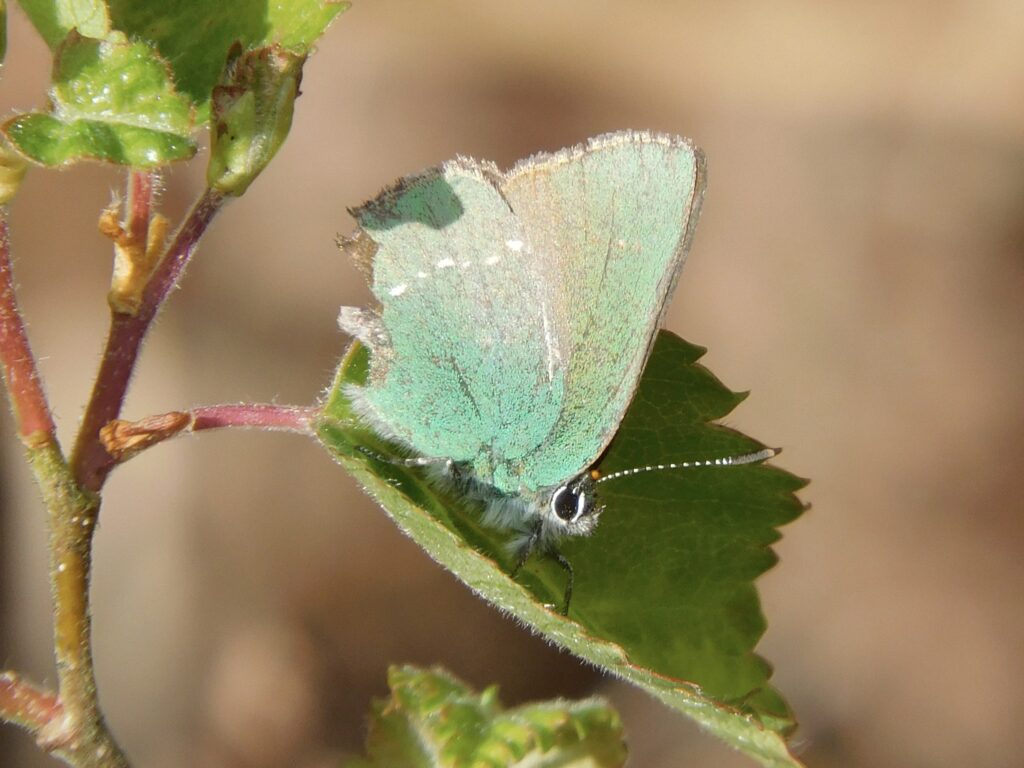
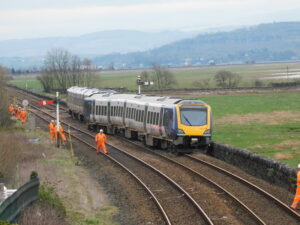

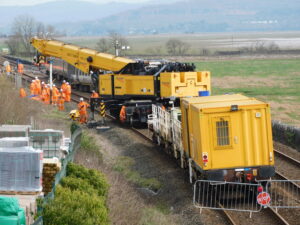
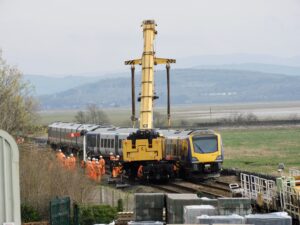


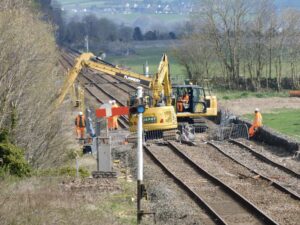
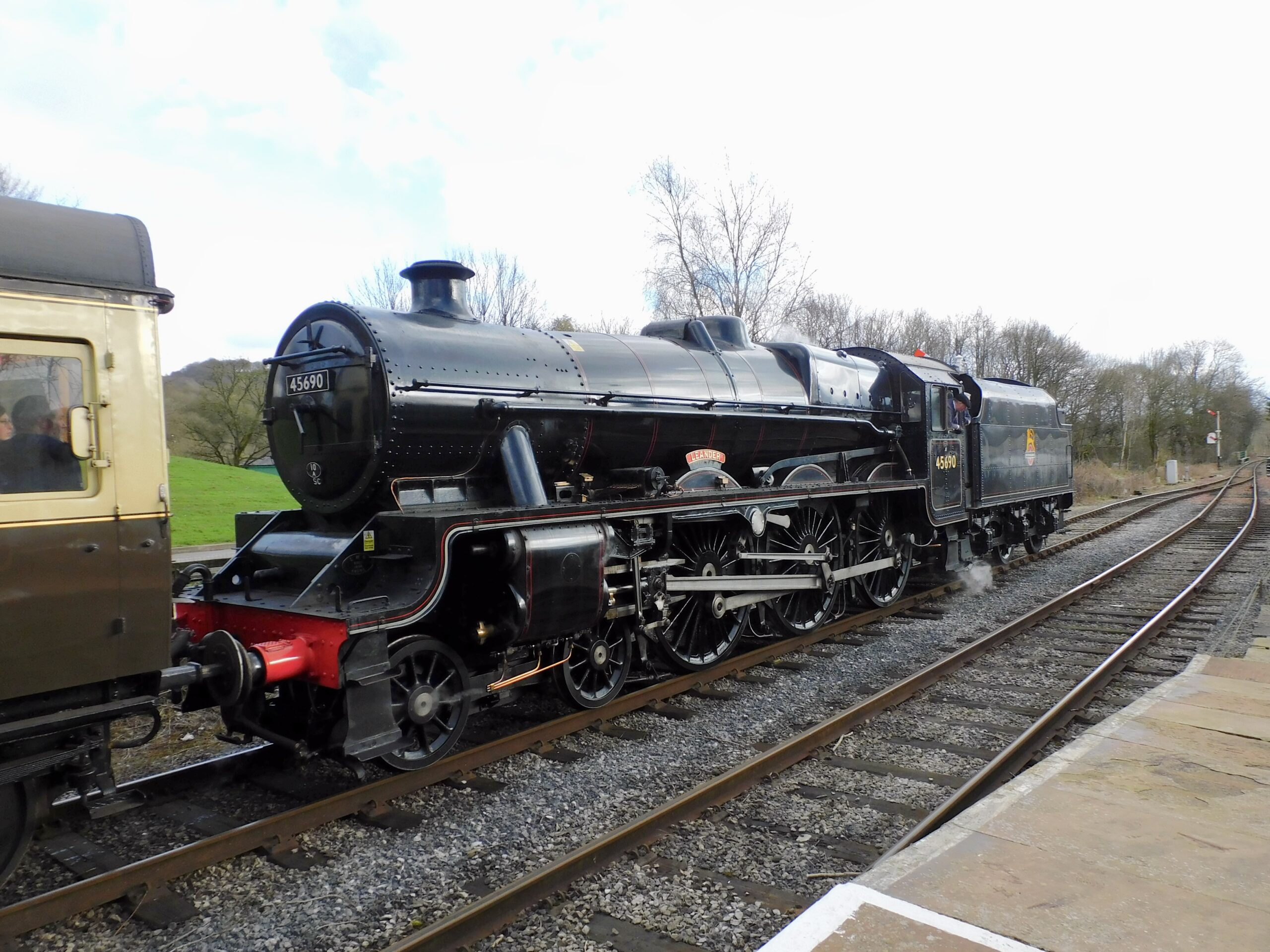
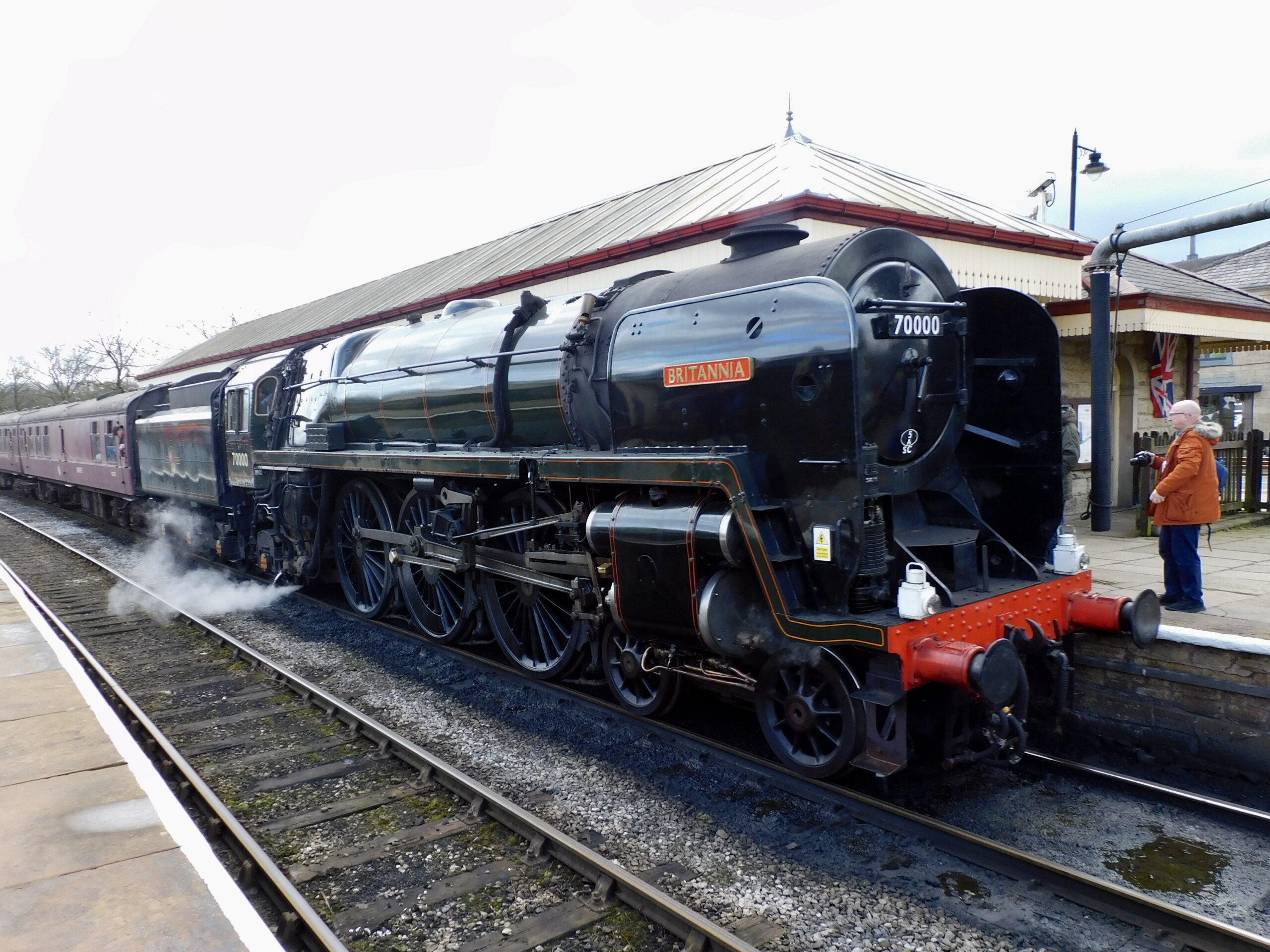
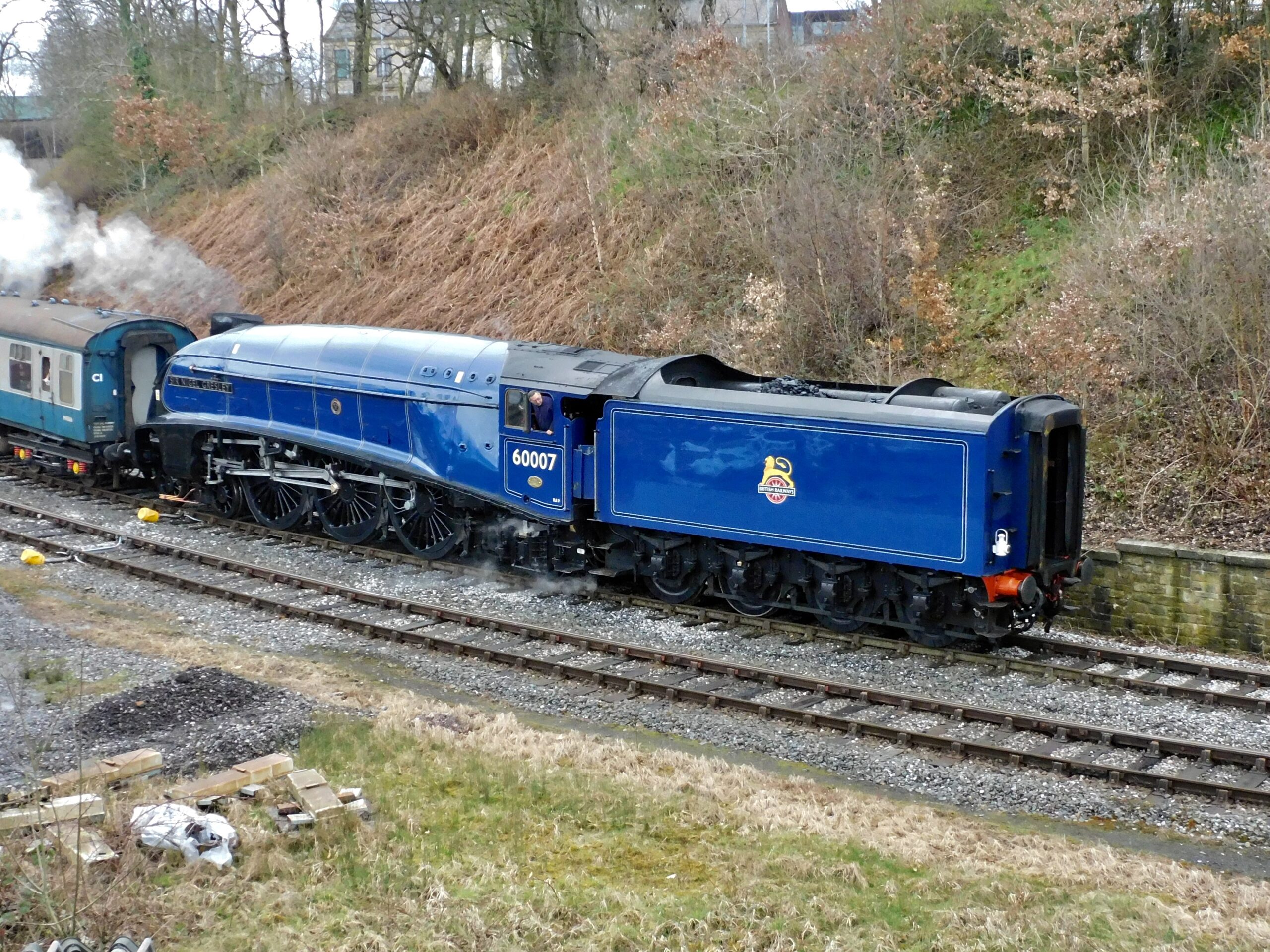
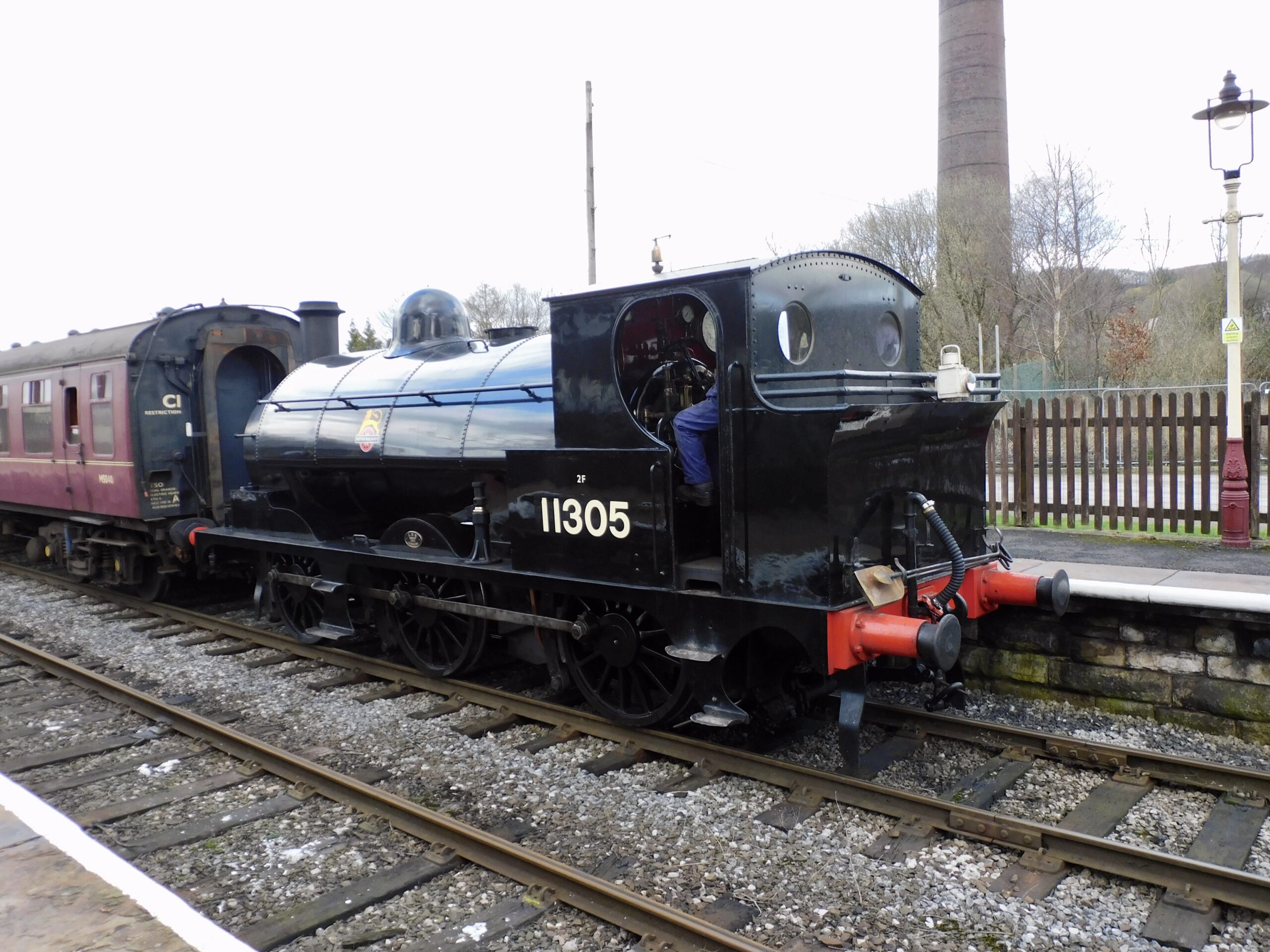
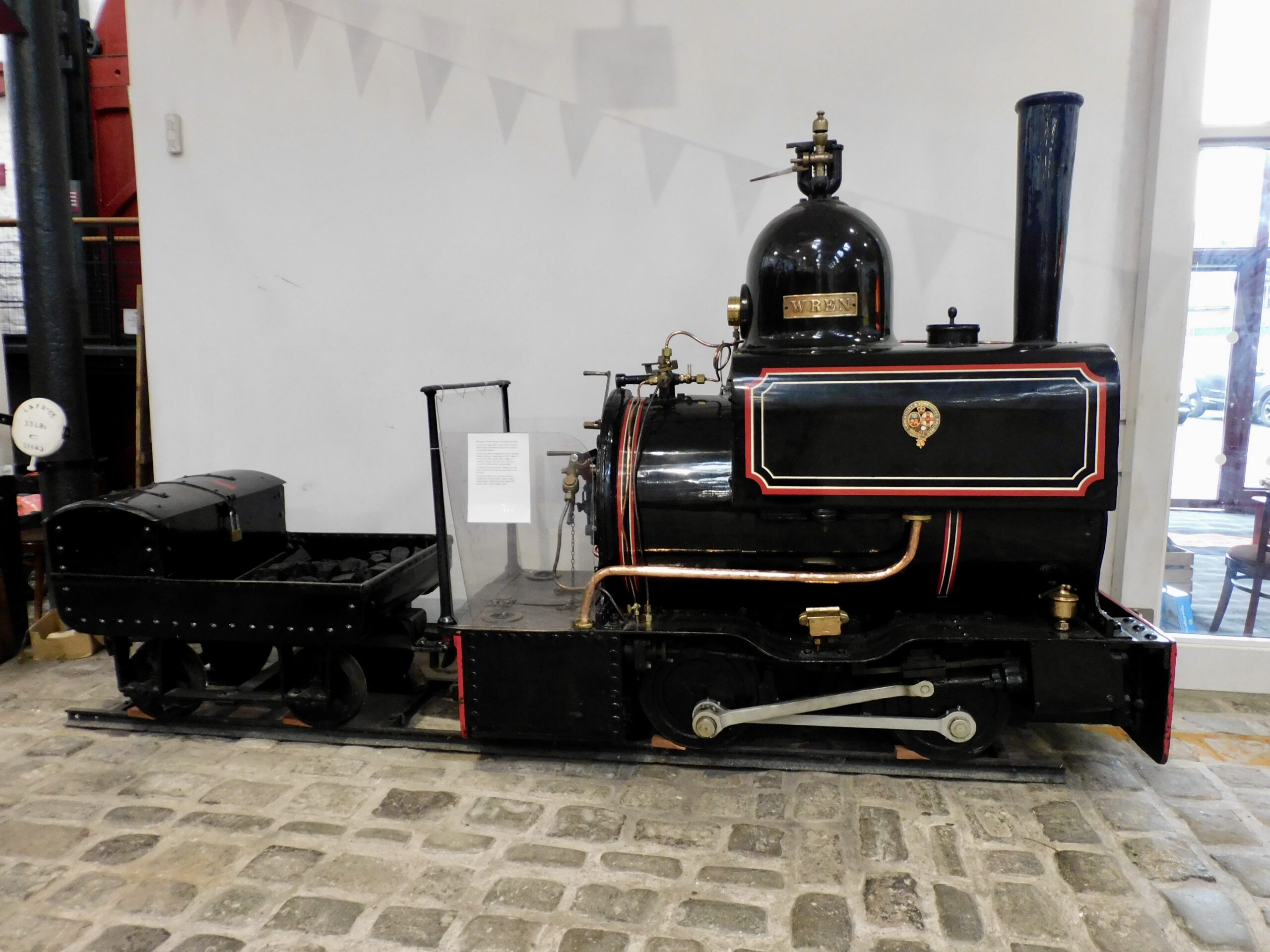
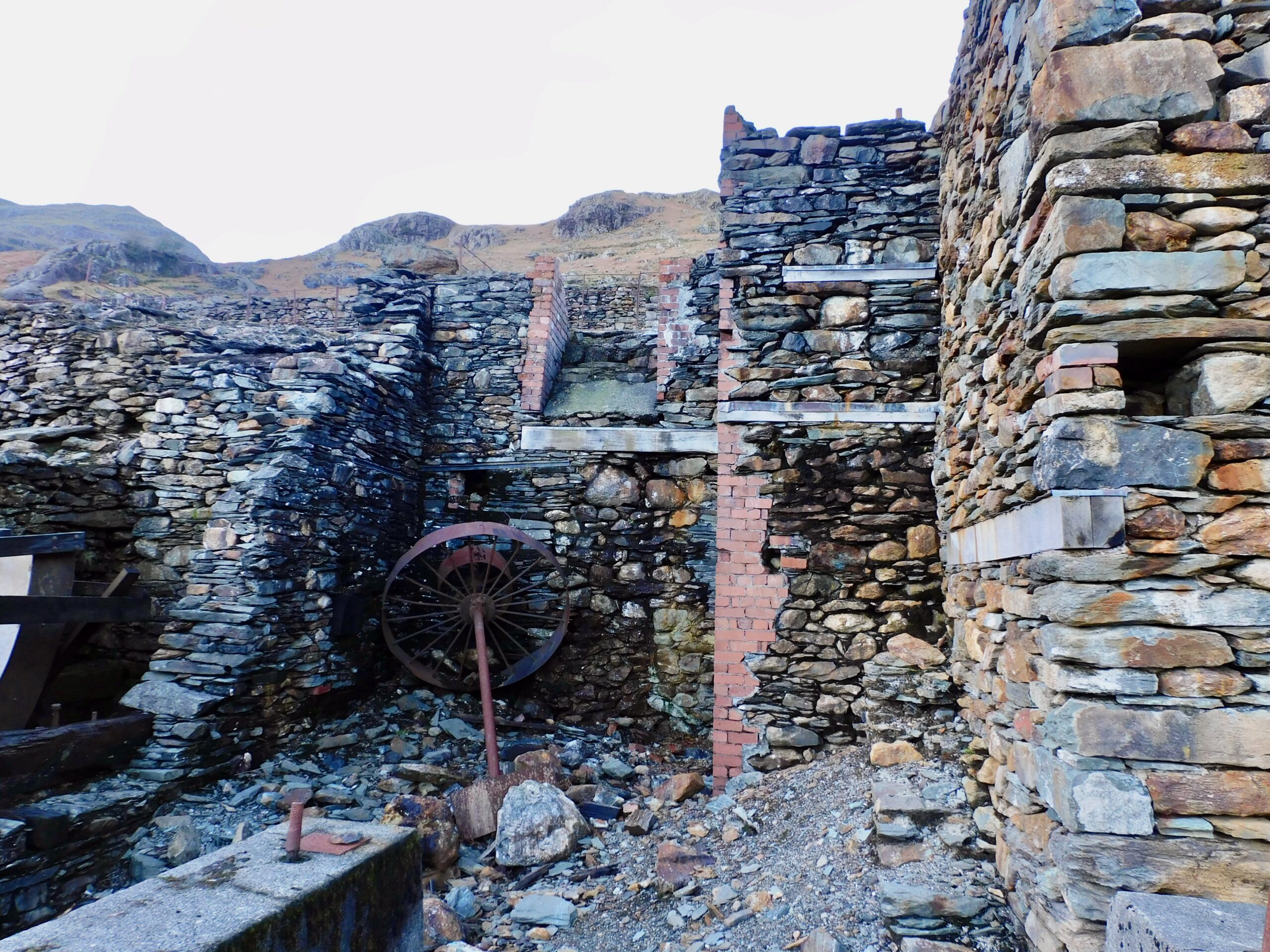
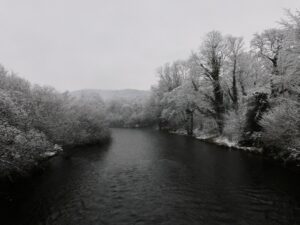
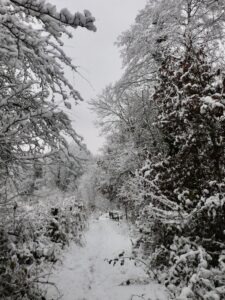
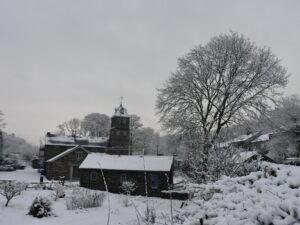
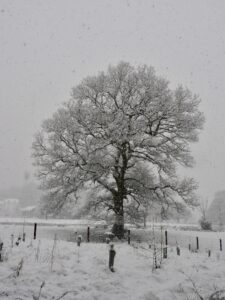
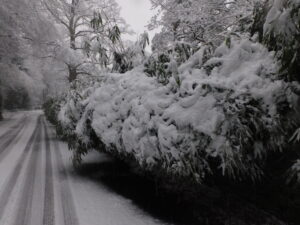
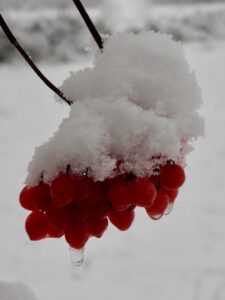
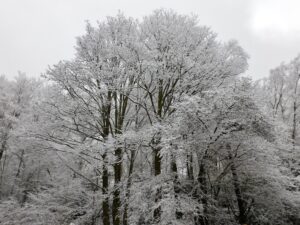
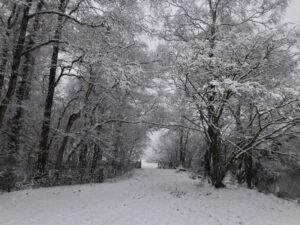

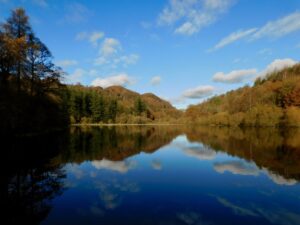
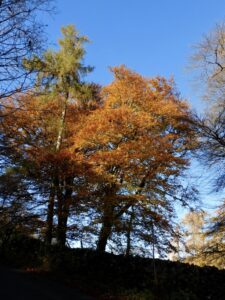
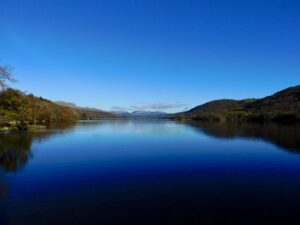
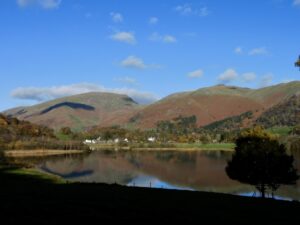
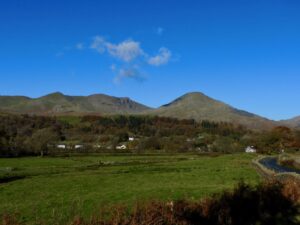
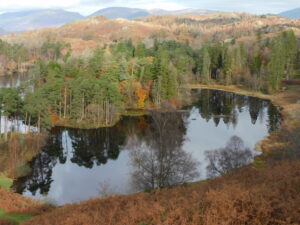



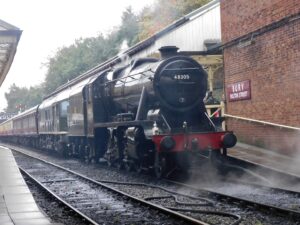
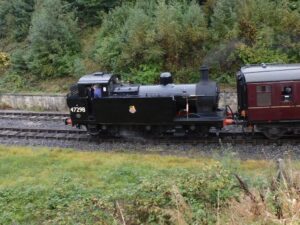

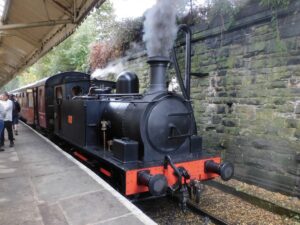
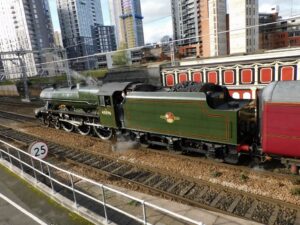
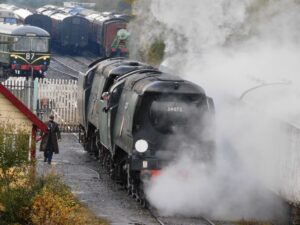
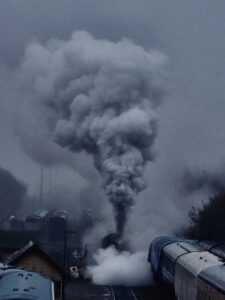
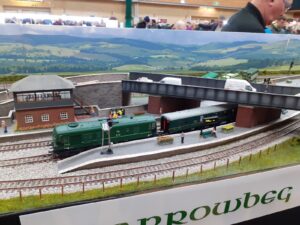
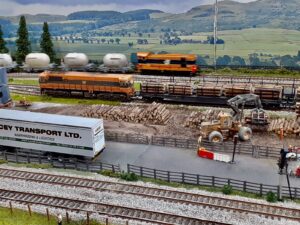

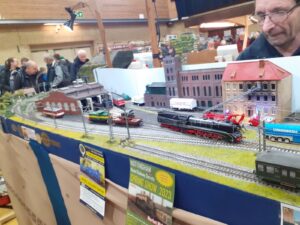
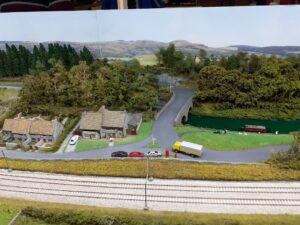
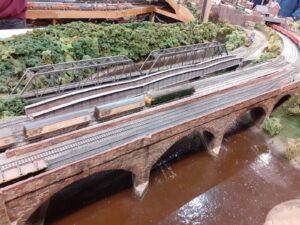
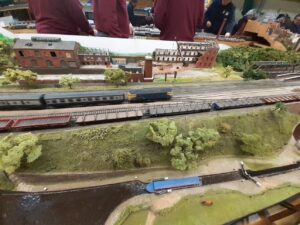
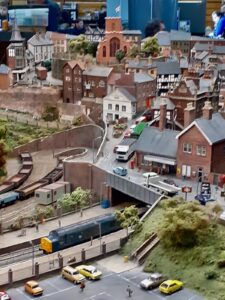
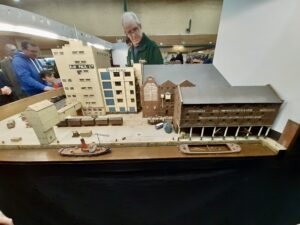
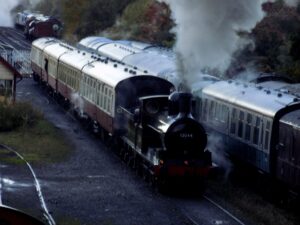
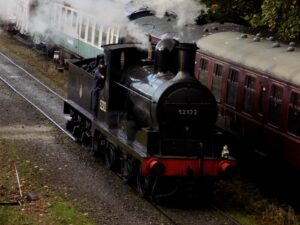
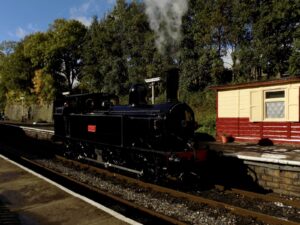
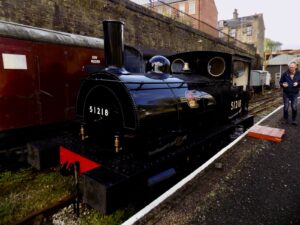
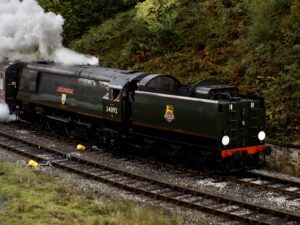
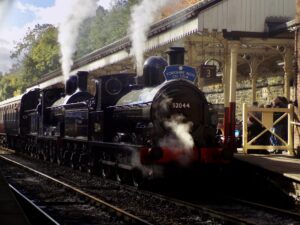
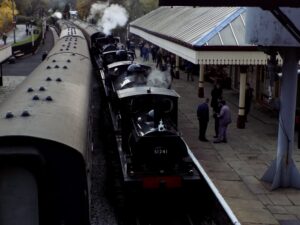
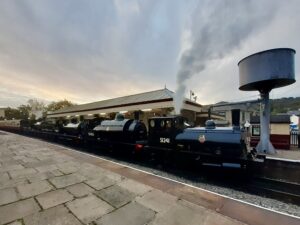
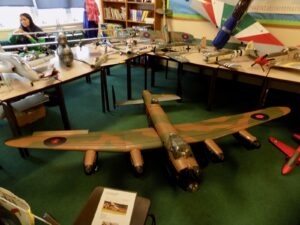
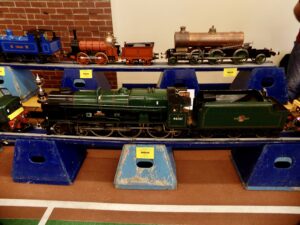
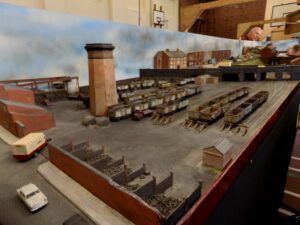
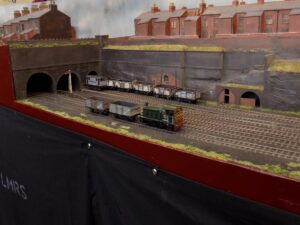
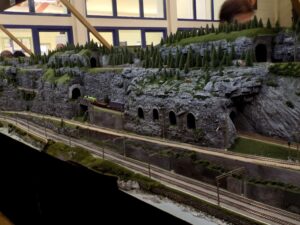
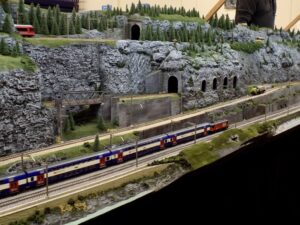
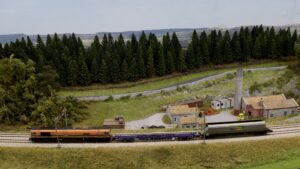
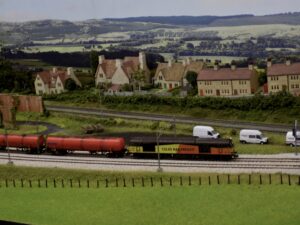
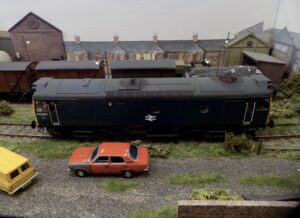
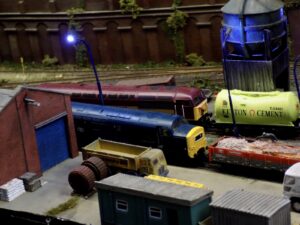
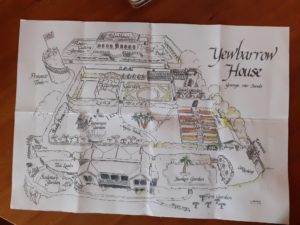

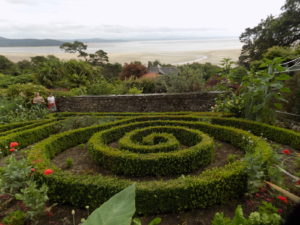
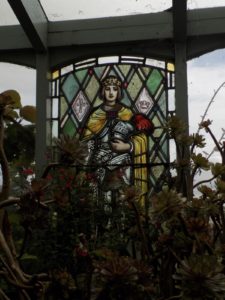
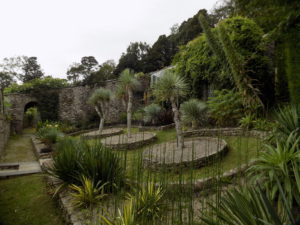

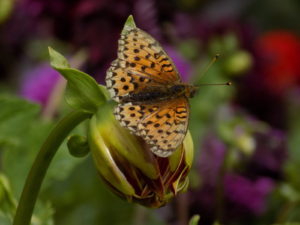
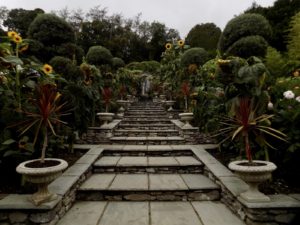
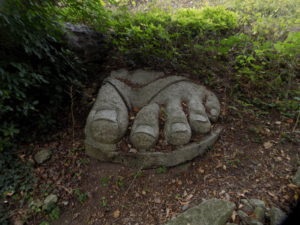




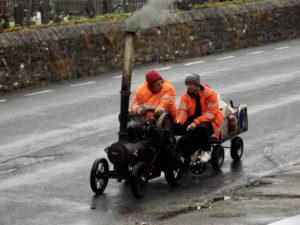
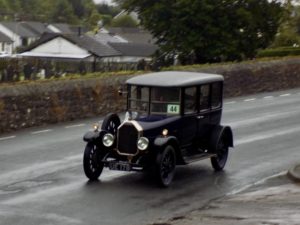
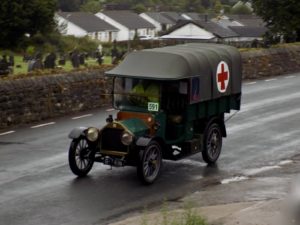
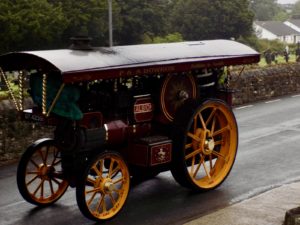
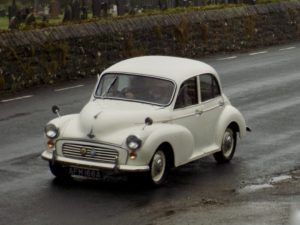
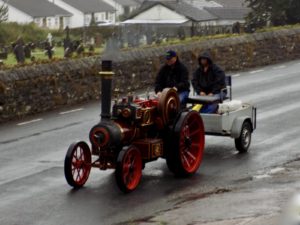
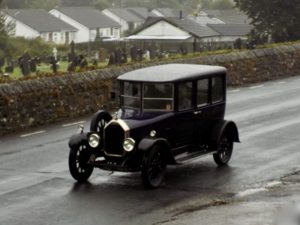
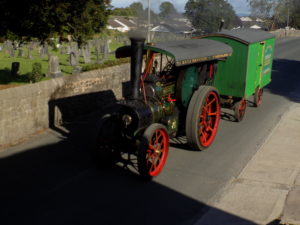
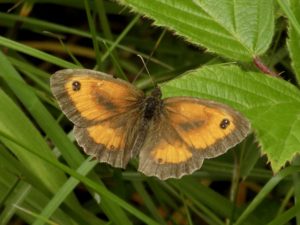
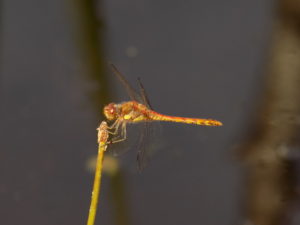
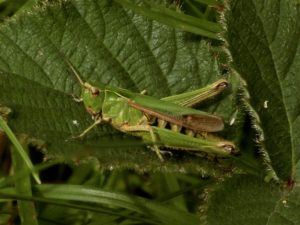
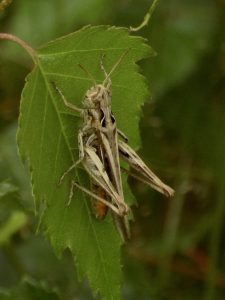
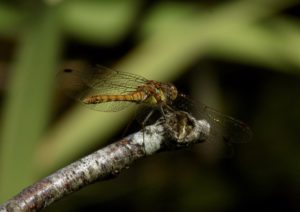
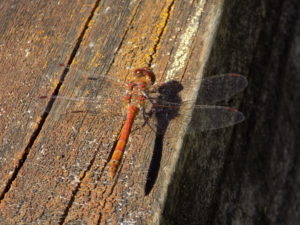
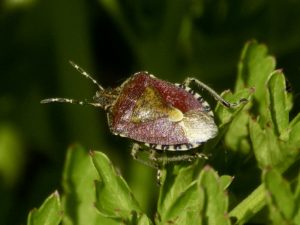
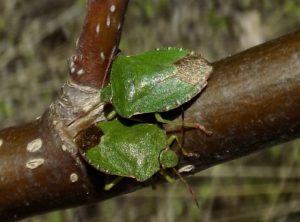
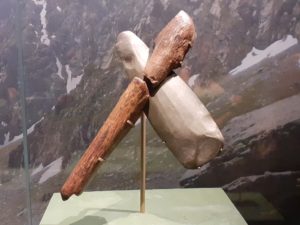
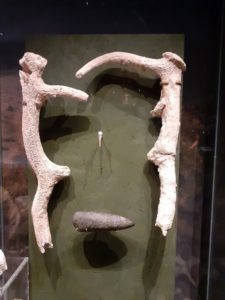
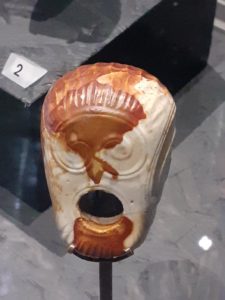 L
L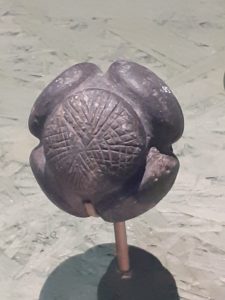
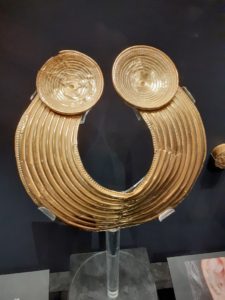
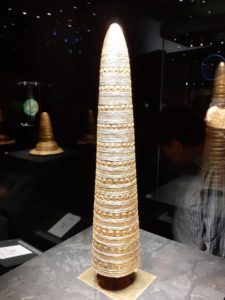
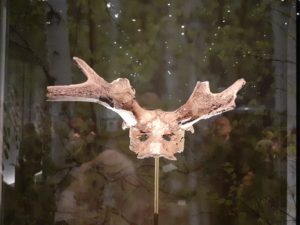
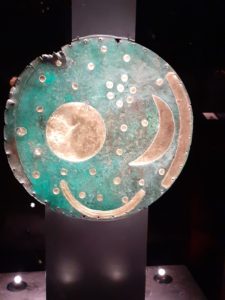
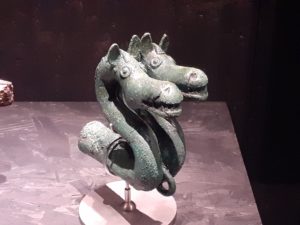
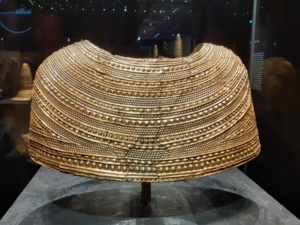
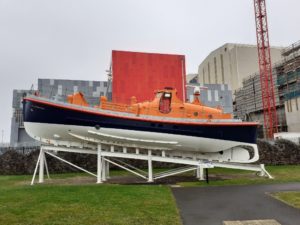
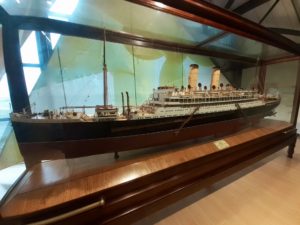
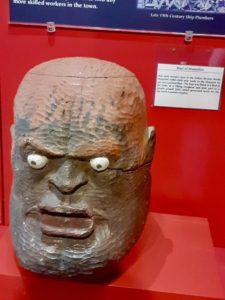
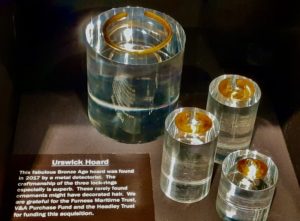
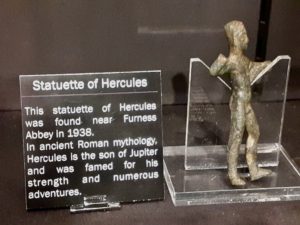
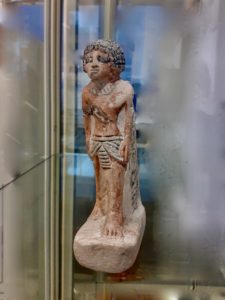
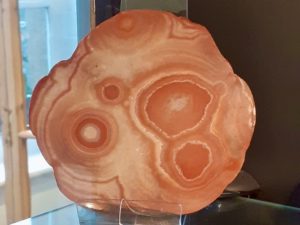

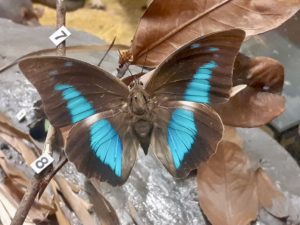
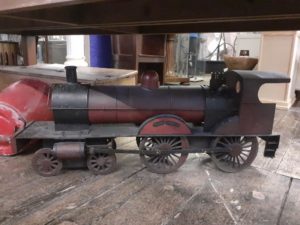
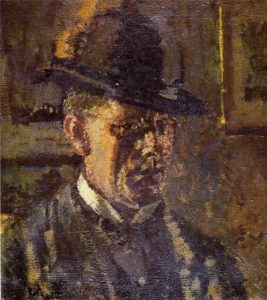
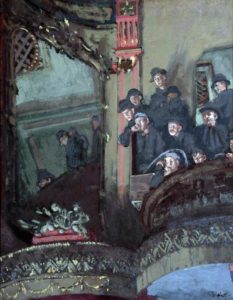
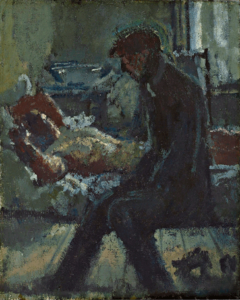
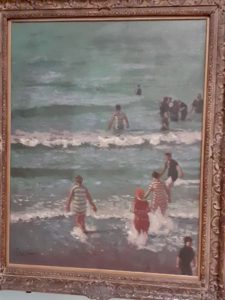
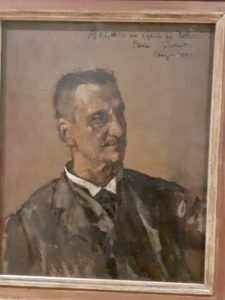
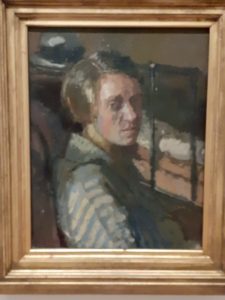
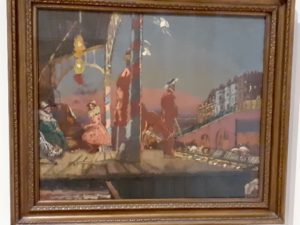
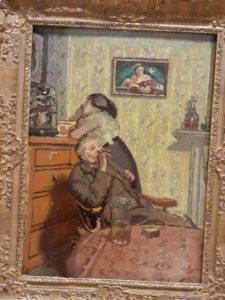
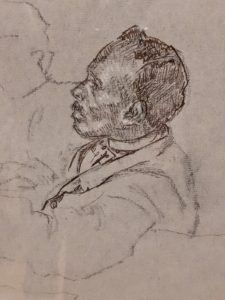
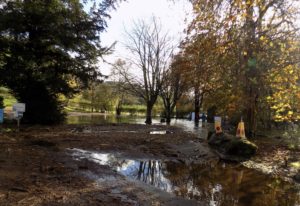
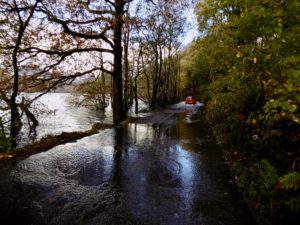
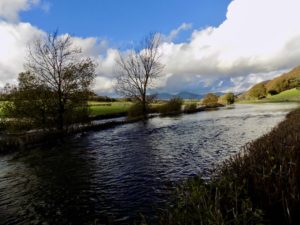
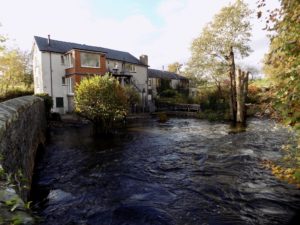
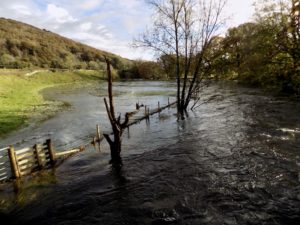
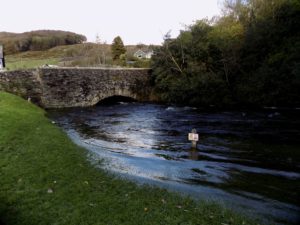
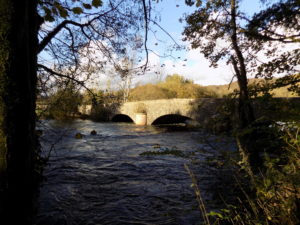
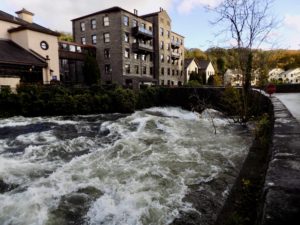
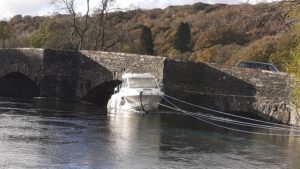
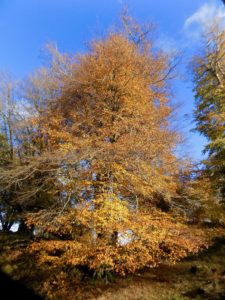
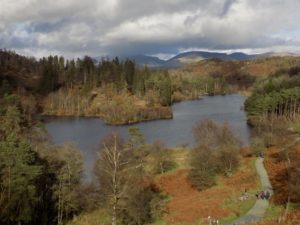
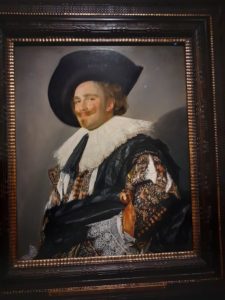
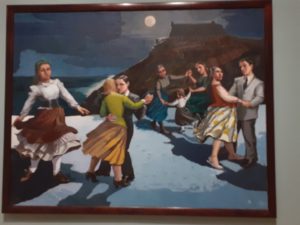
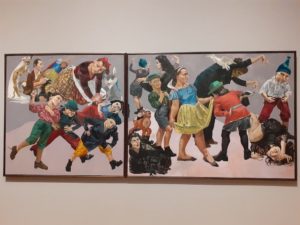
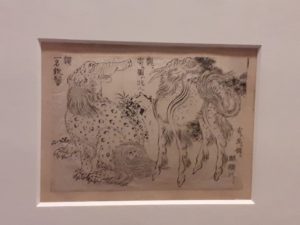
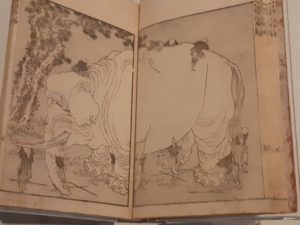
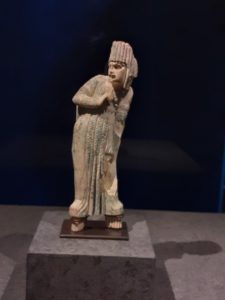


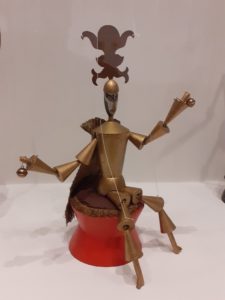
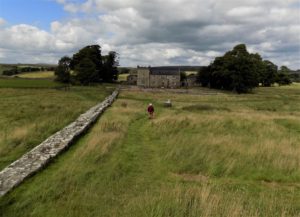

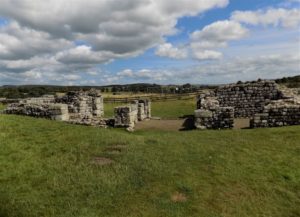
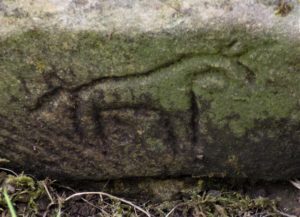
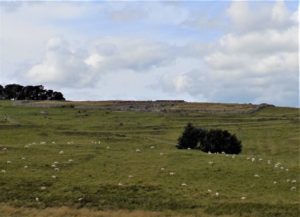
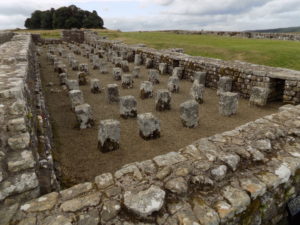
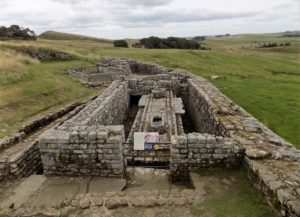
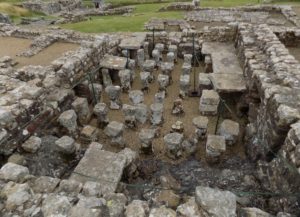
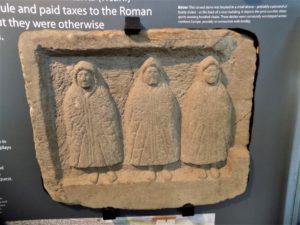
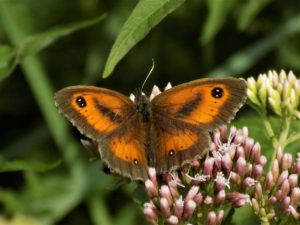
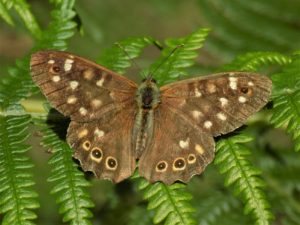
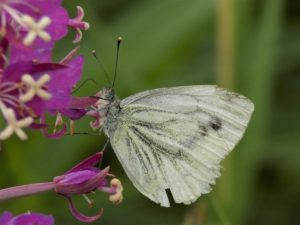
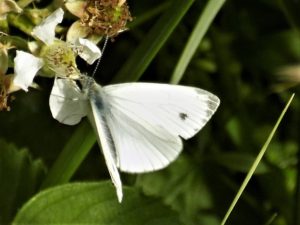
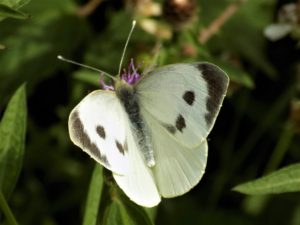
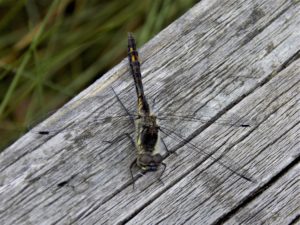
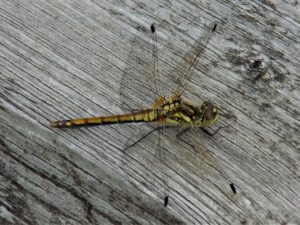
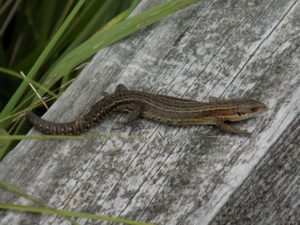
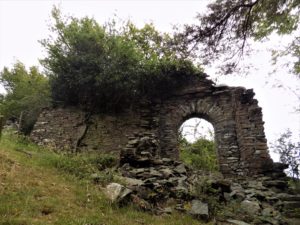
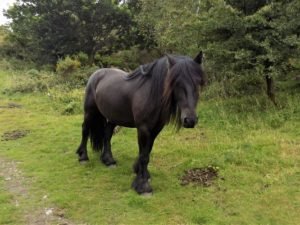
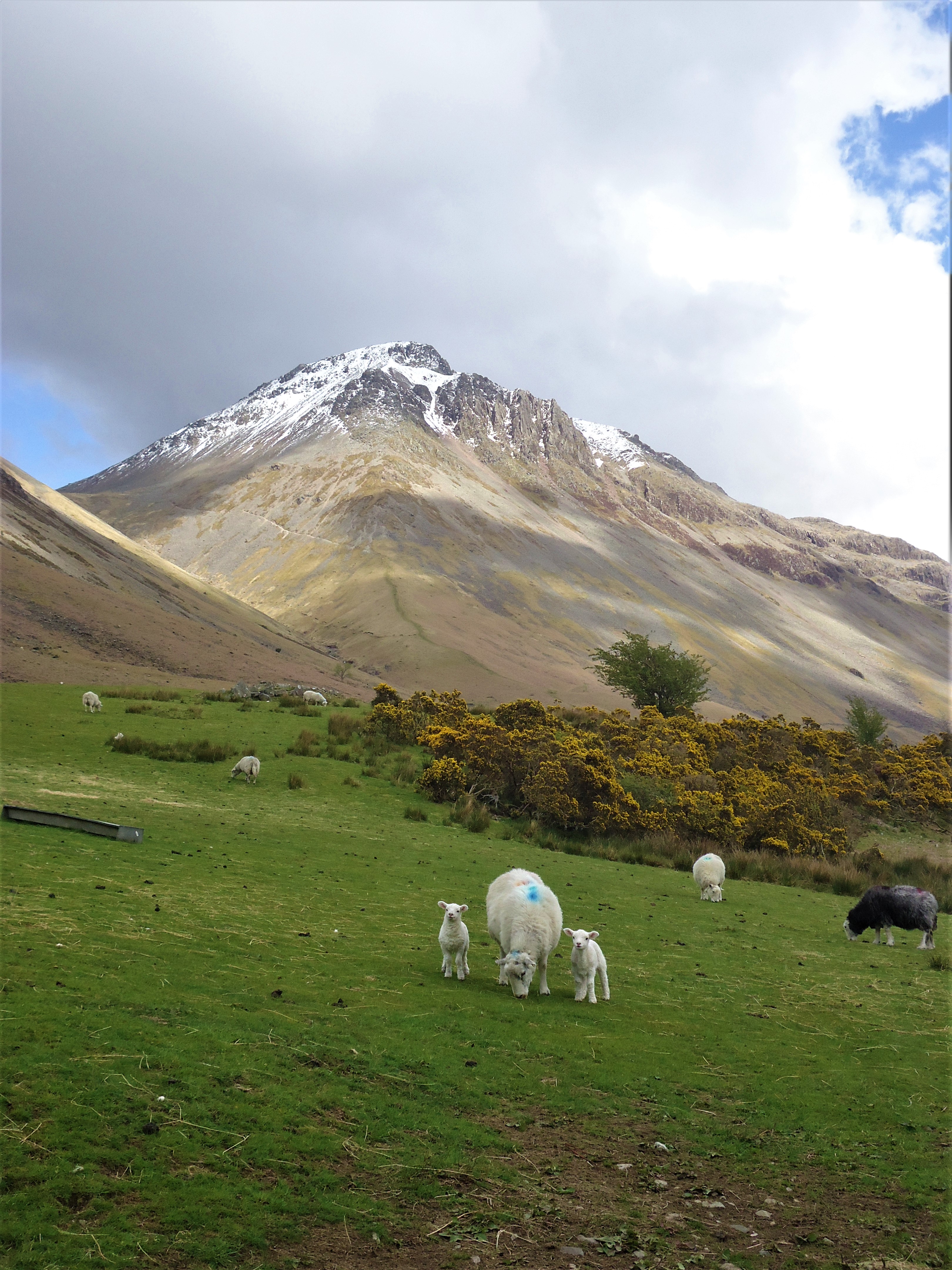
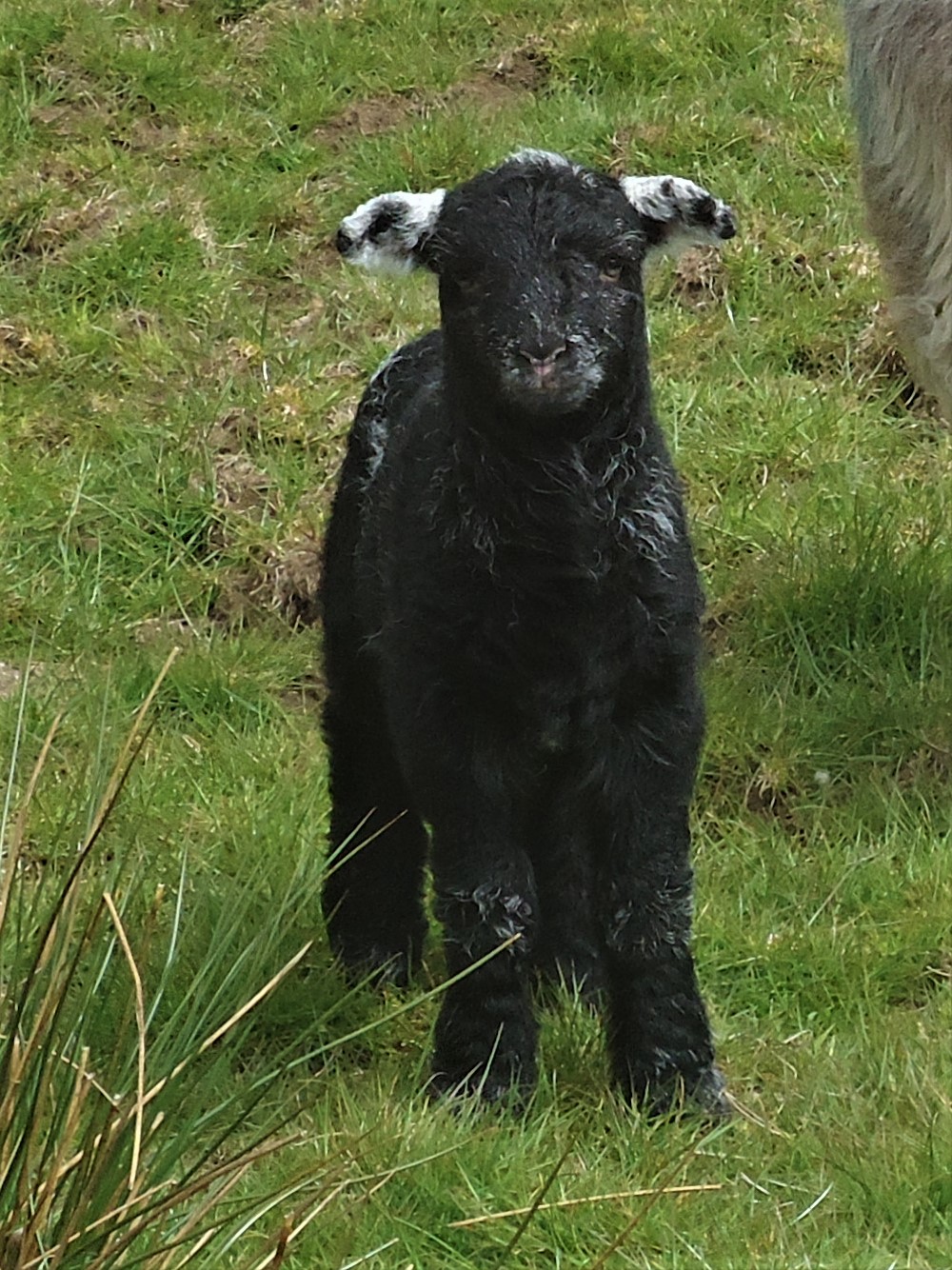
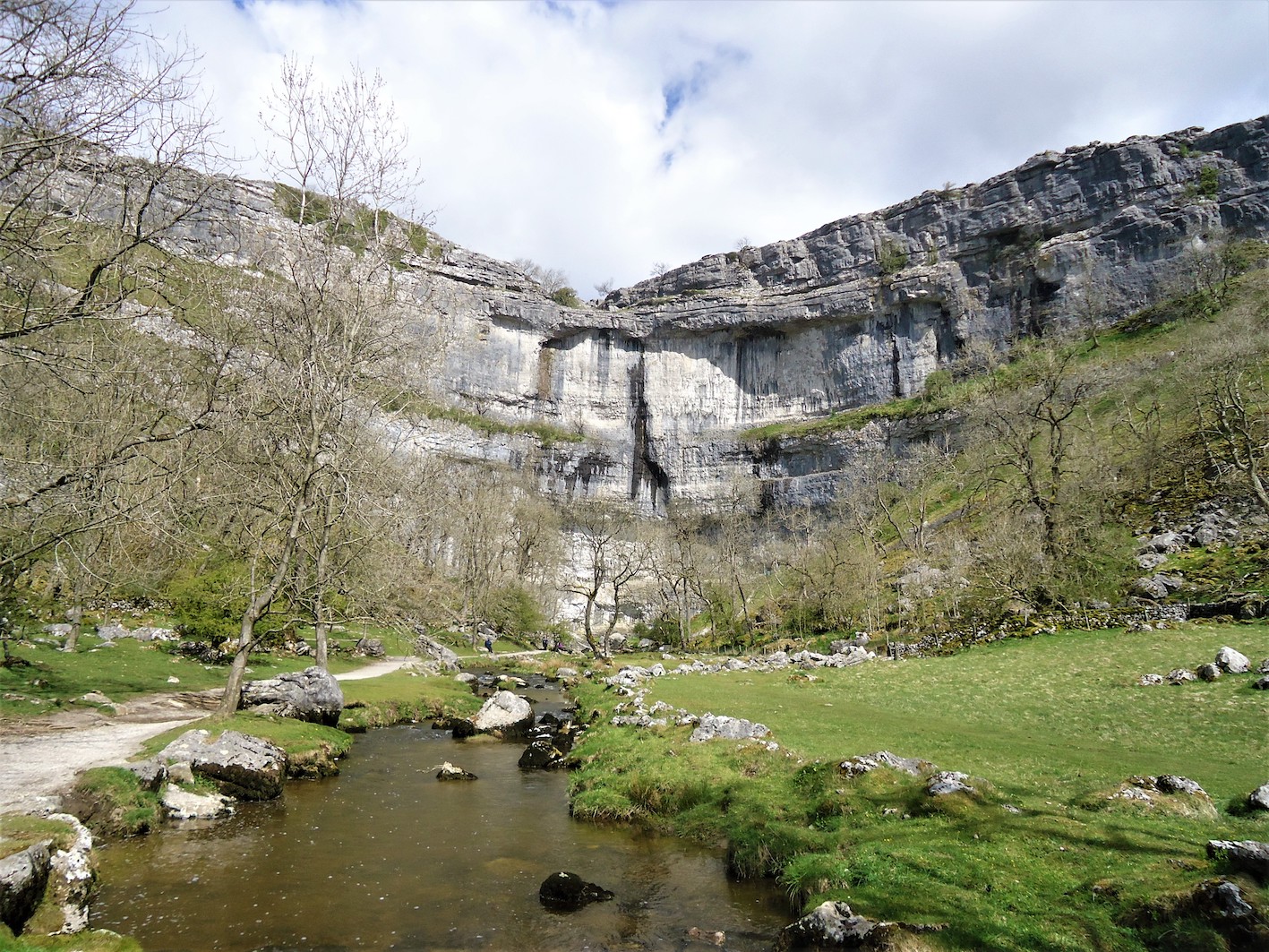
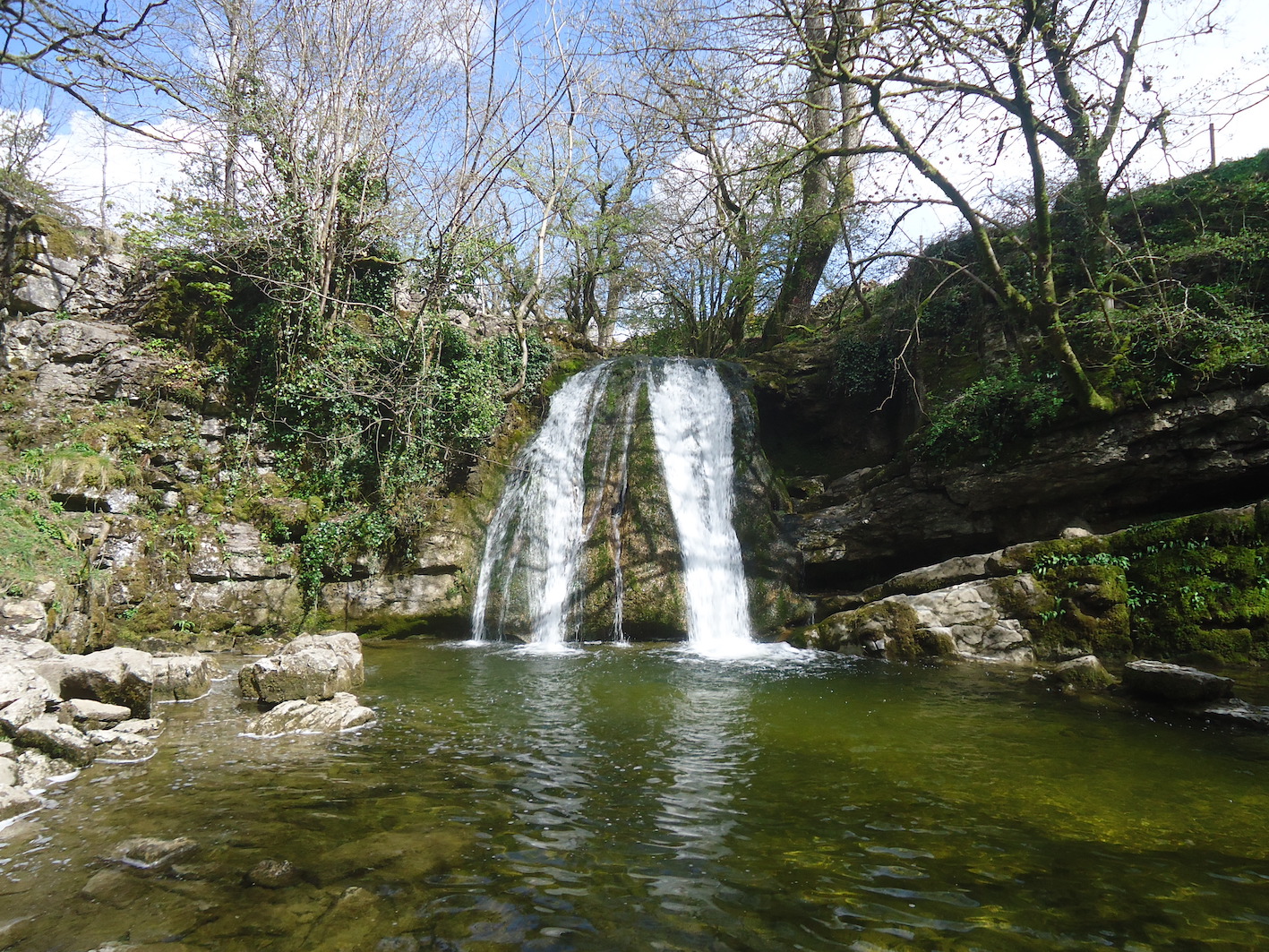
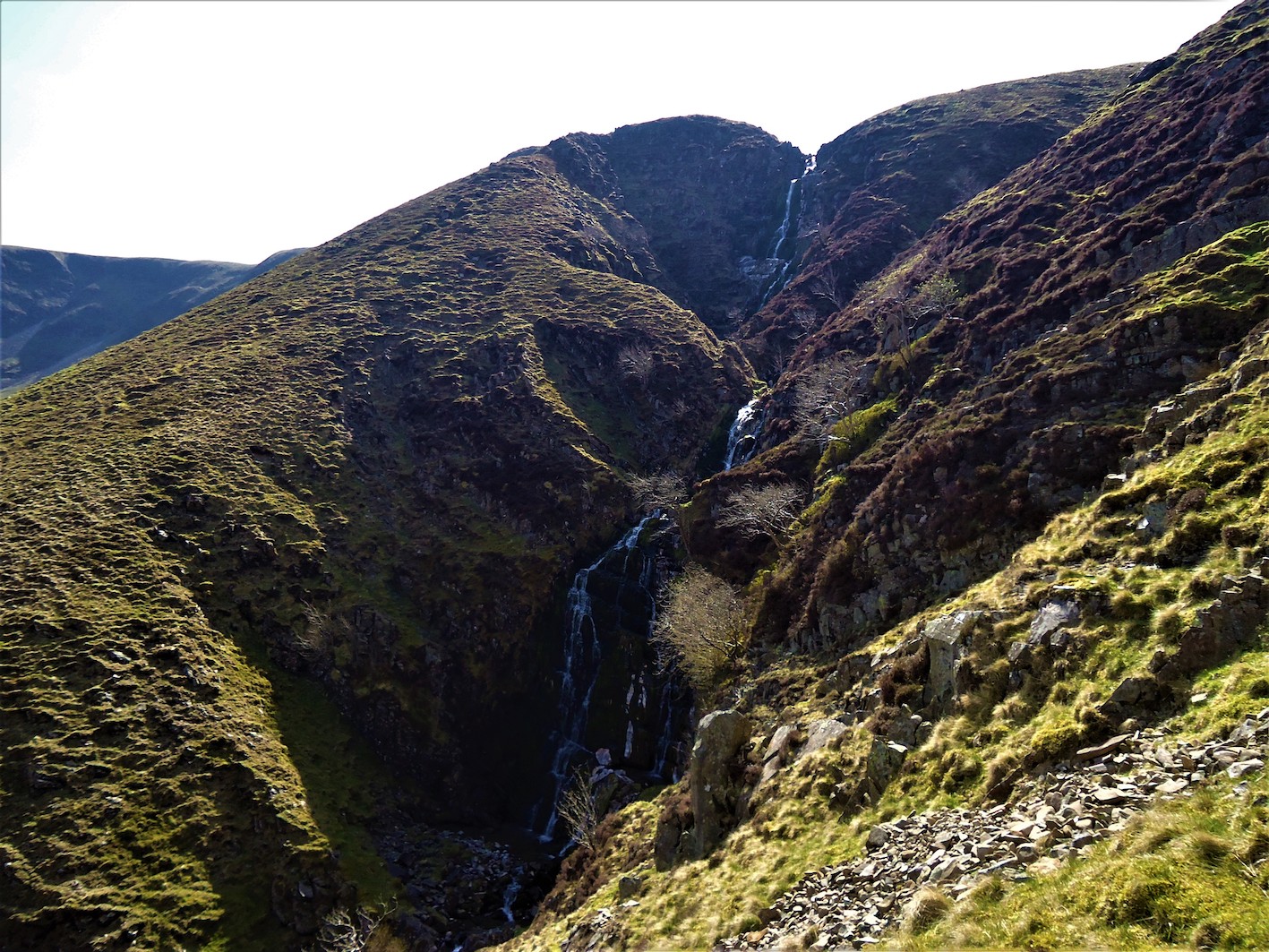
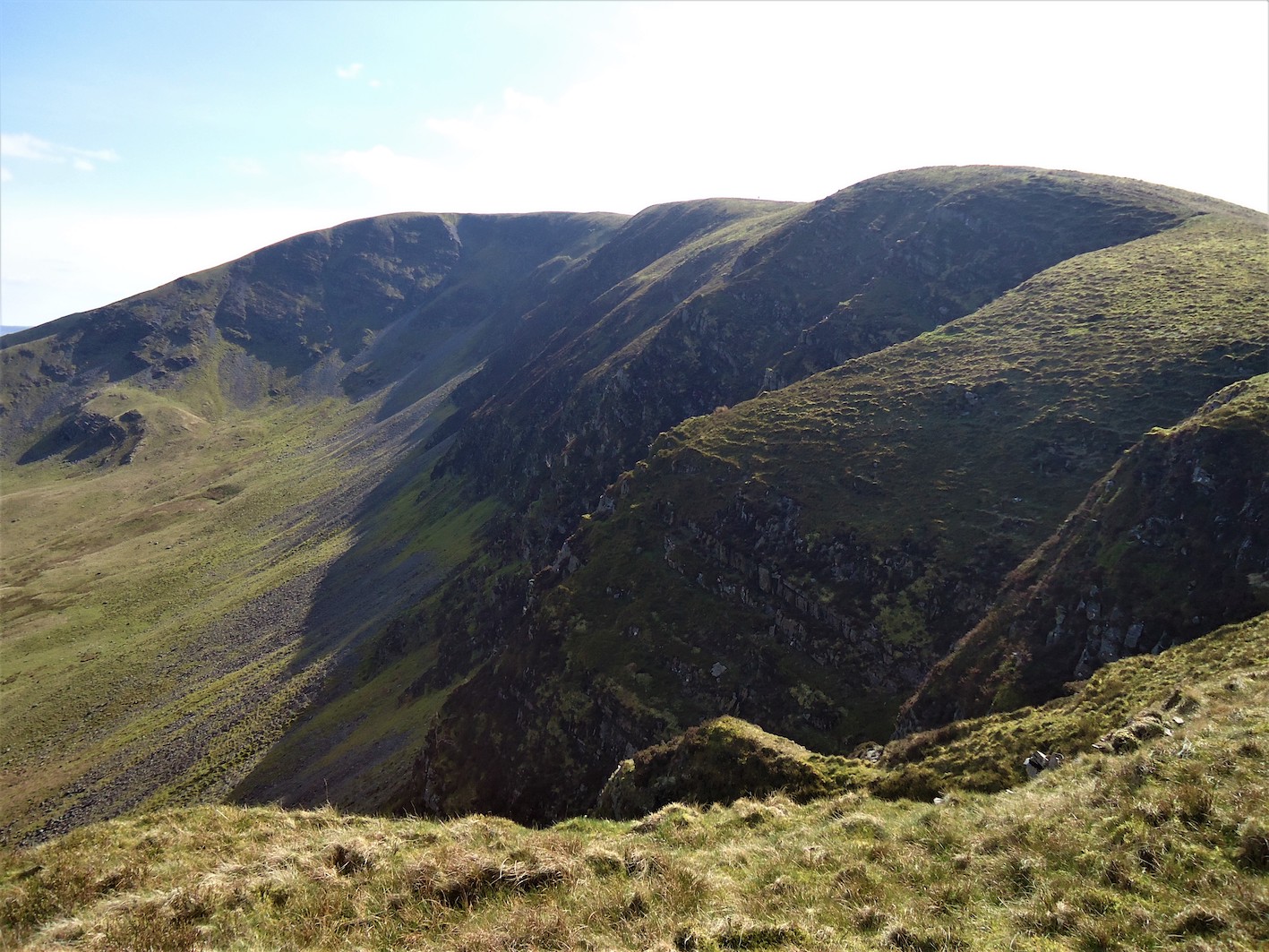

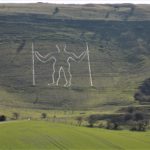
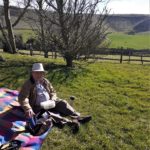
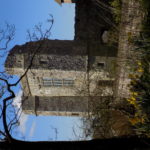
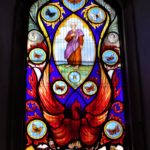
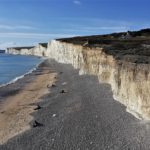
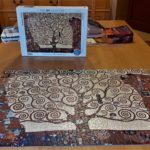

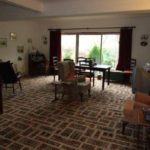
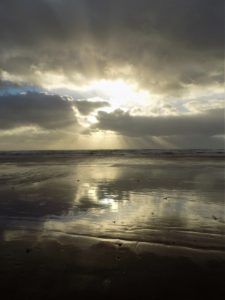


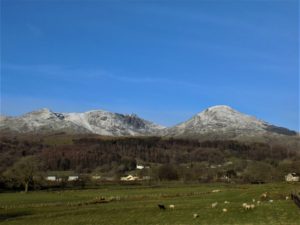
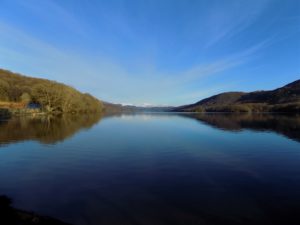
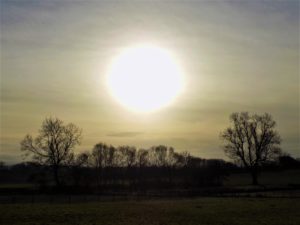
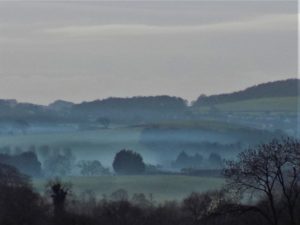
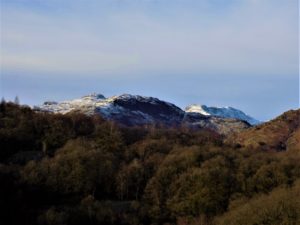
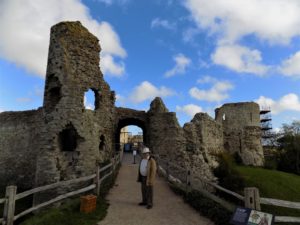
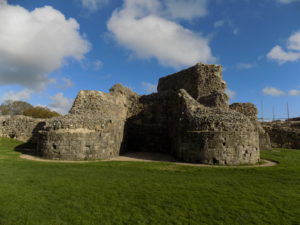
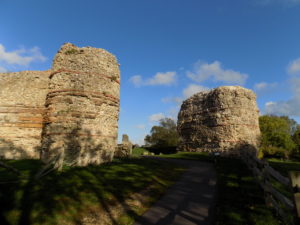
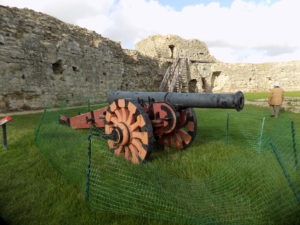
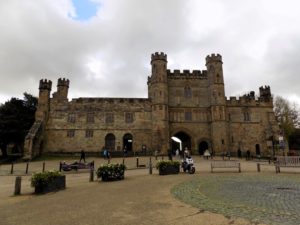
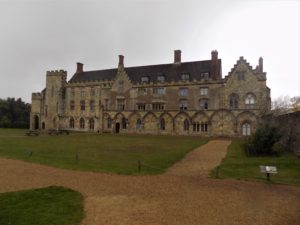
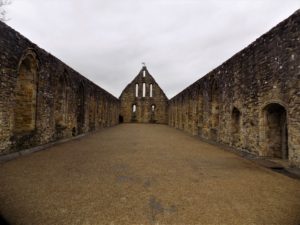
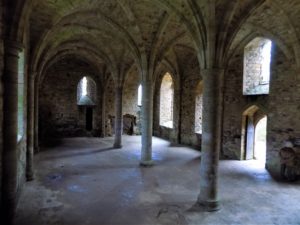
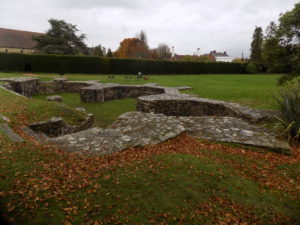
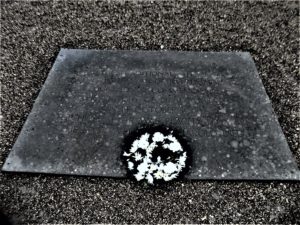
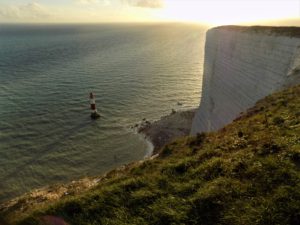
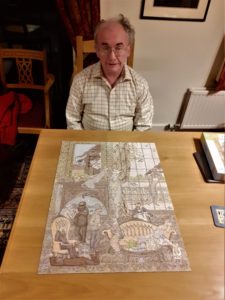
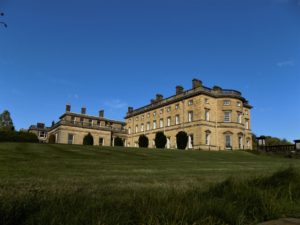
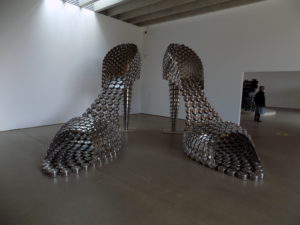

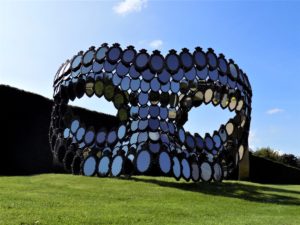
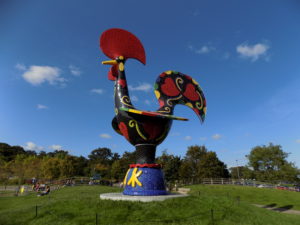
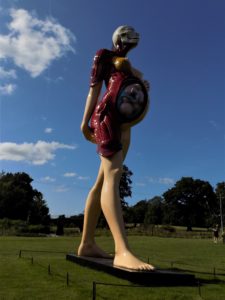
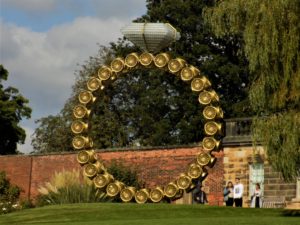
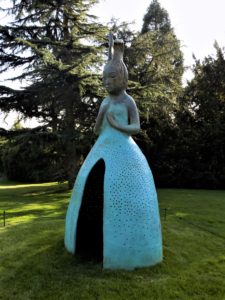
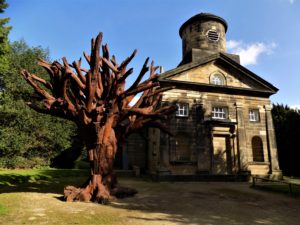
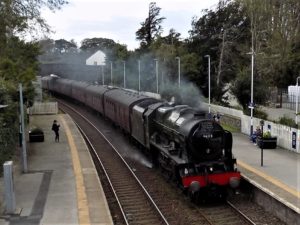
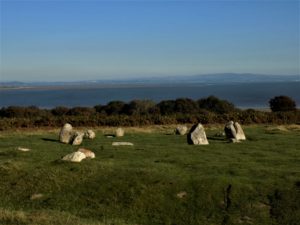
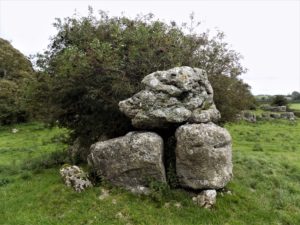
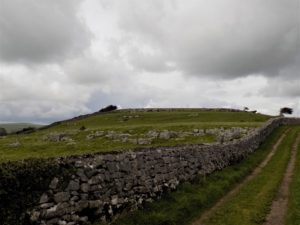
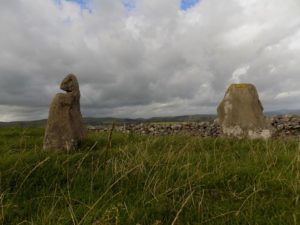
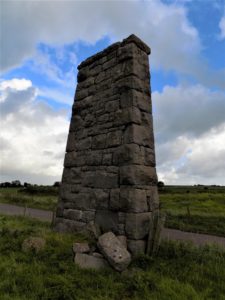
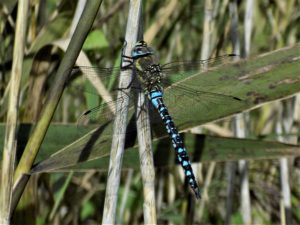
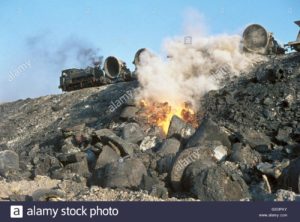
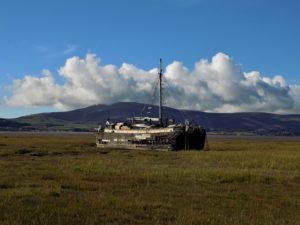
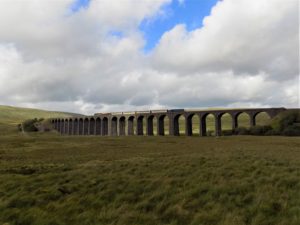
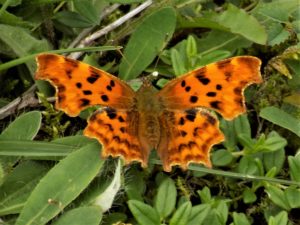
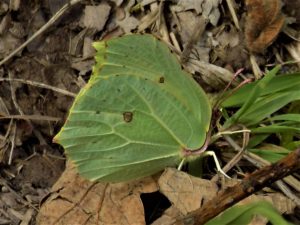
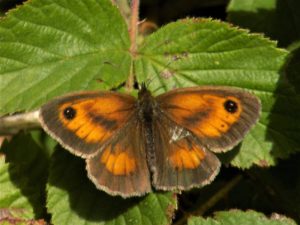
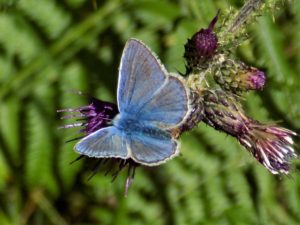
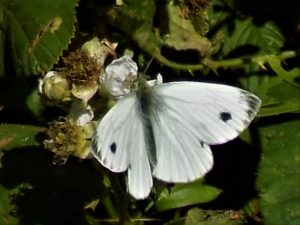
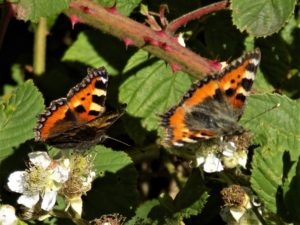
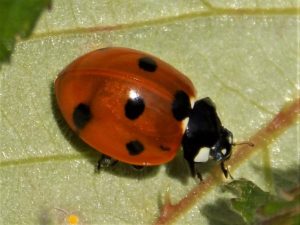
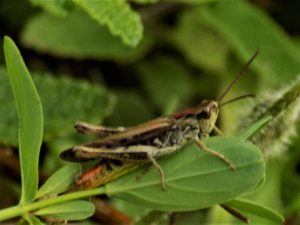
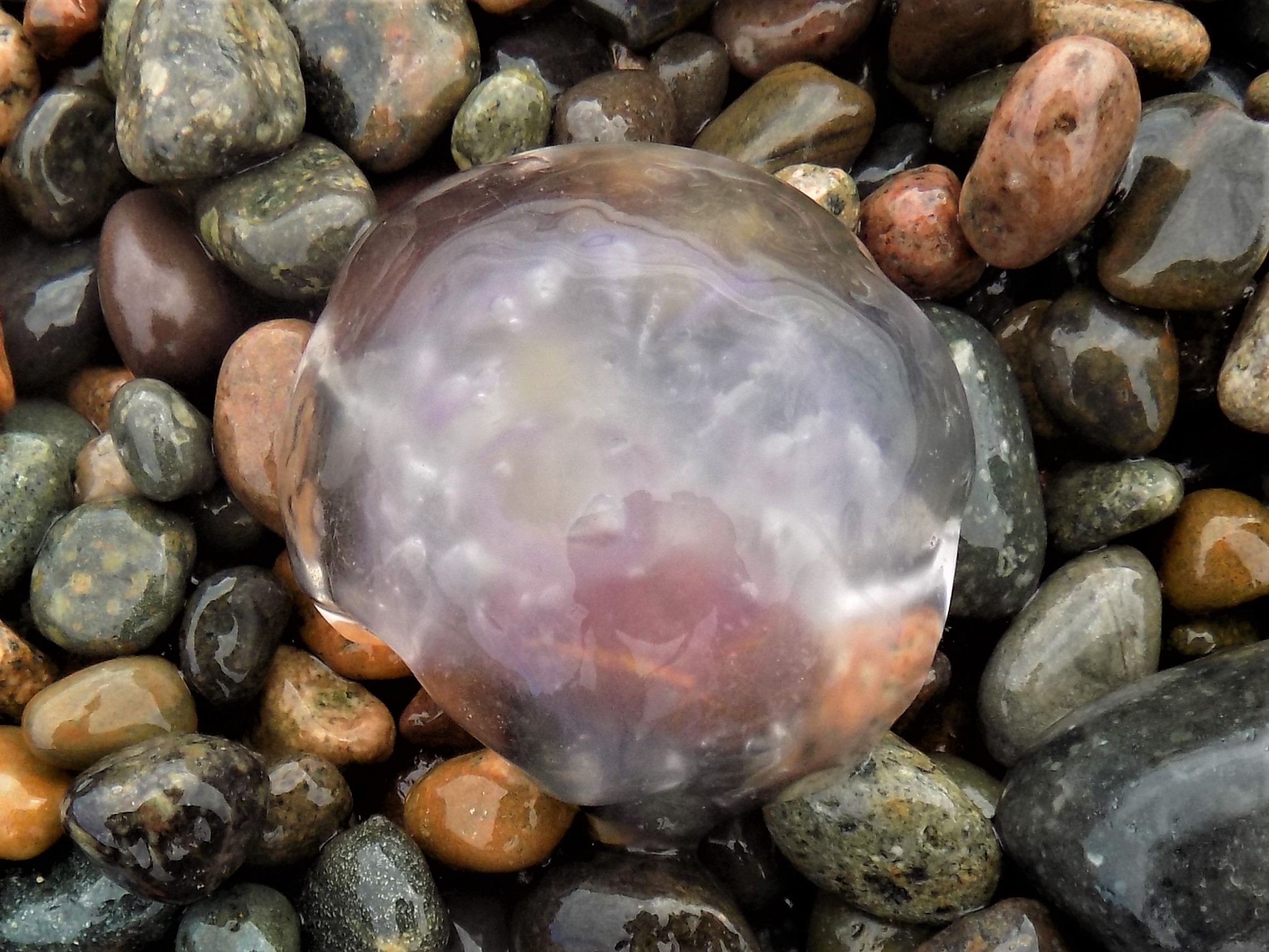
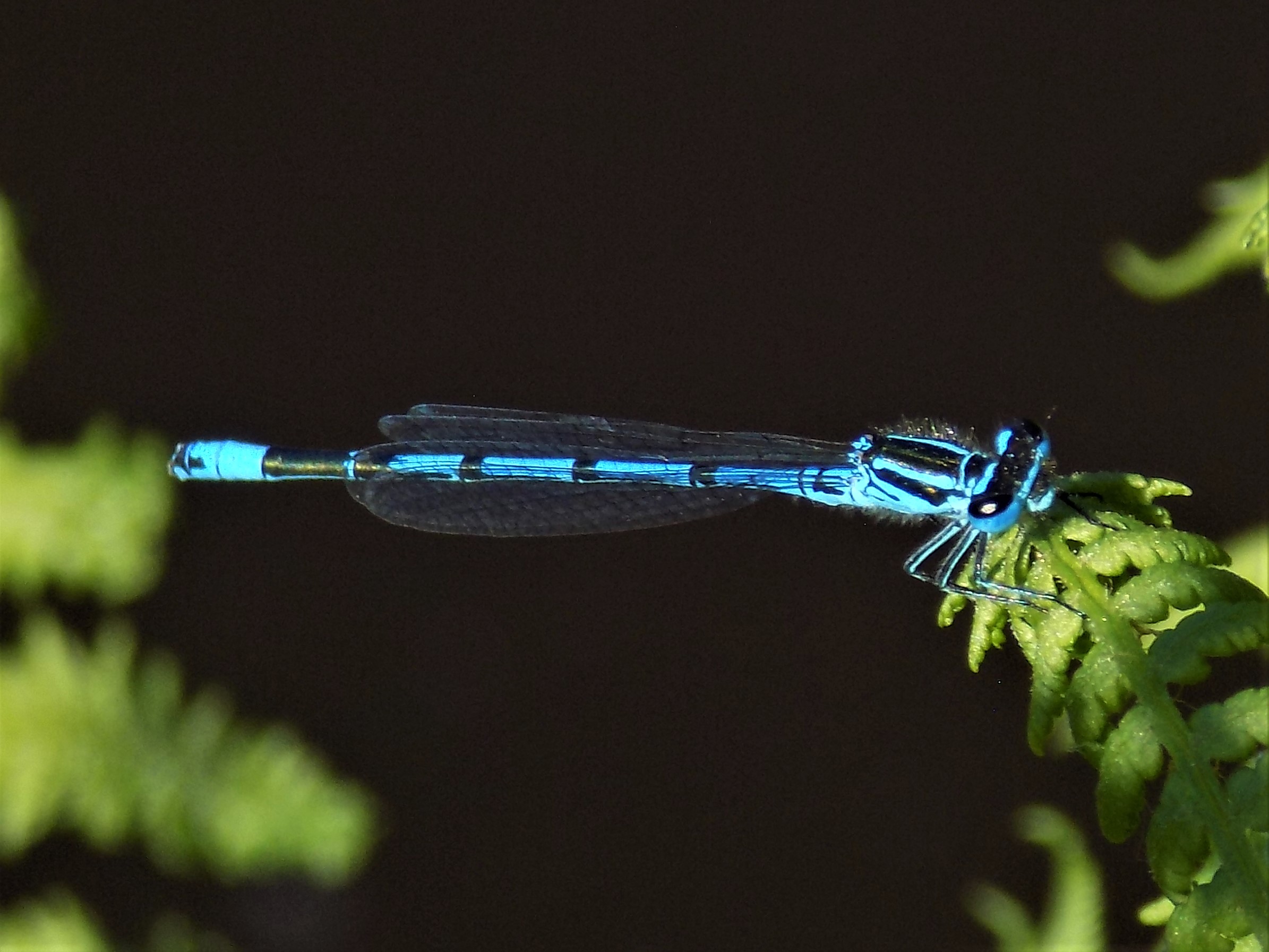
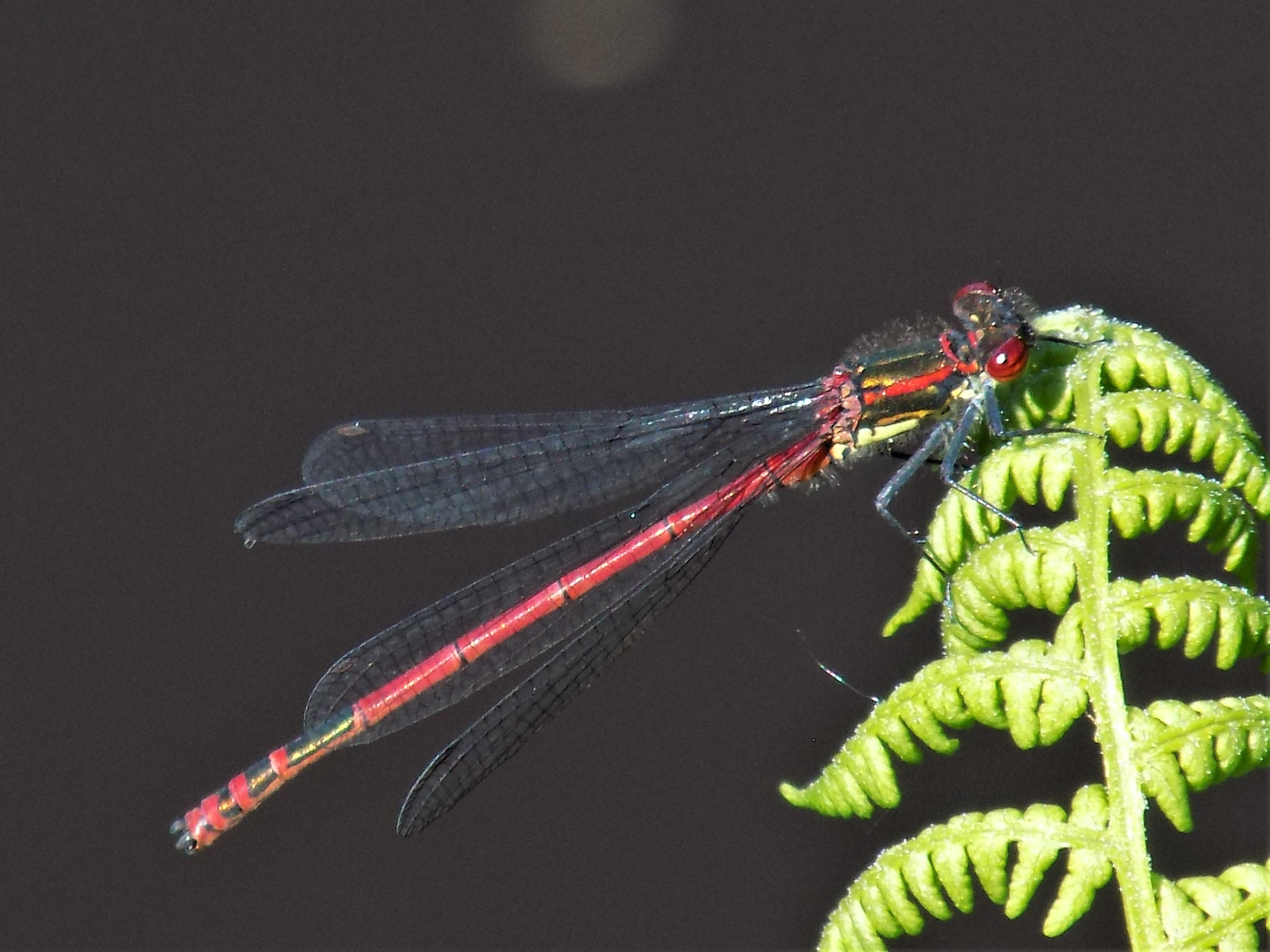
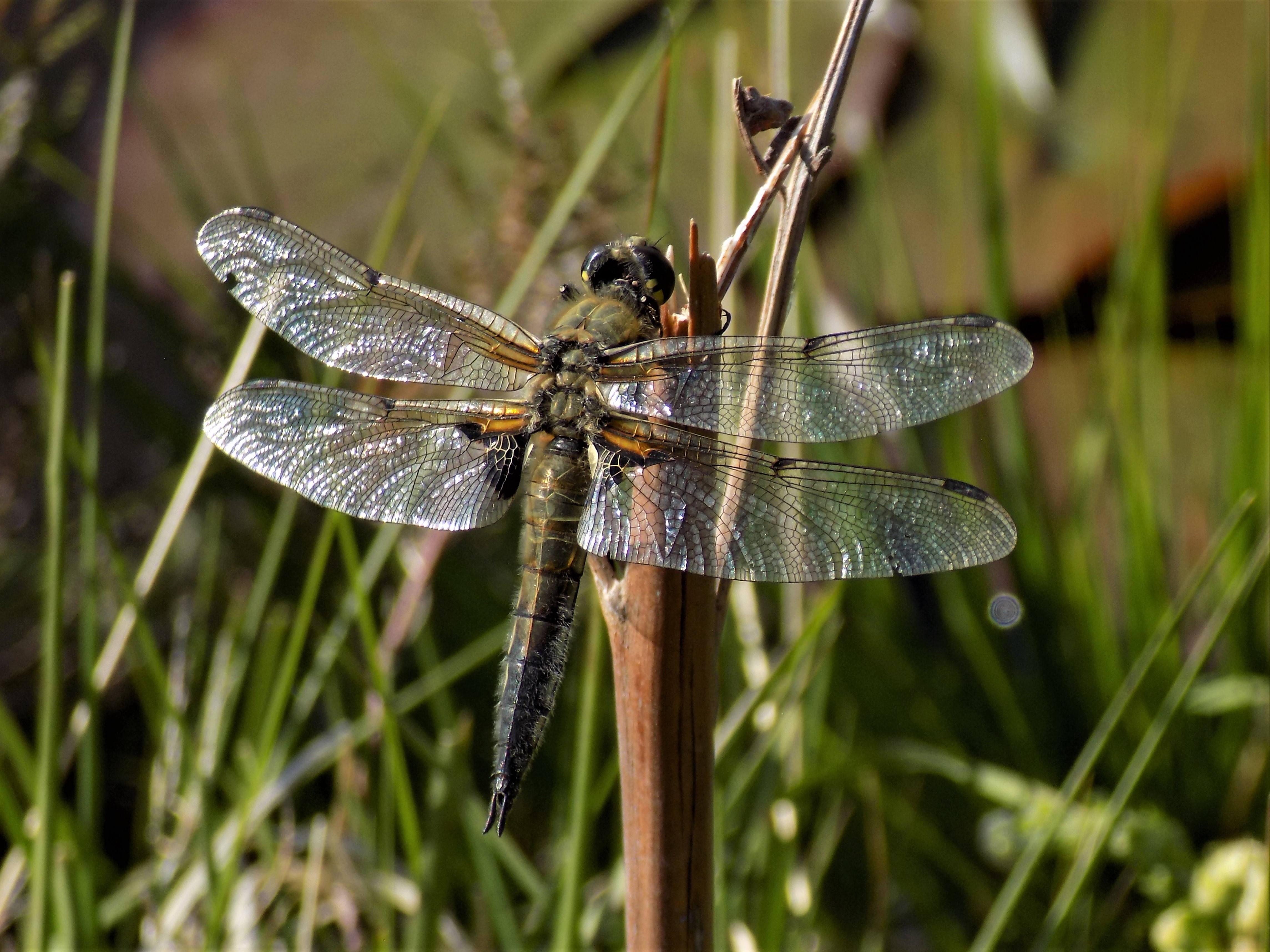
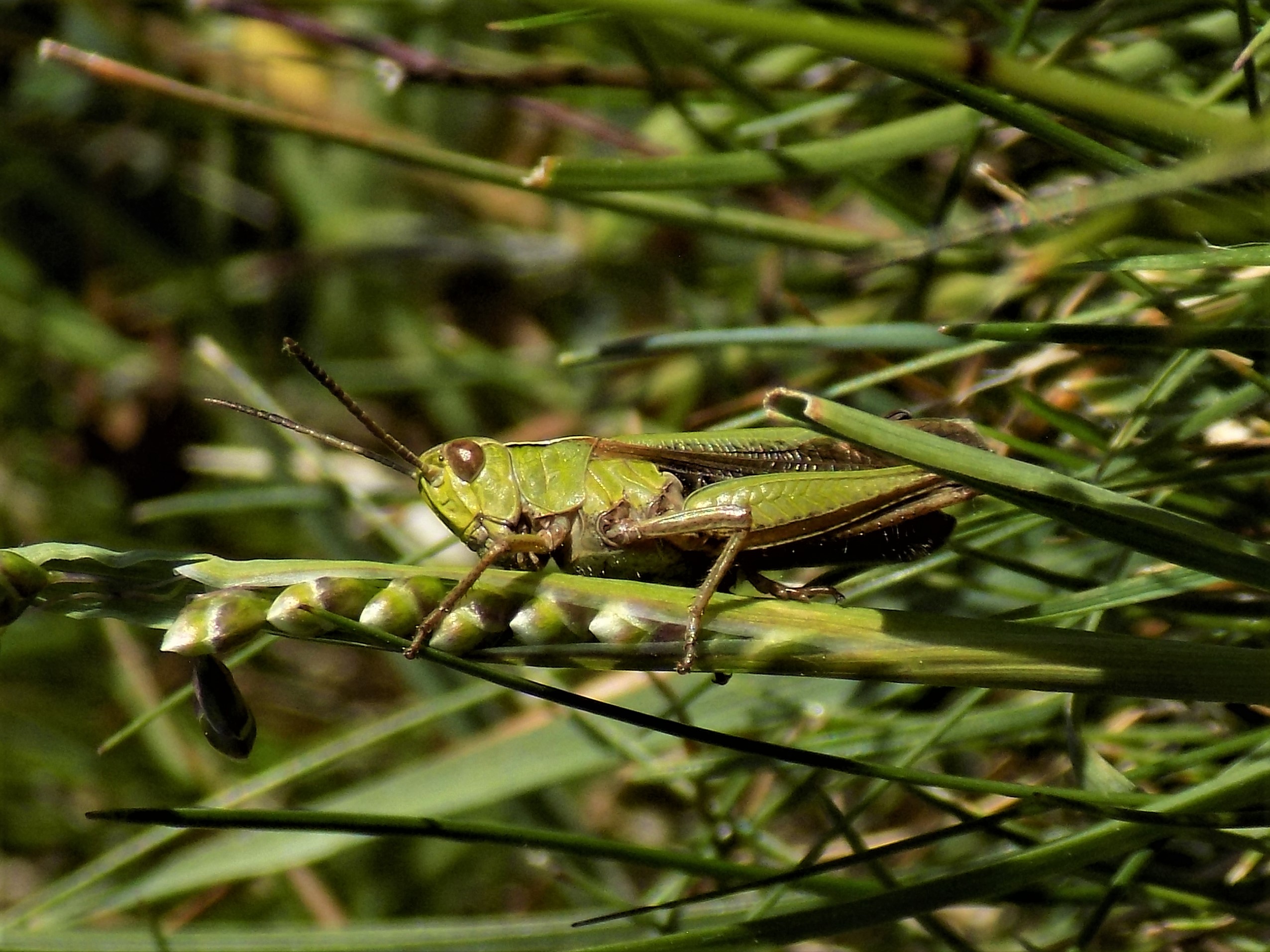
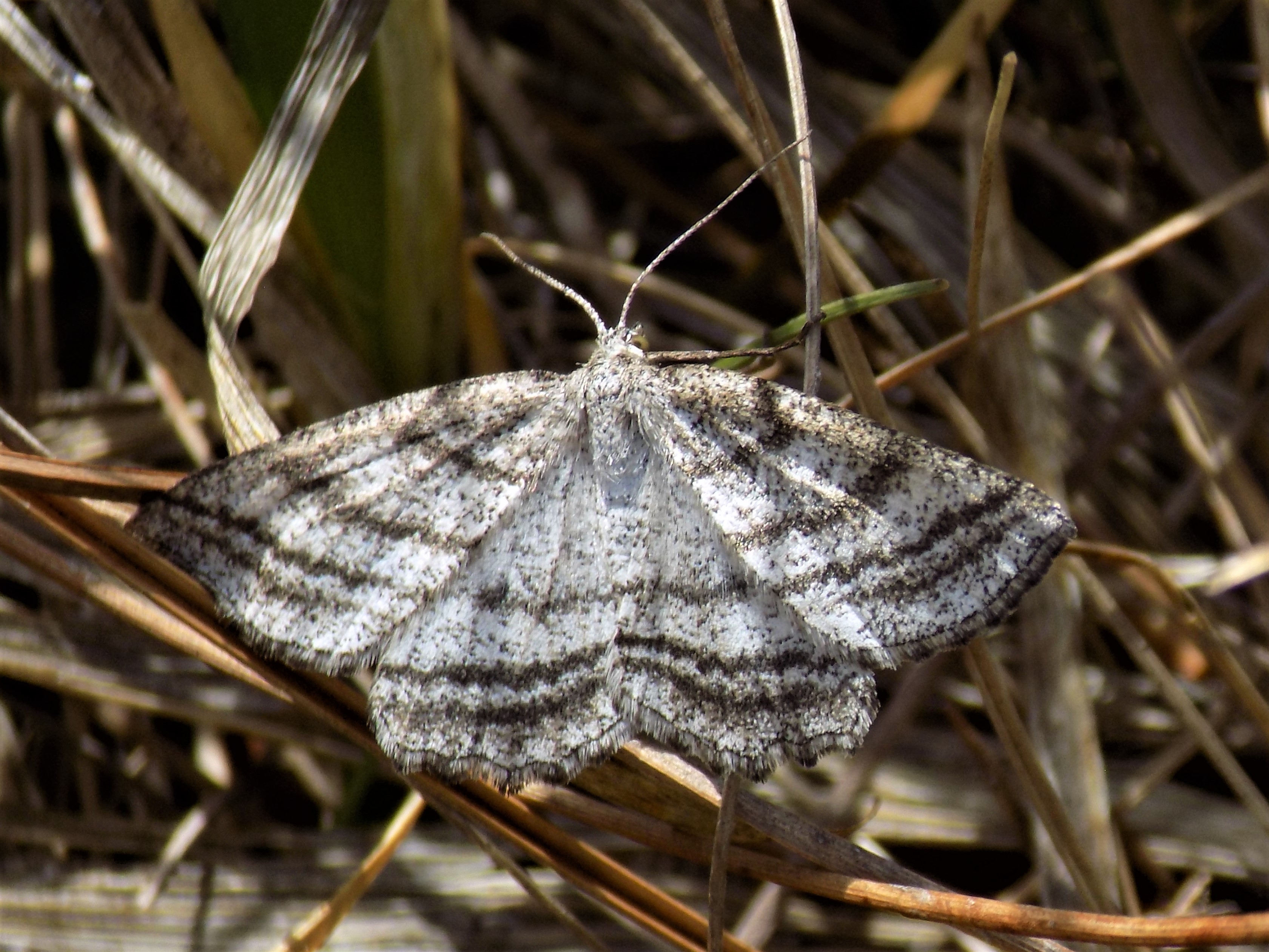
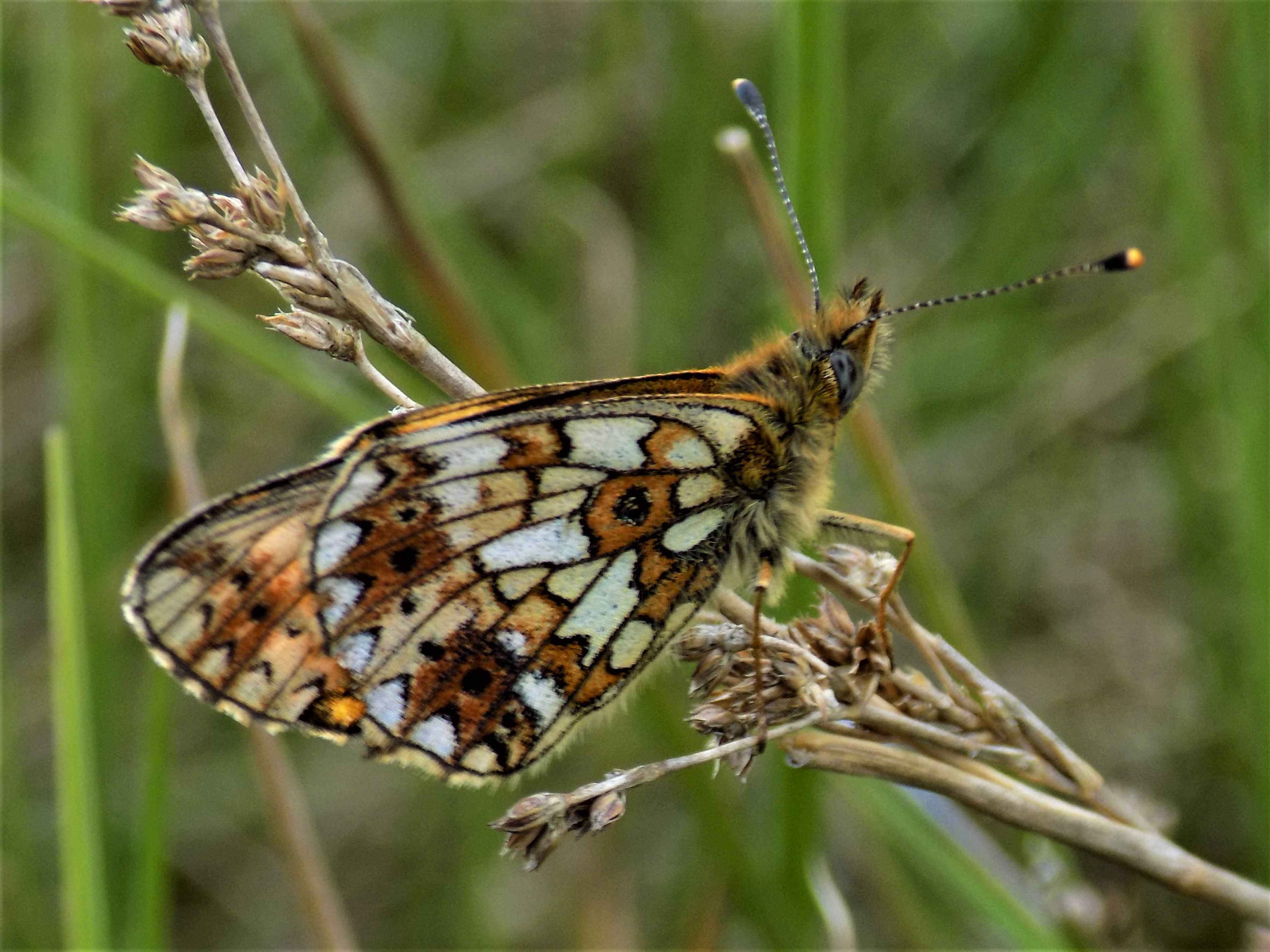
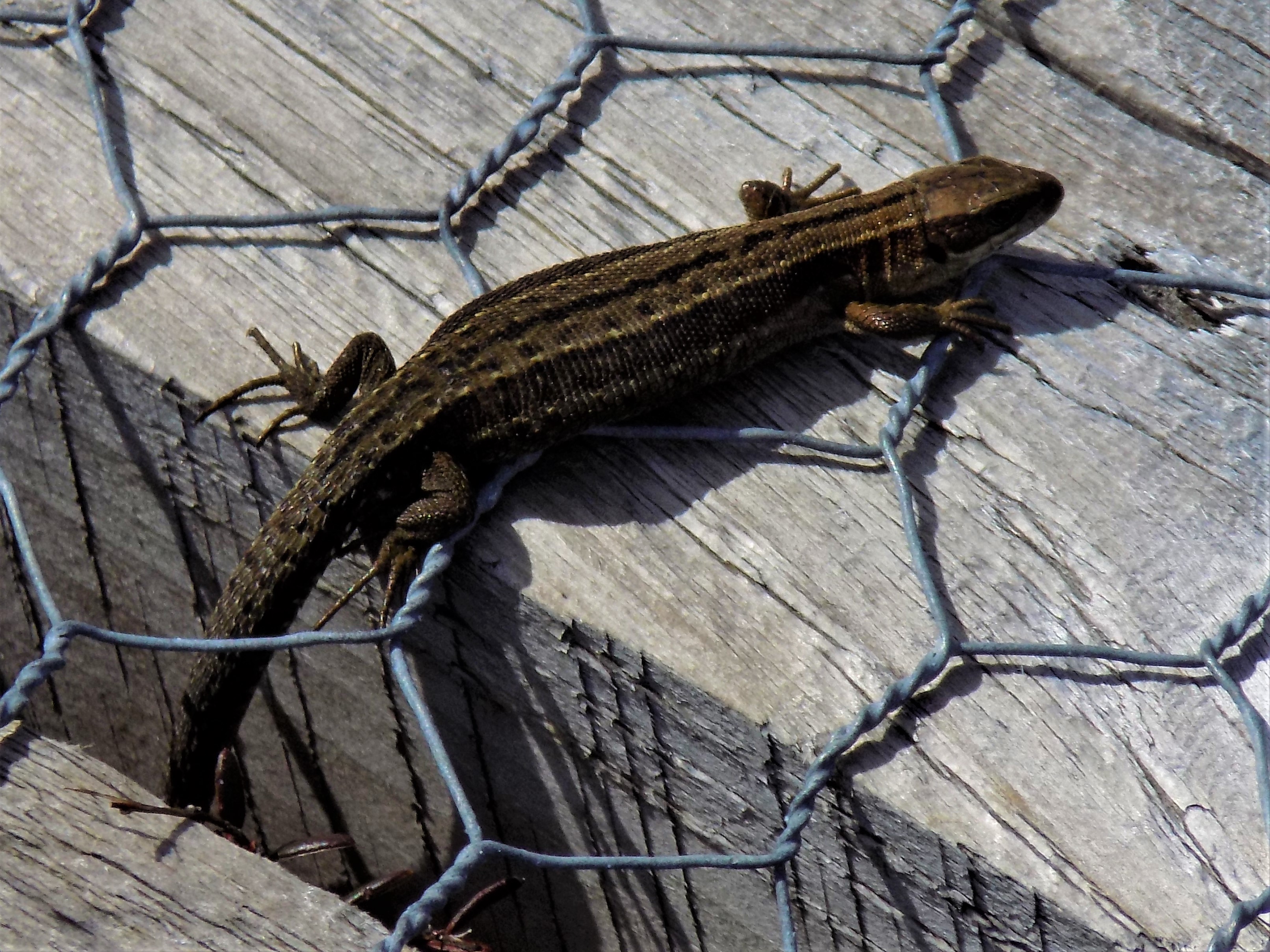
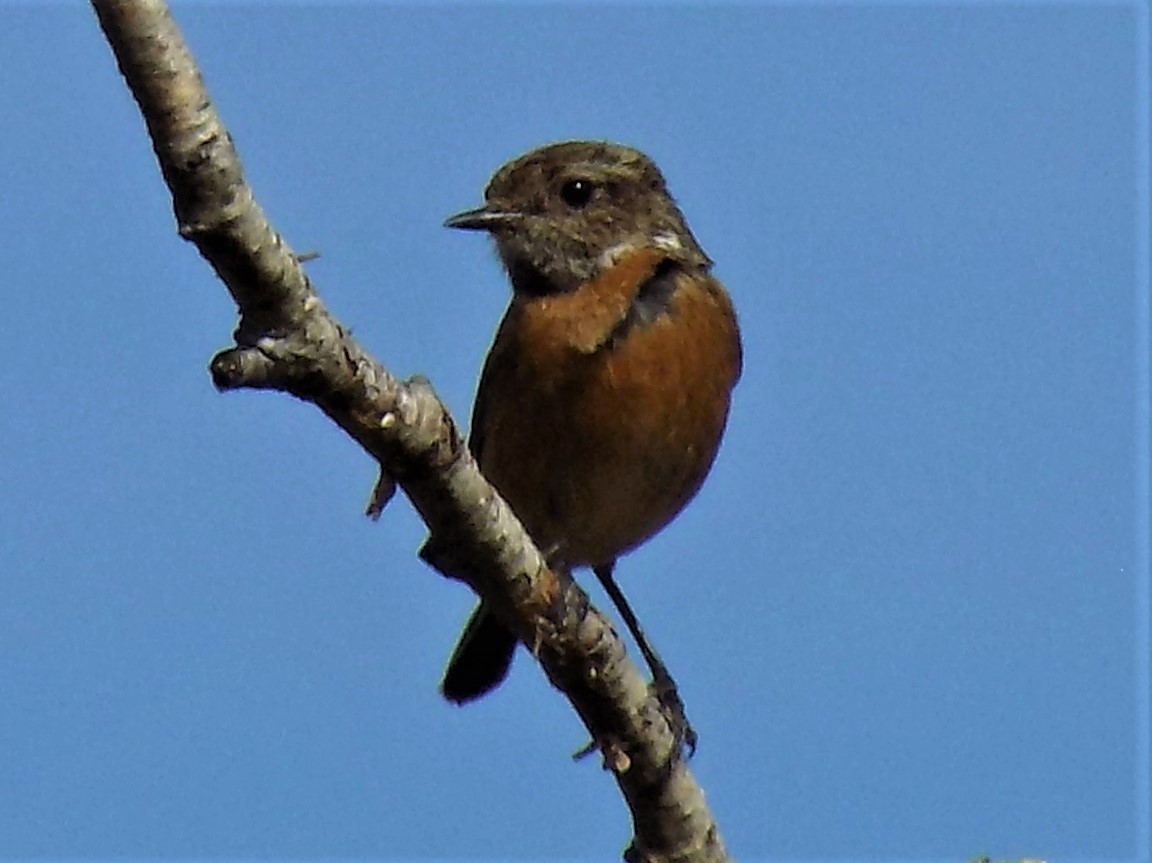
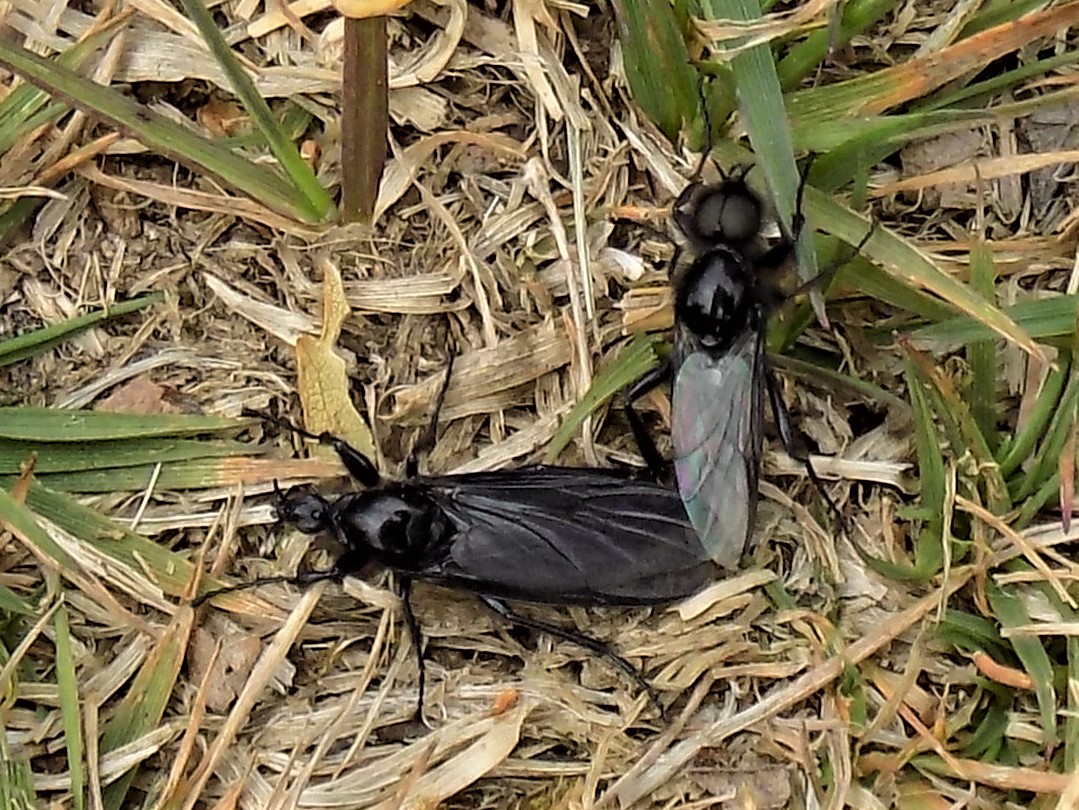

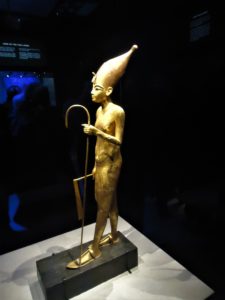
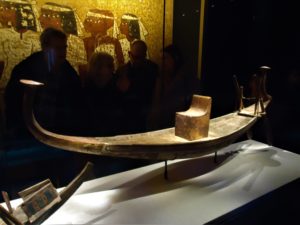
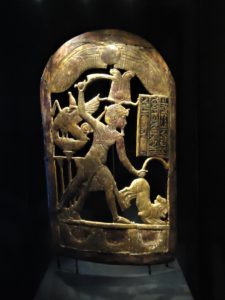
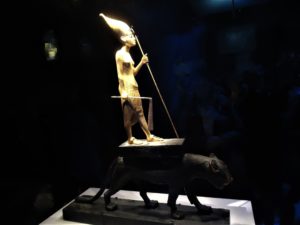
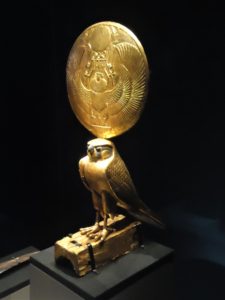
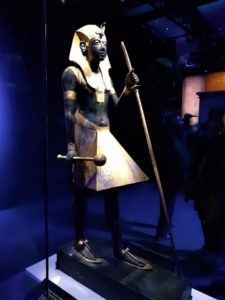
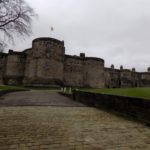
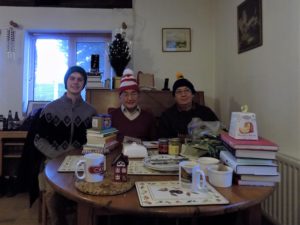
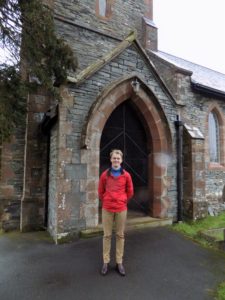
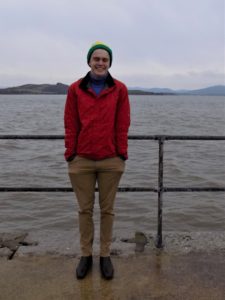
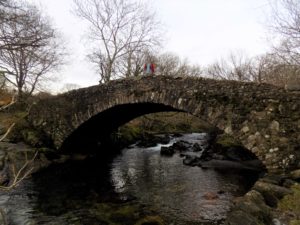
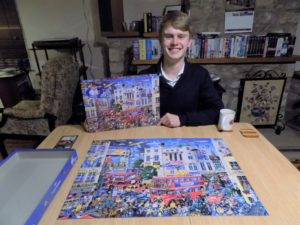
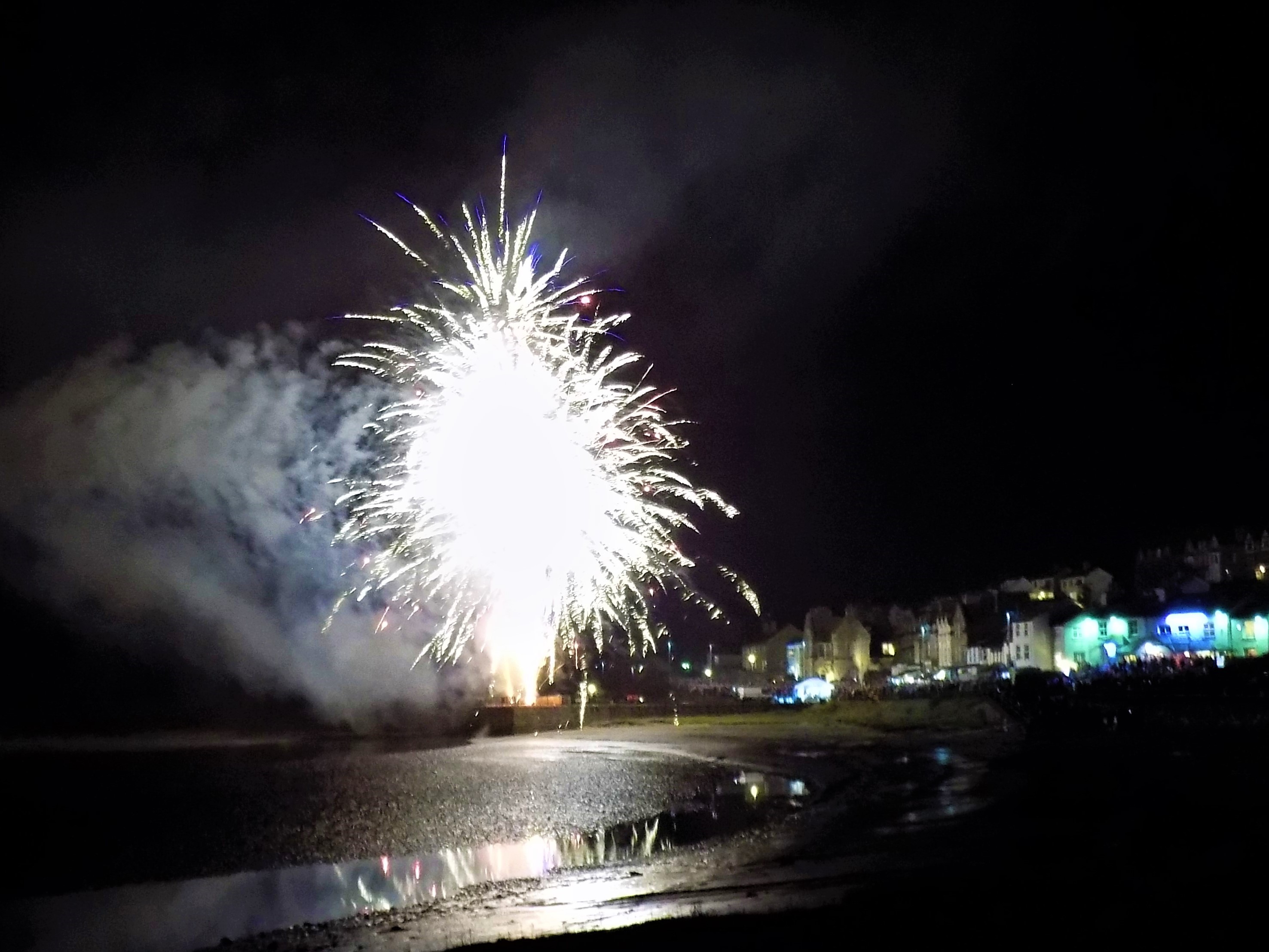
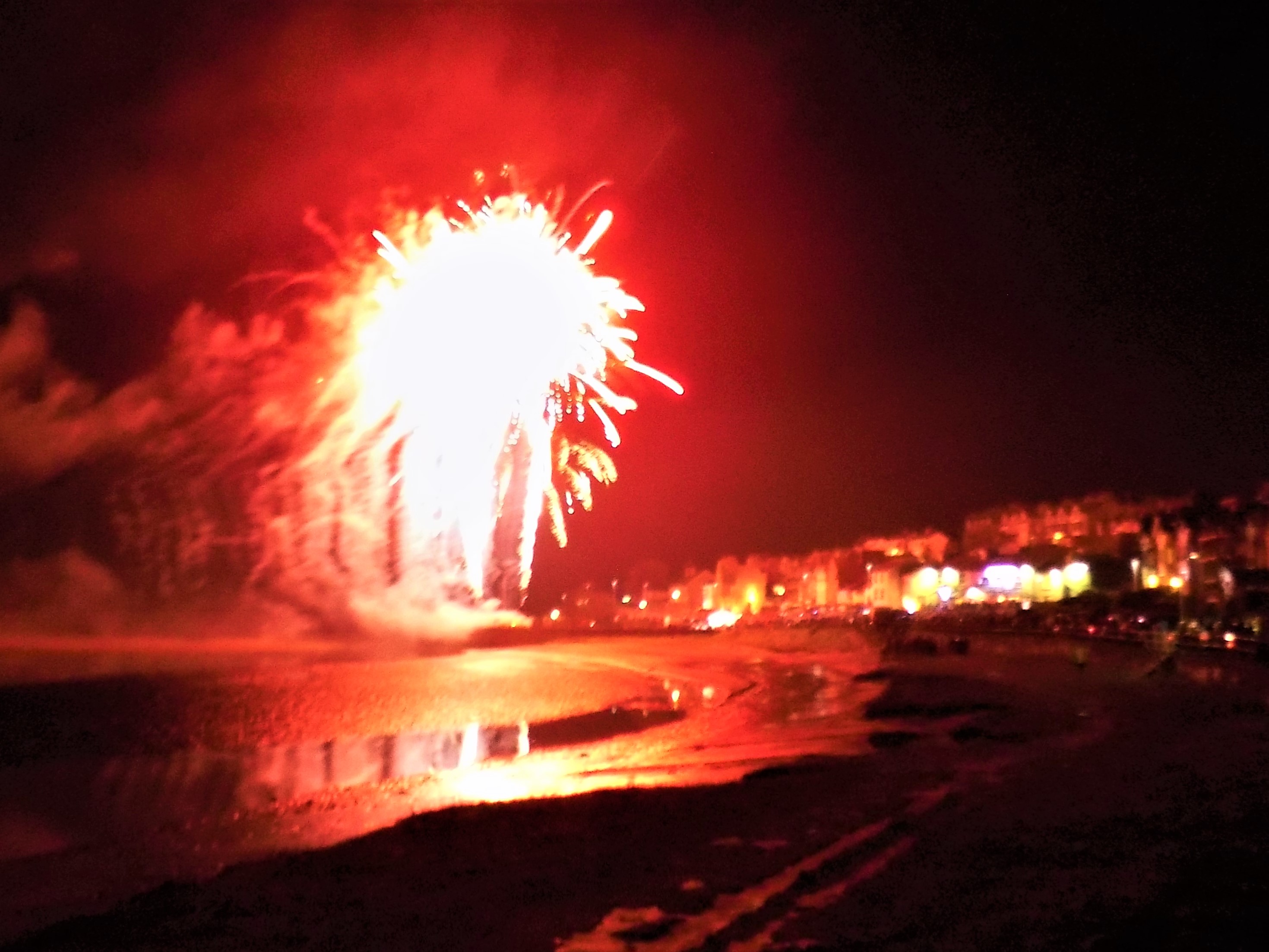
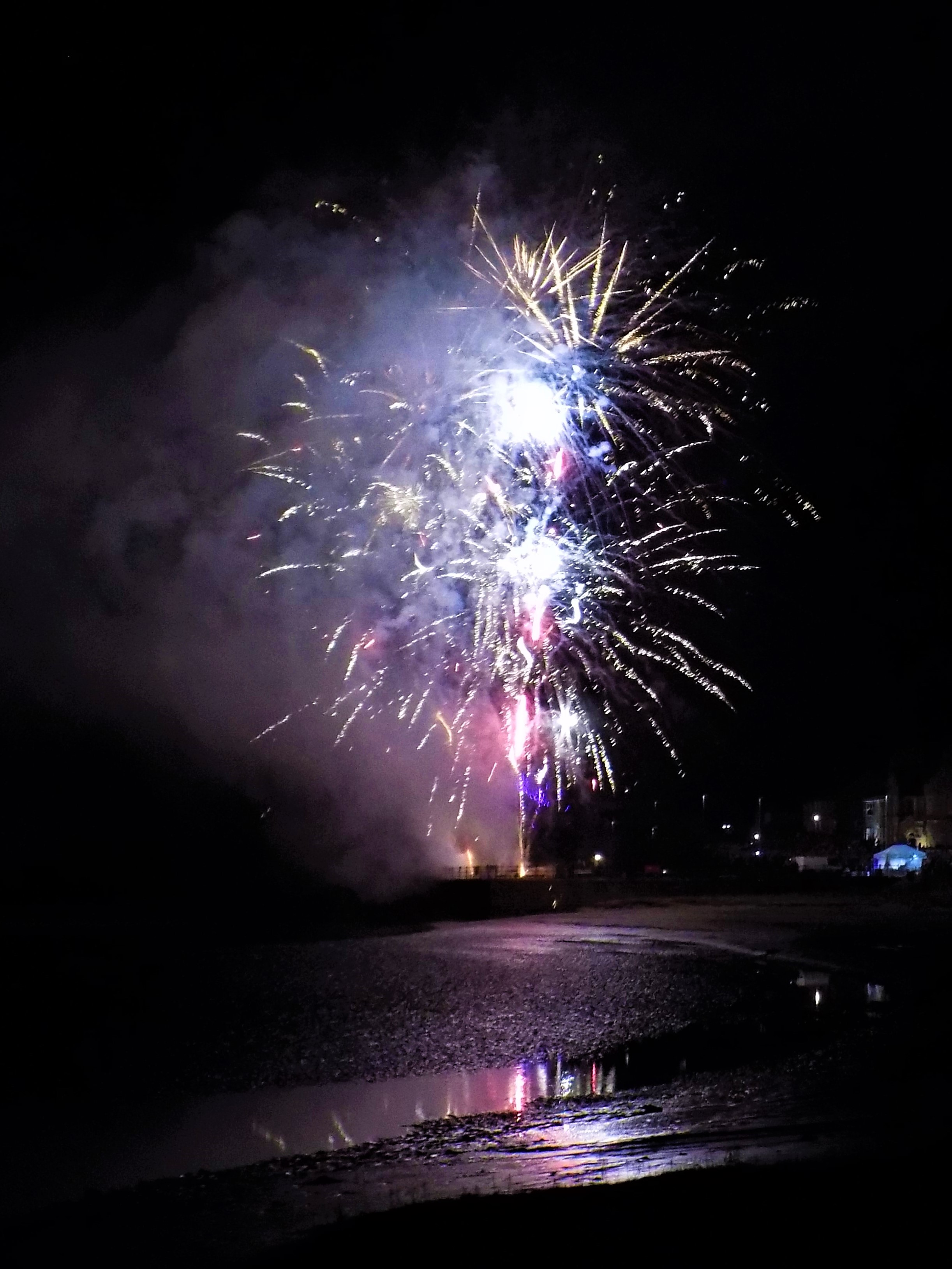
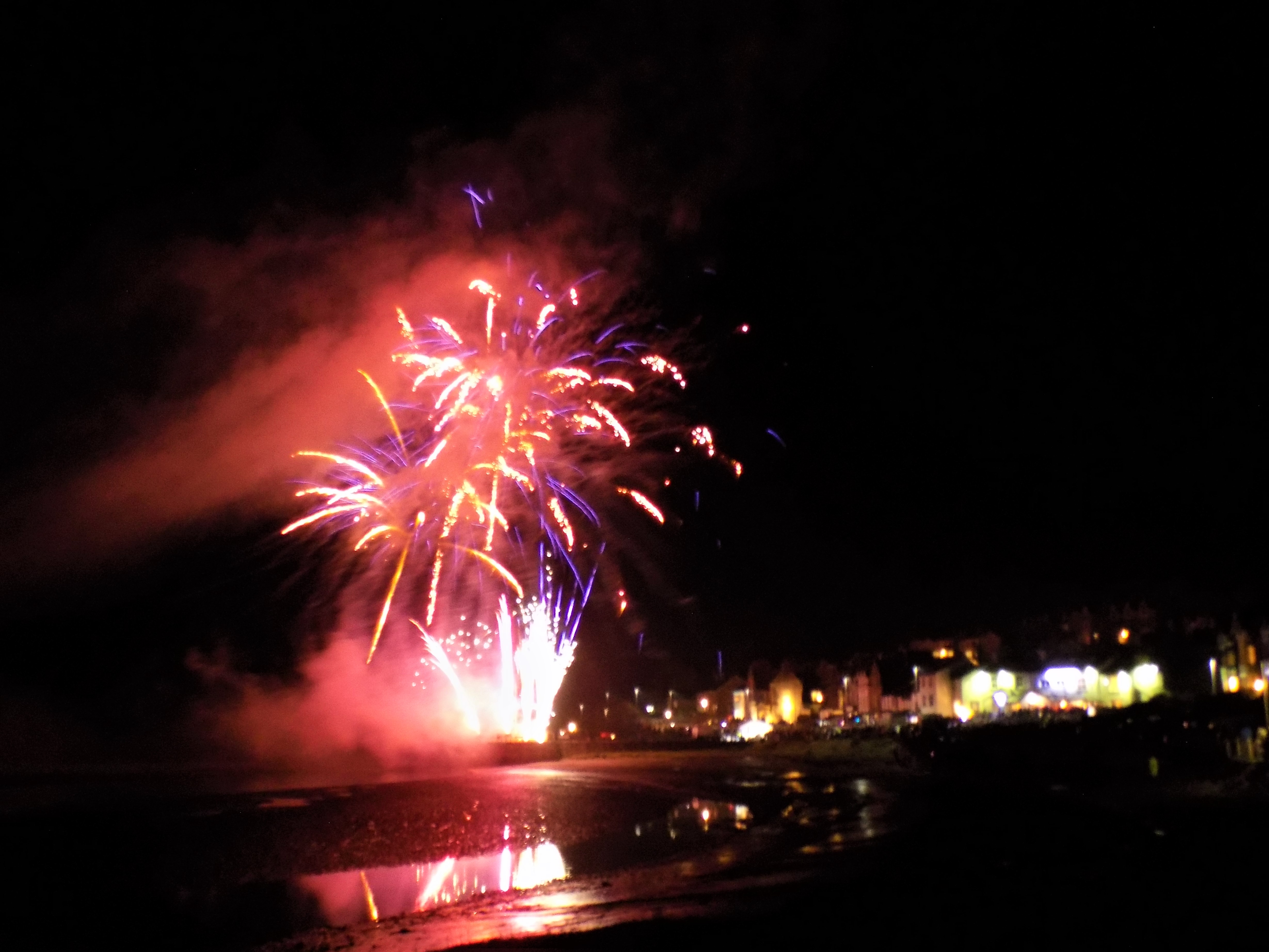


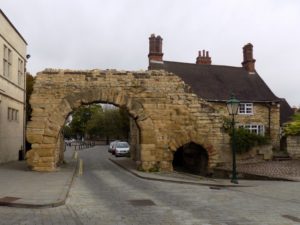
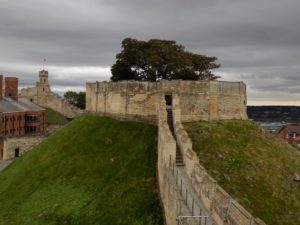
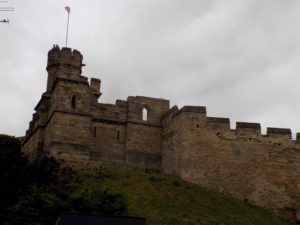
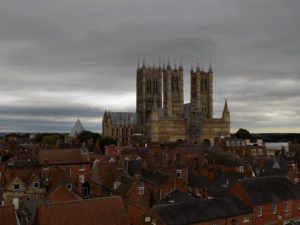
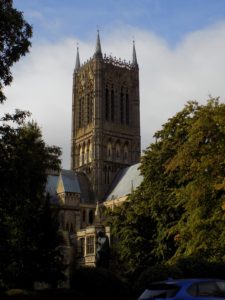
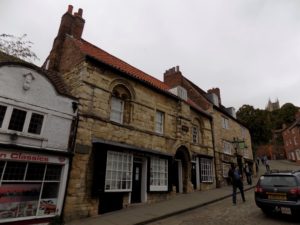
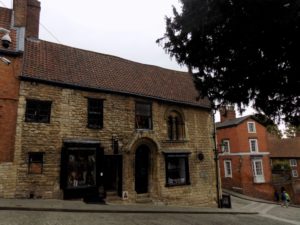
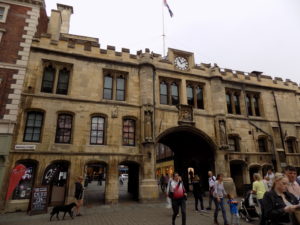
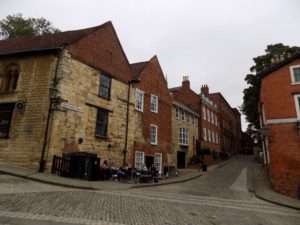
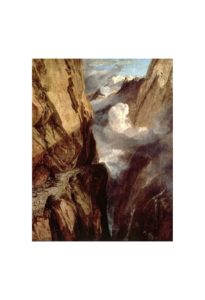
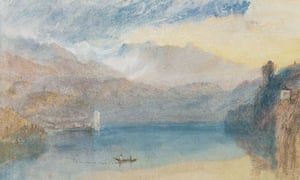
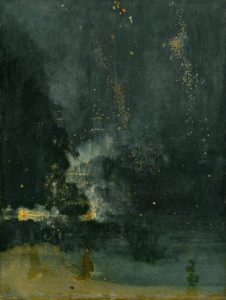
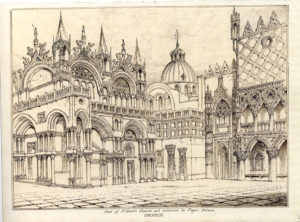

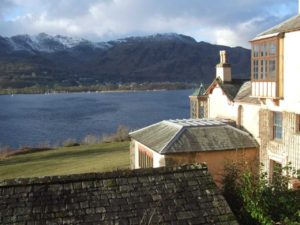



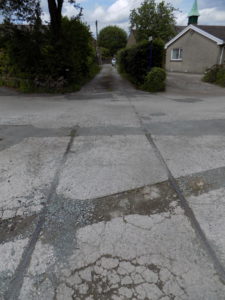
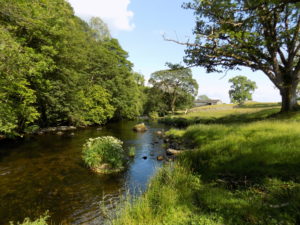
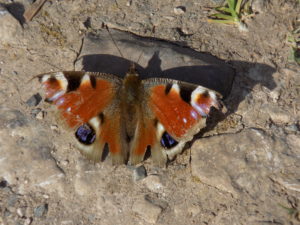
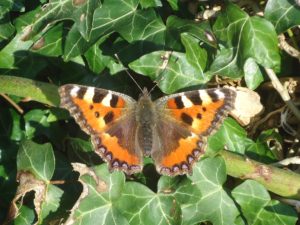

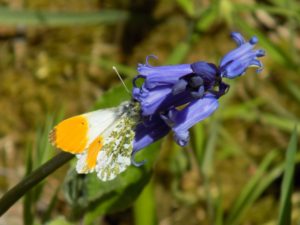
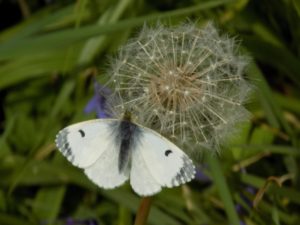
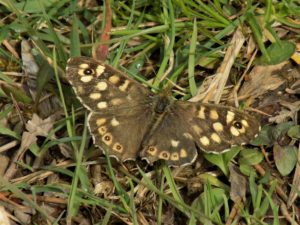
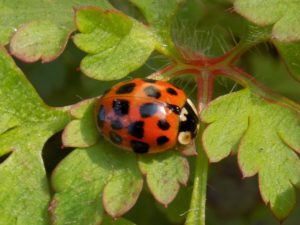
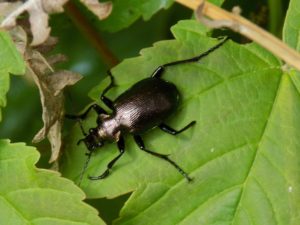
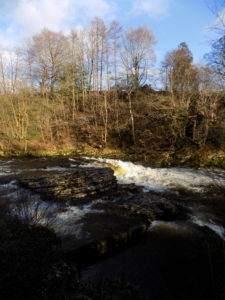
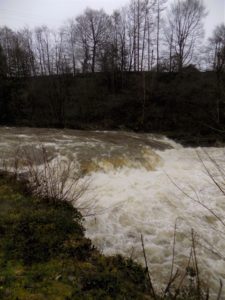
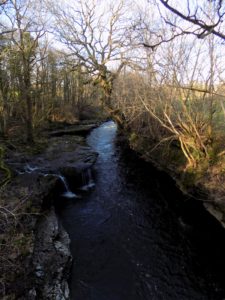
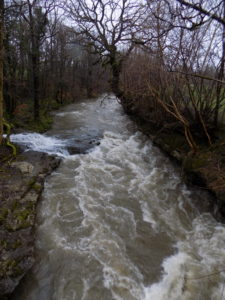
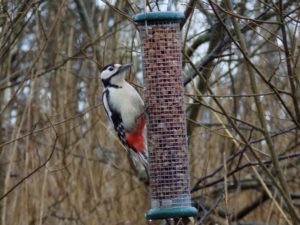
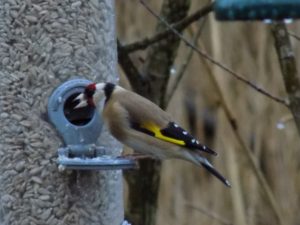
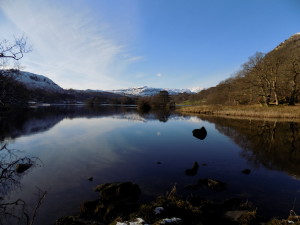
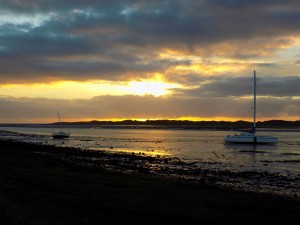
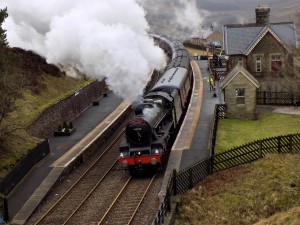






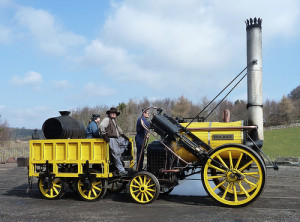
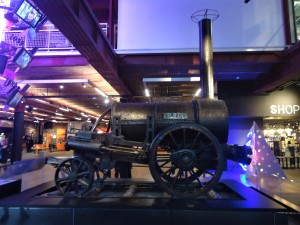
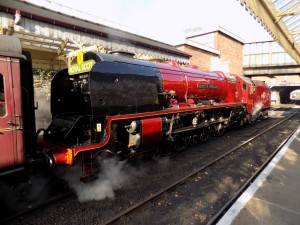
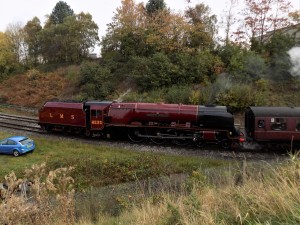
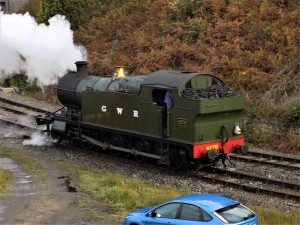
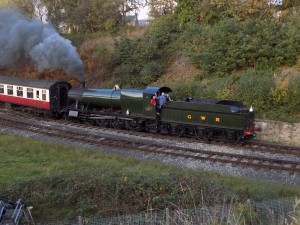
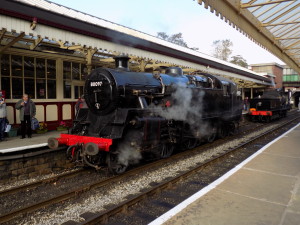
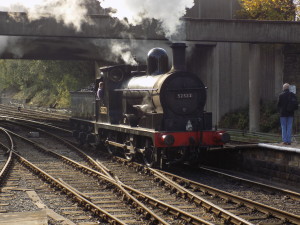
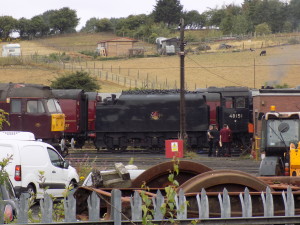
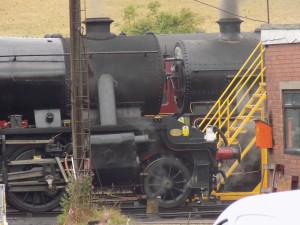
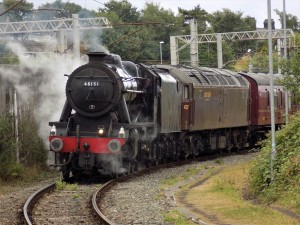
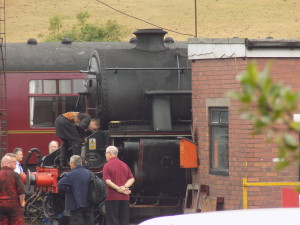
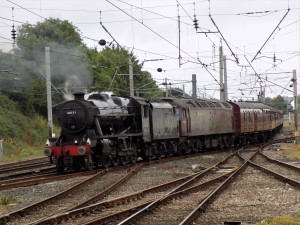
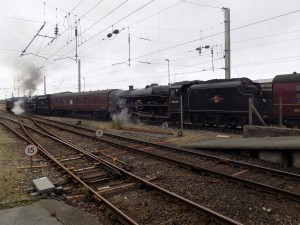
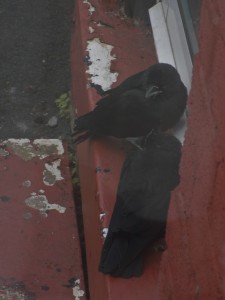
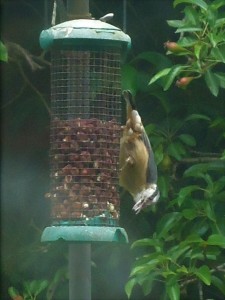
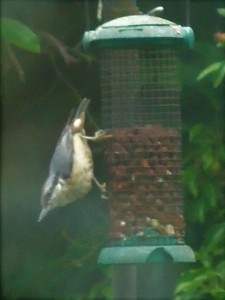
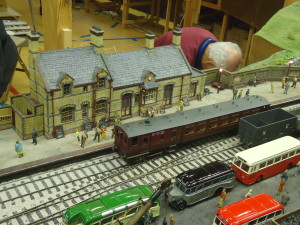
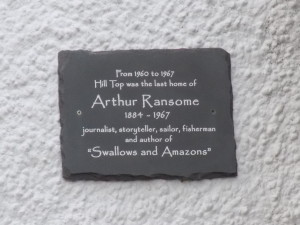
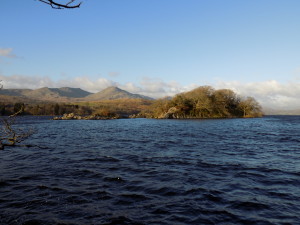
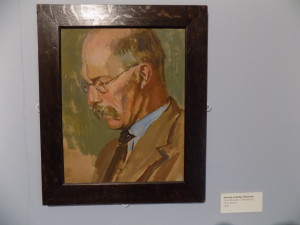

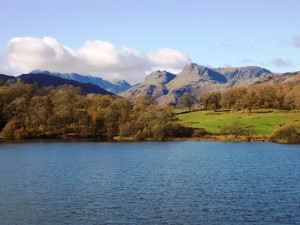
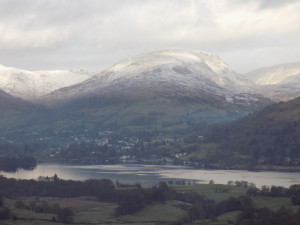
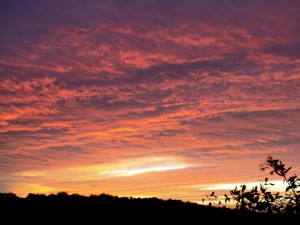


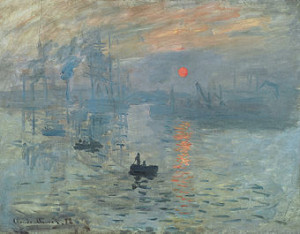
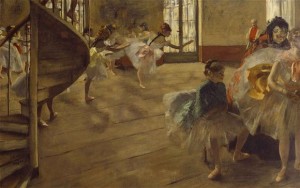
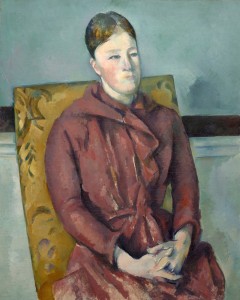
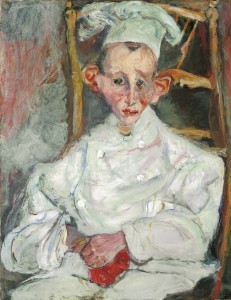

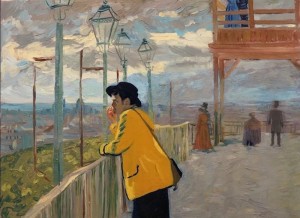
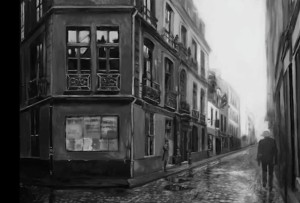

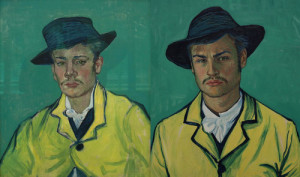
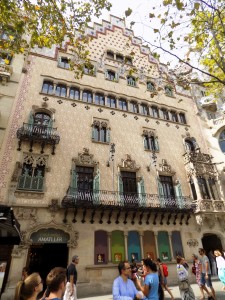
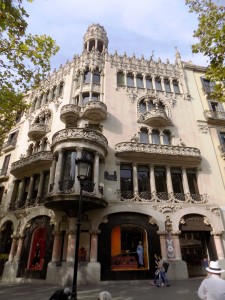

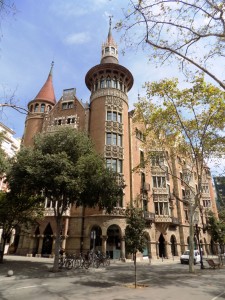
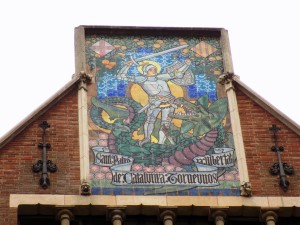
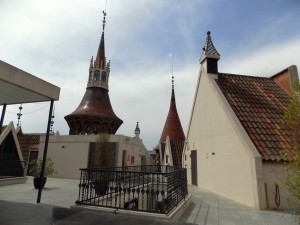
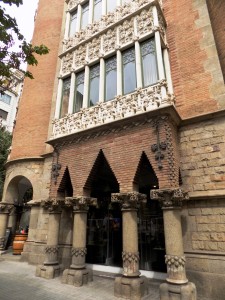
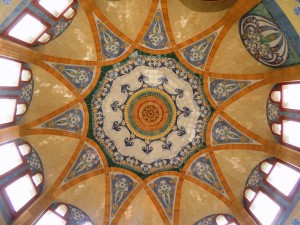

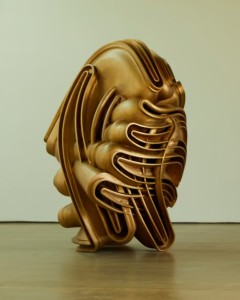
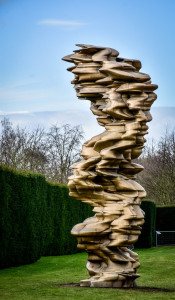

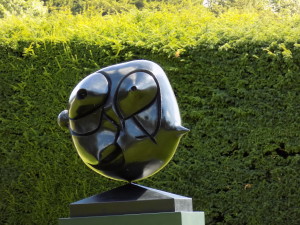
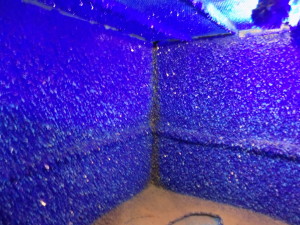
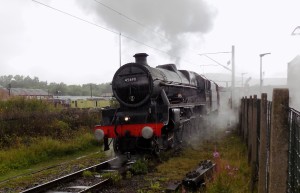


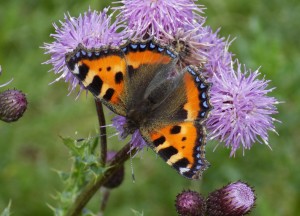
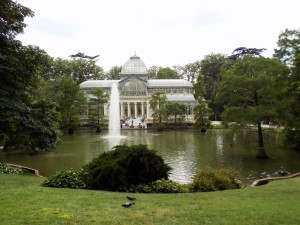
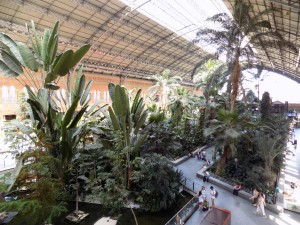

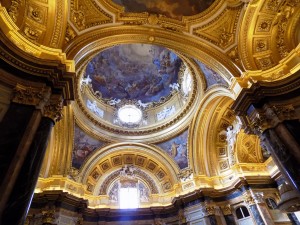
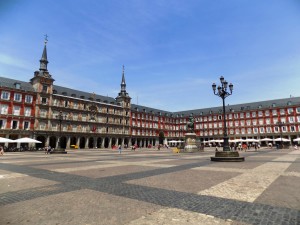

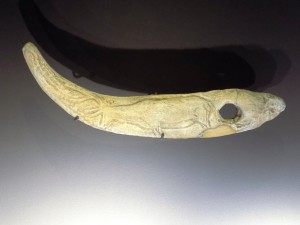
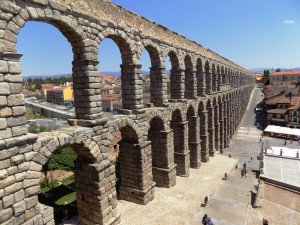


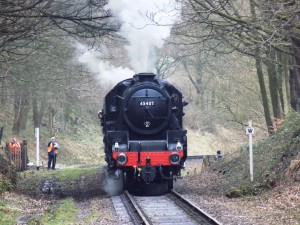
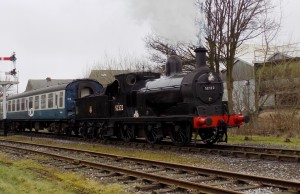
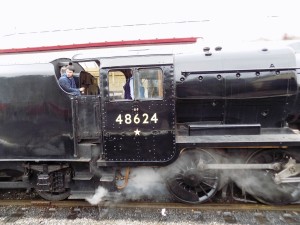
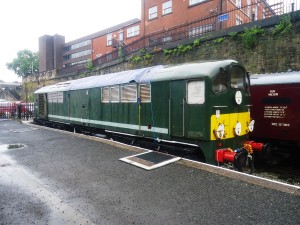
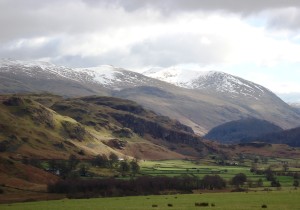
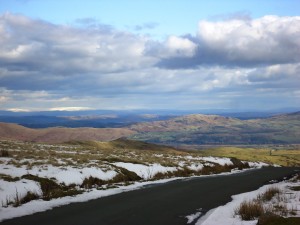
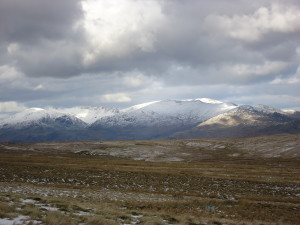
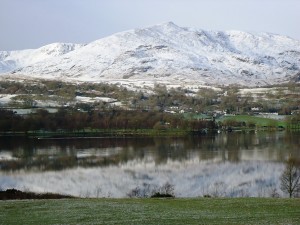

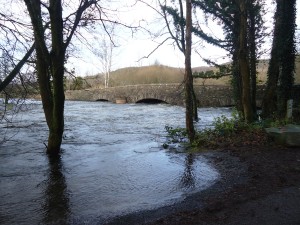

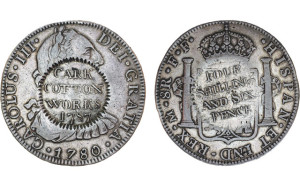
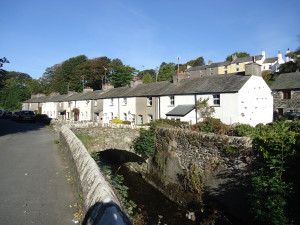




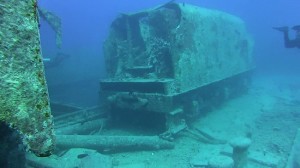
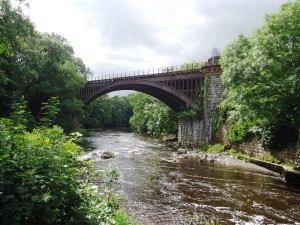
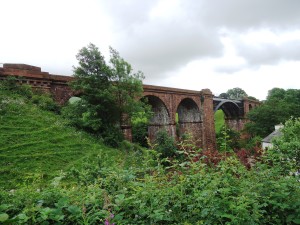


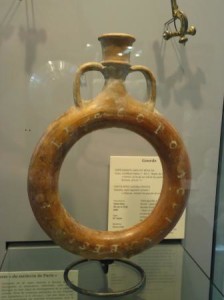

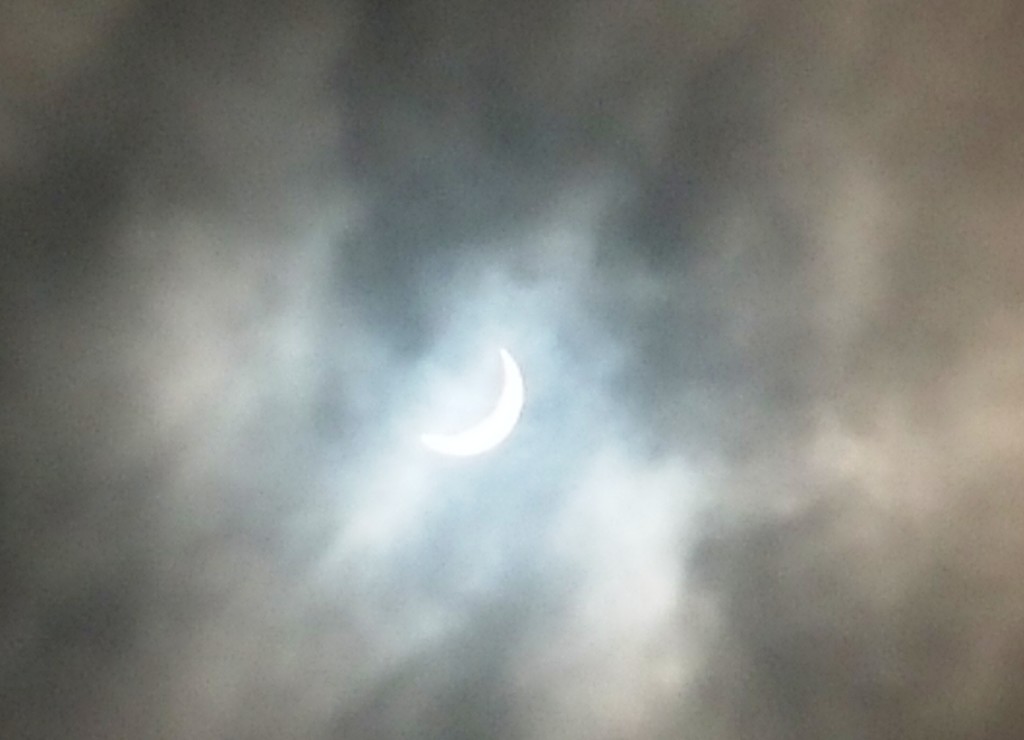





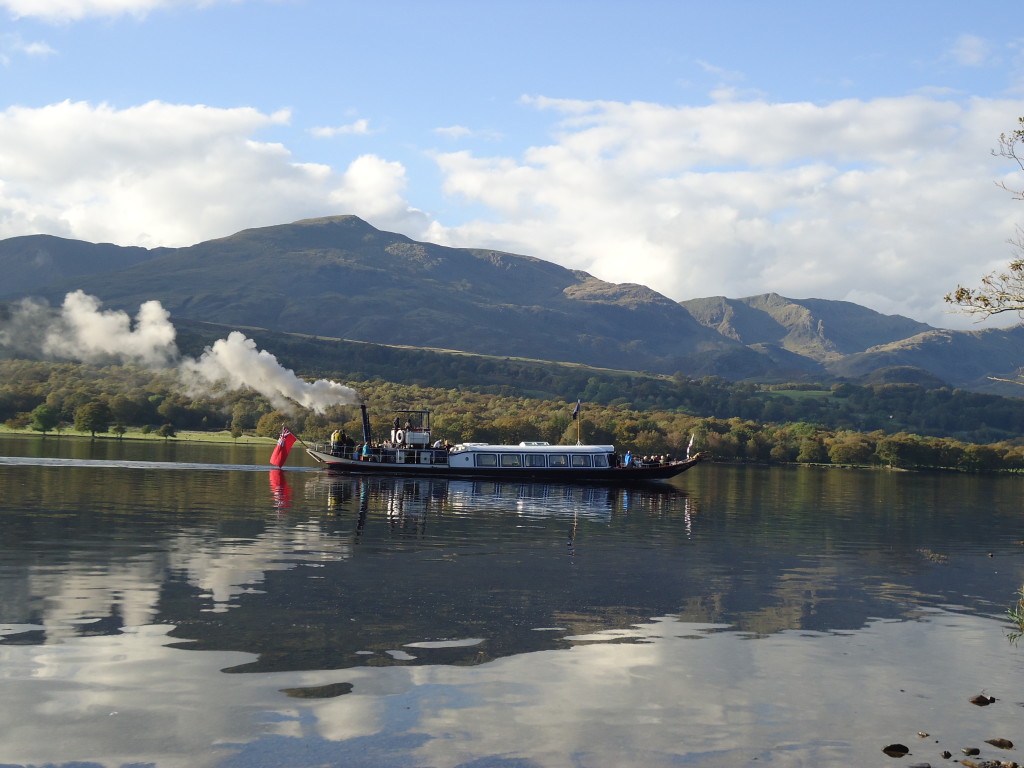
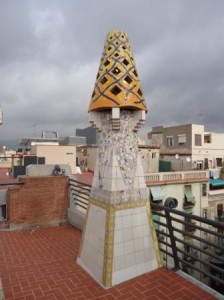









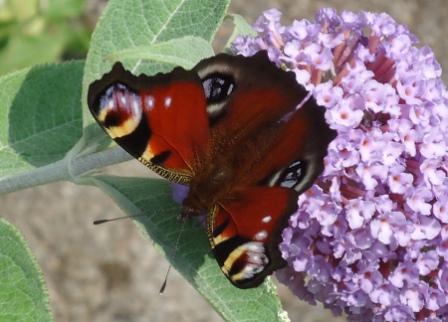
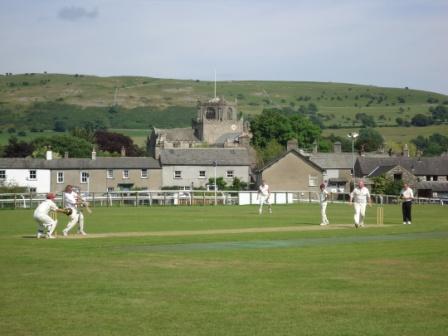

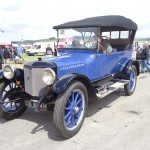




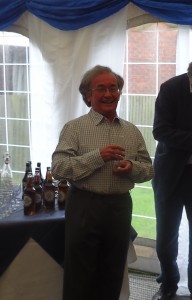

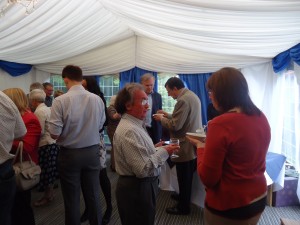
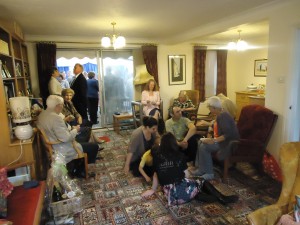

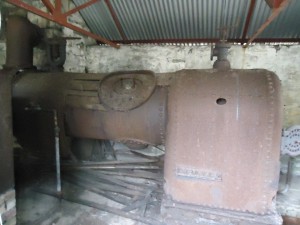
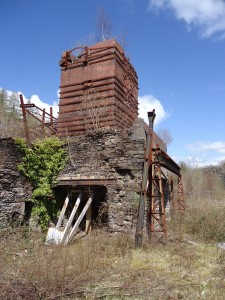


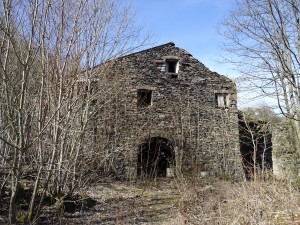
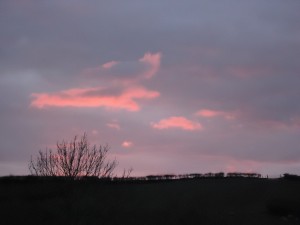
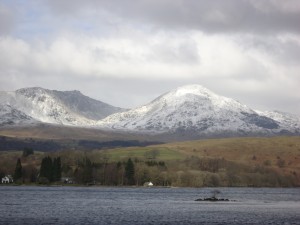

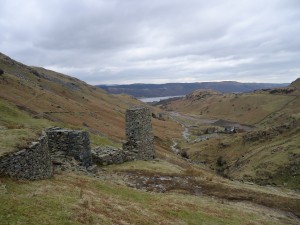
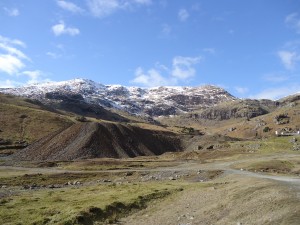


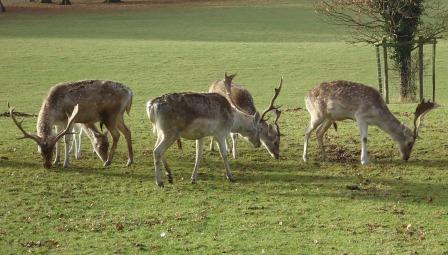

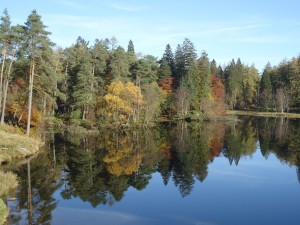
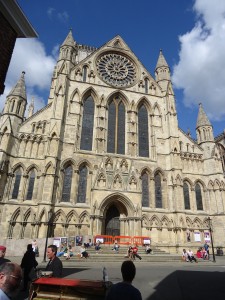
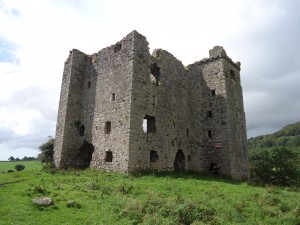
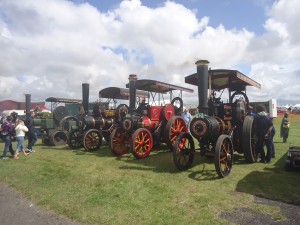
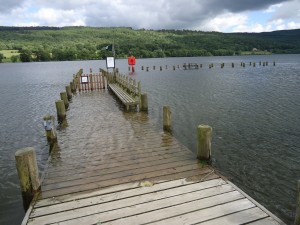


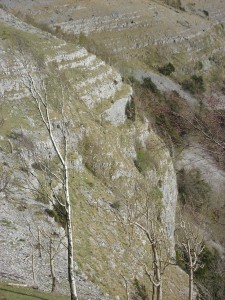

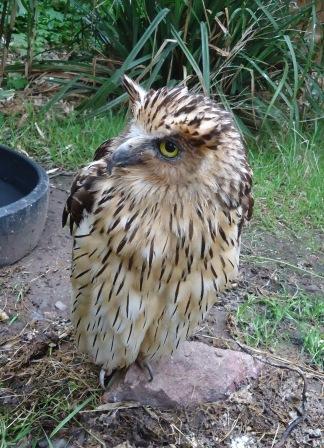







Hi John
You take a bit of finding. Been burrowing through the Coulshed website looking for some way to contact you. I gather the Steeper family tree on the website is your research? I tried the same half heartedly years ago but gave up when I had to pay, promising myself I would do it later. Am currently doing a snappish ‘Ancestors’ photo album and came across you on Googling Walter Hyde Steeper, who is my grandfather on my fathers side, Terence Sydney. He left the UK before WW2 by joining the merchant navy and married a New Zealander, where he settled. I was wondering if we could exchange scanned photos of the family? I have quite a few of Walter and Lilly, and their children, Aileen and Denis, and I would love HD copies of the pics of Mabel Ellen and similar. I was also wondering what you had on the early Williams in Welton?
Regards
Denis
The Old Man and Coniston from Parkamoor pictures are pretty good. Glad you are making use of the zoom. The foggy picture is excellent – shame it’s the wrong way round for the next calendar! – Mark